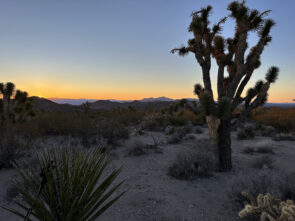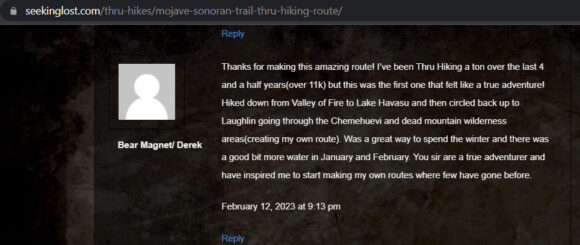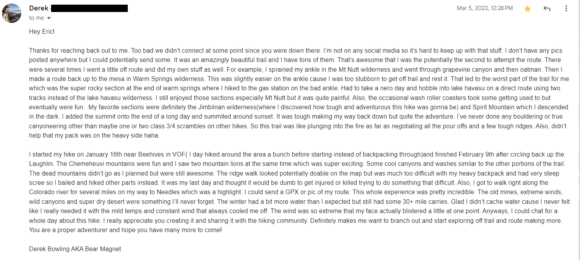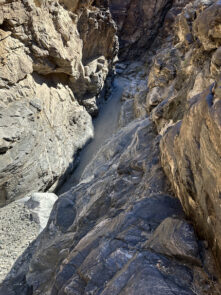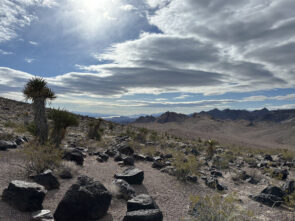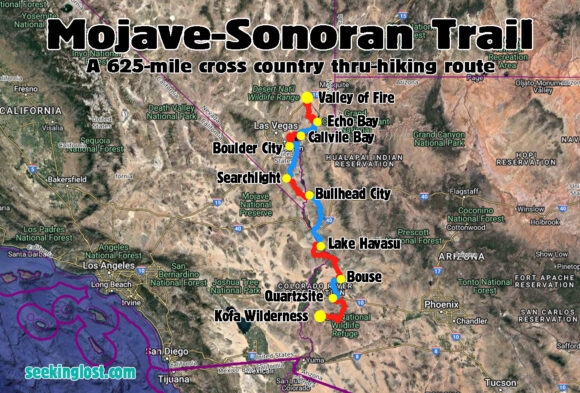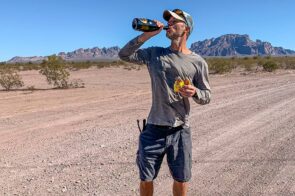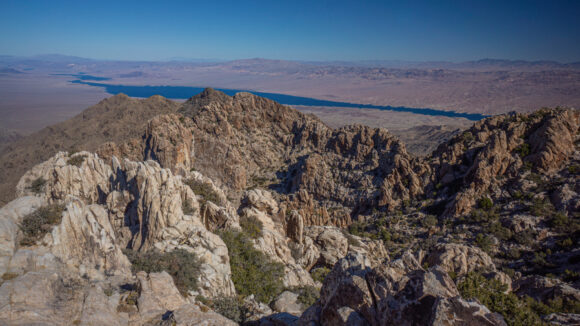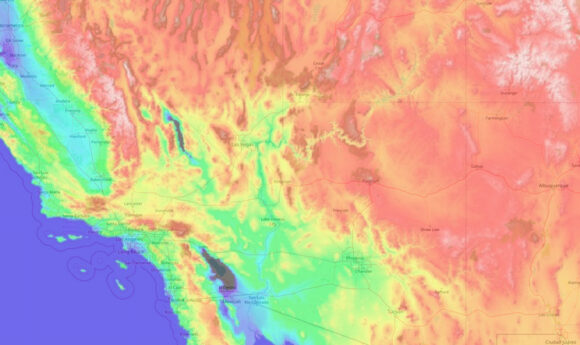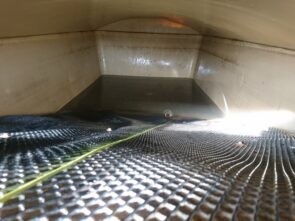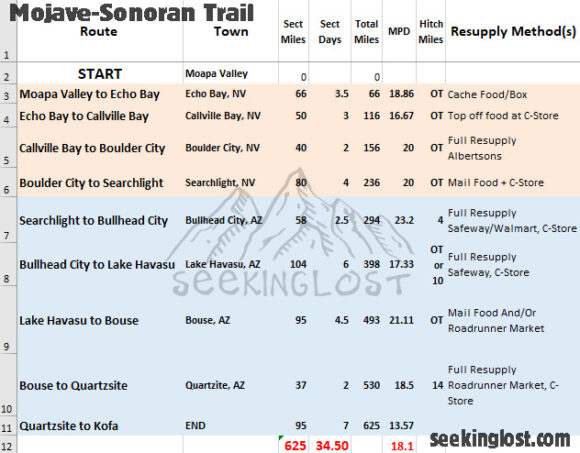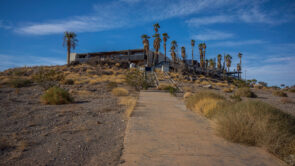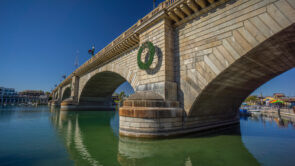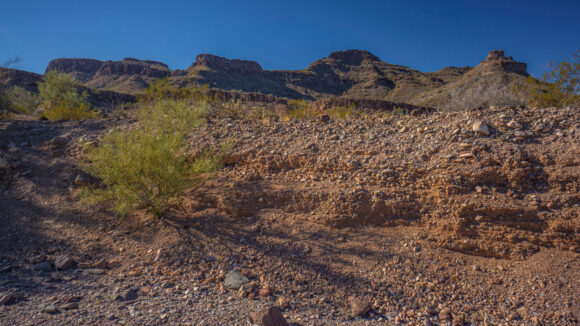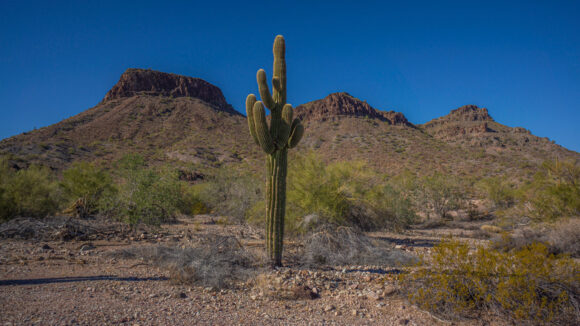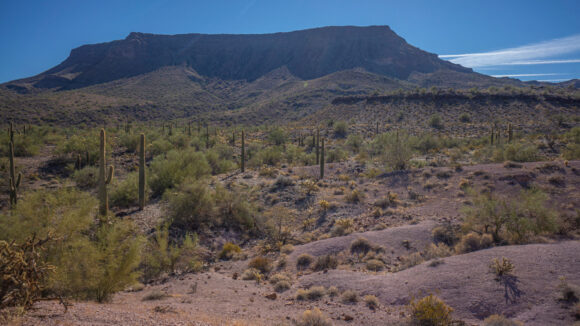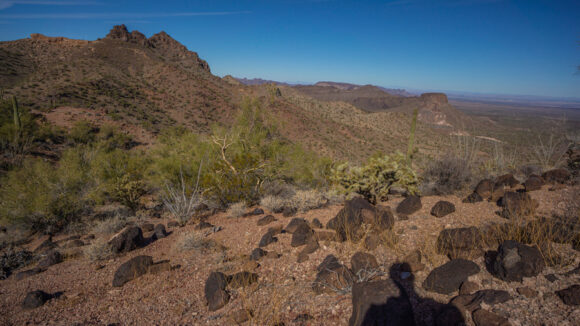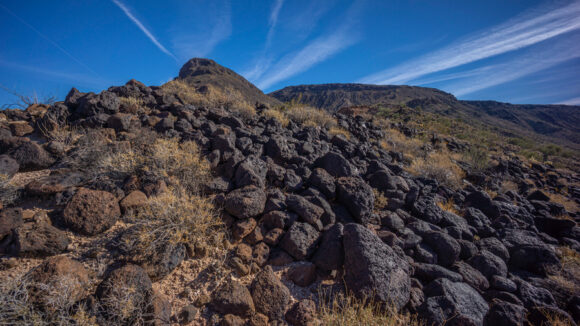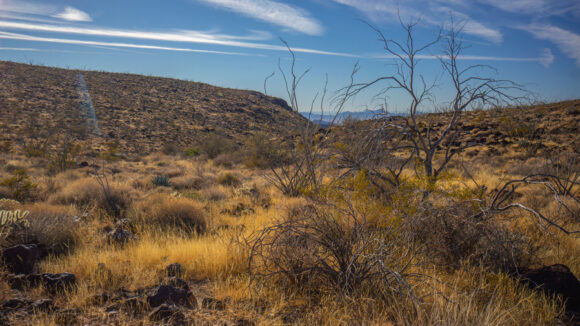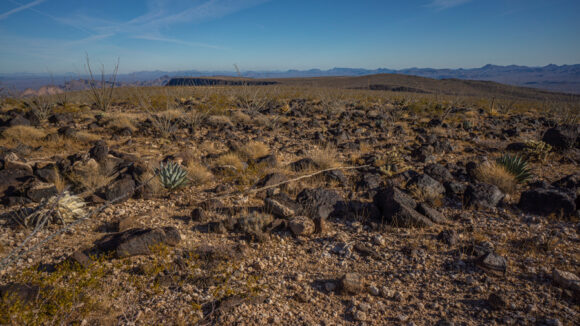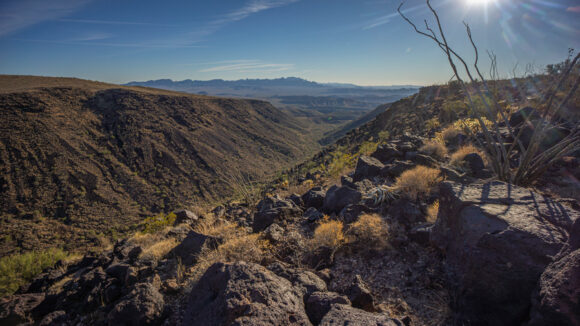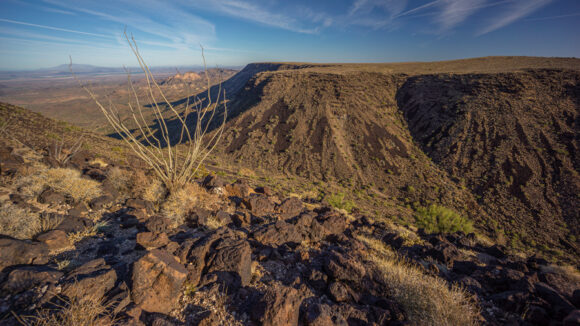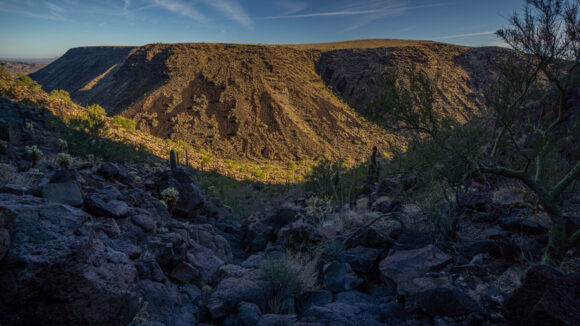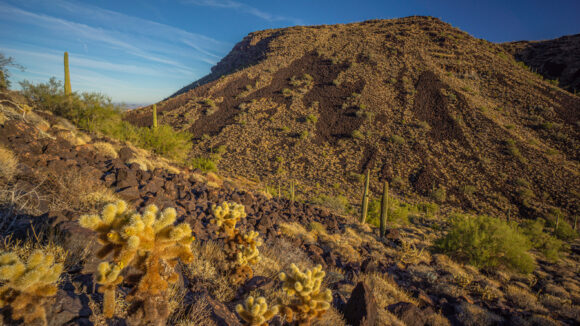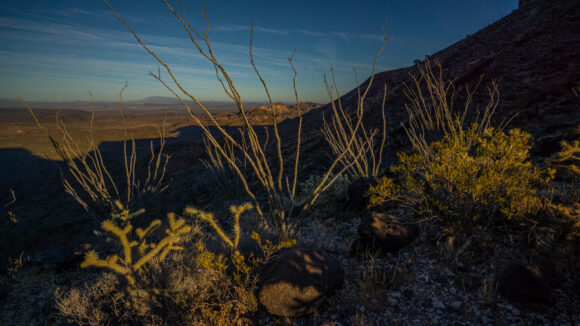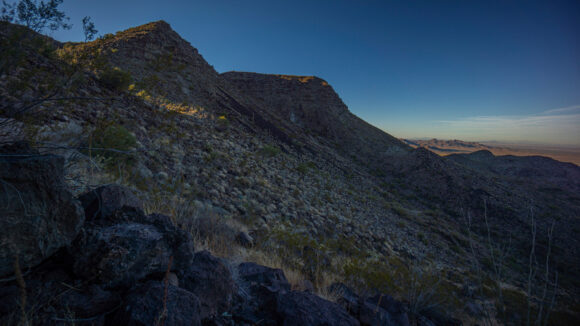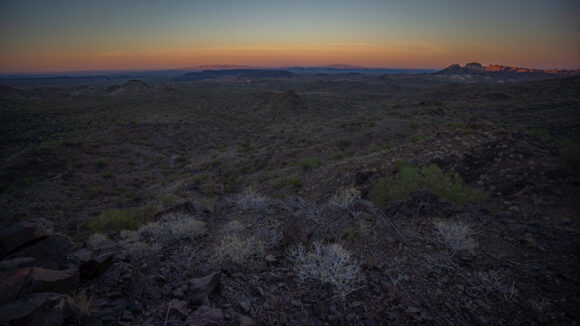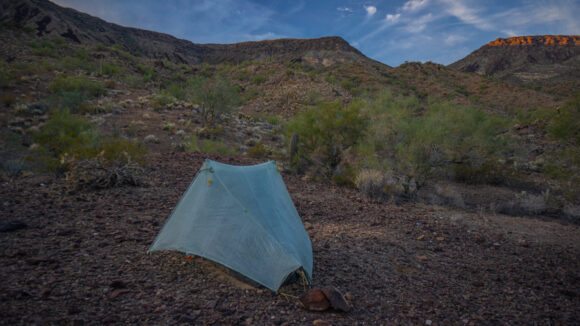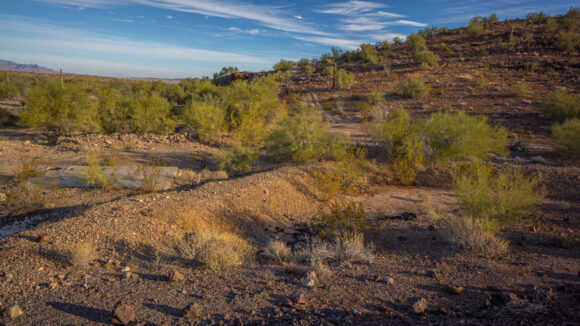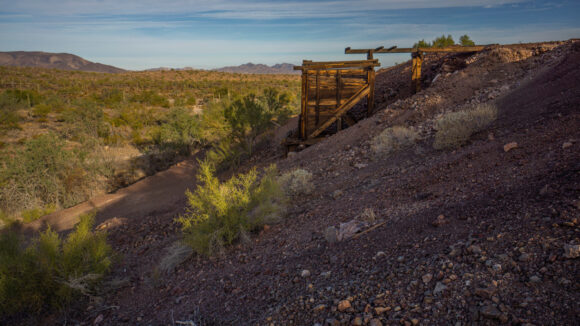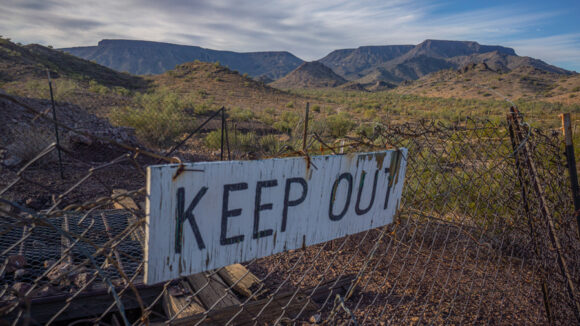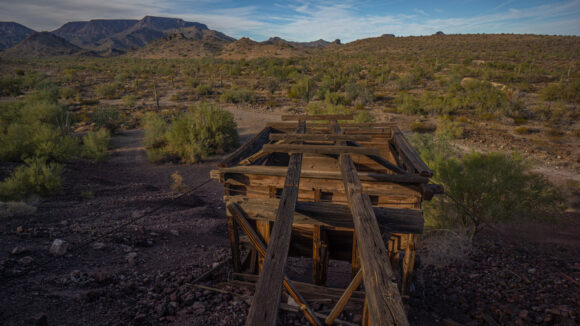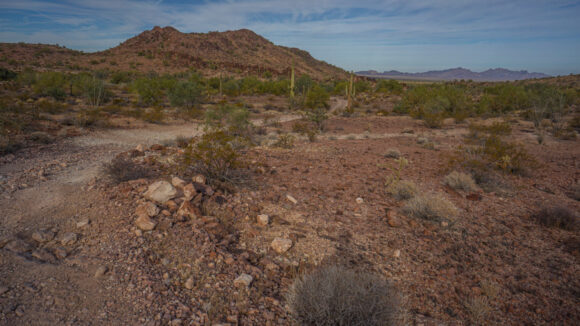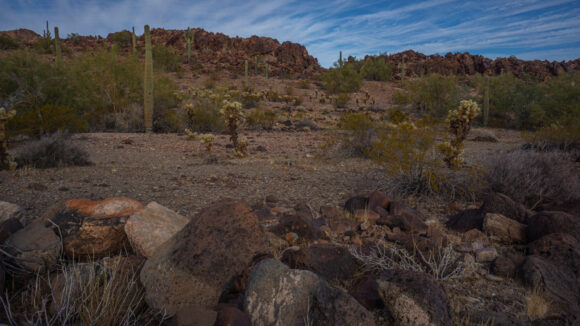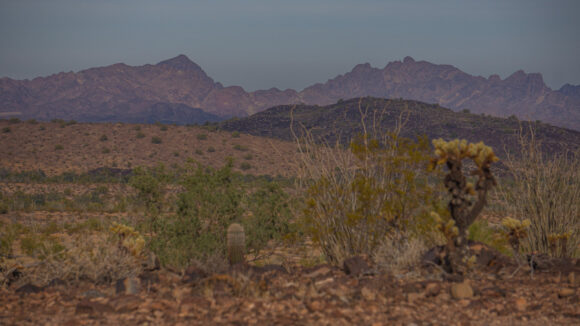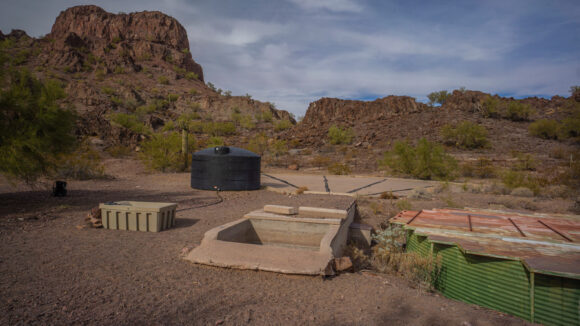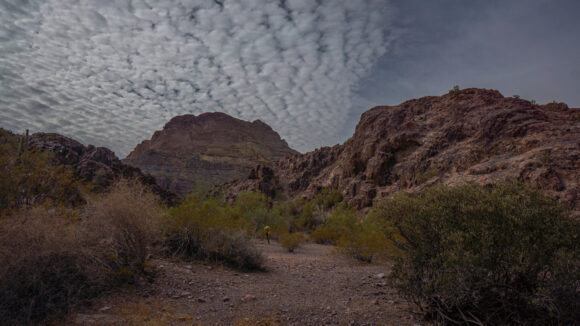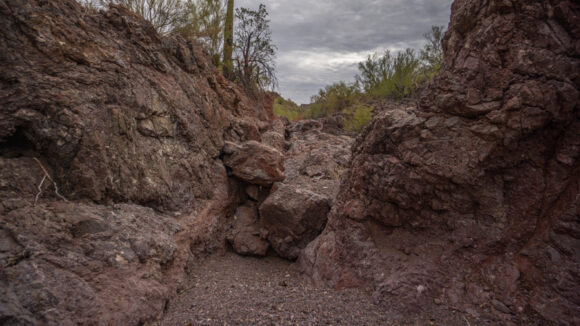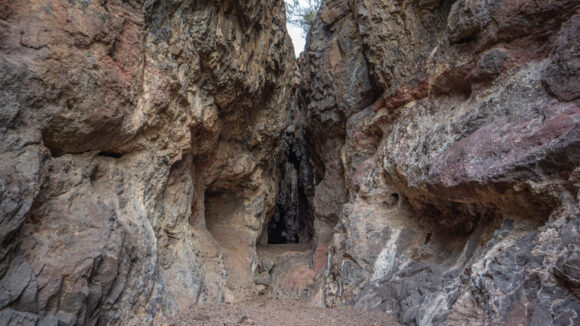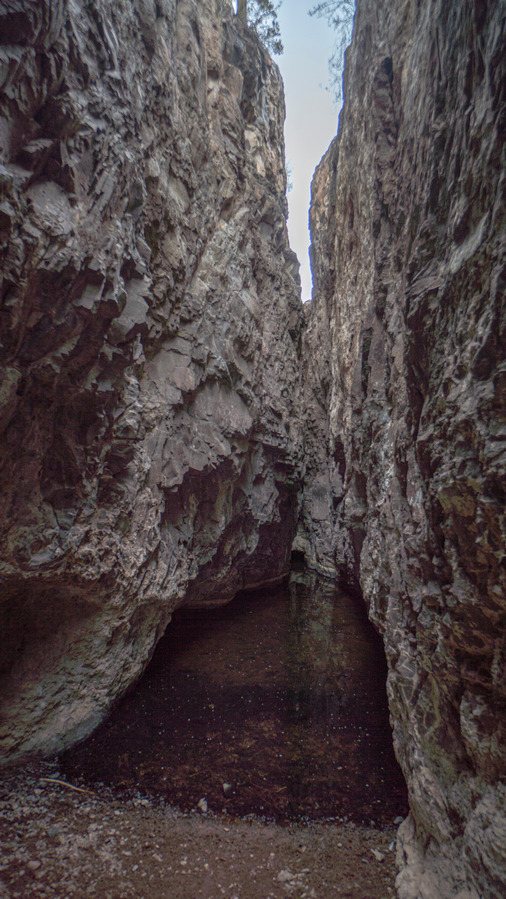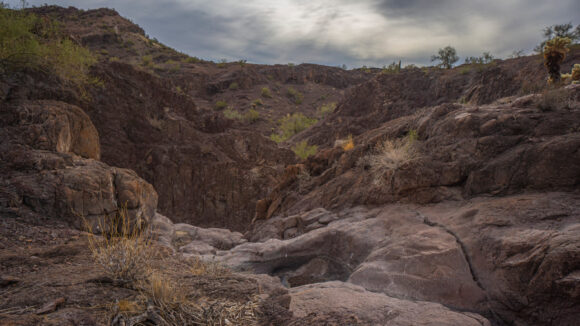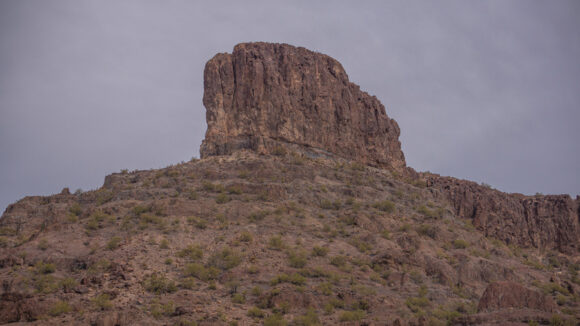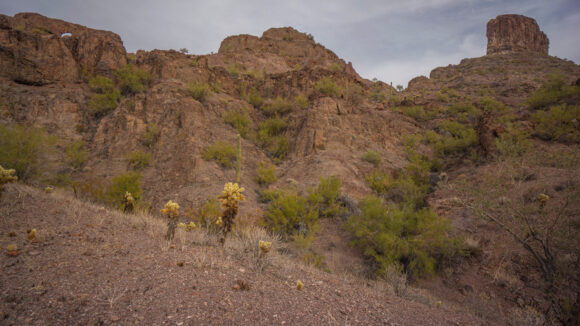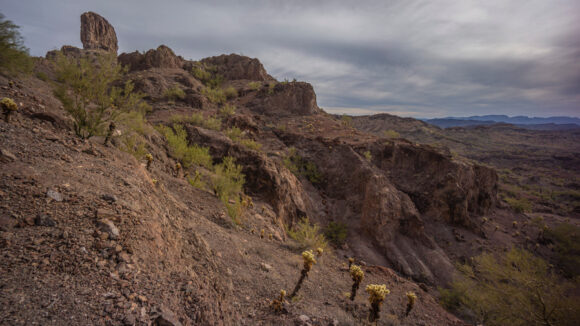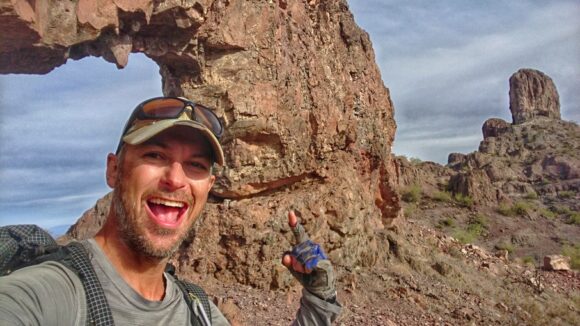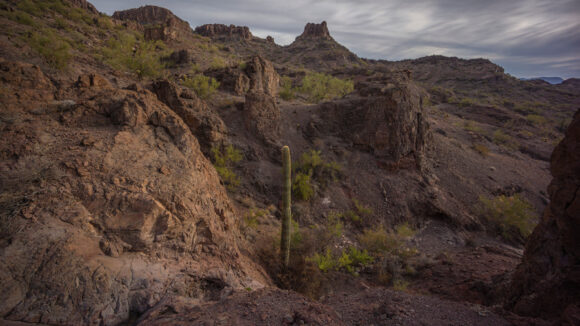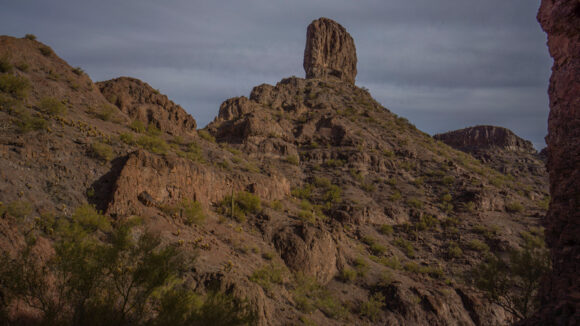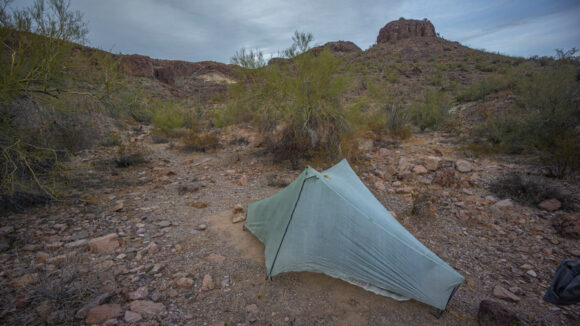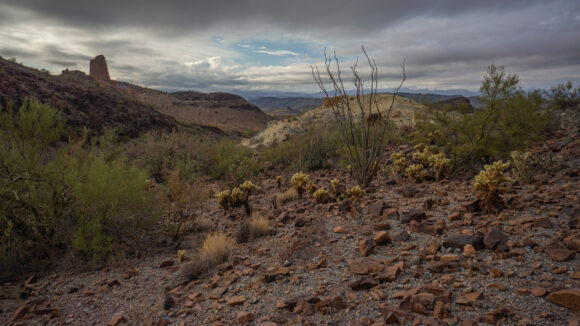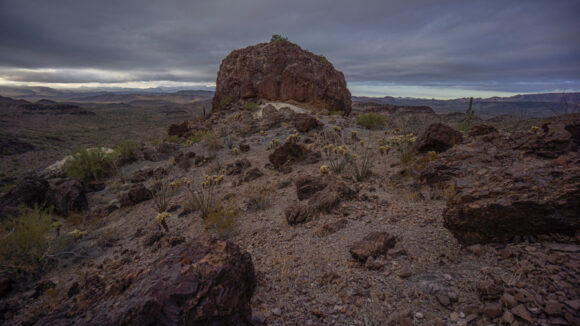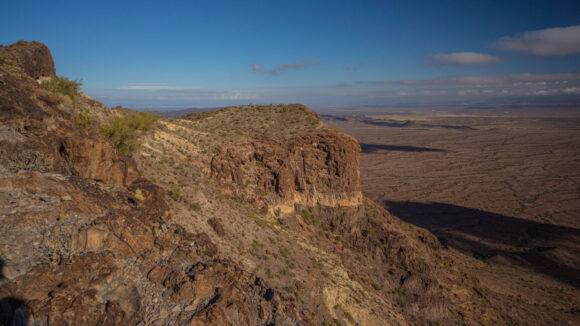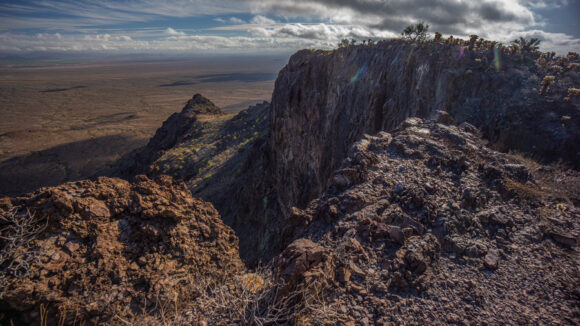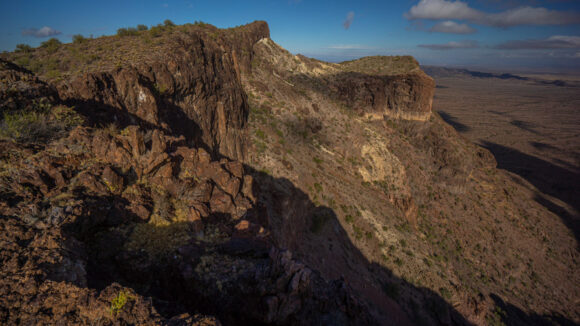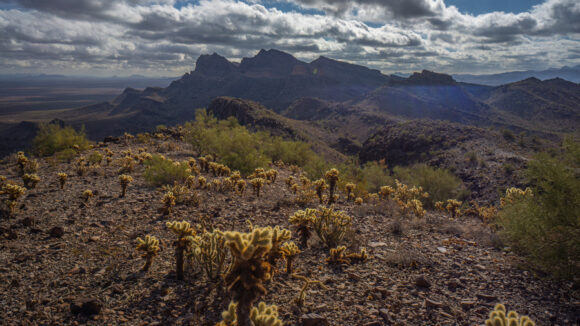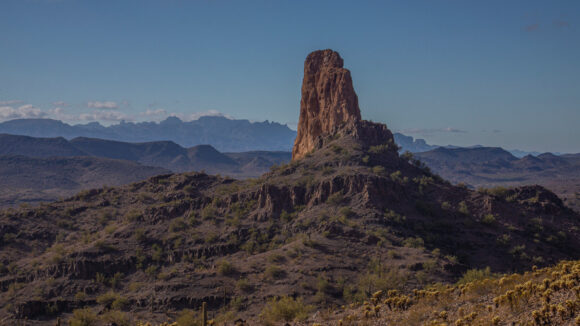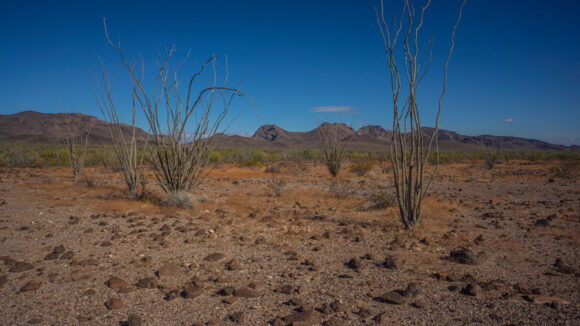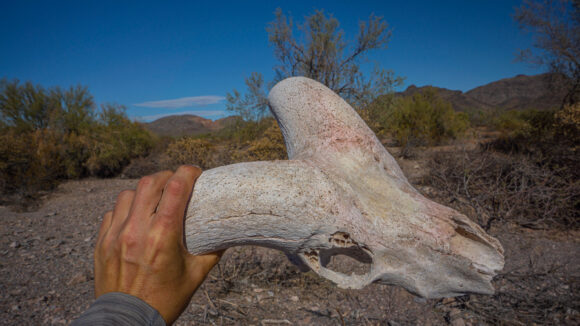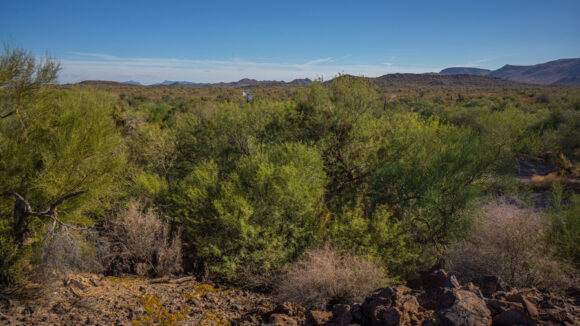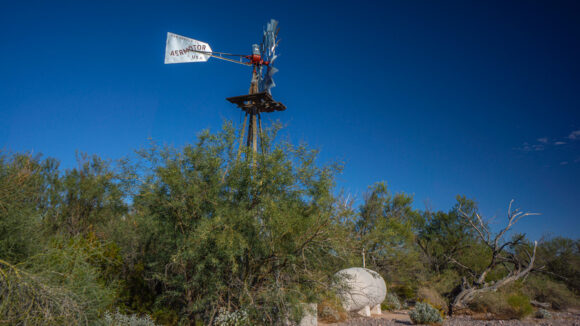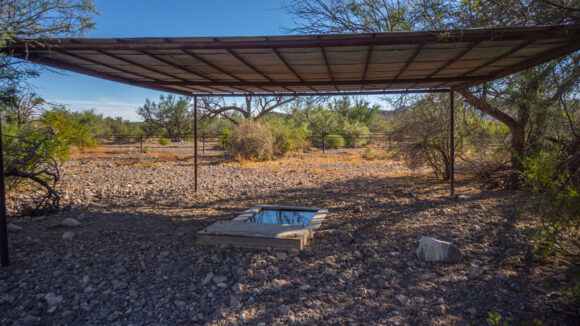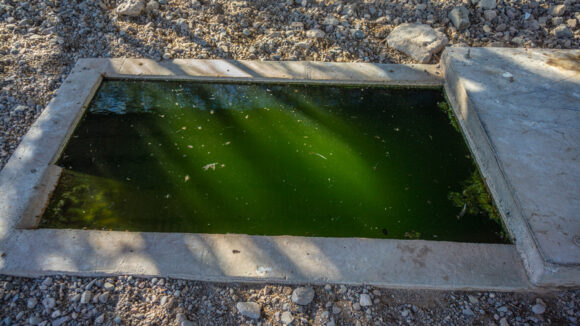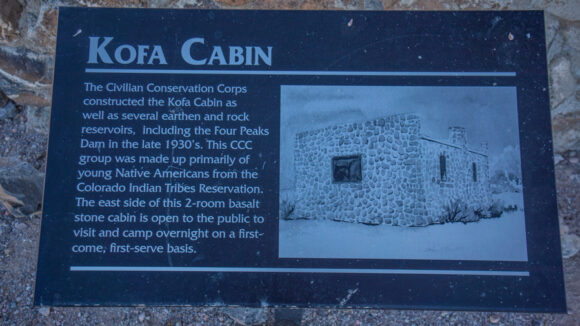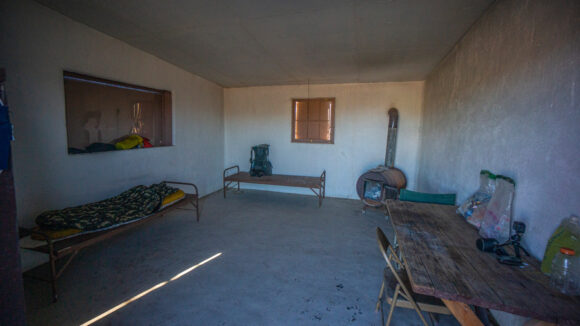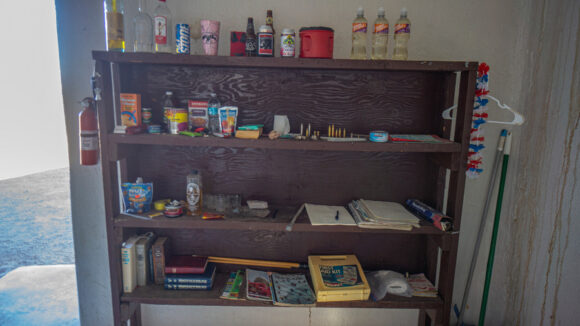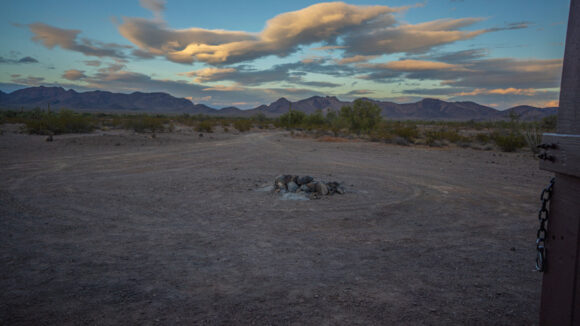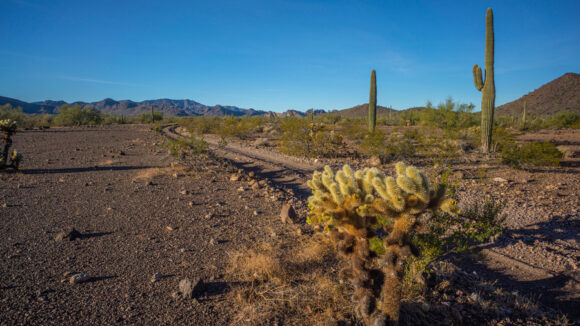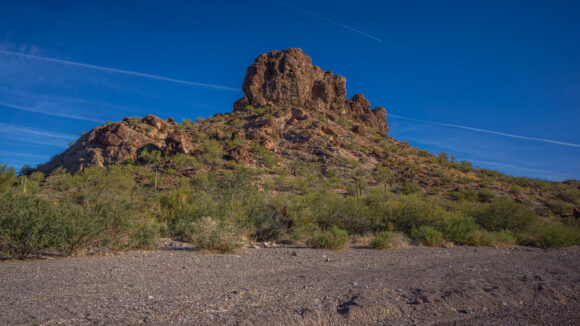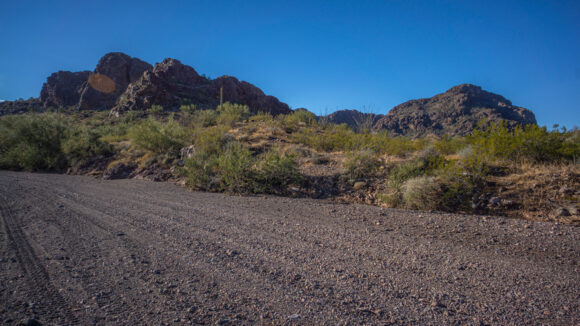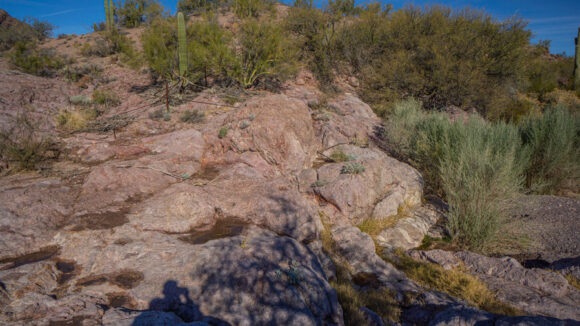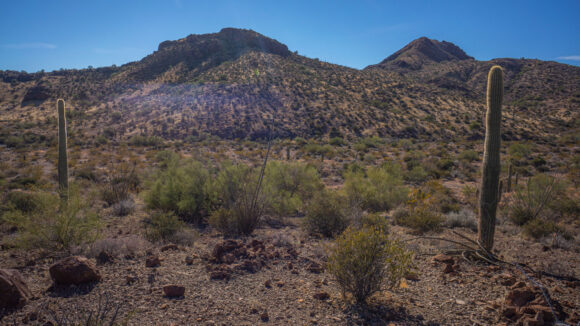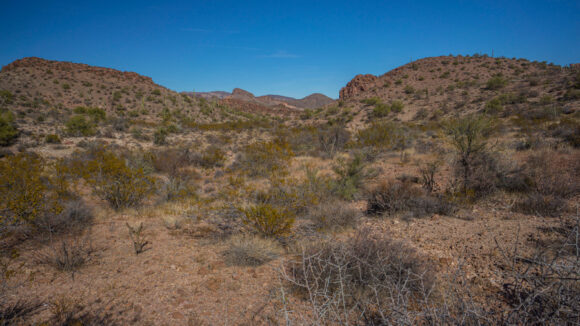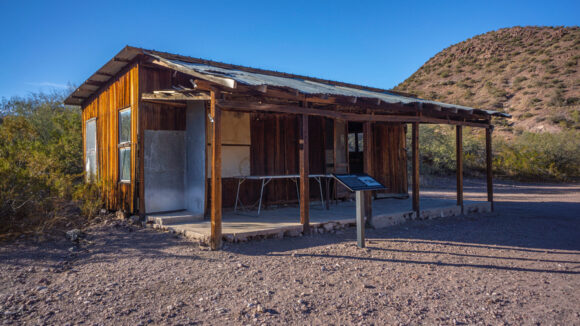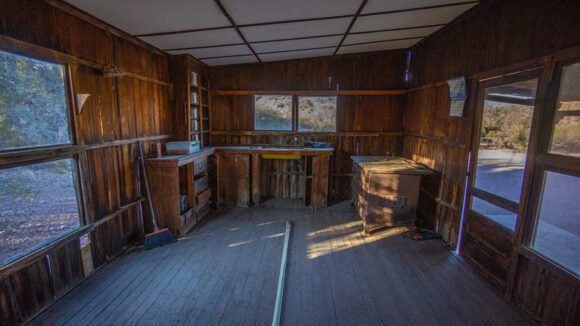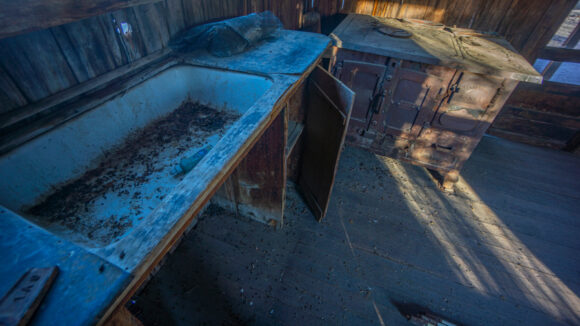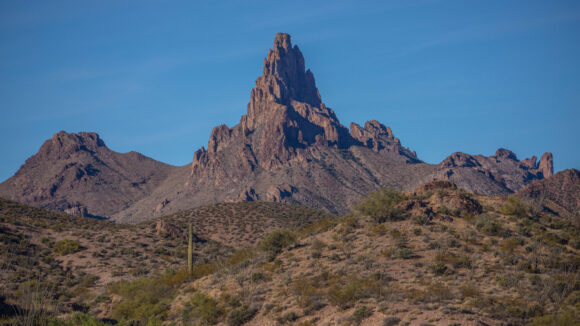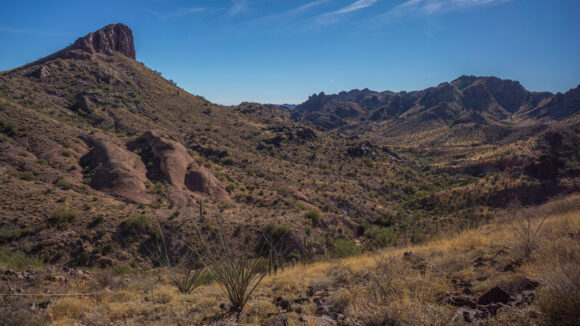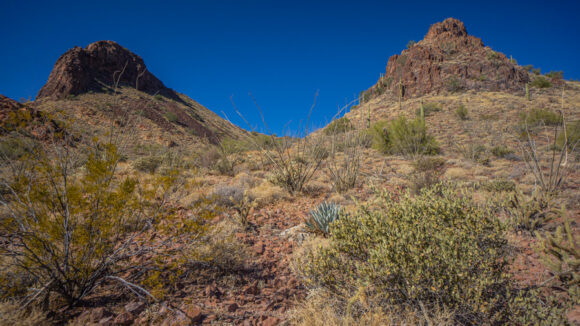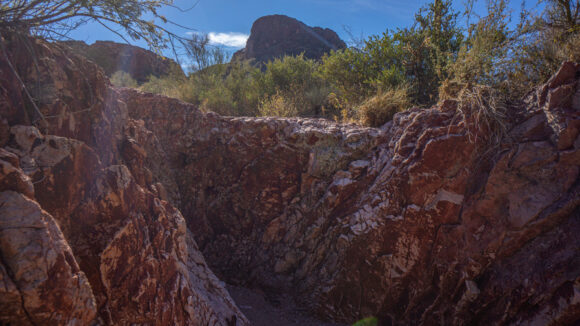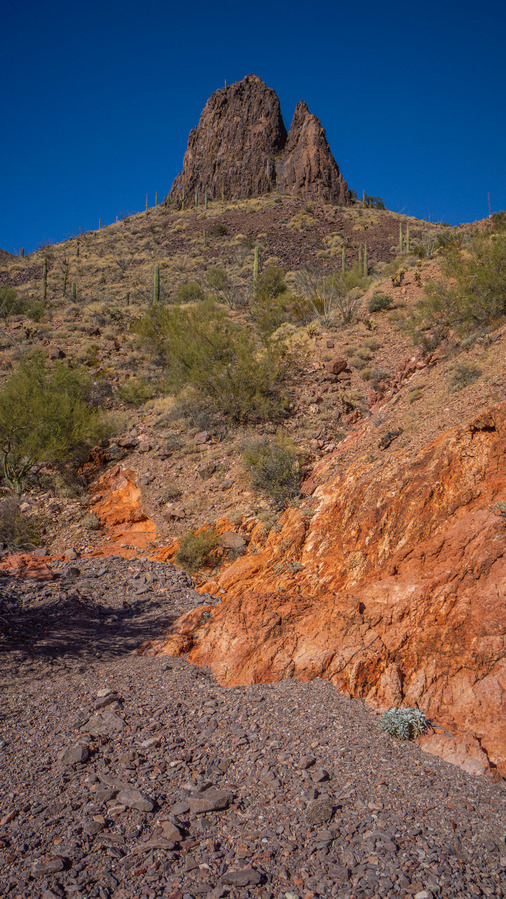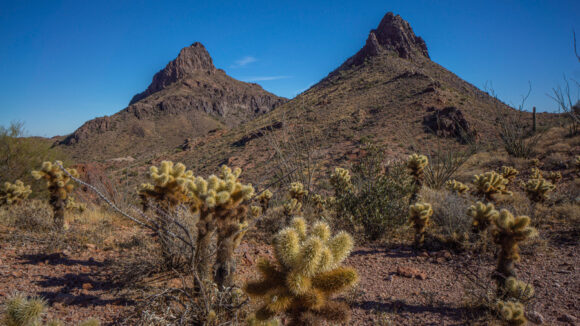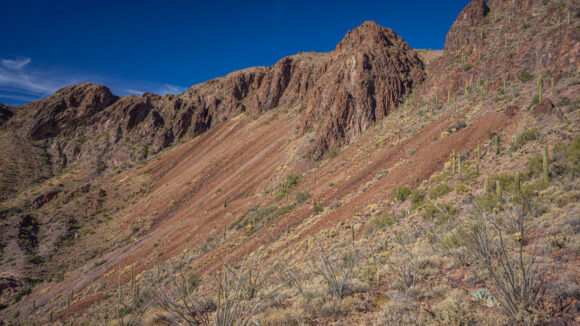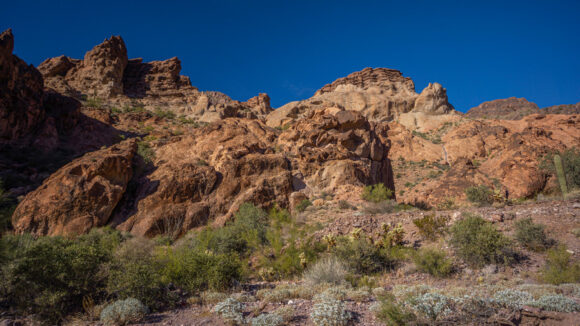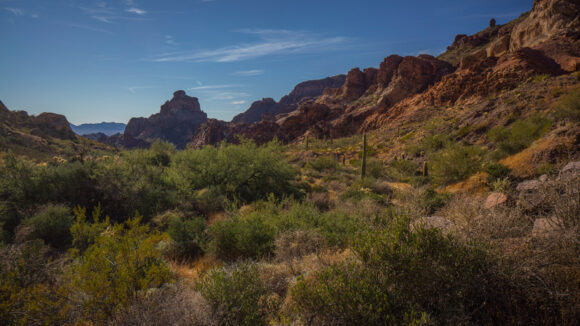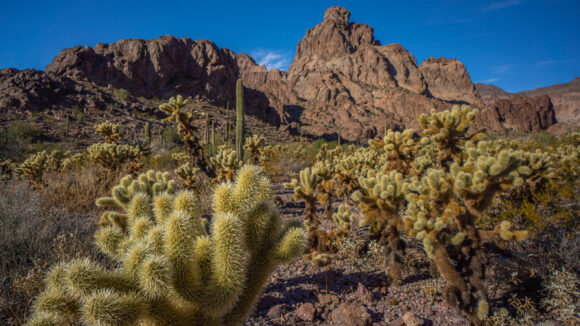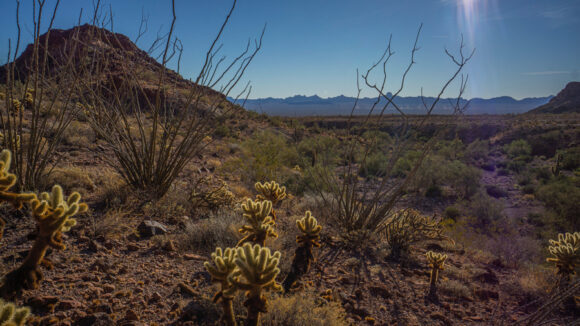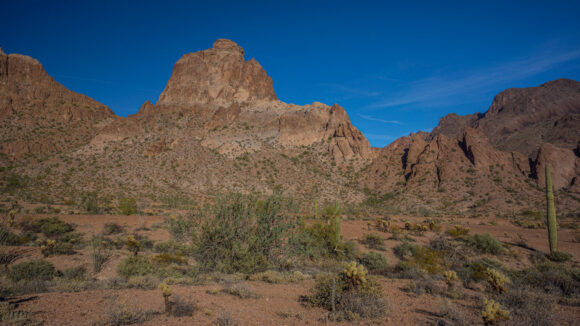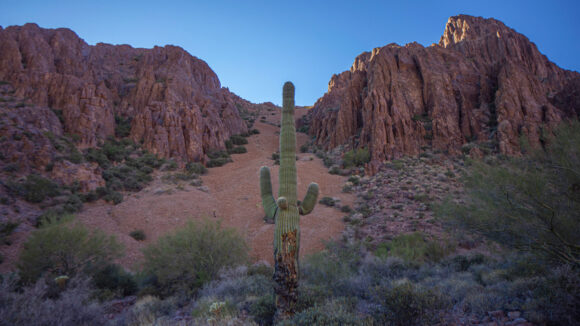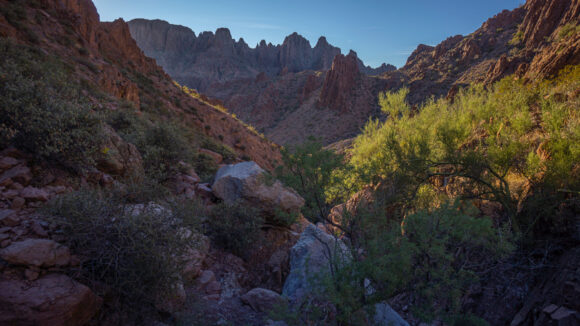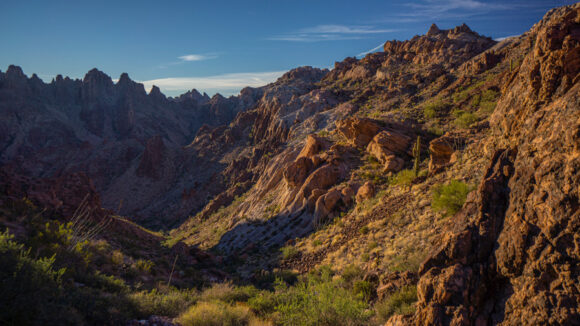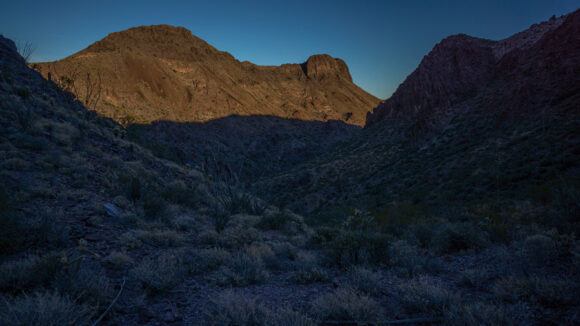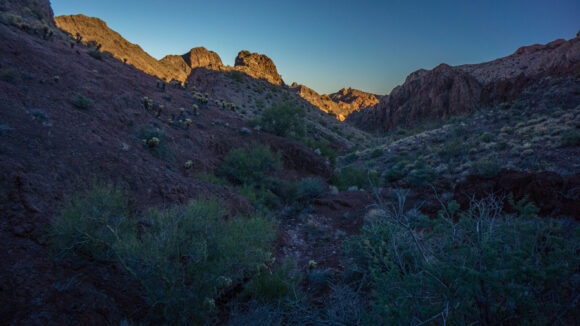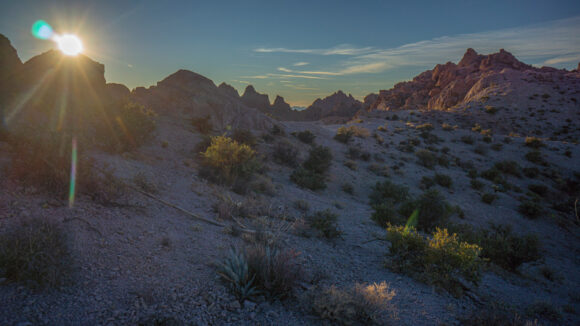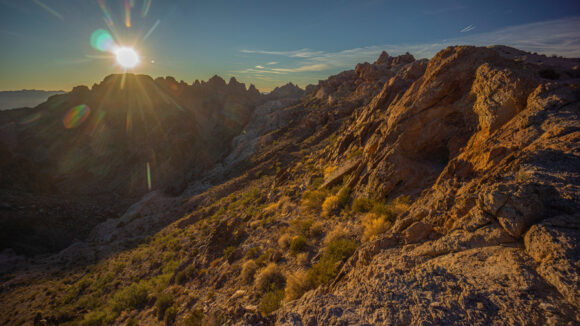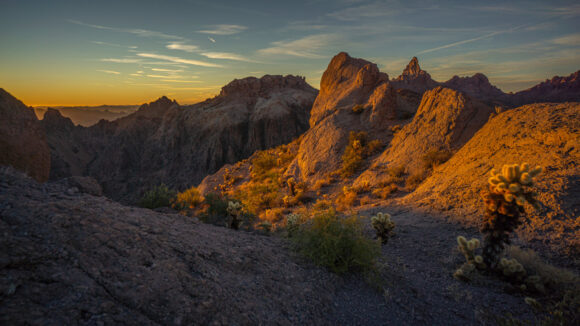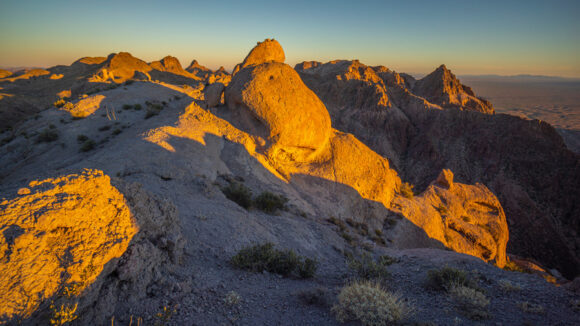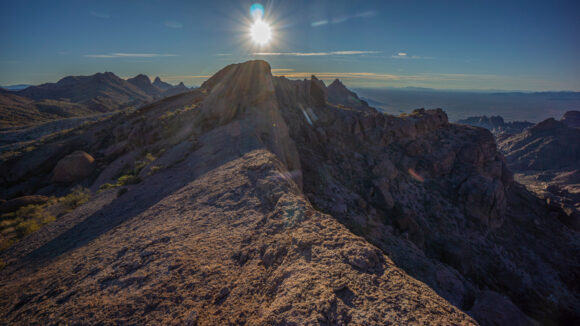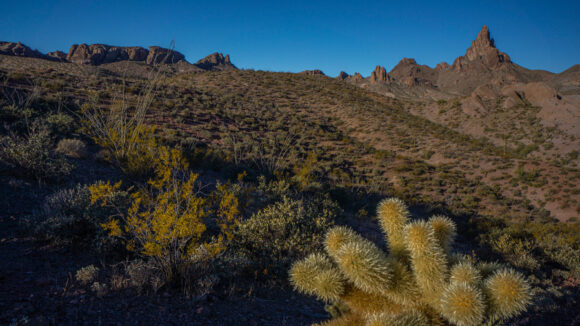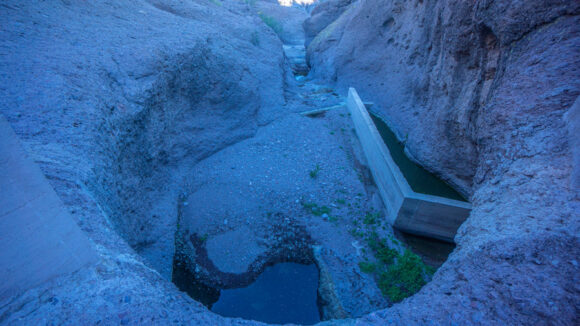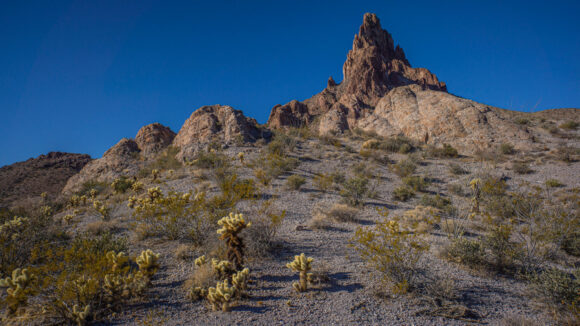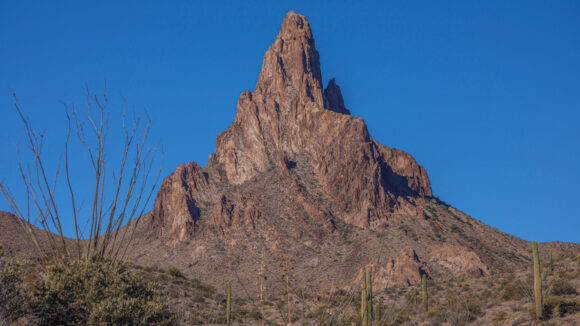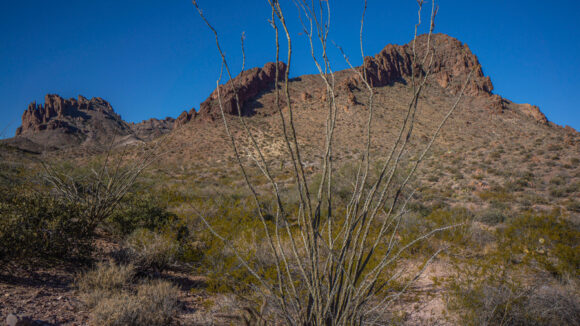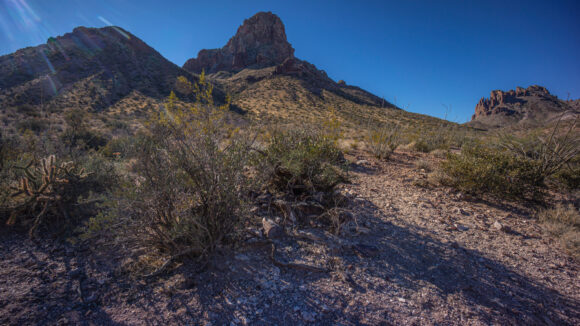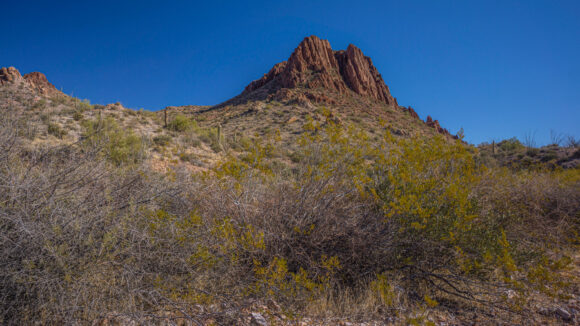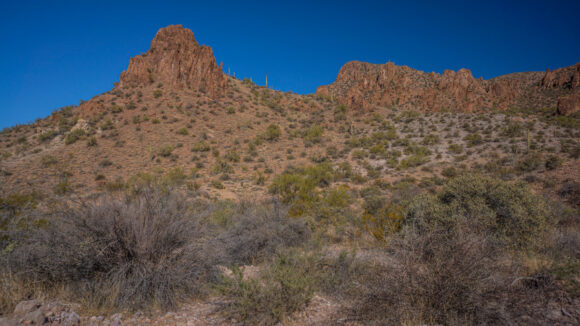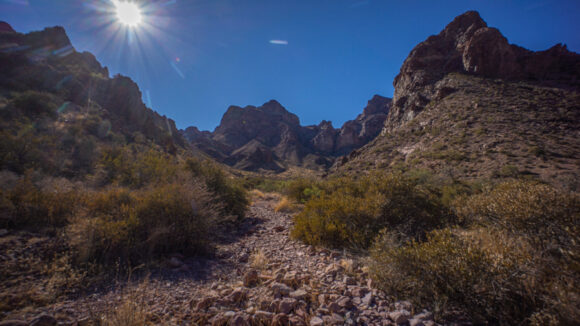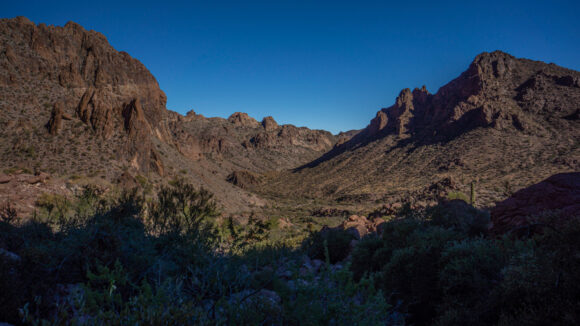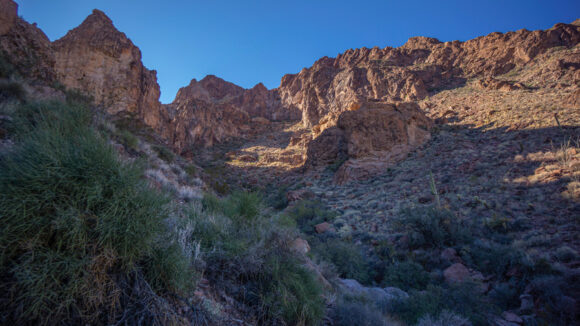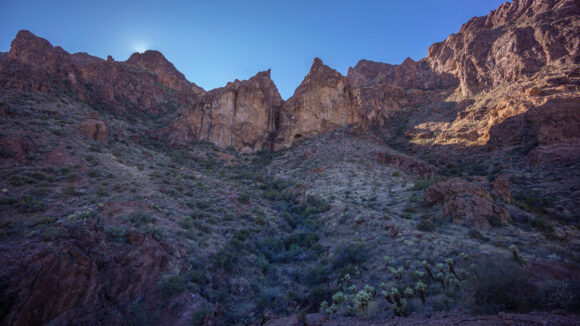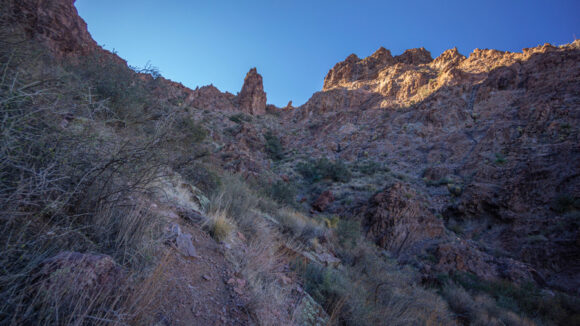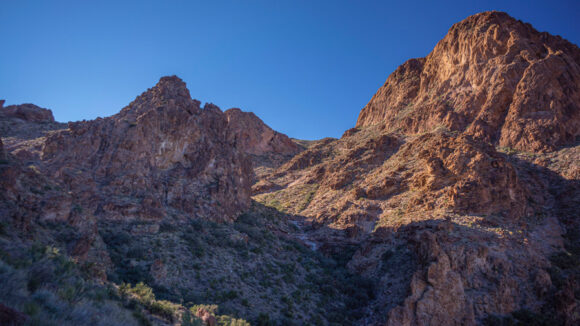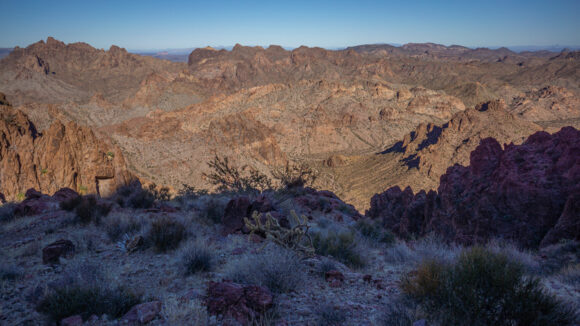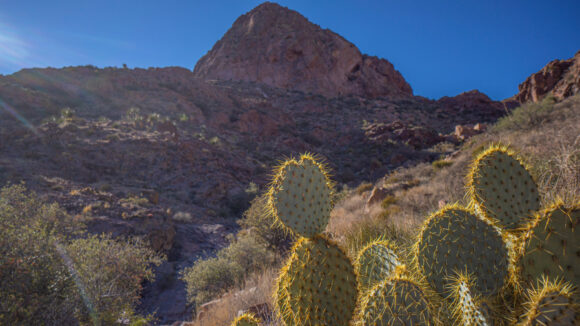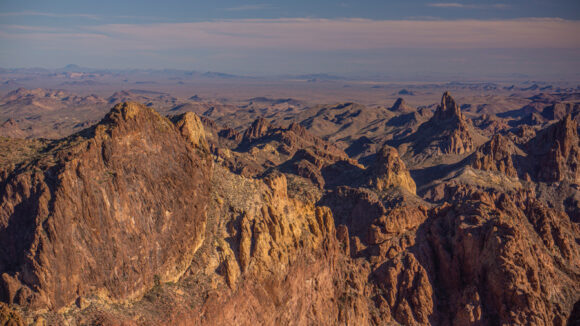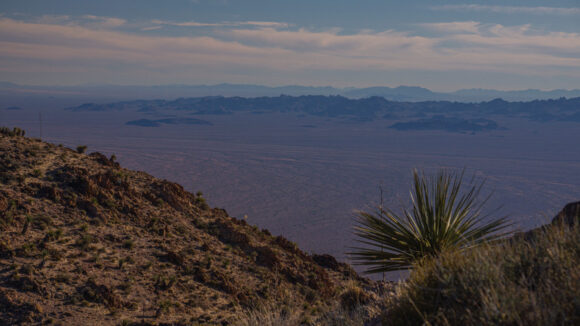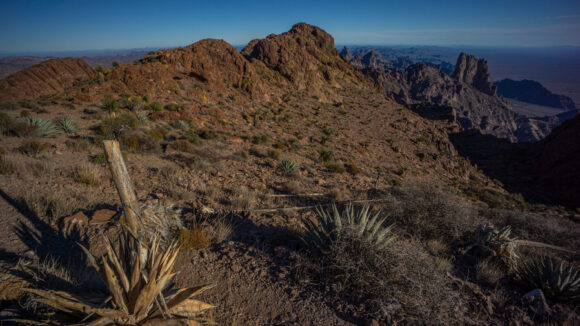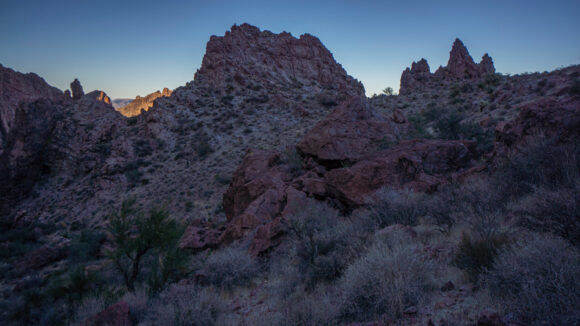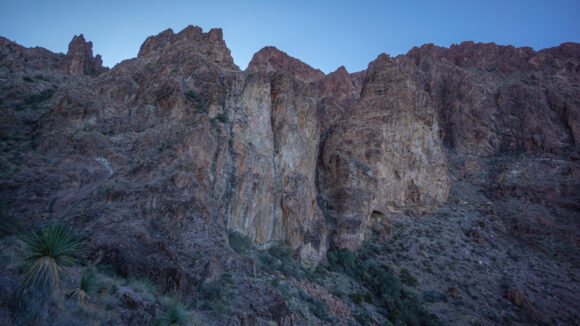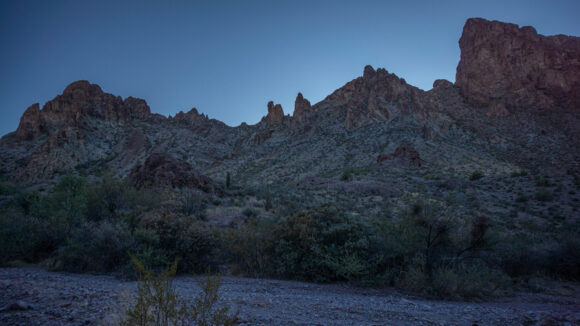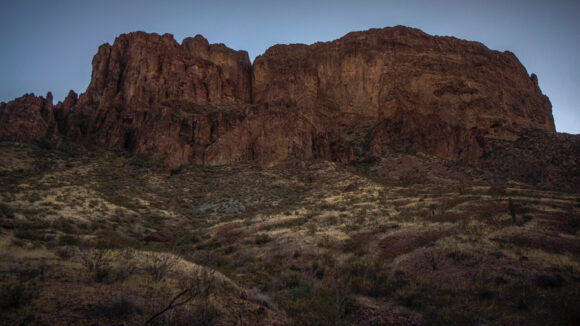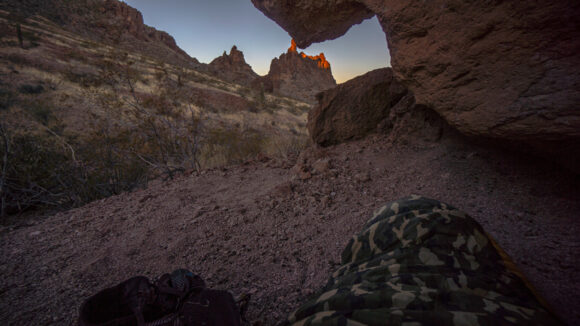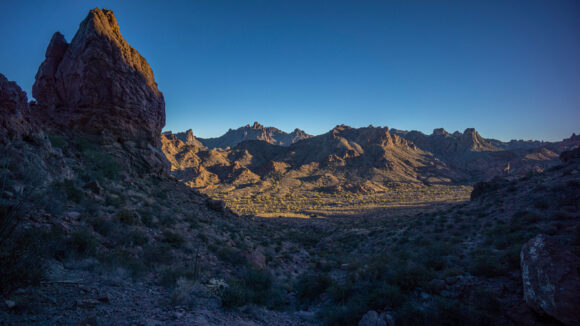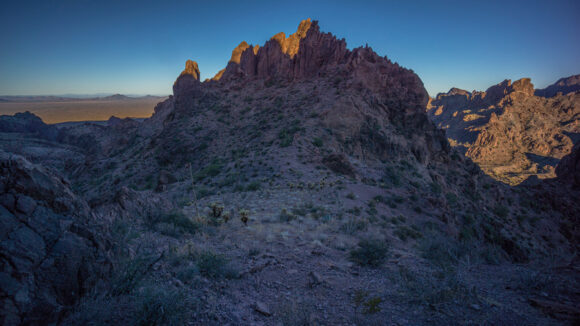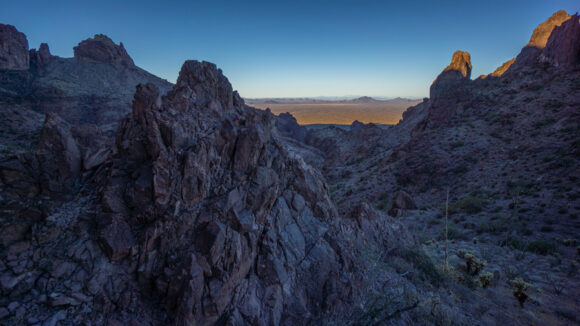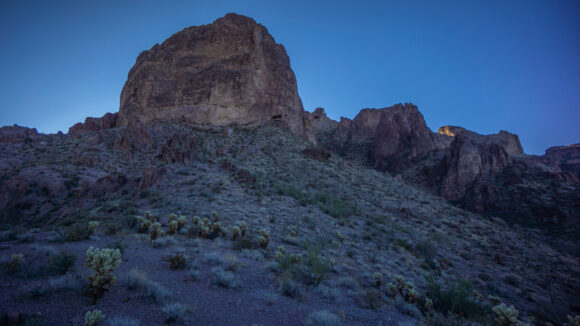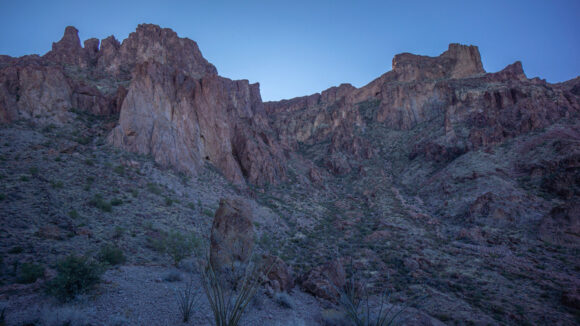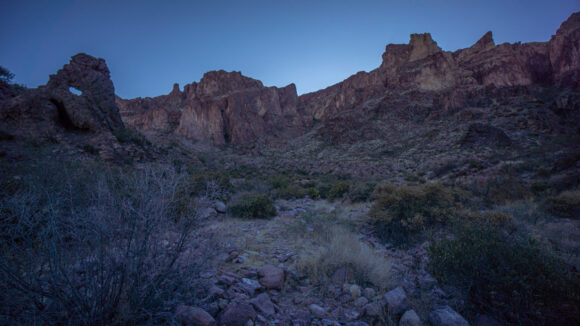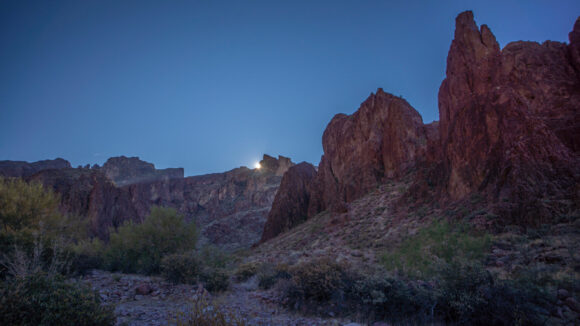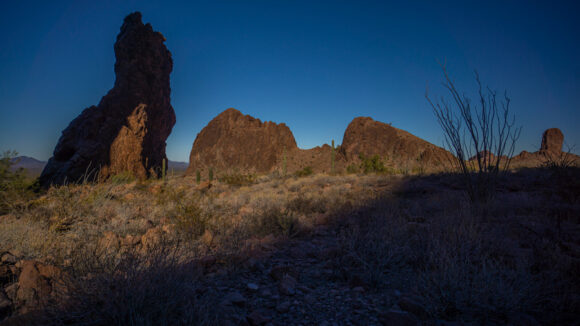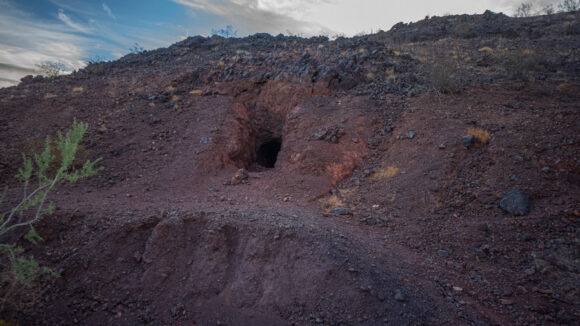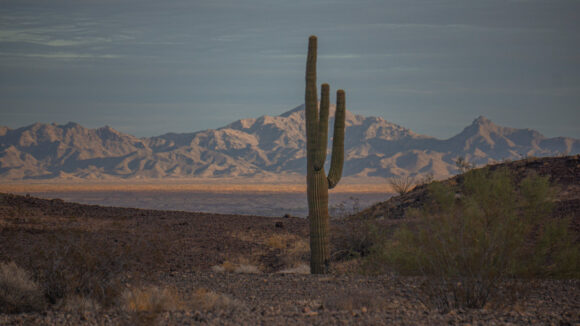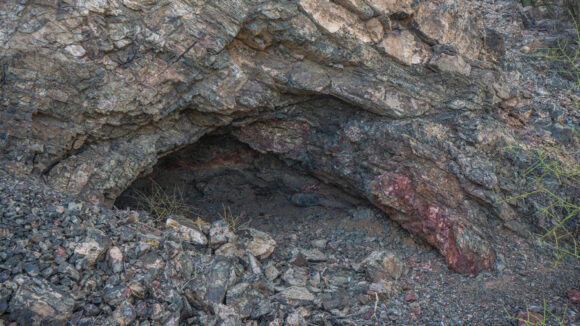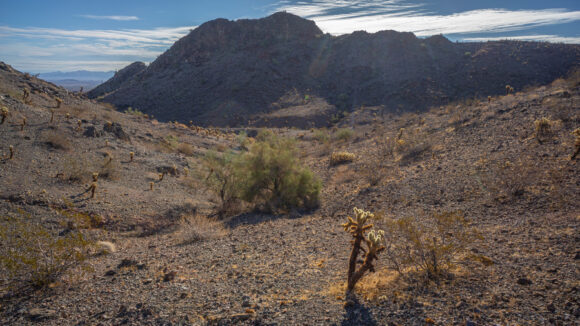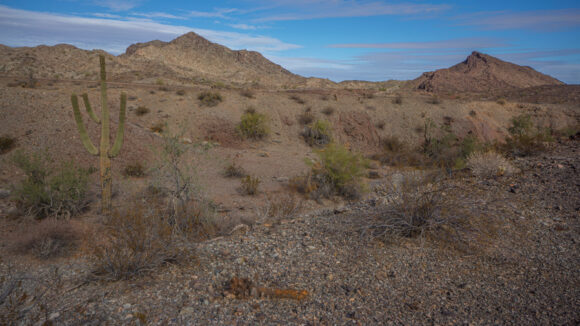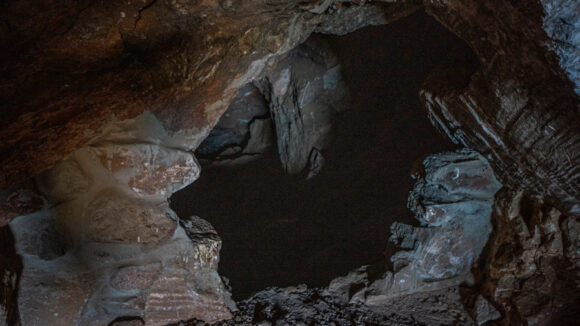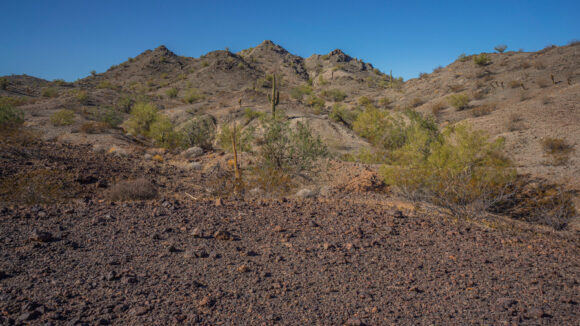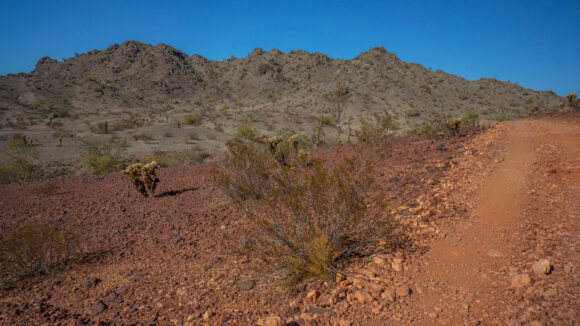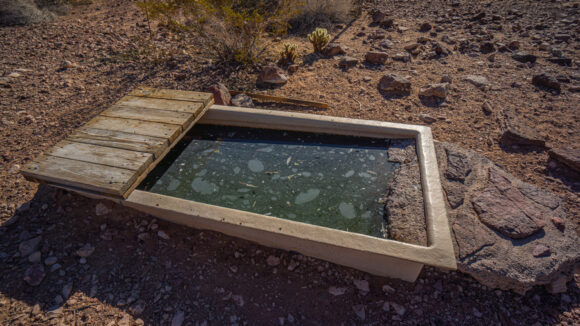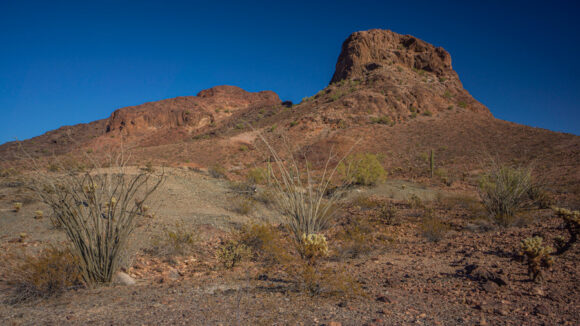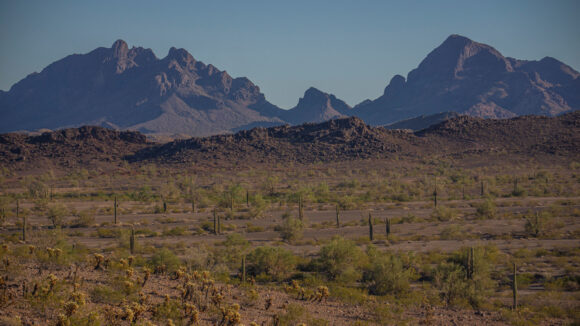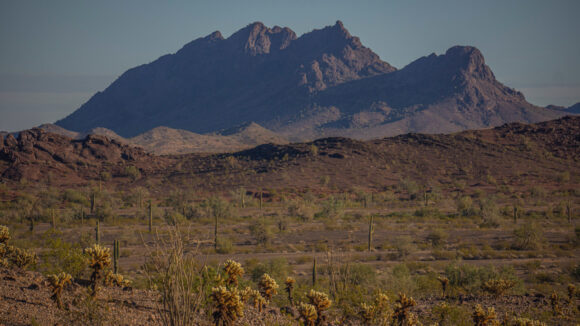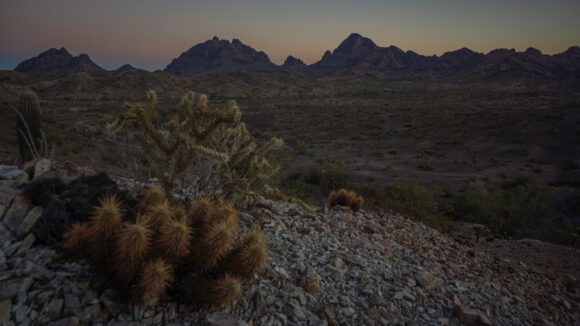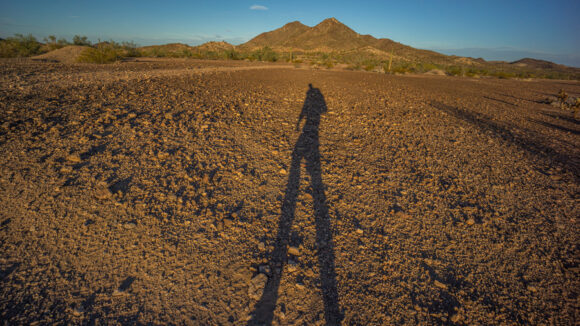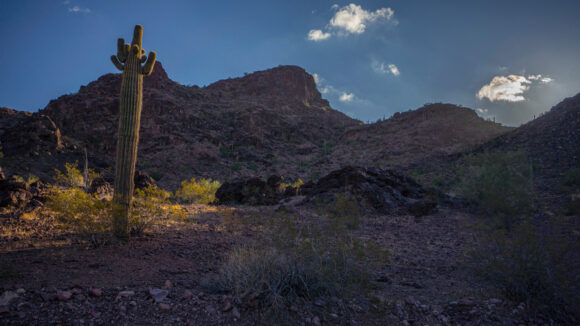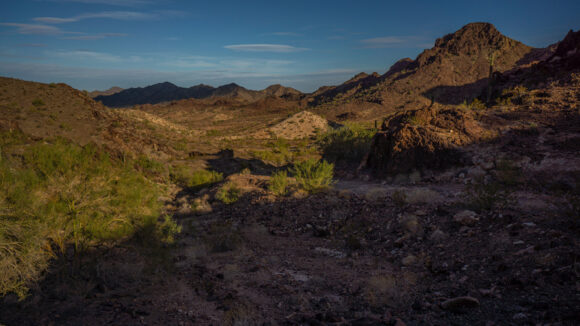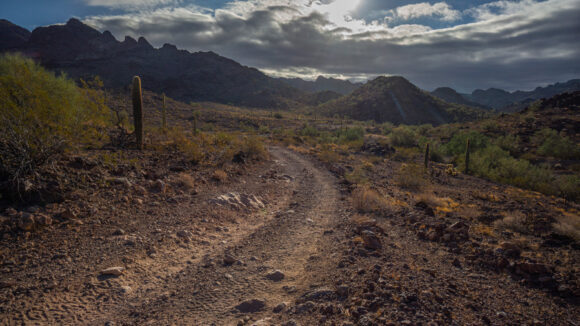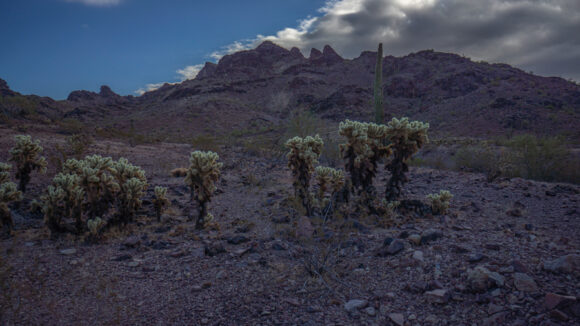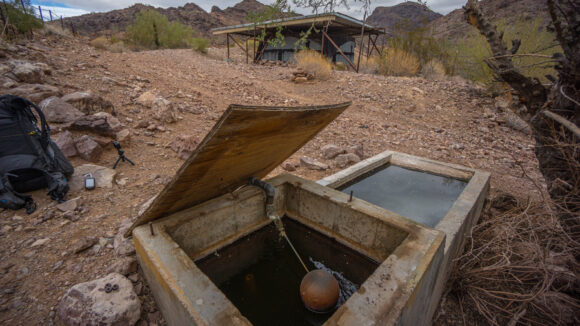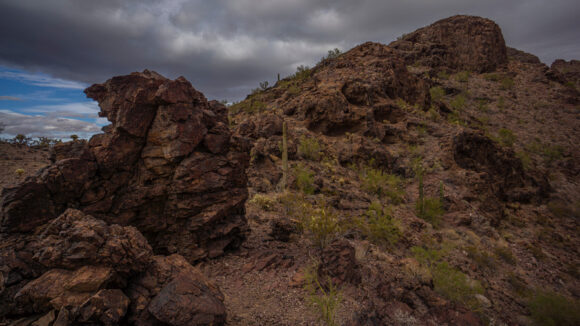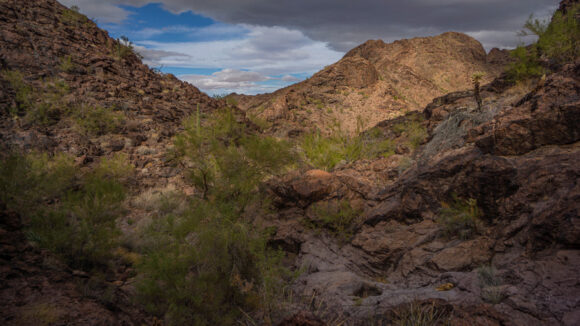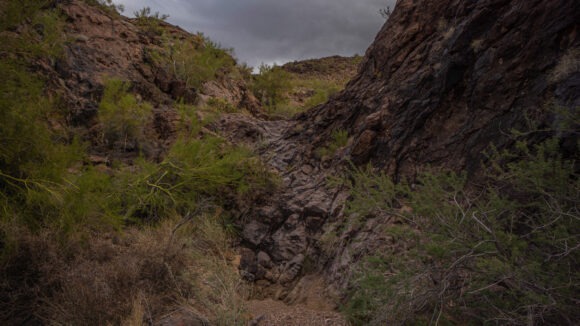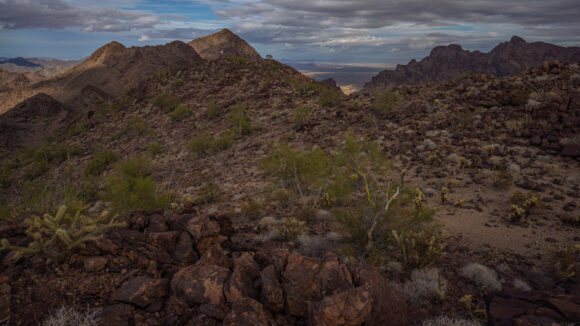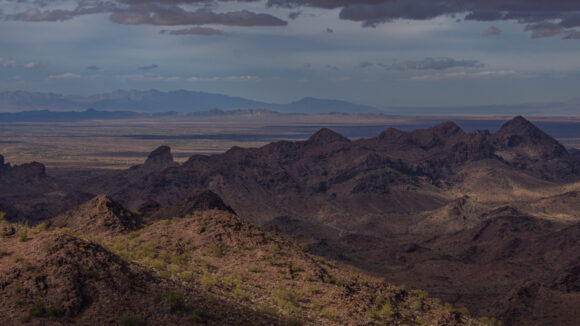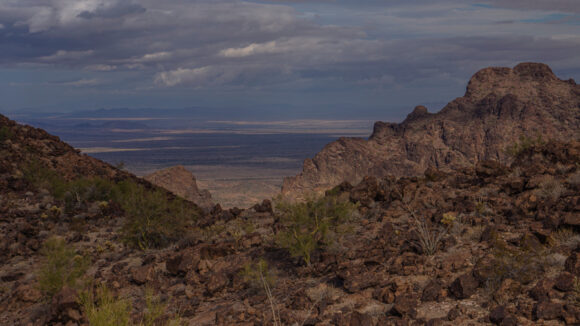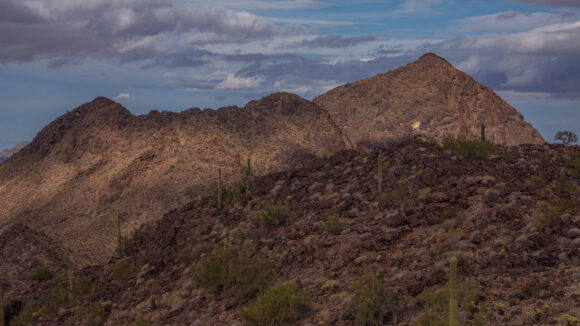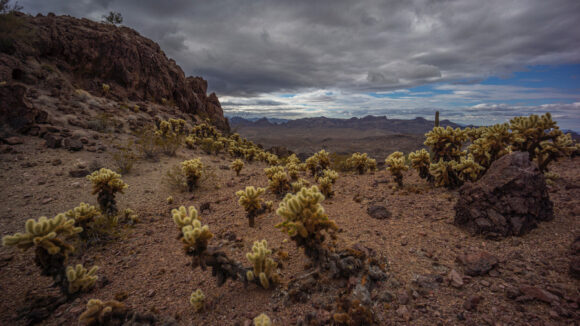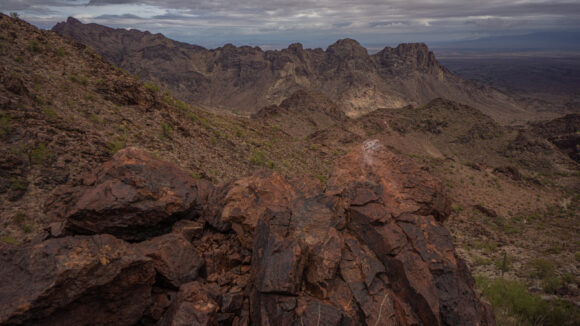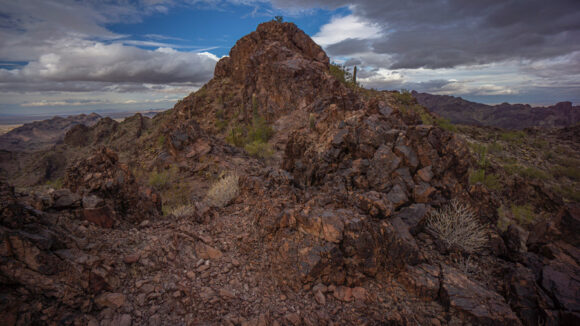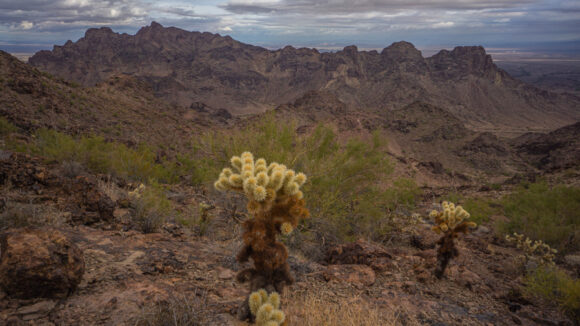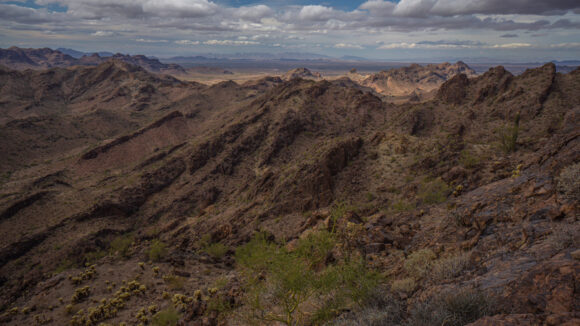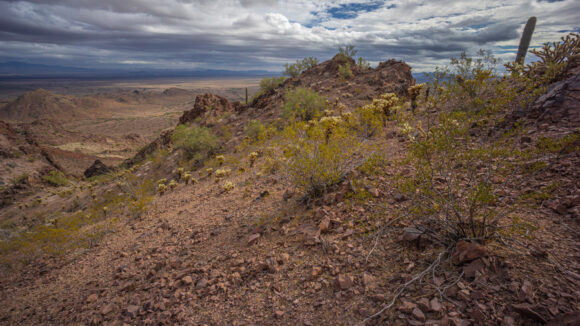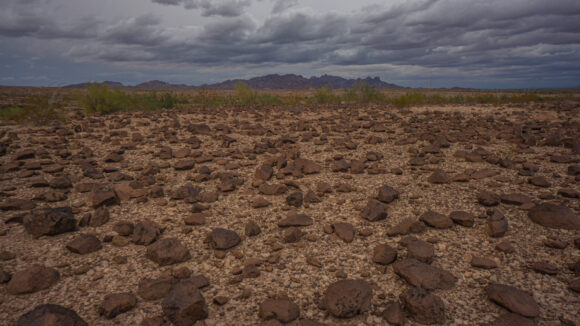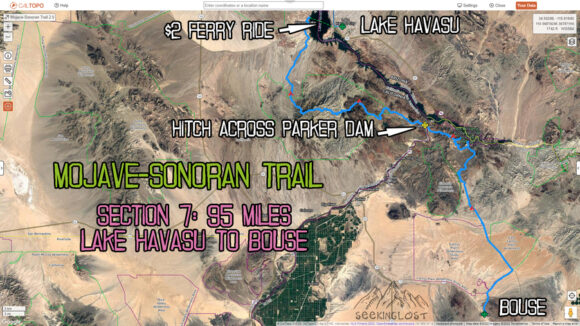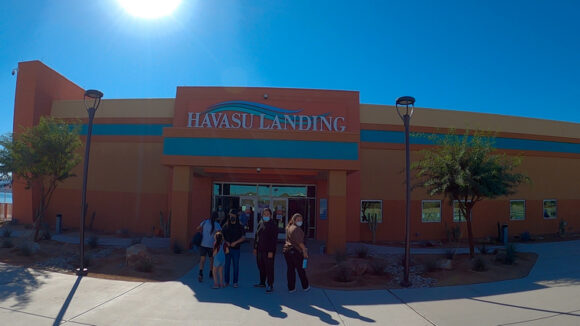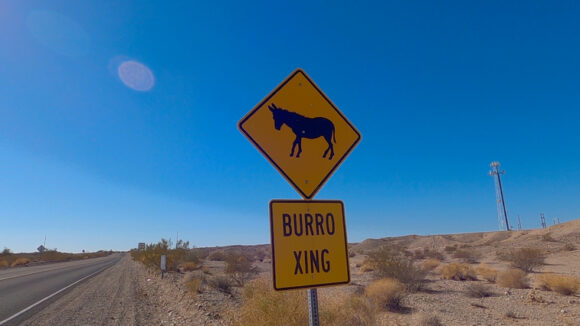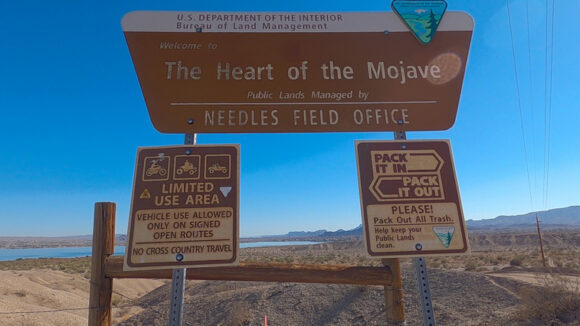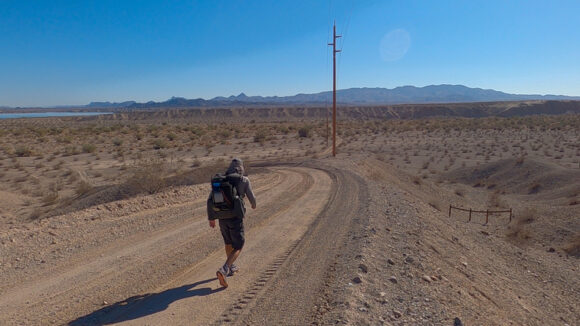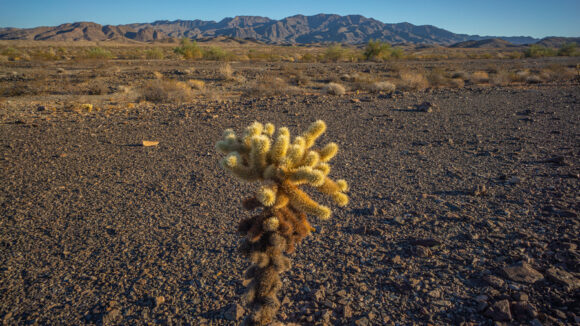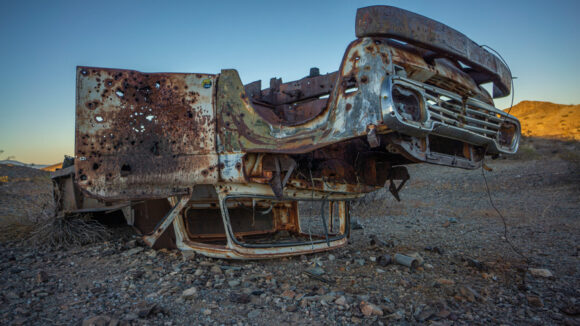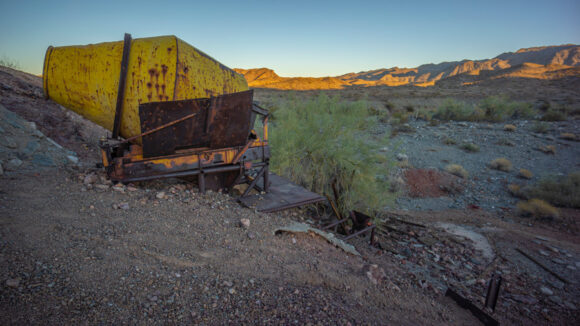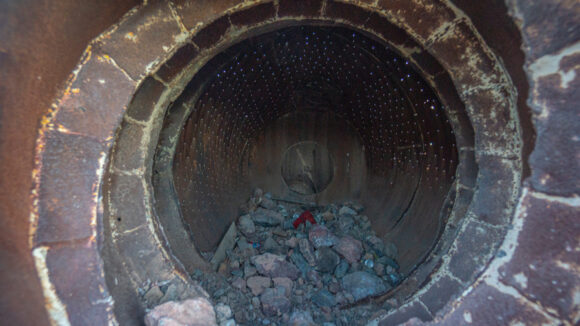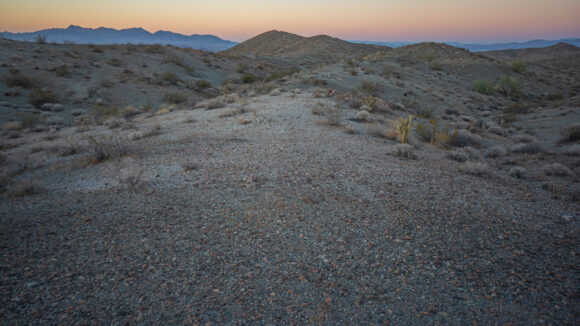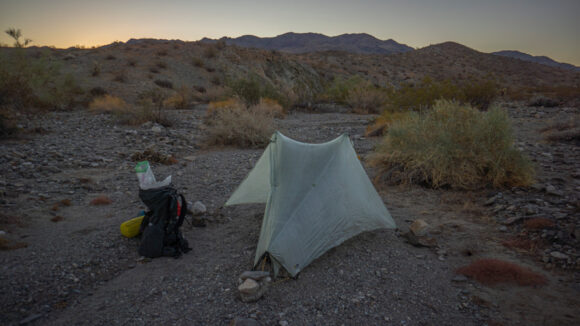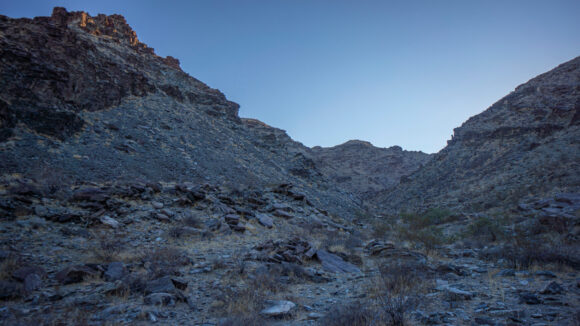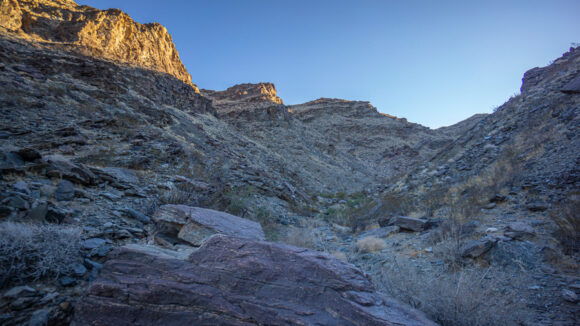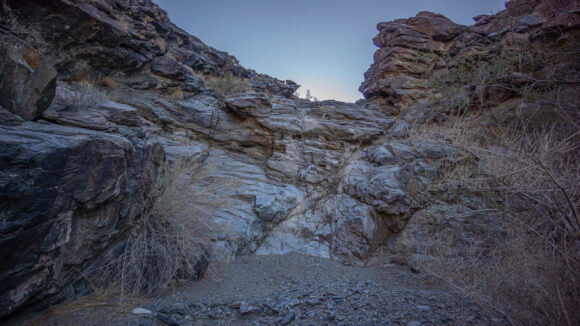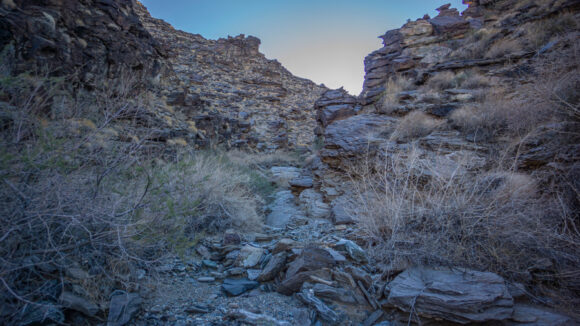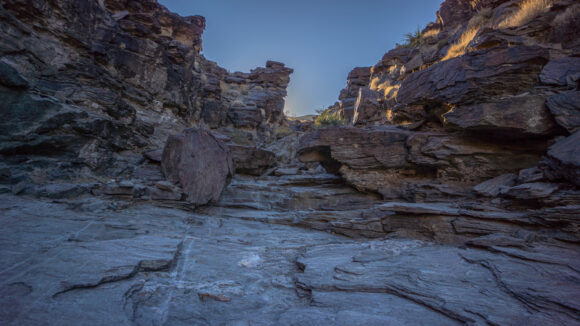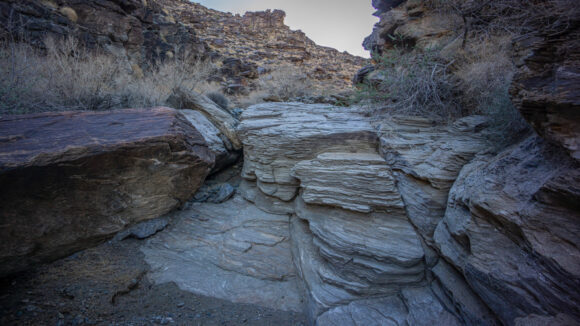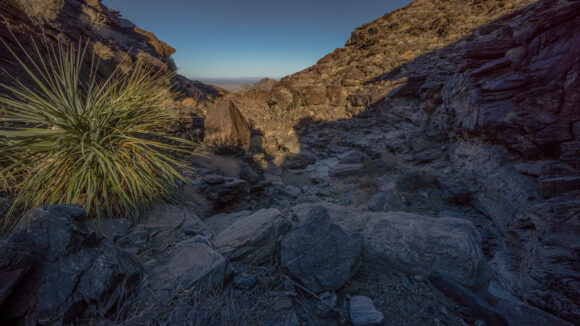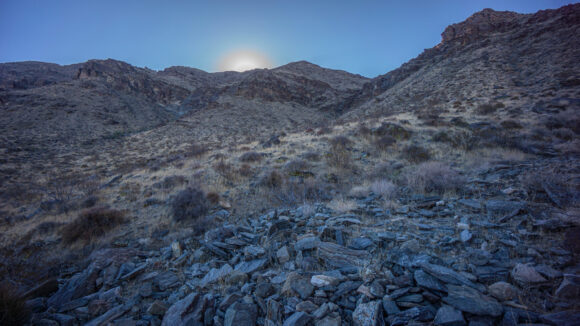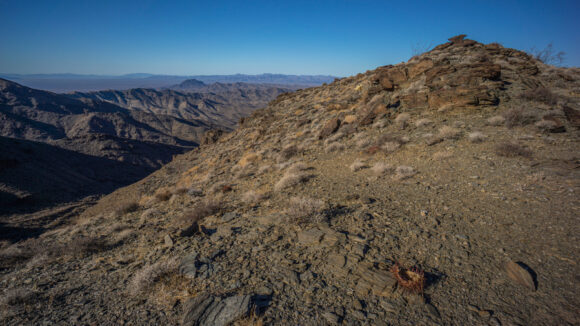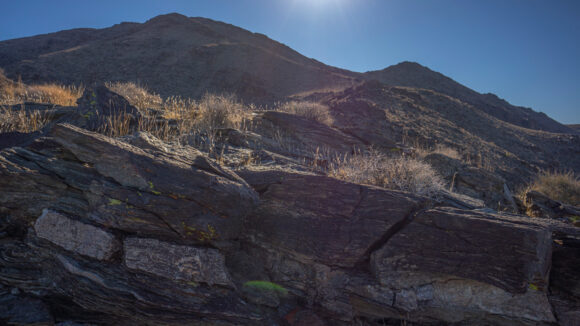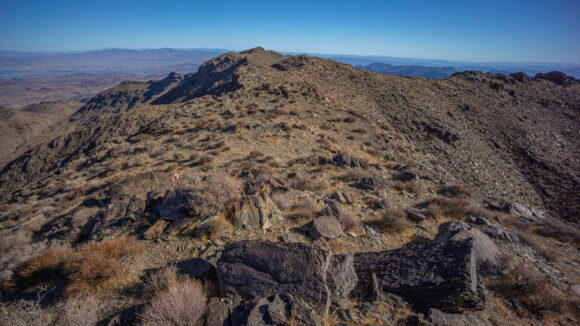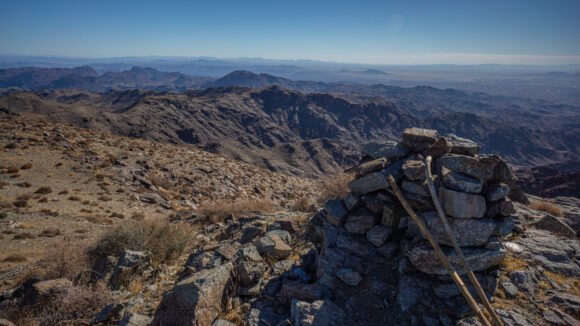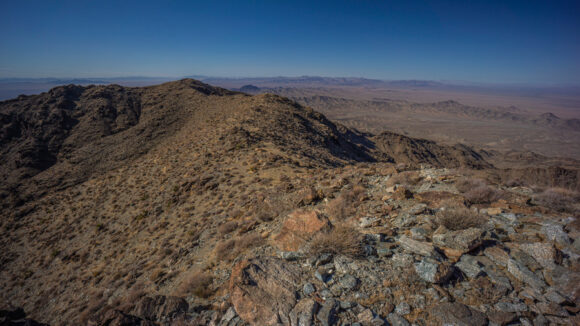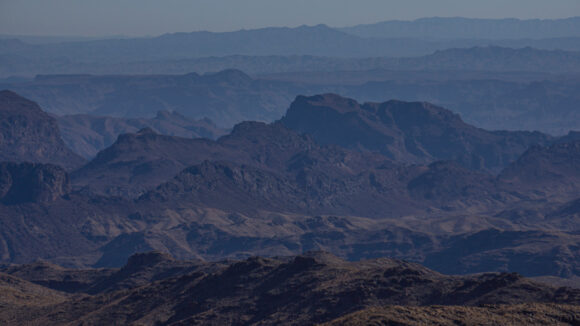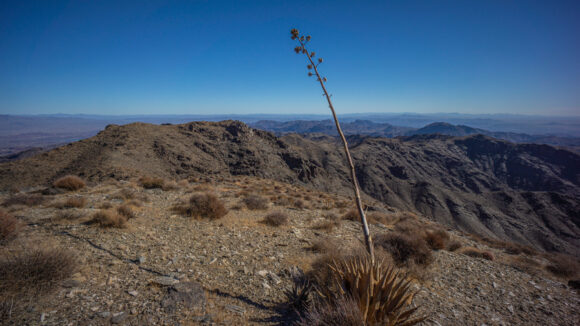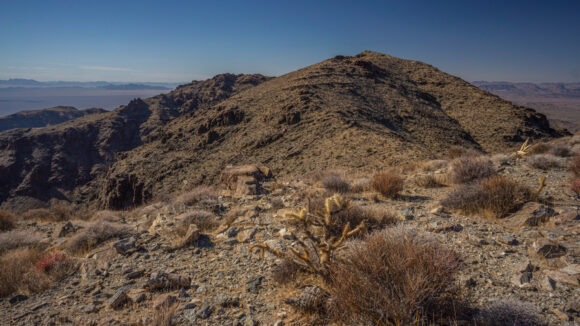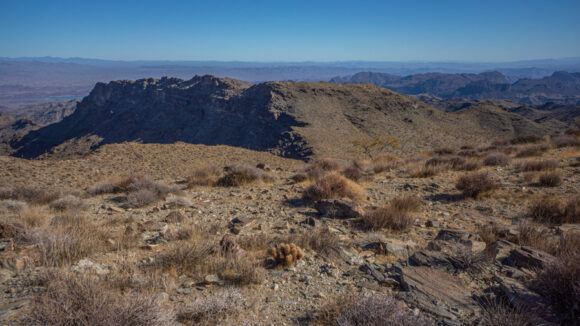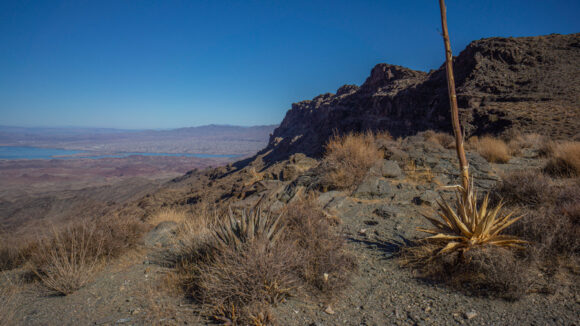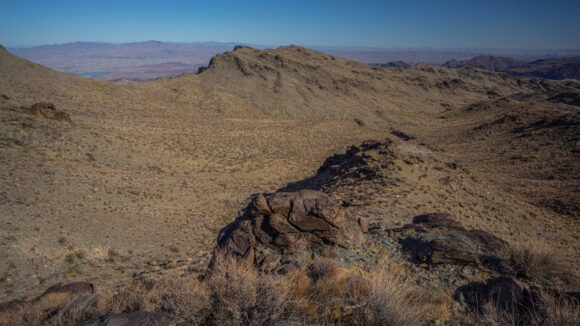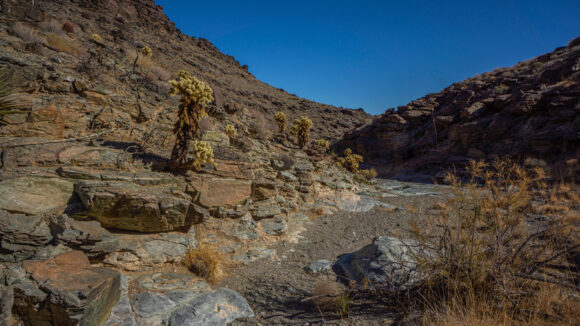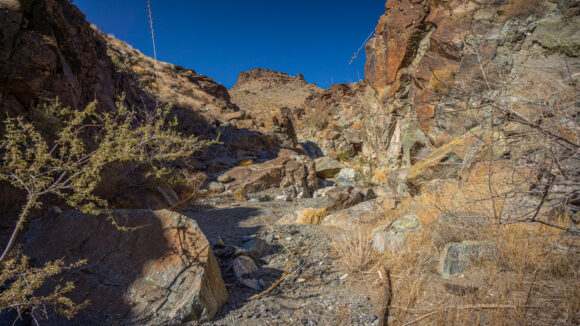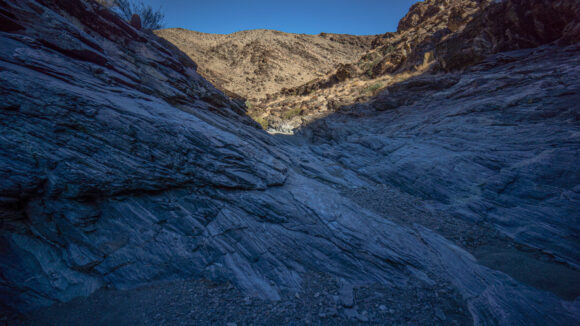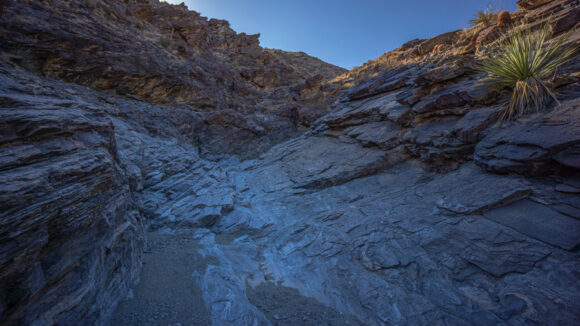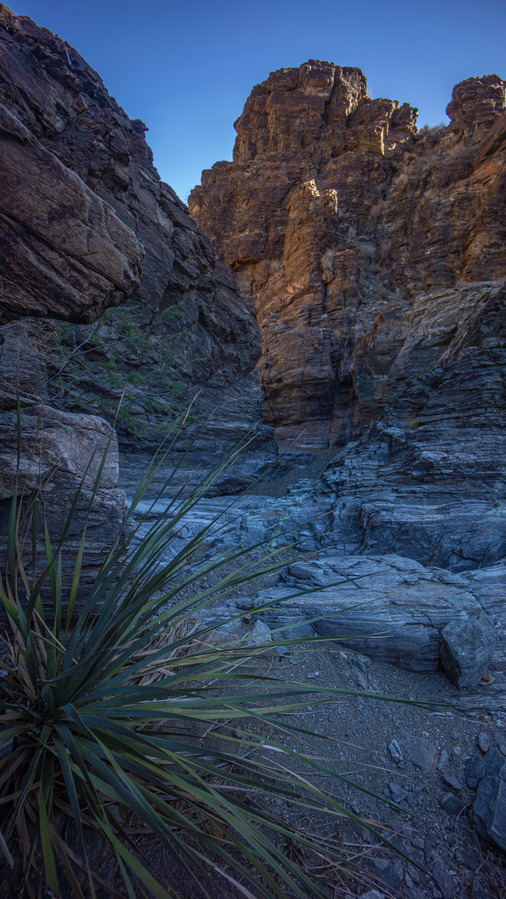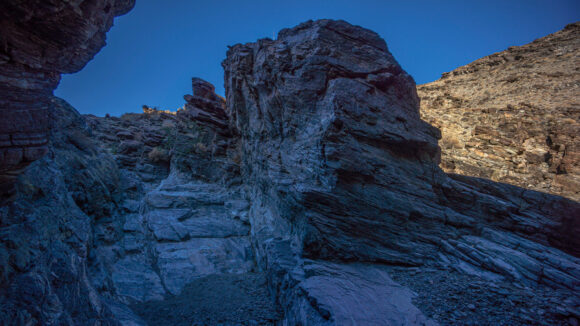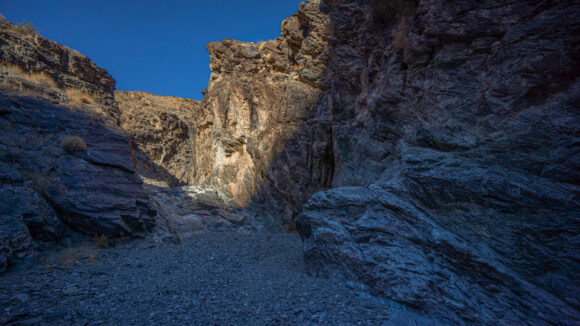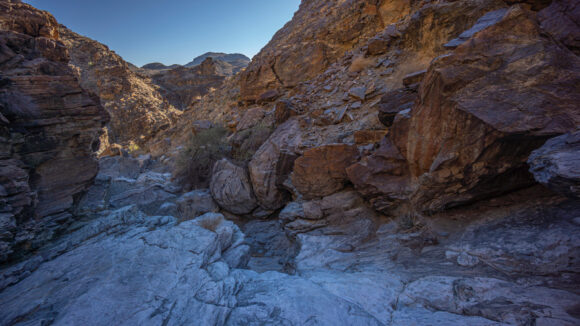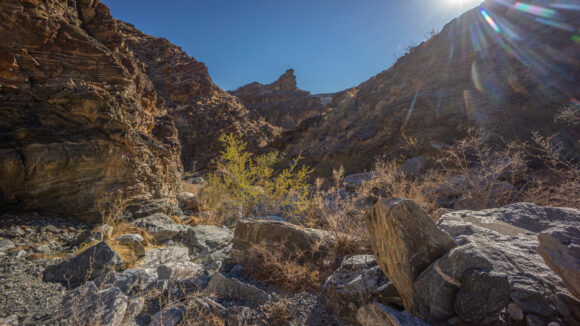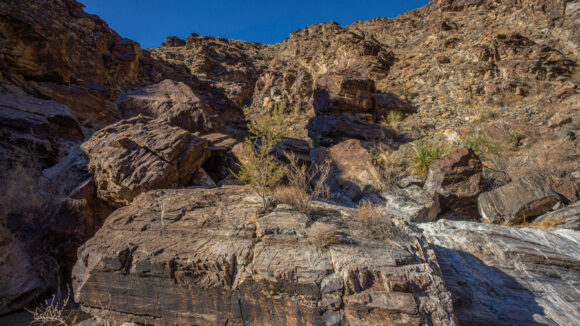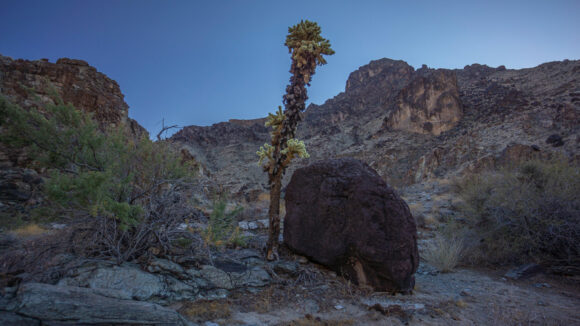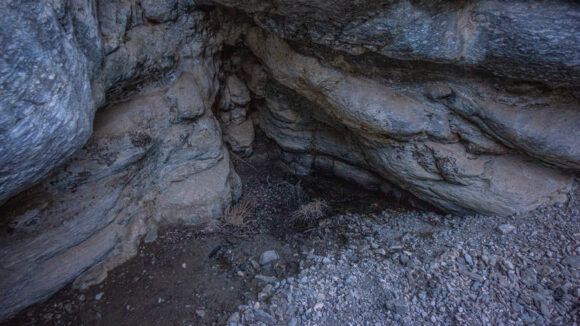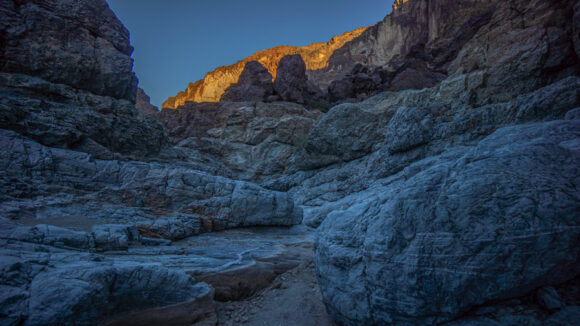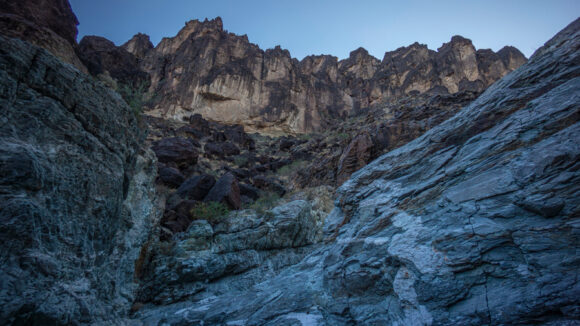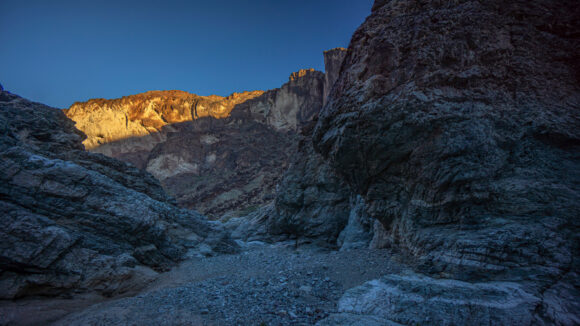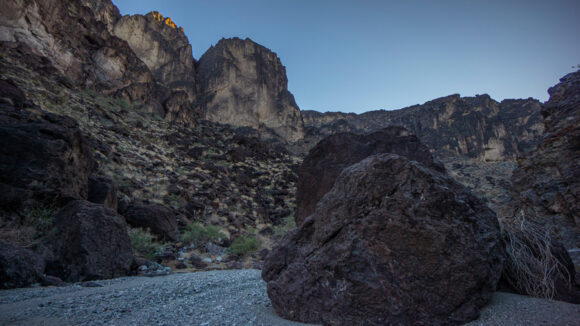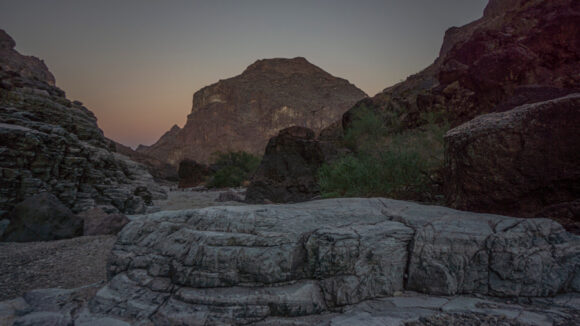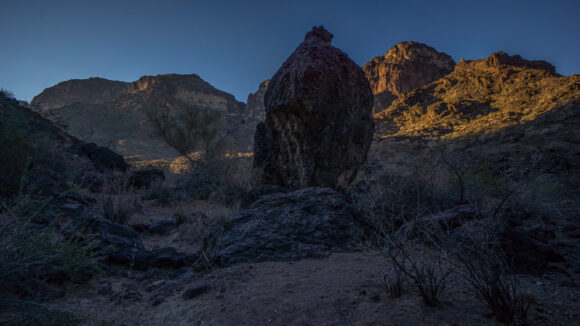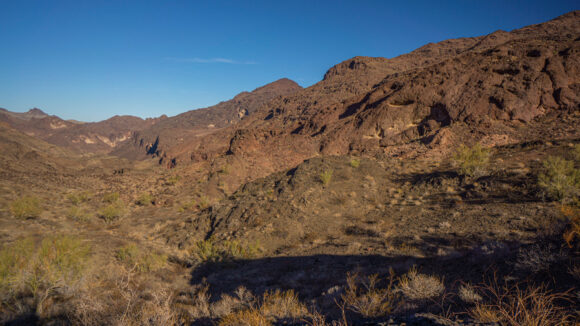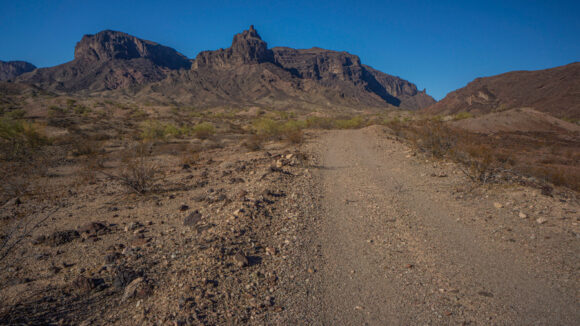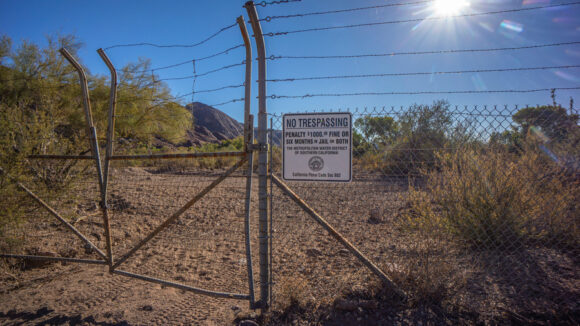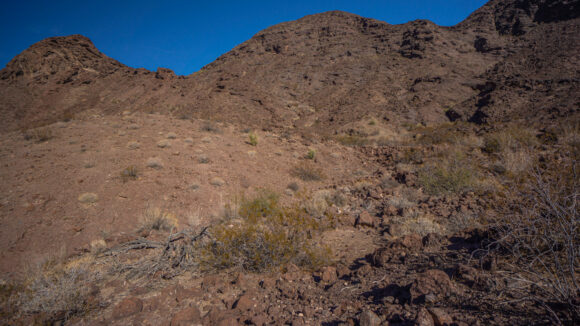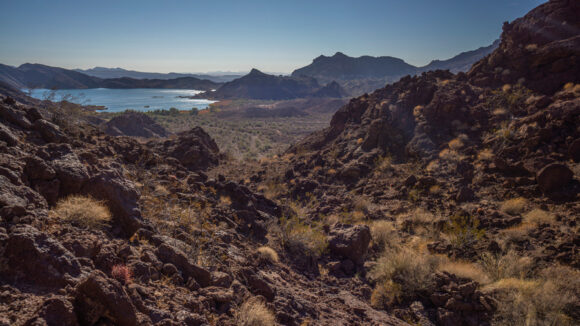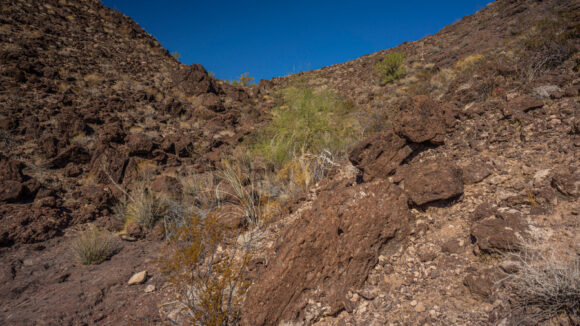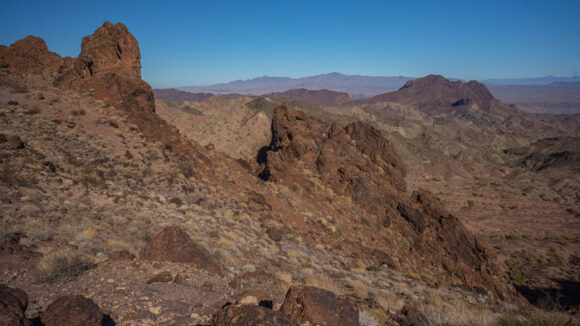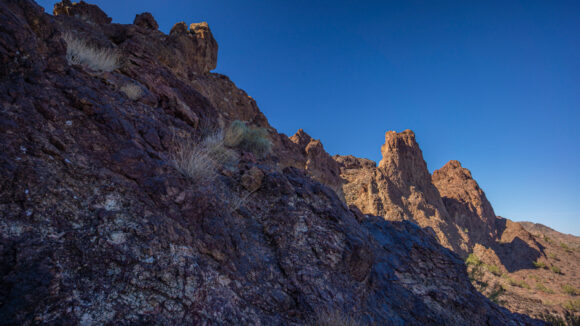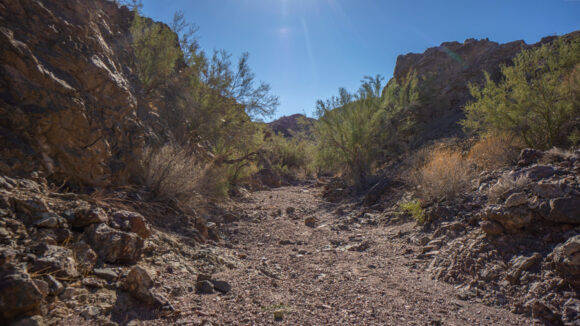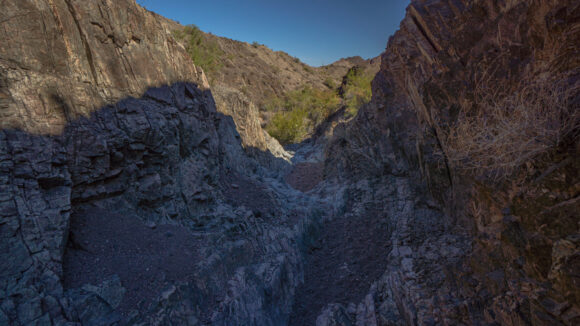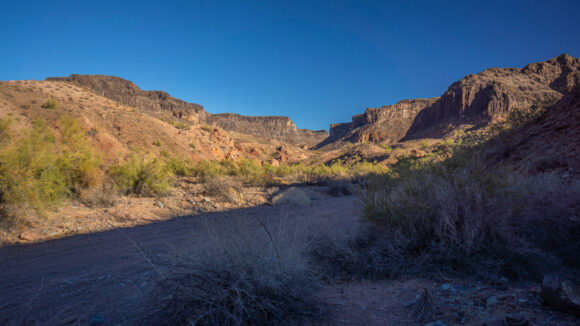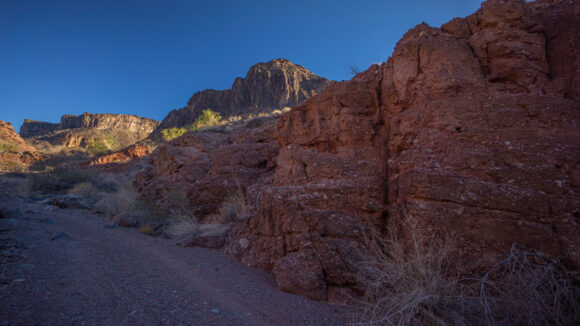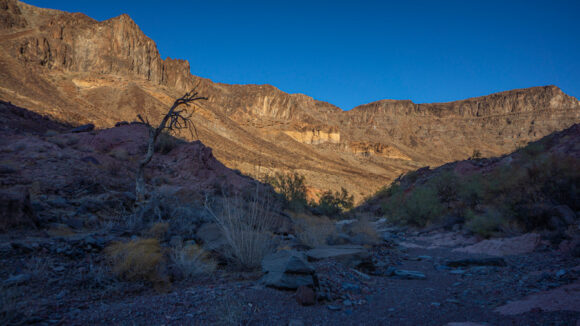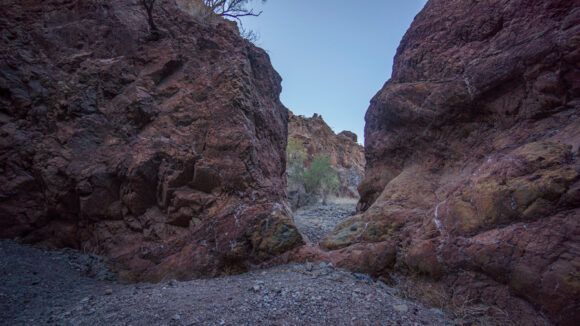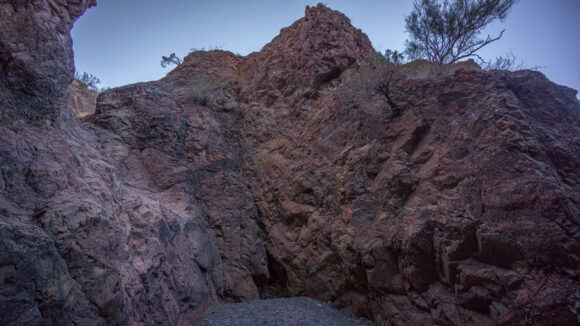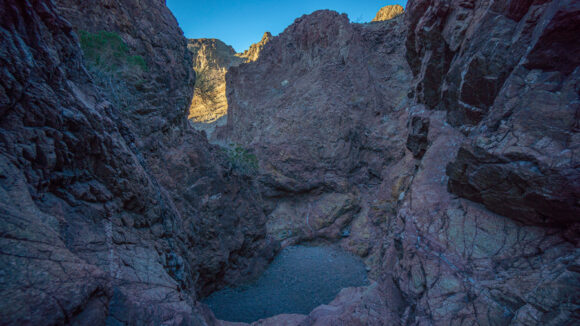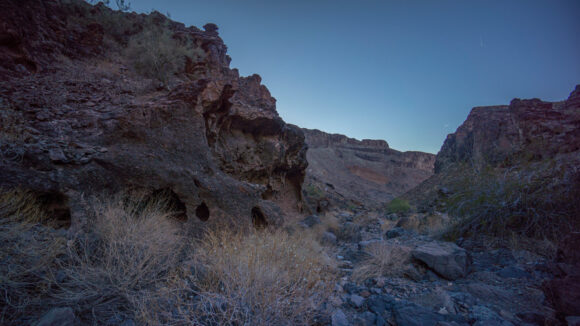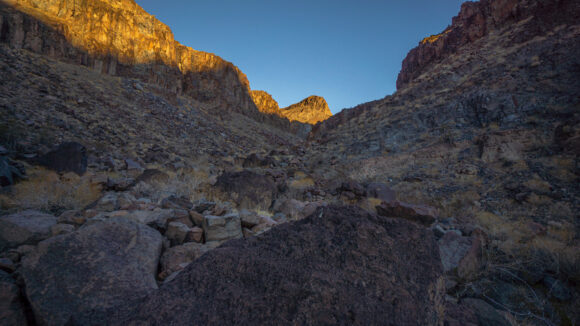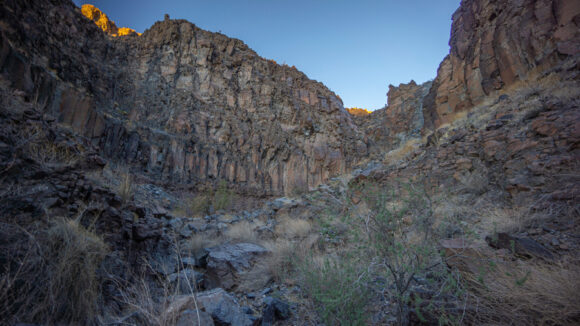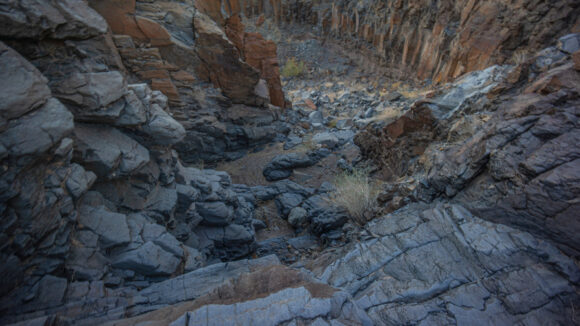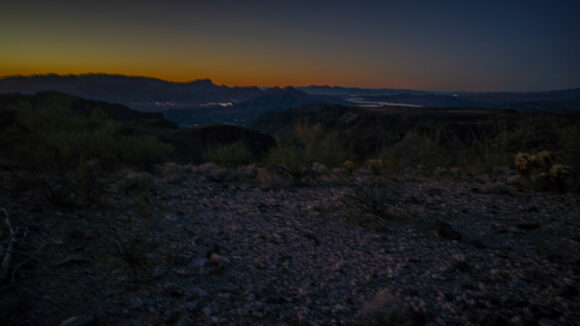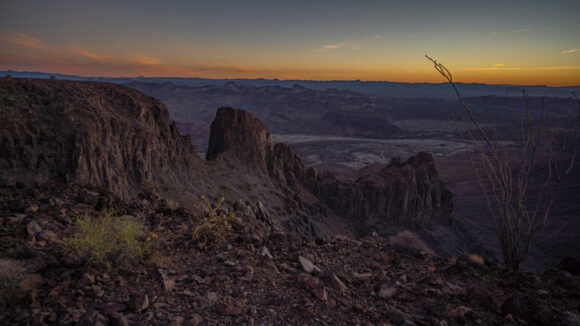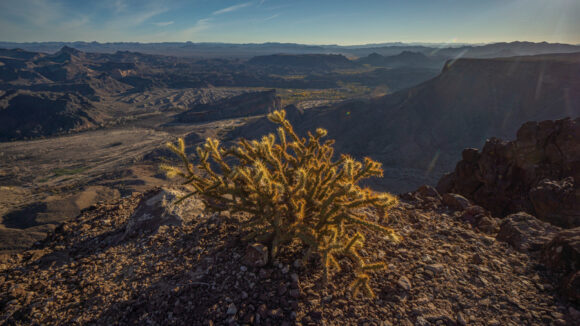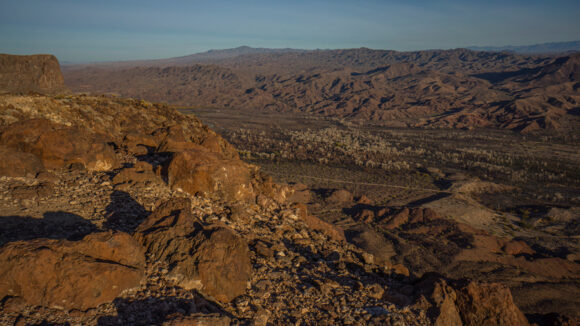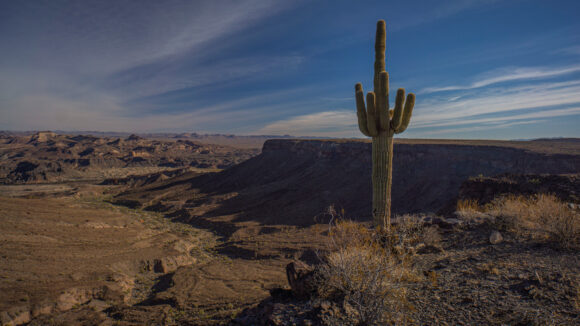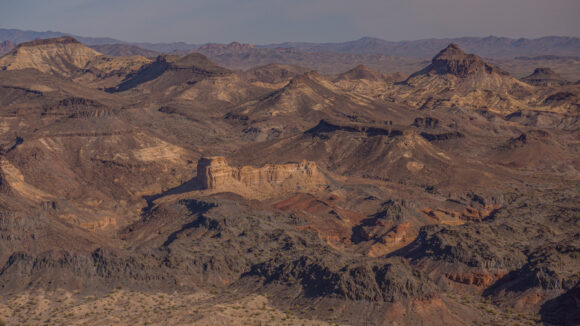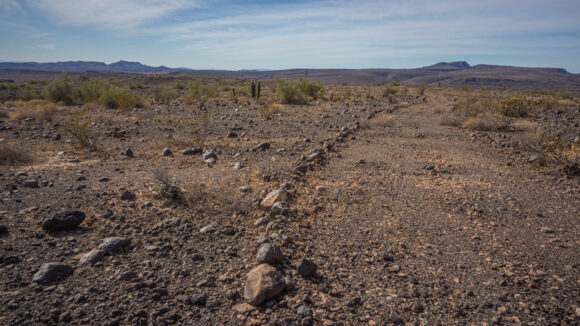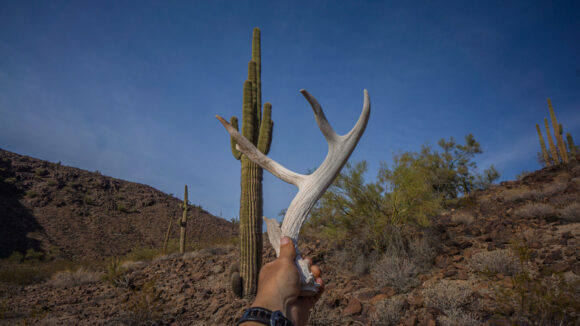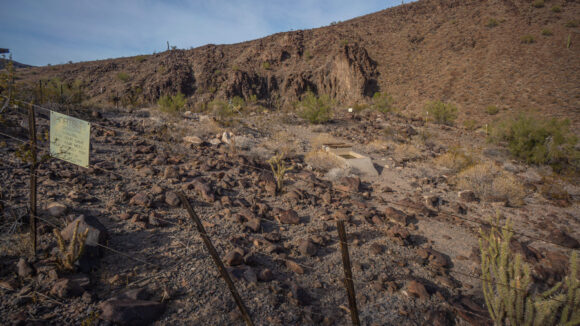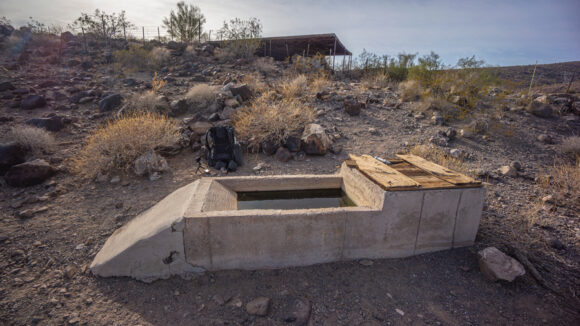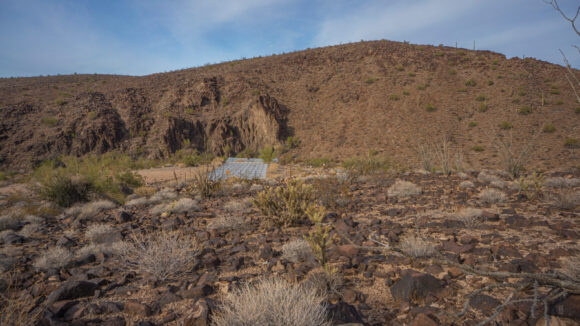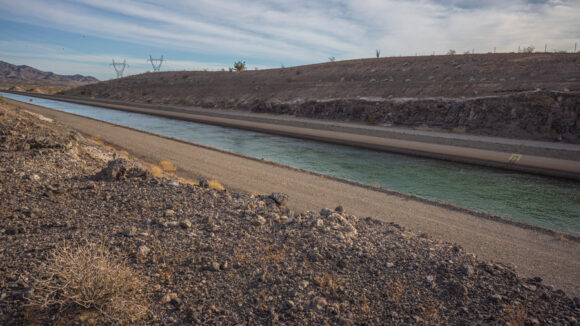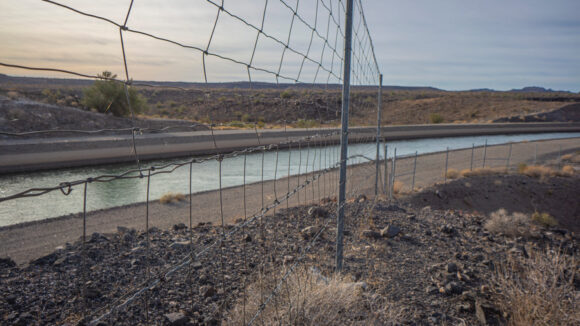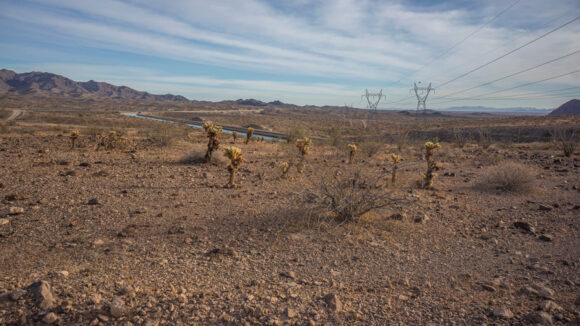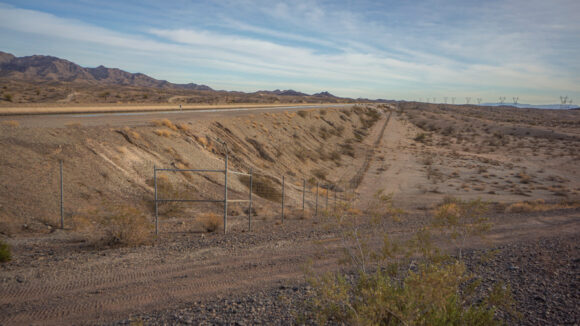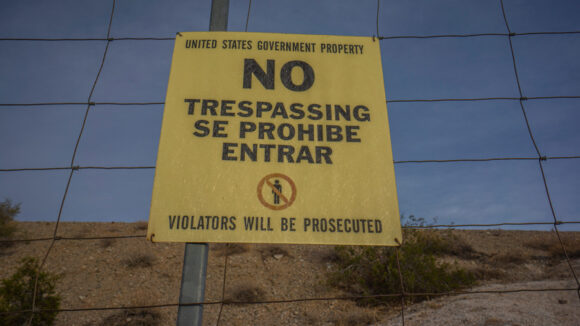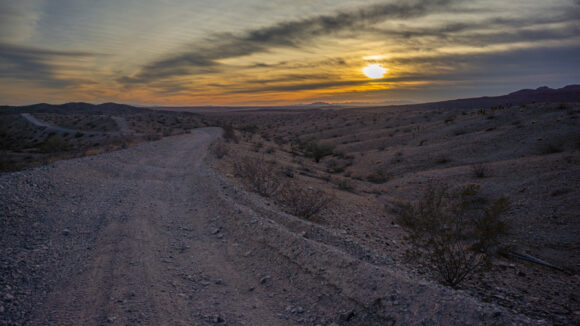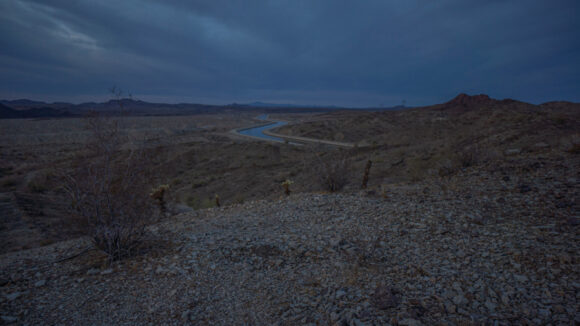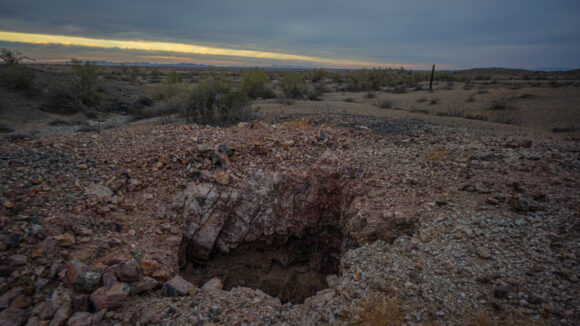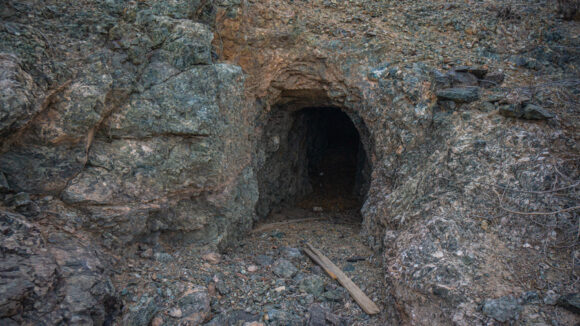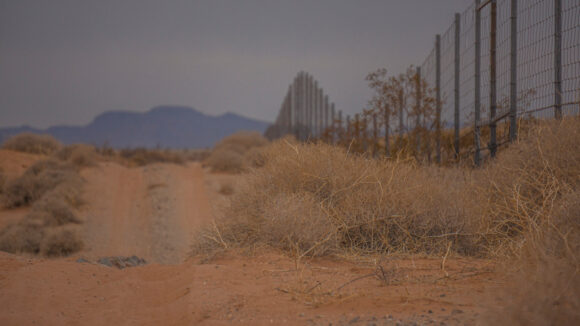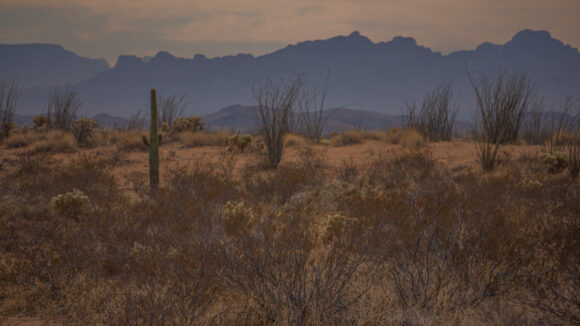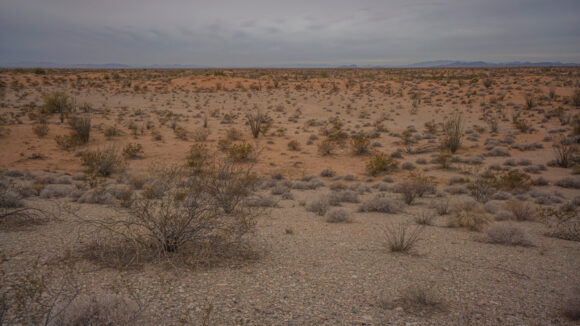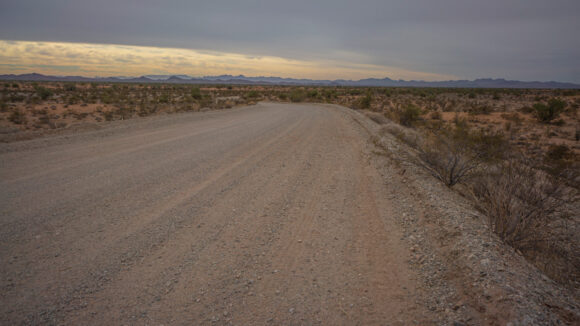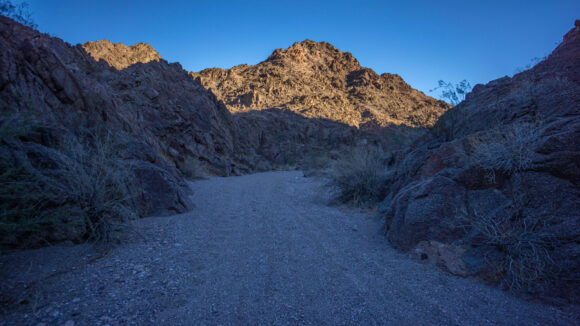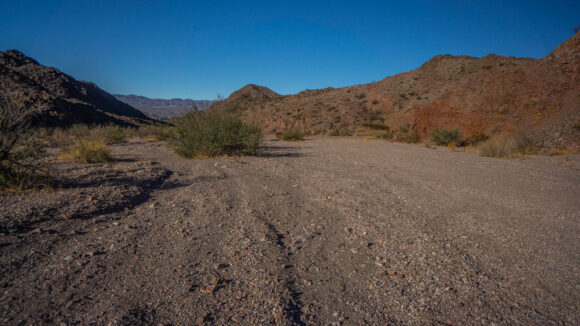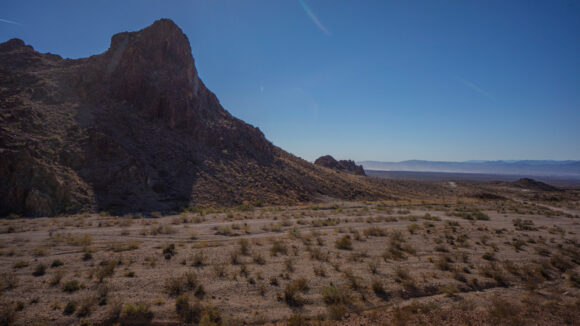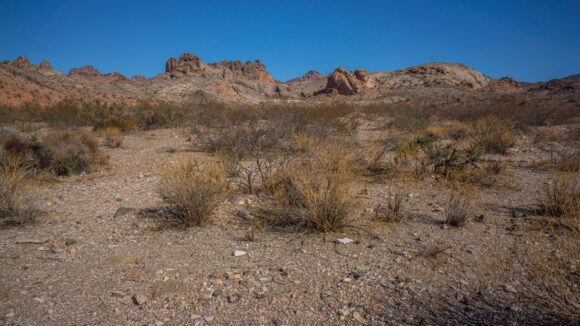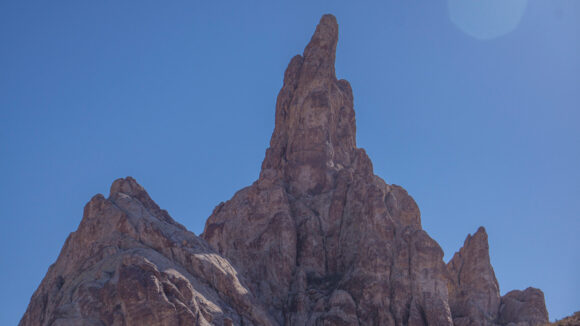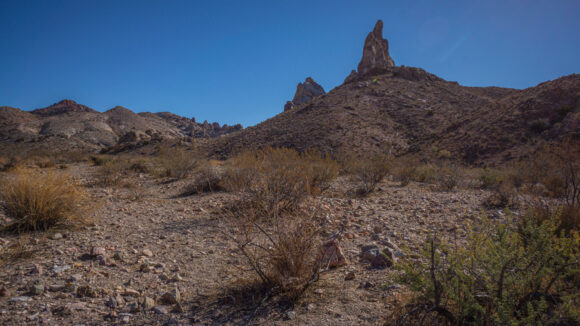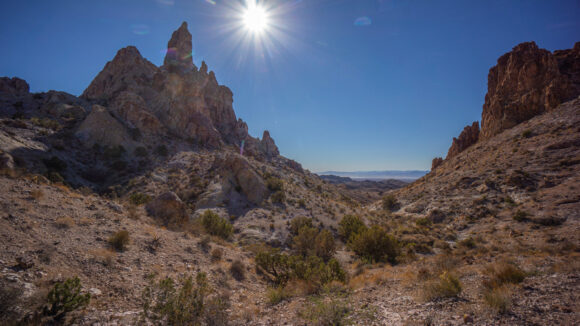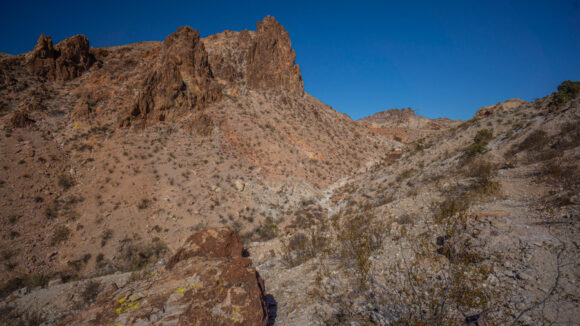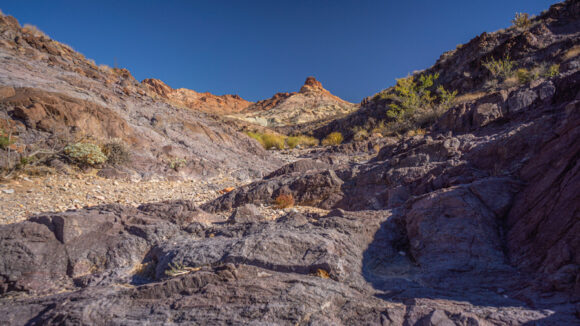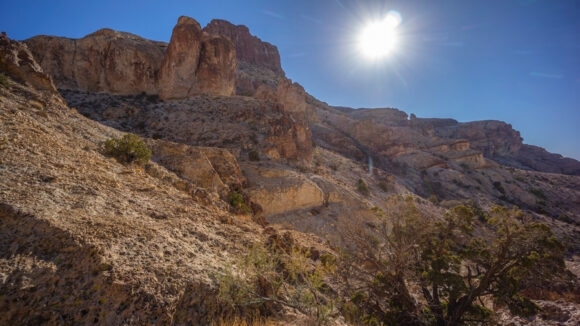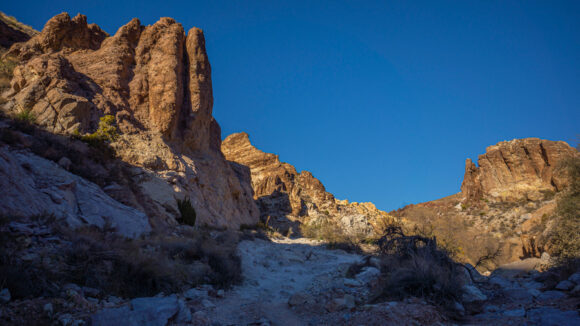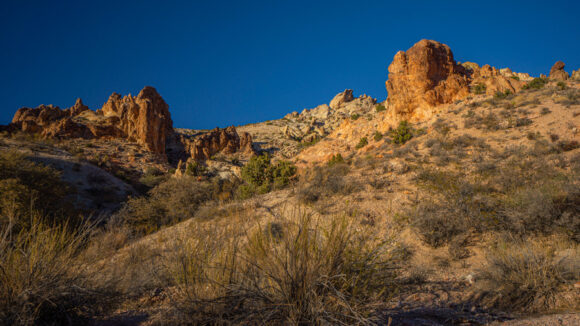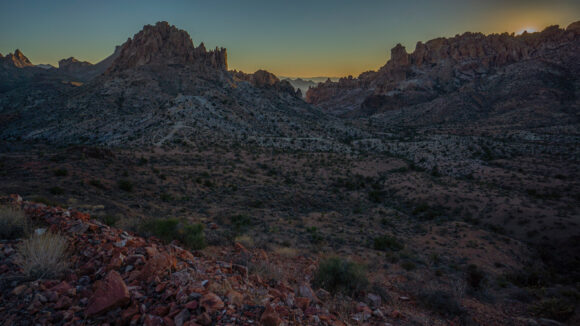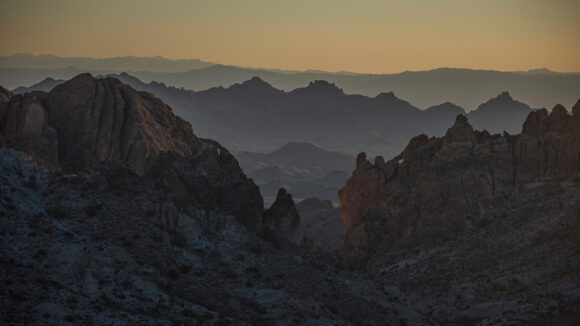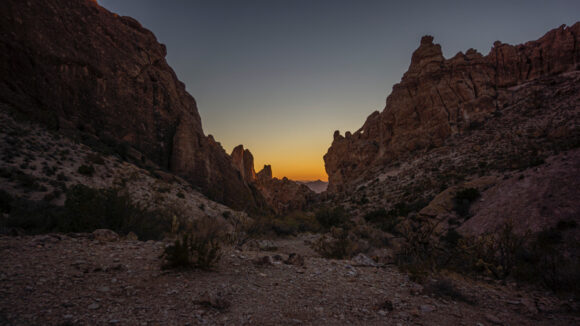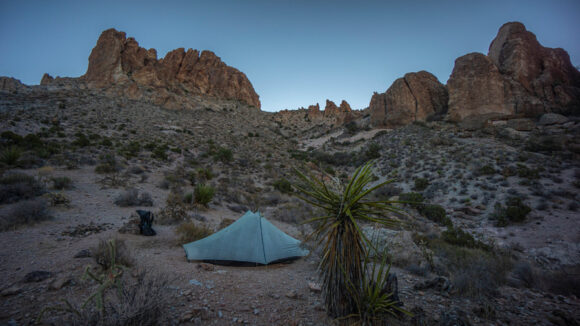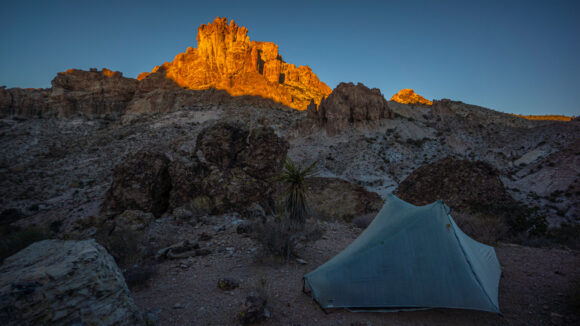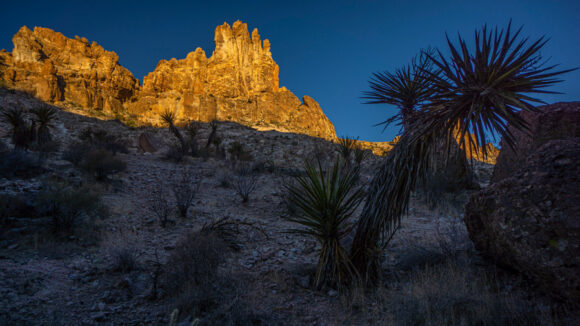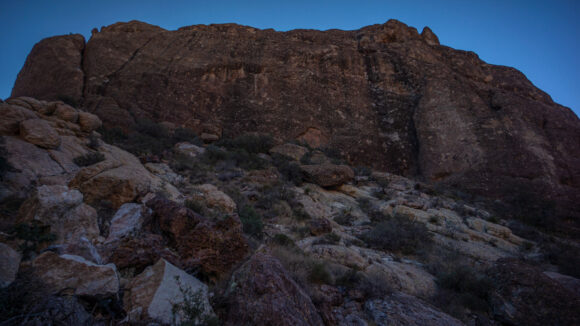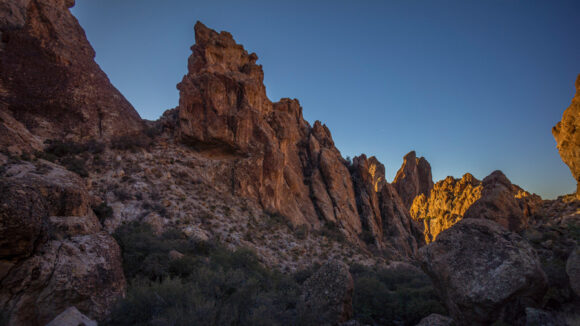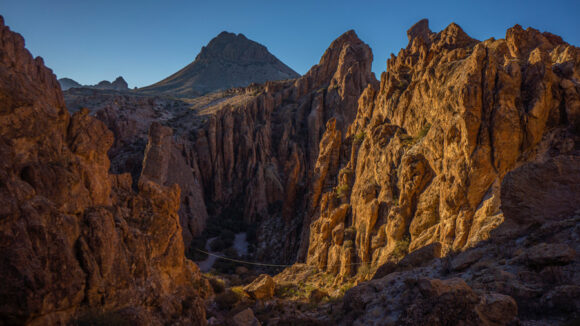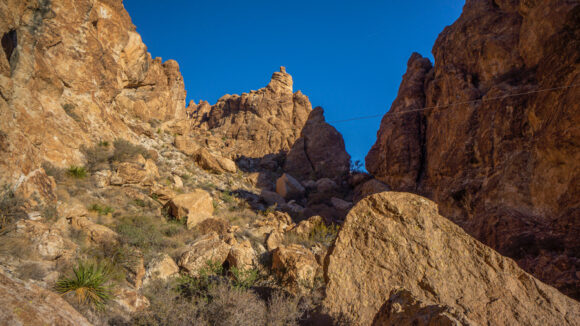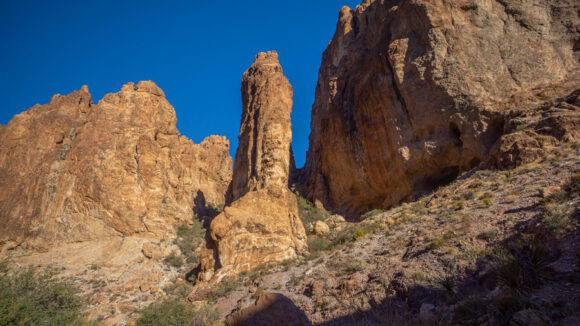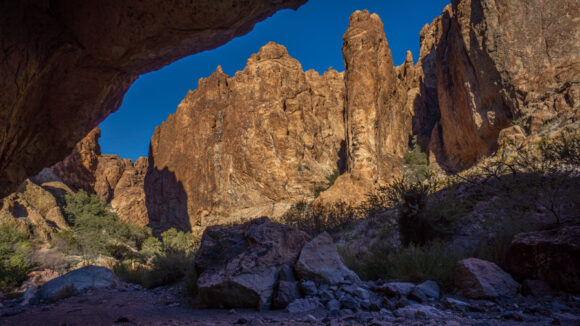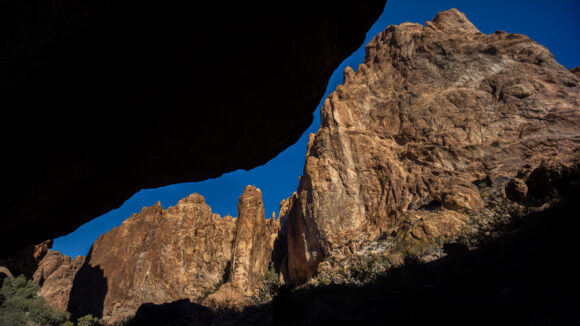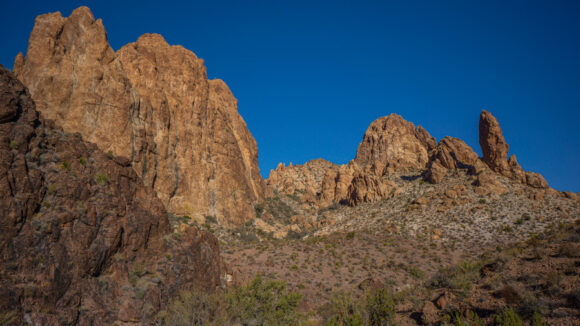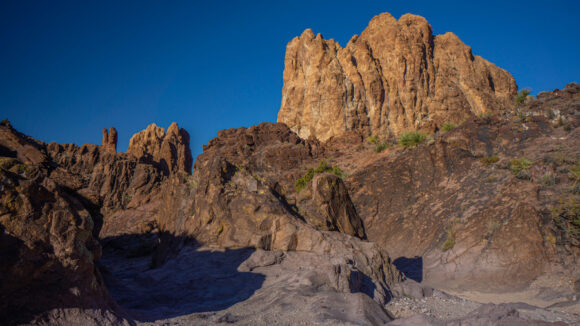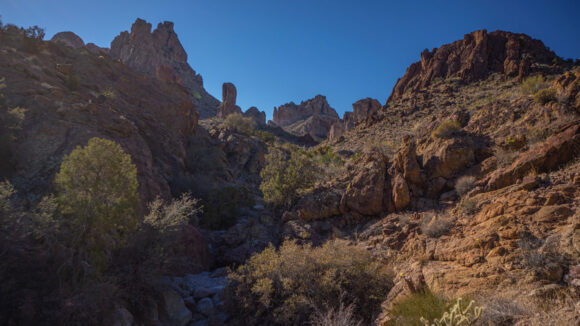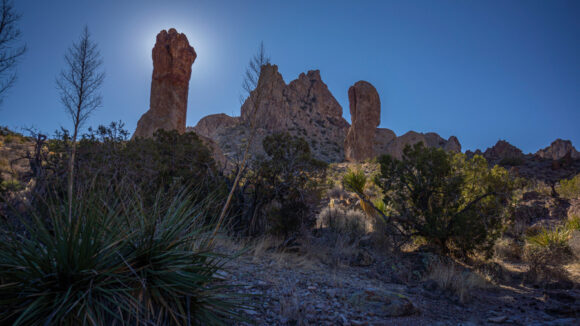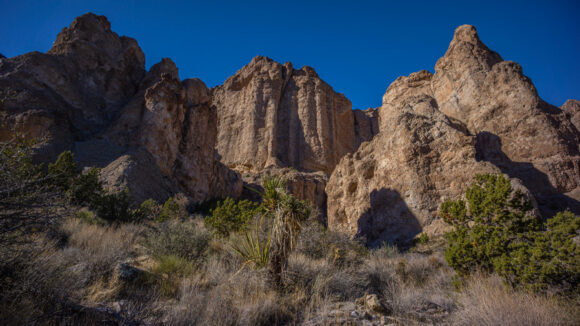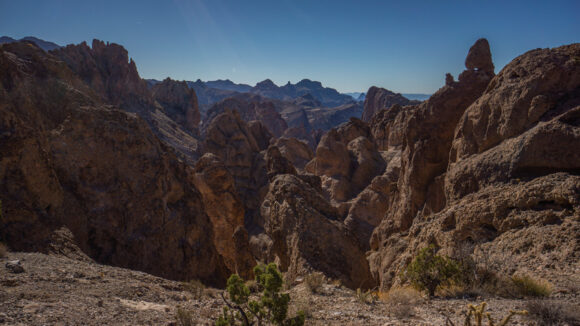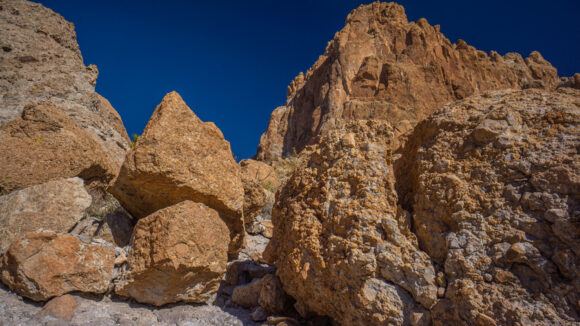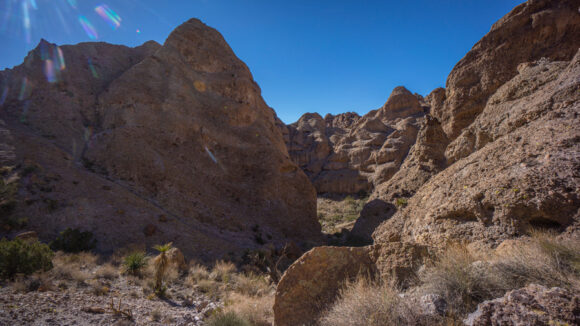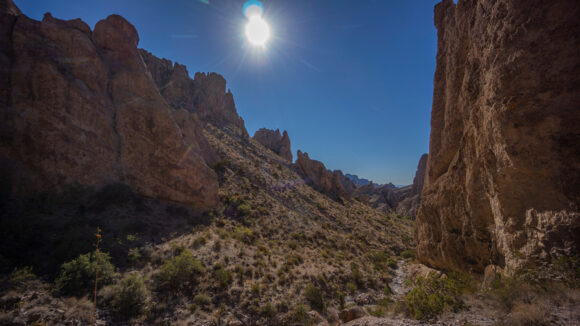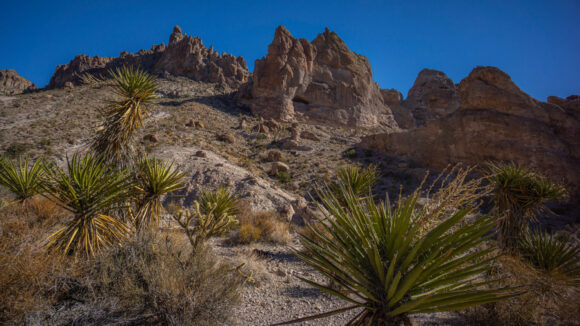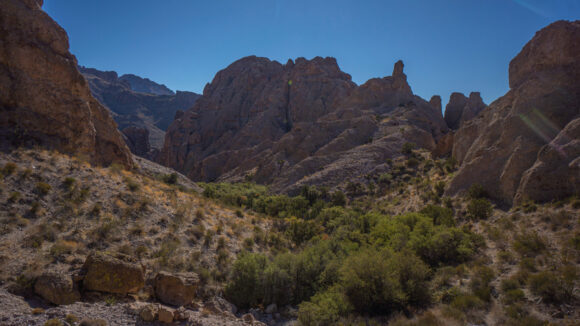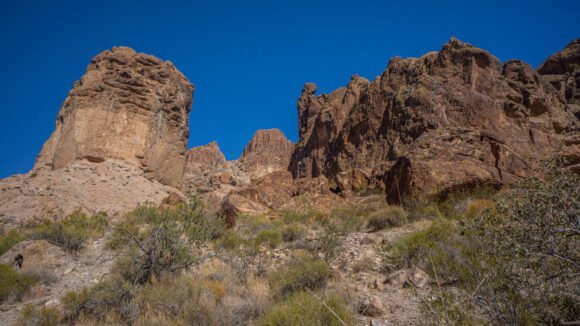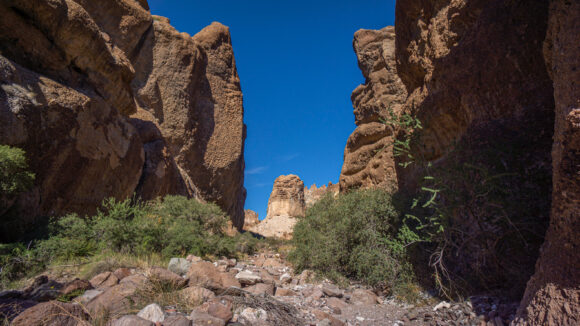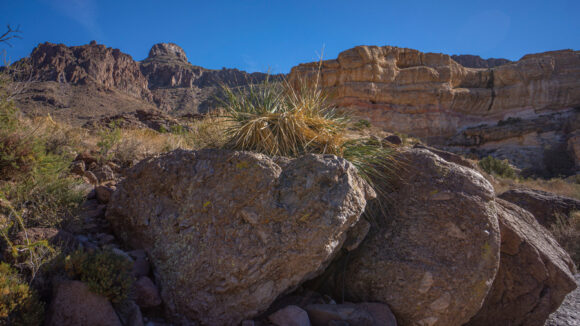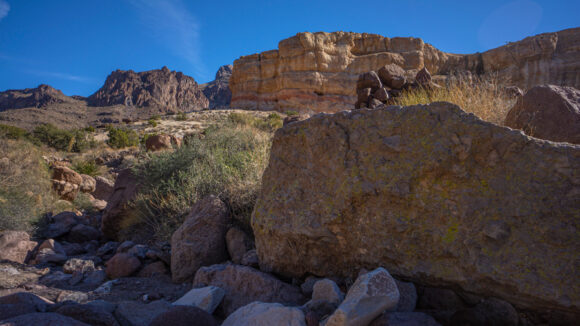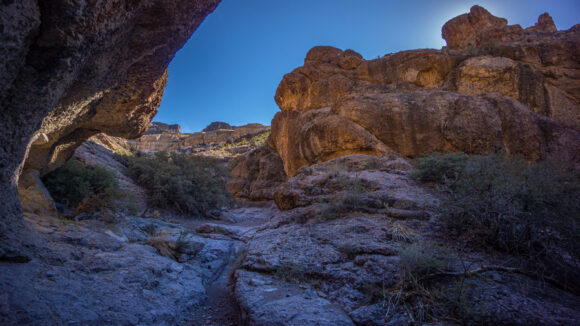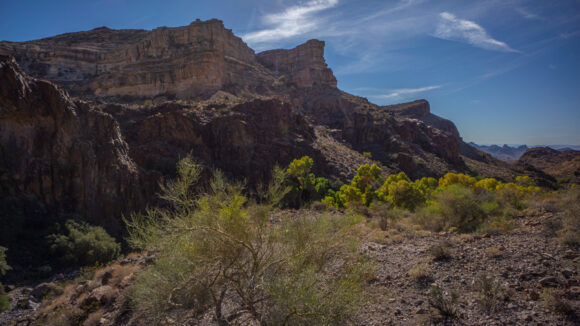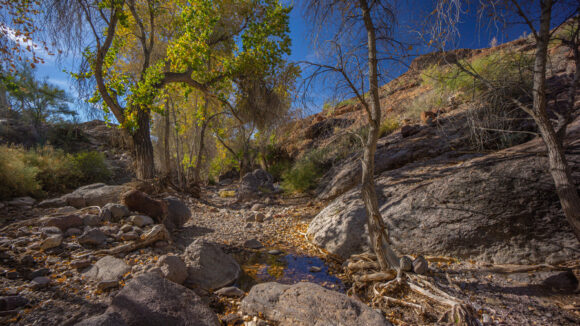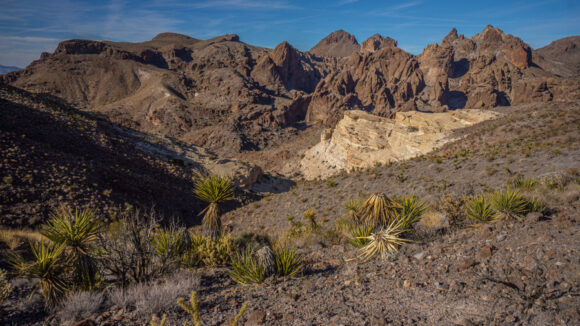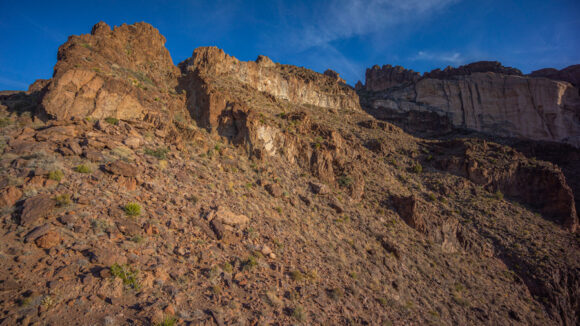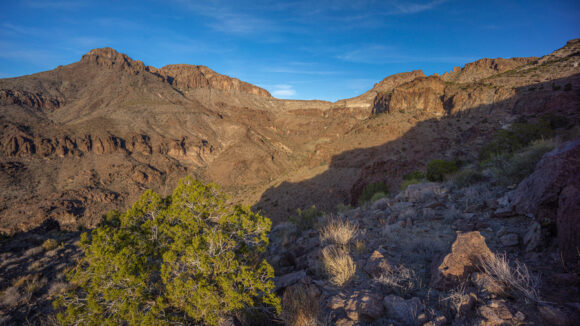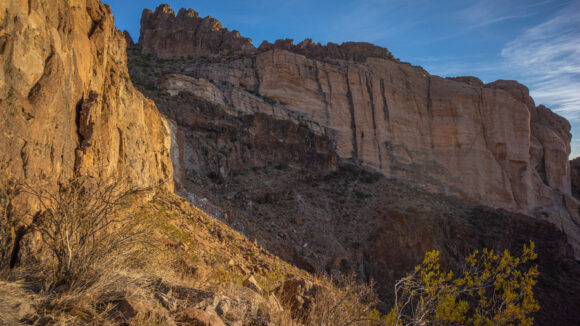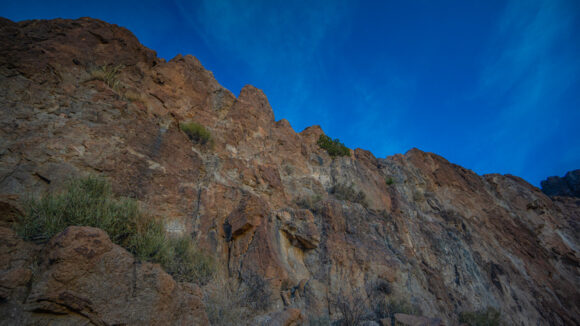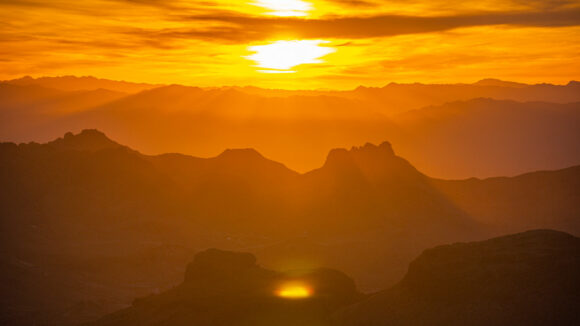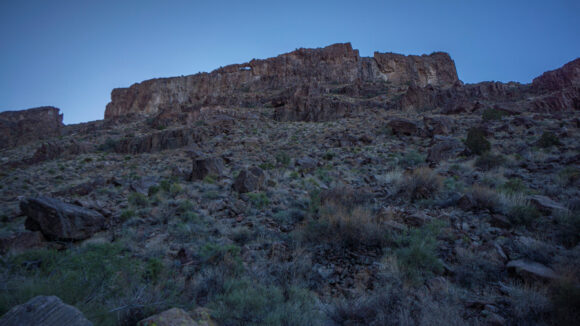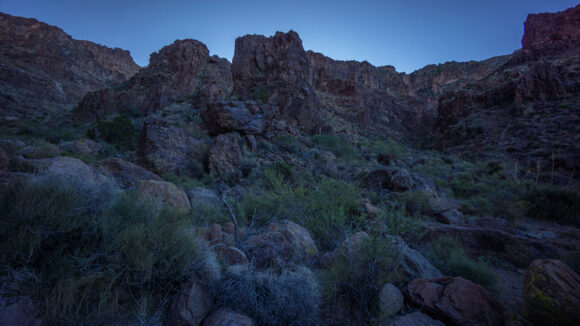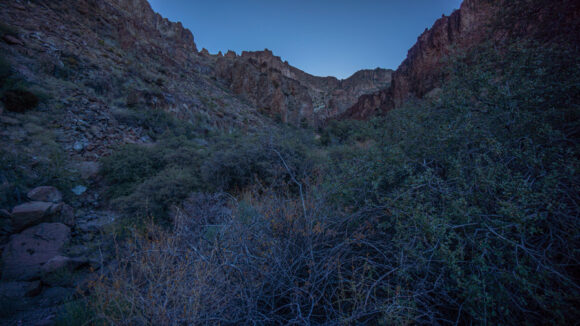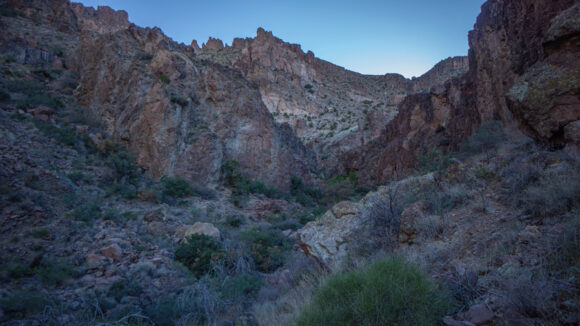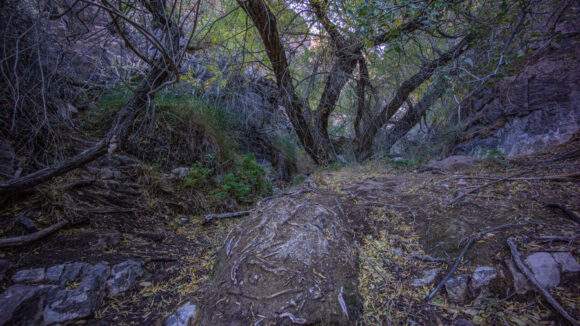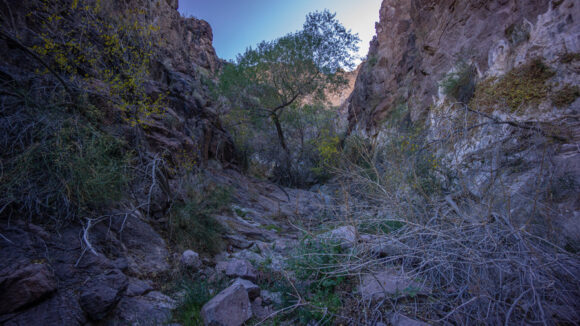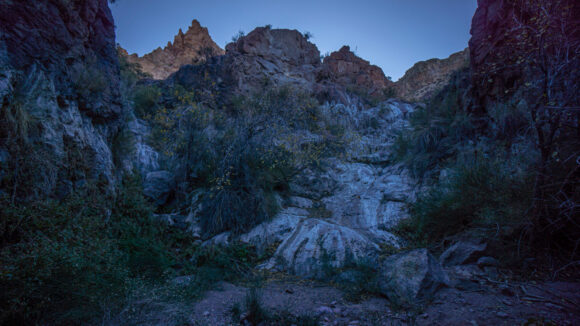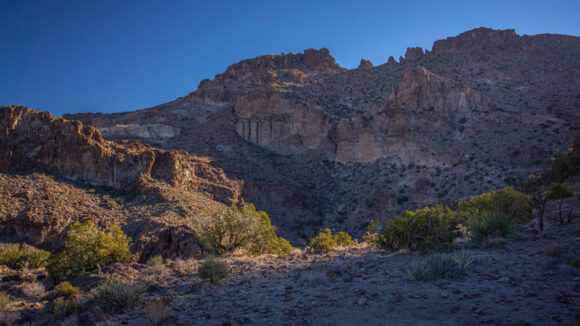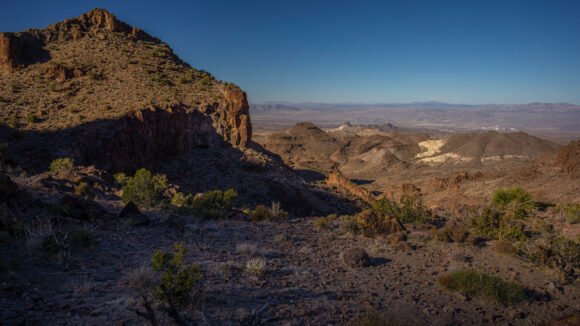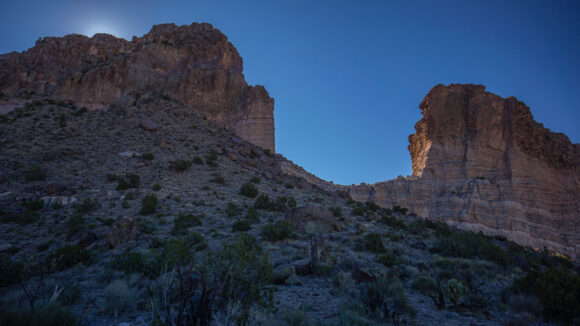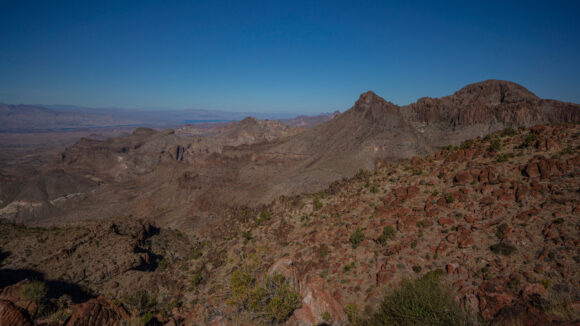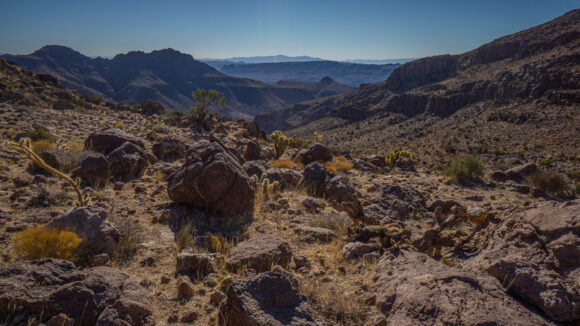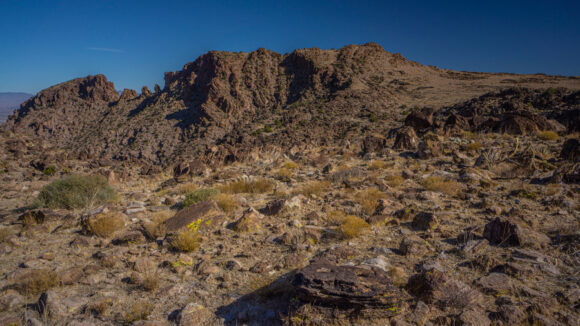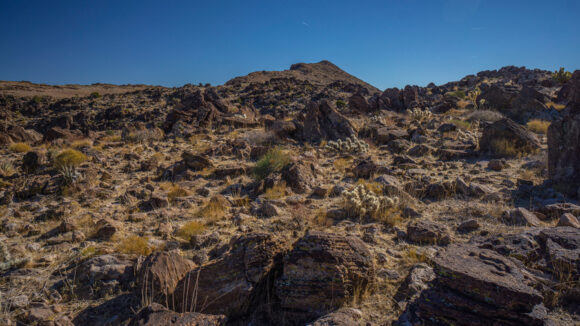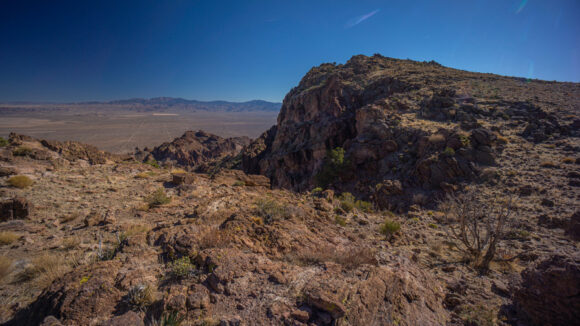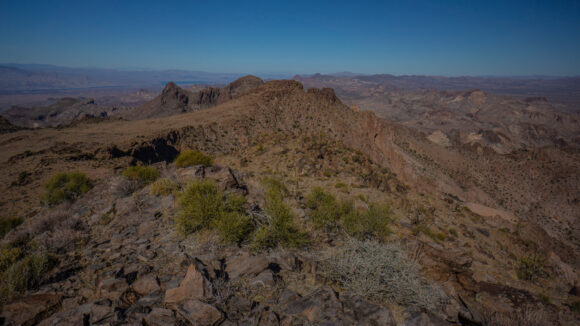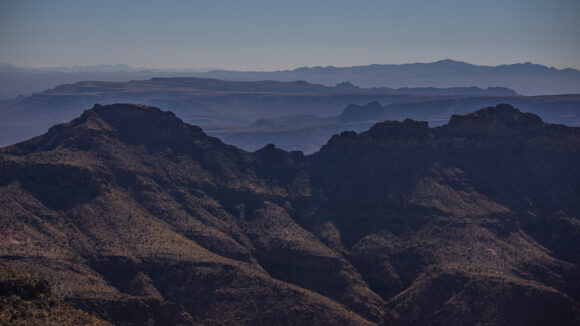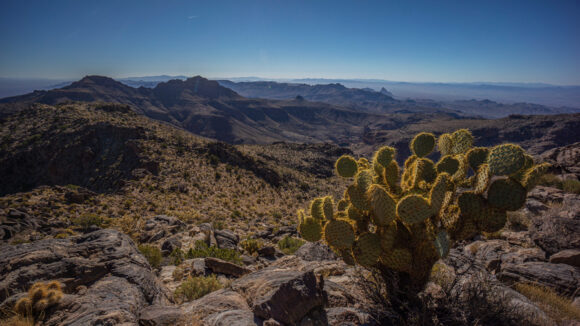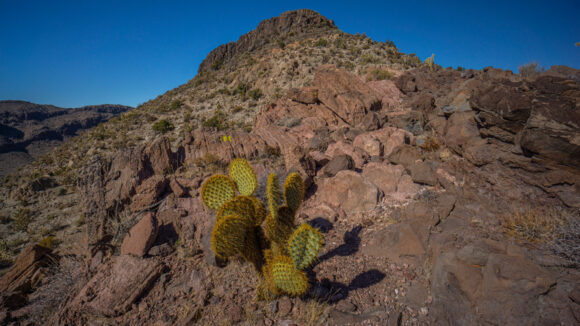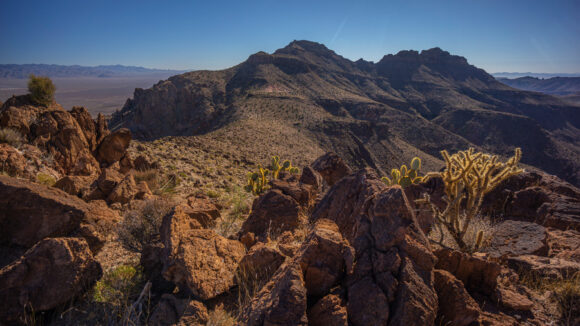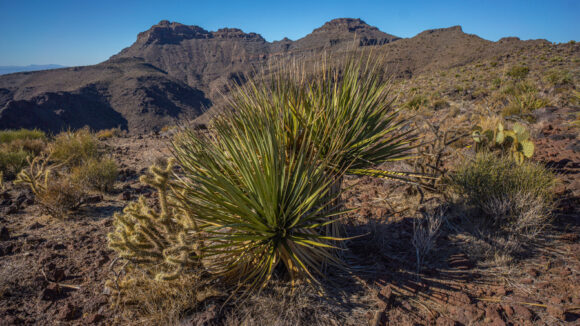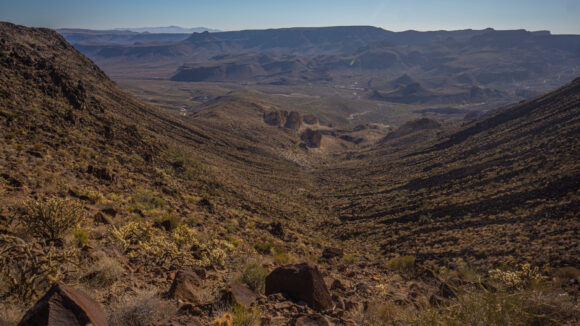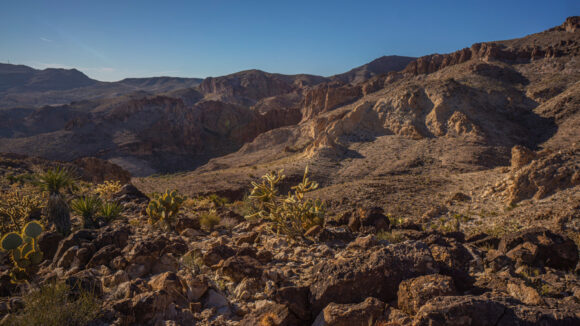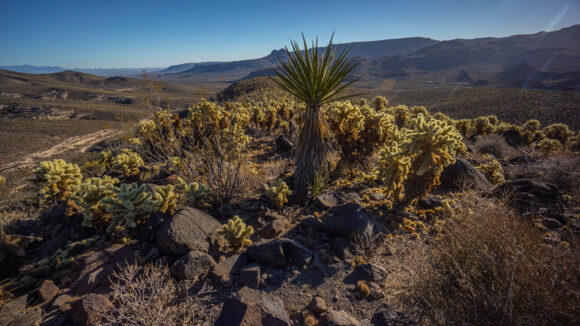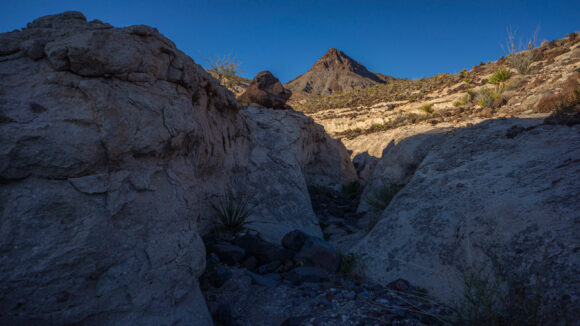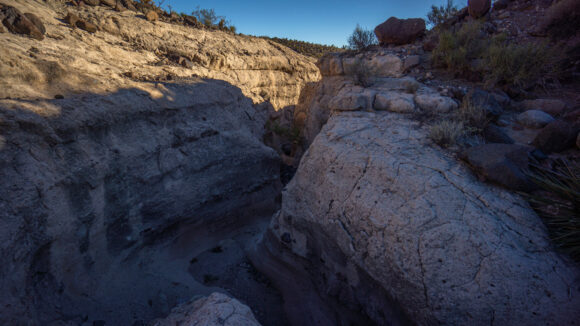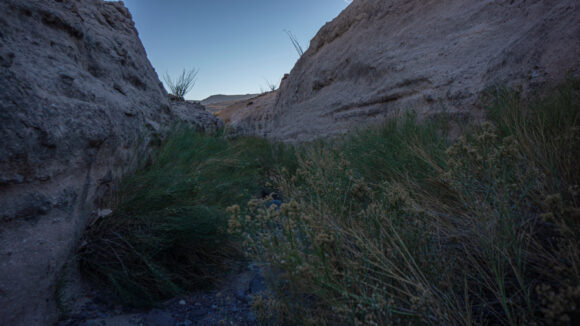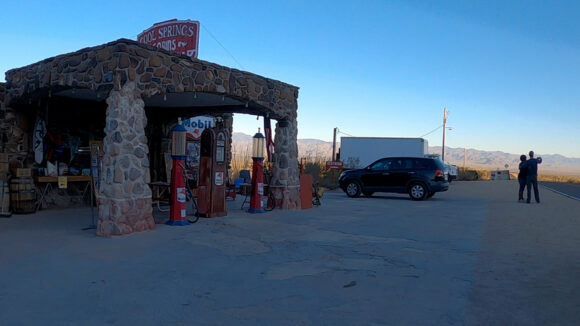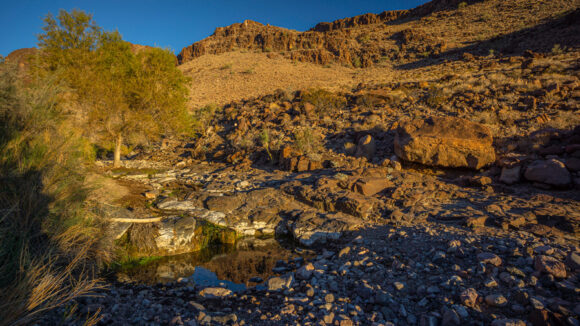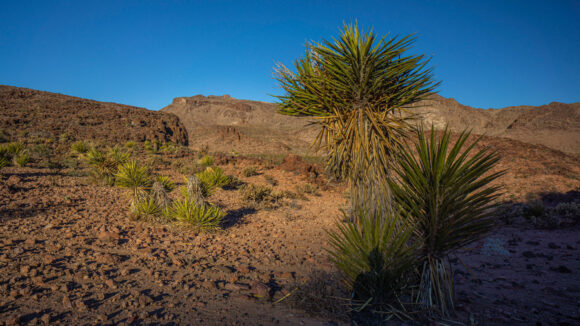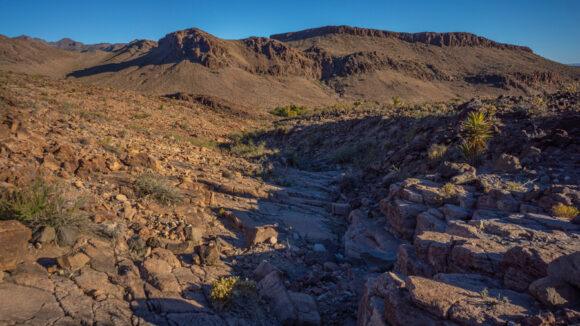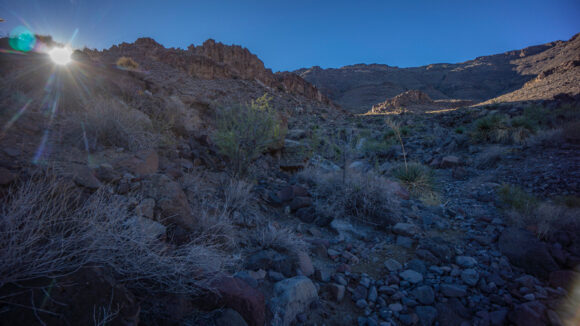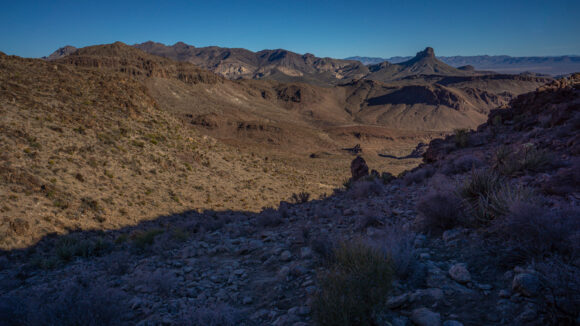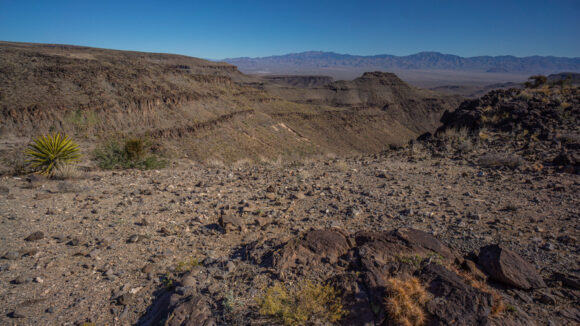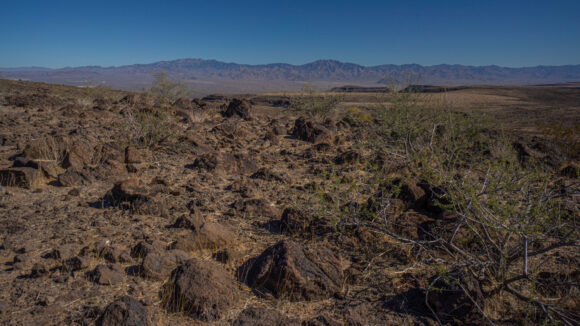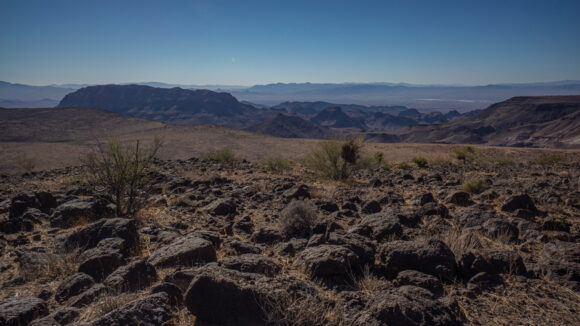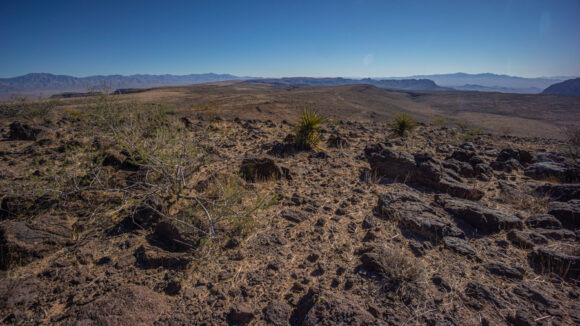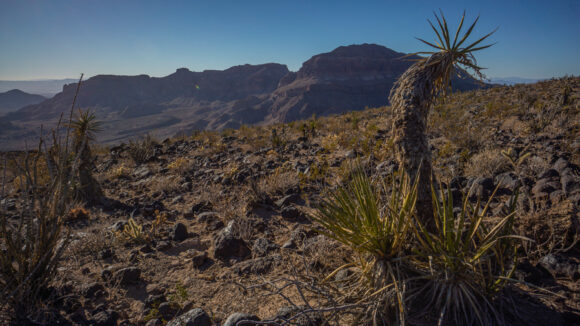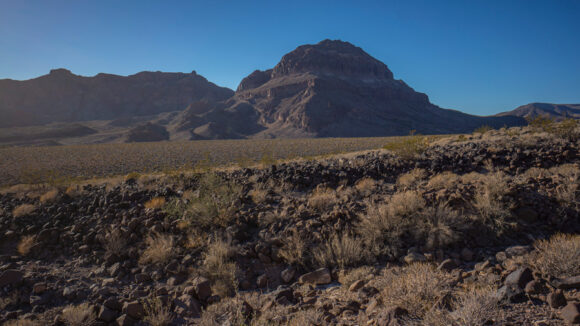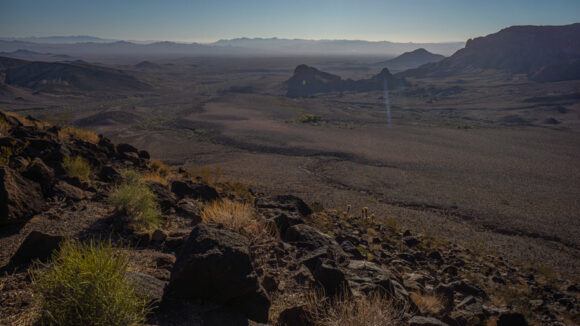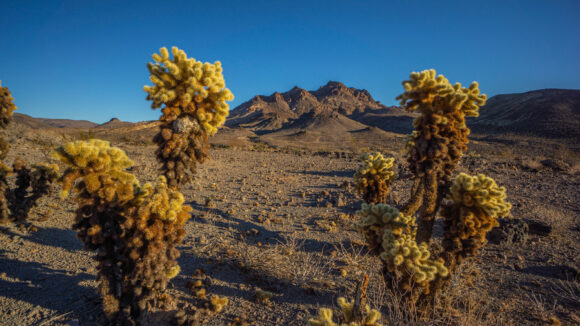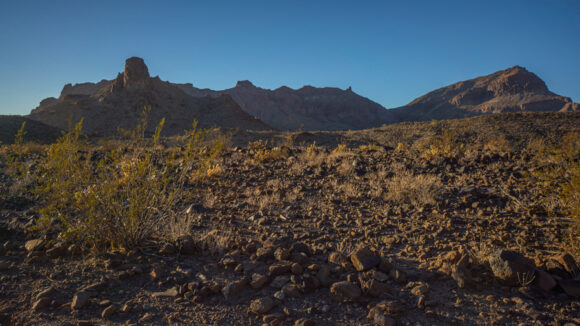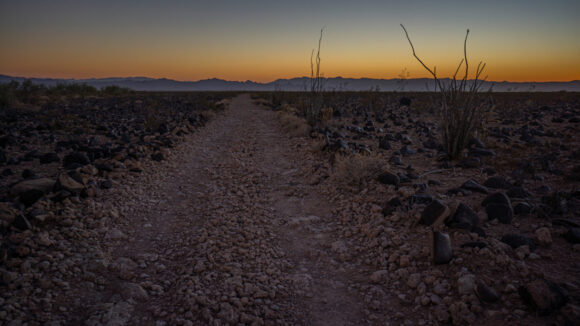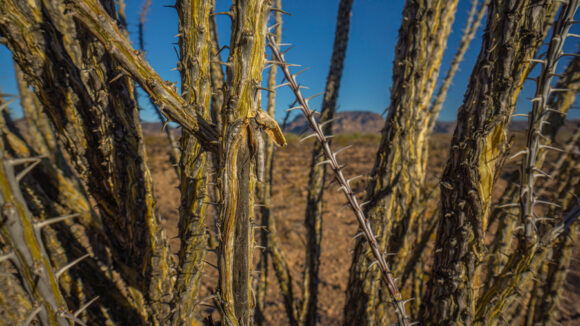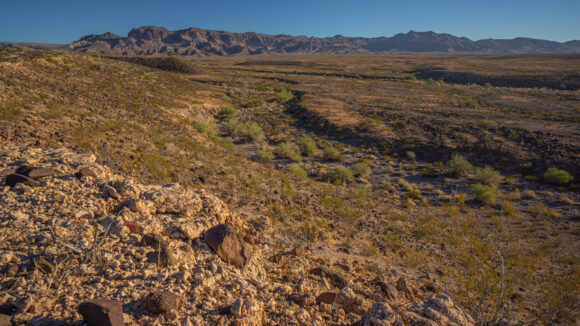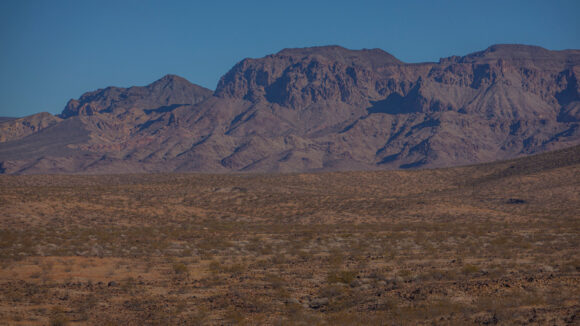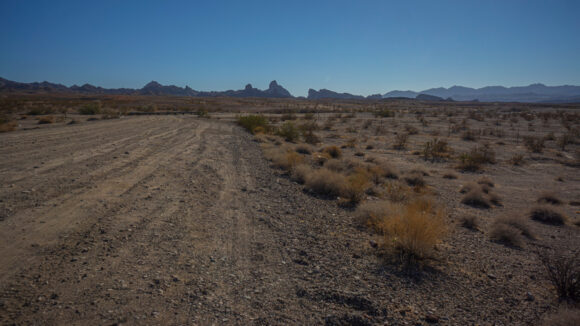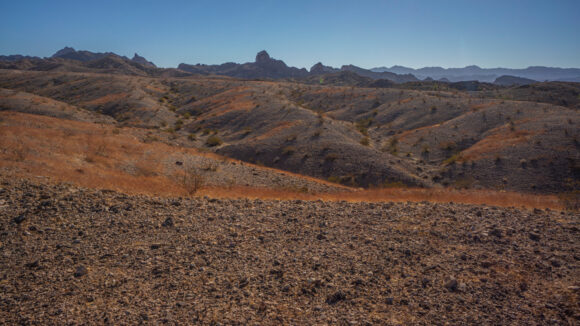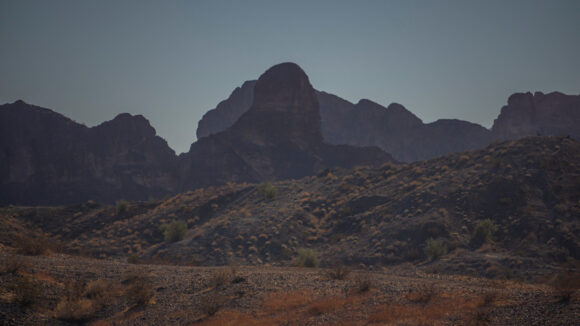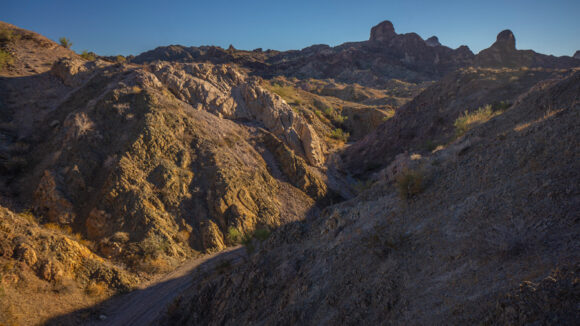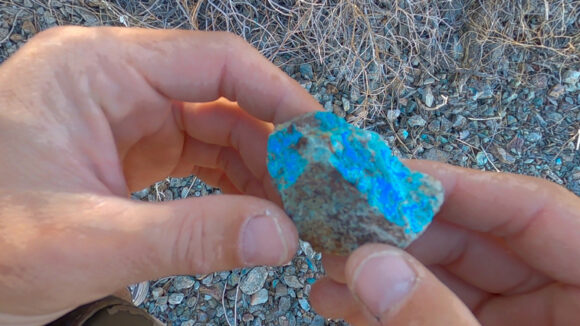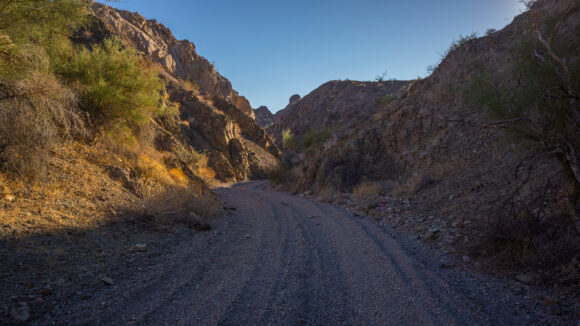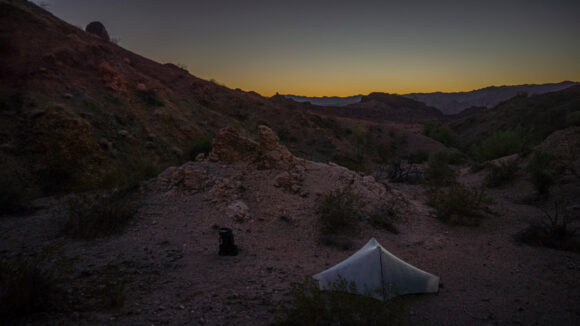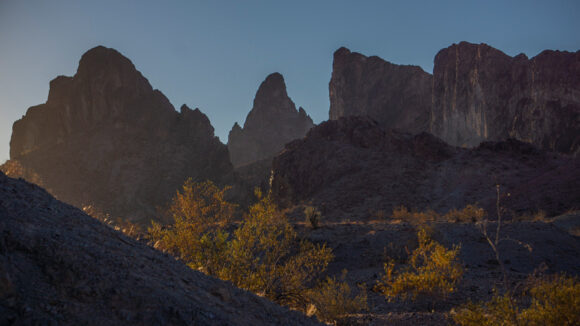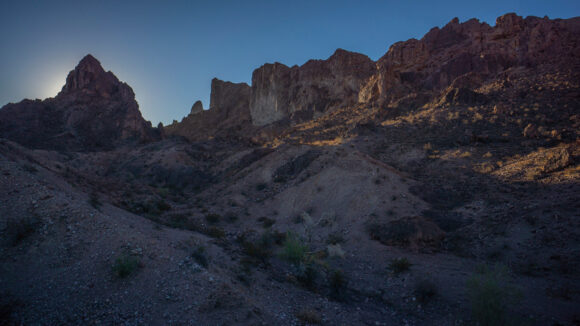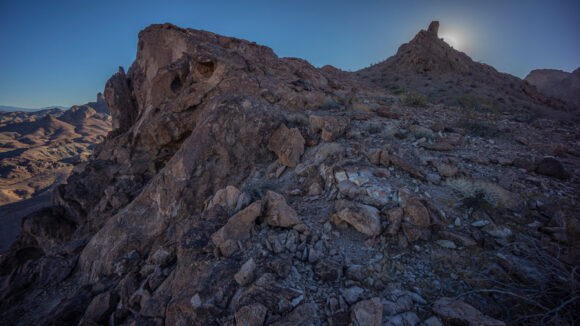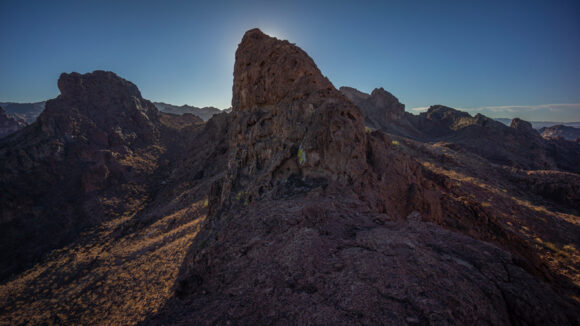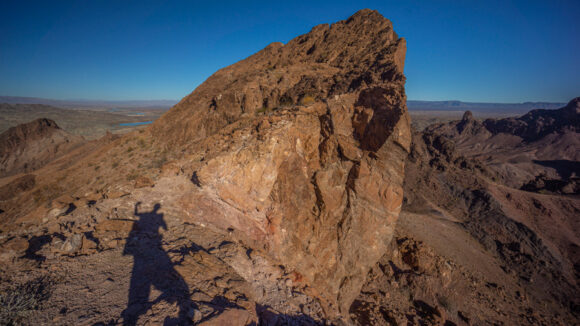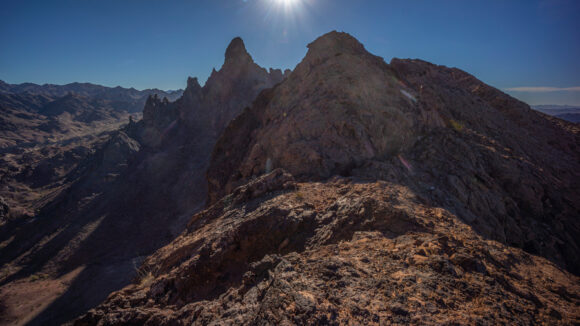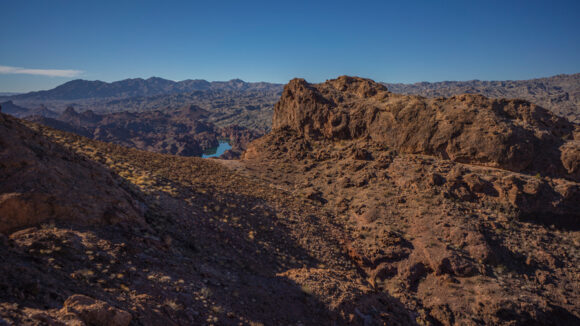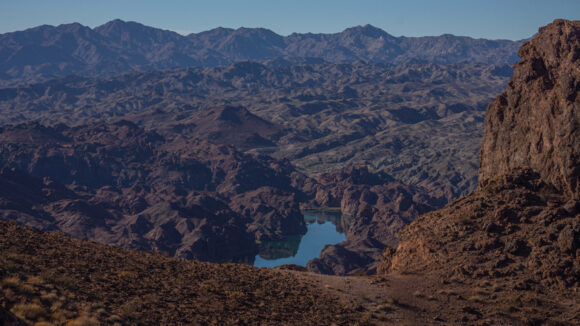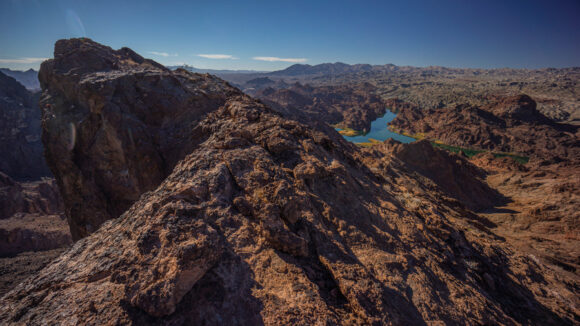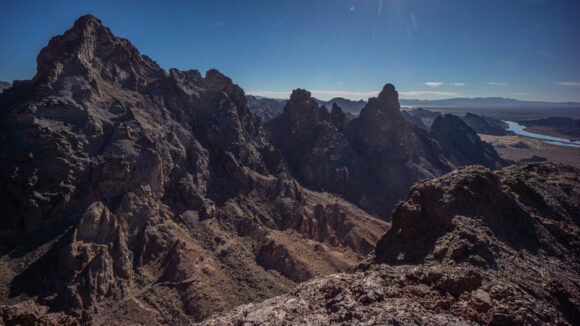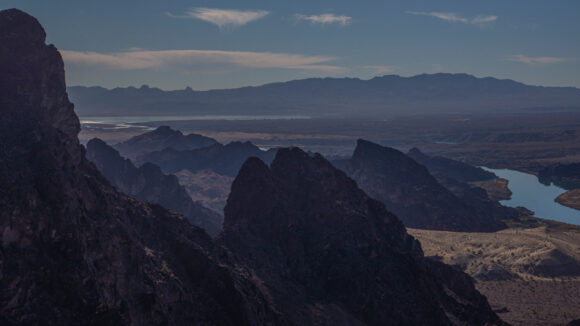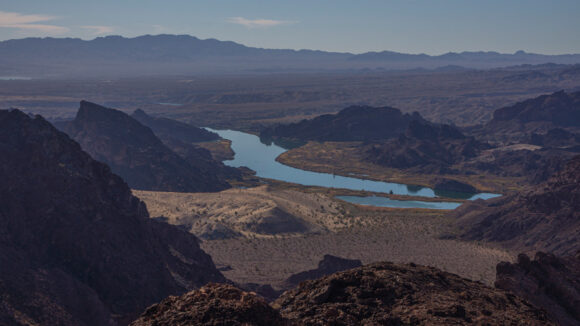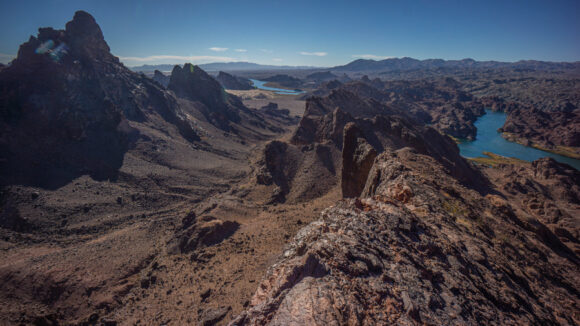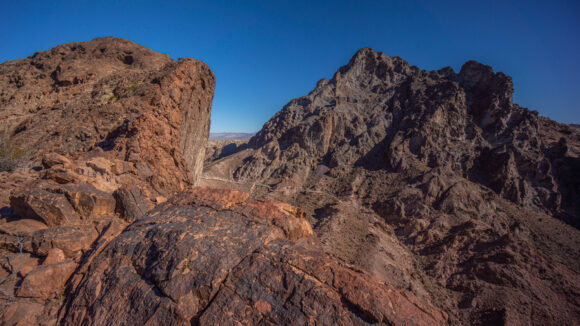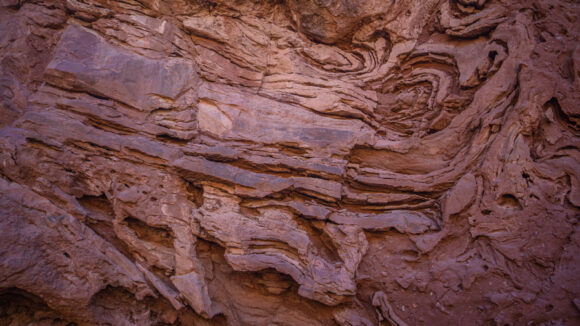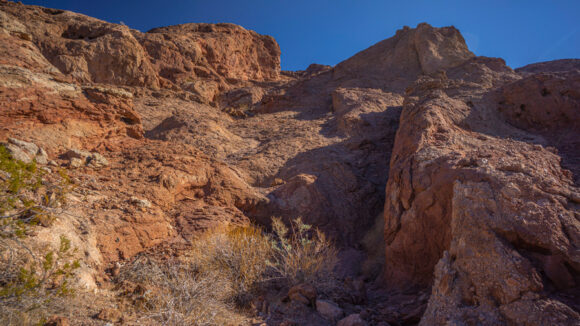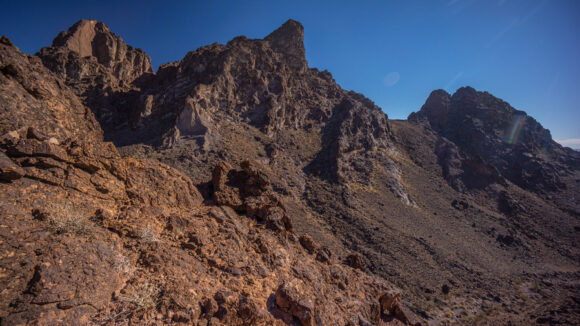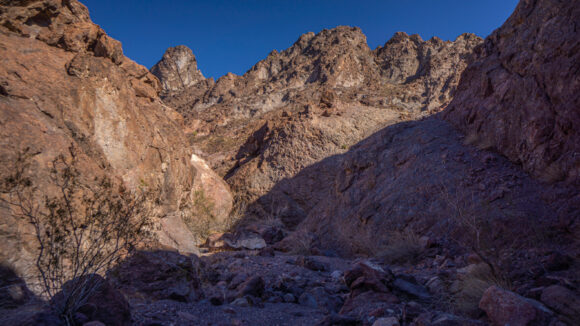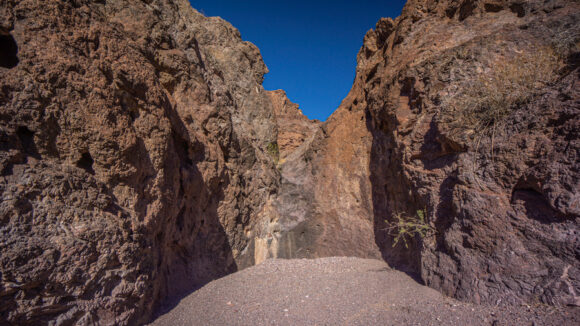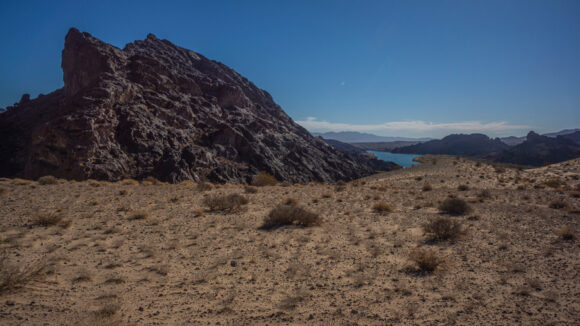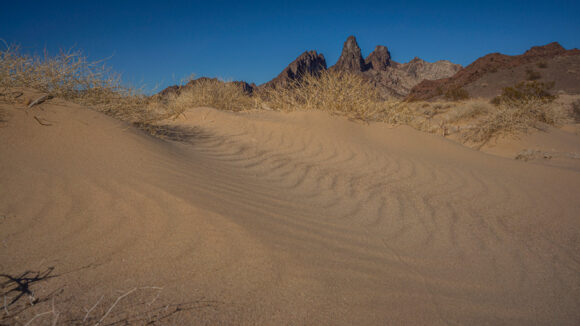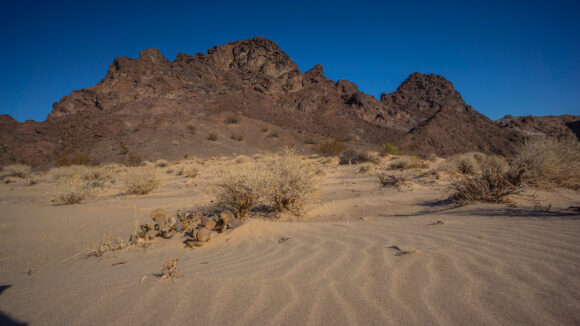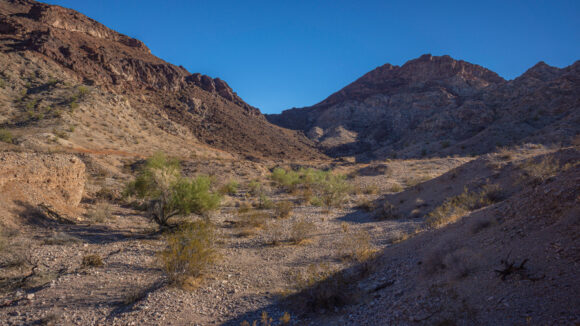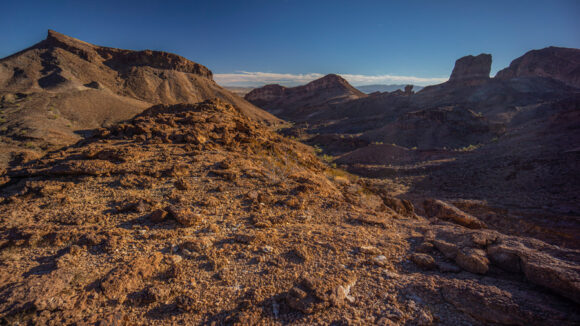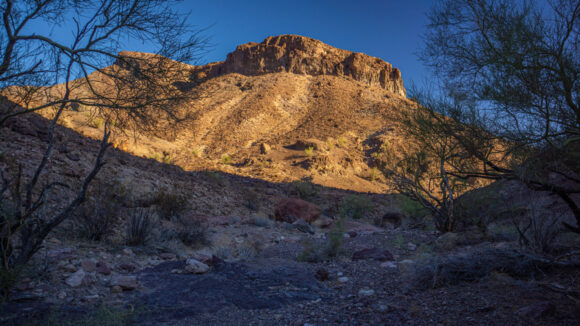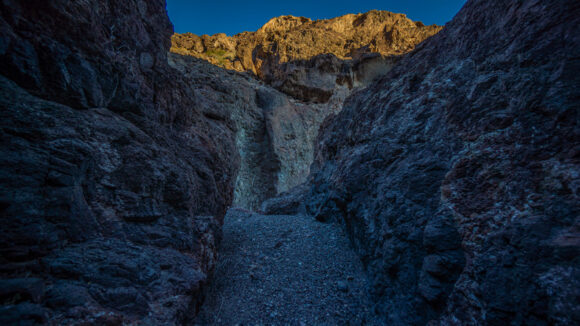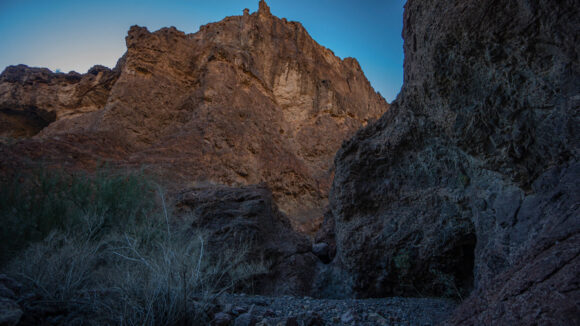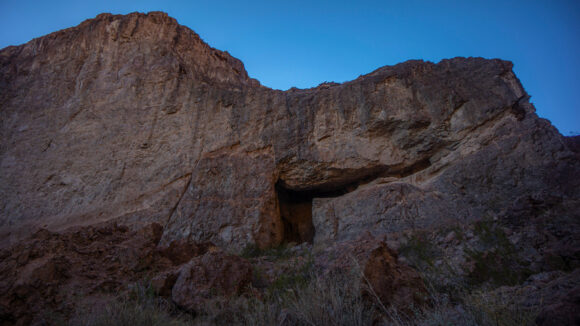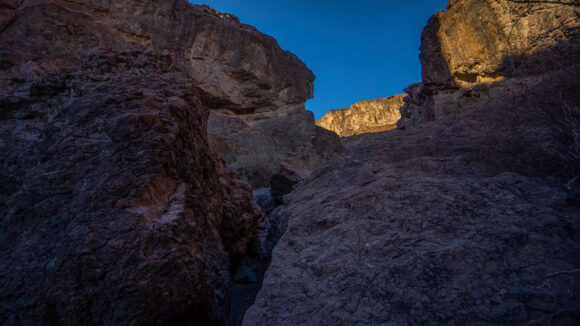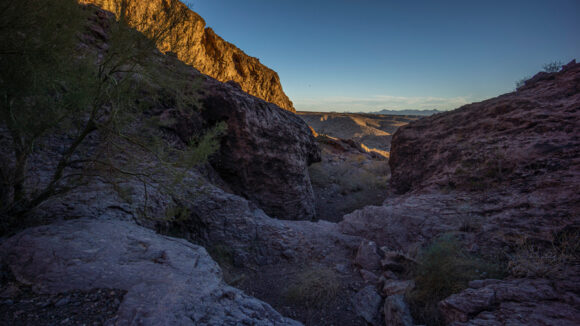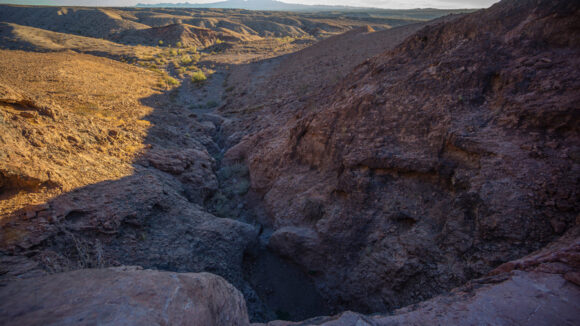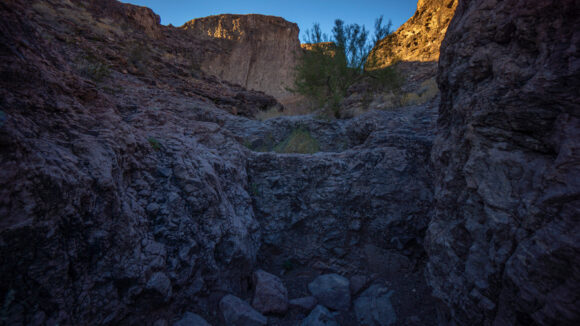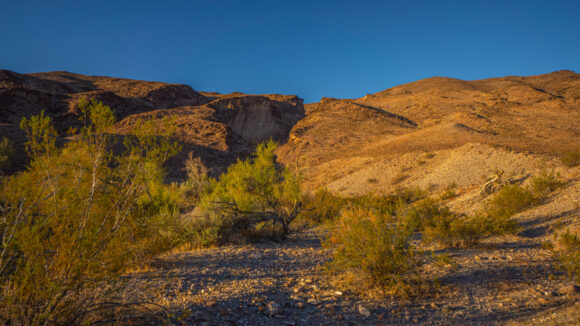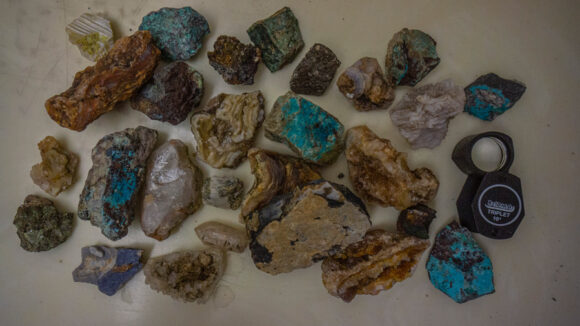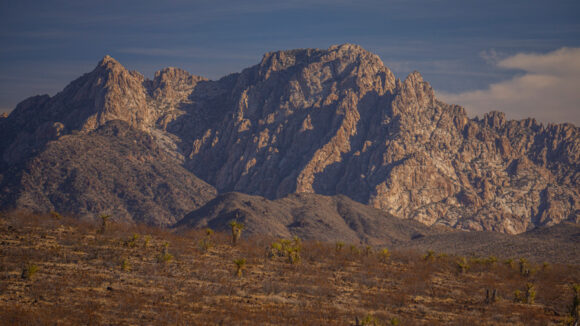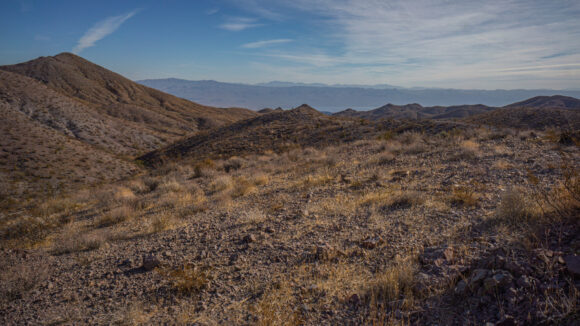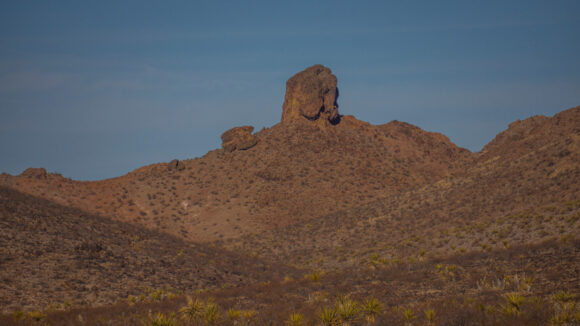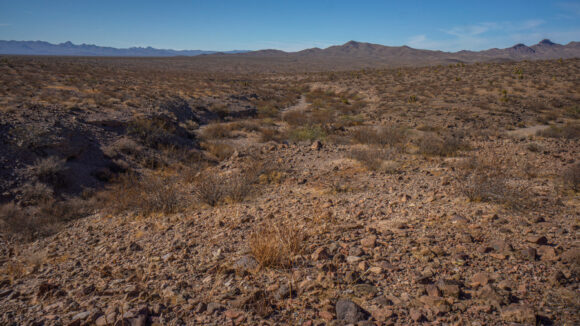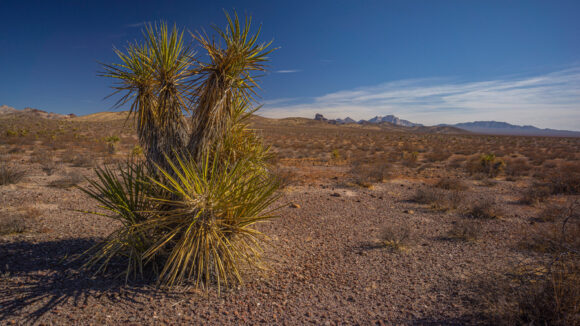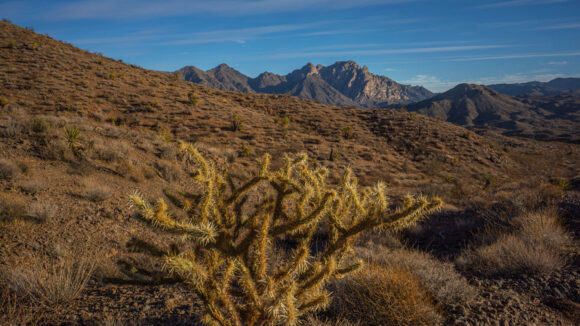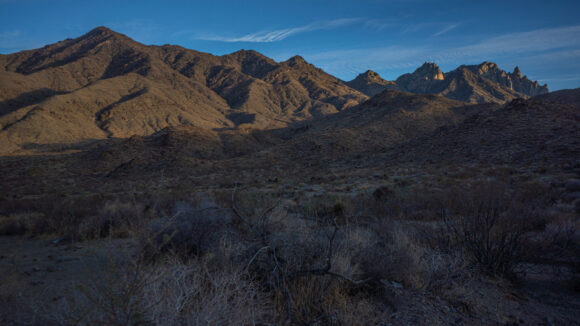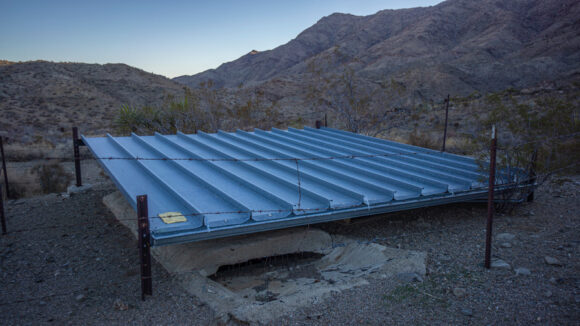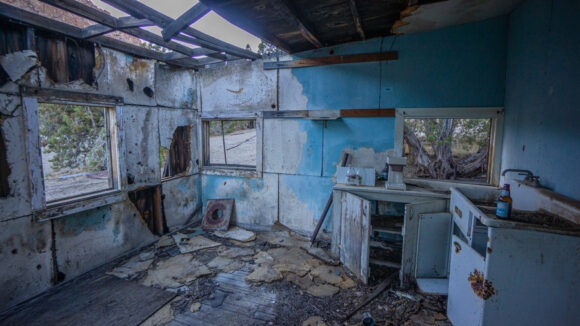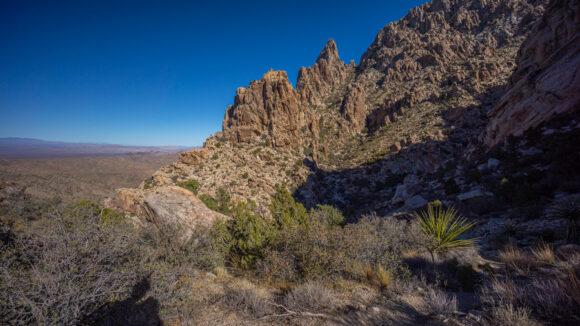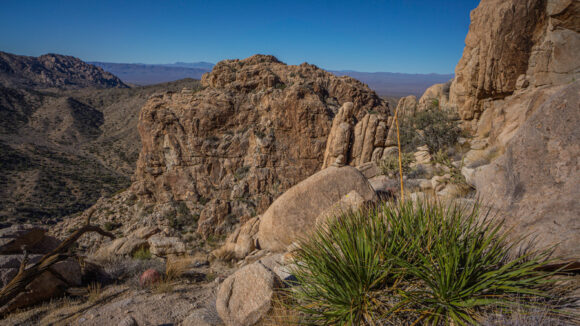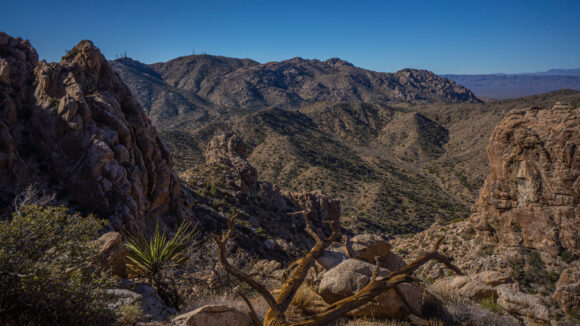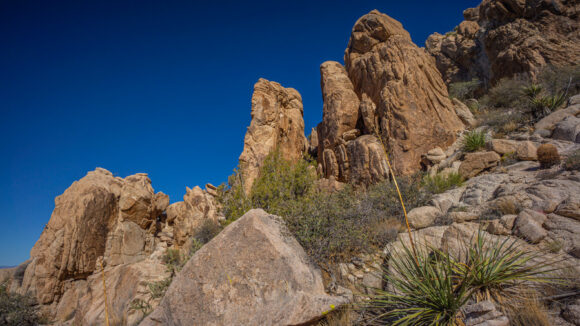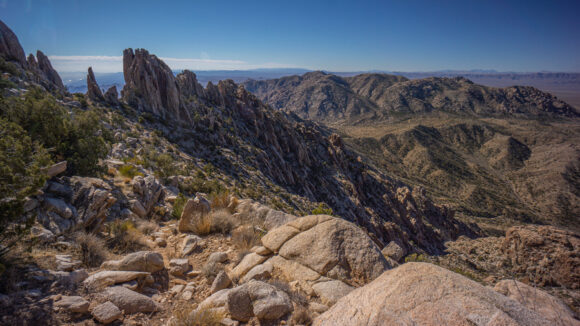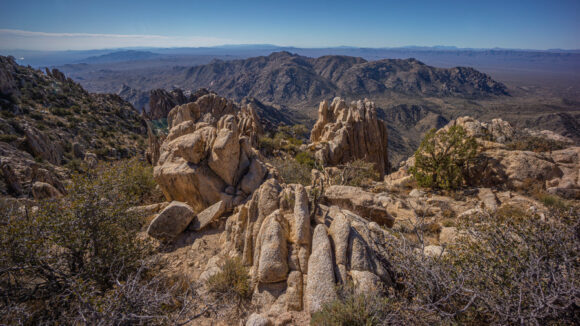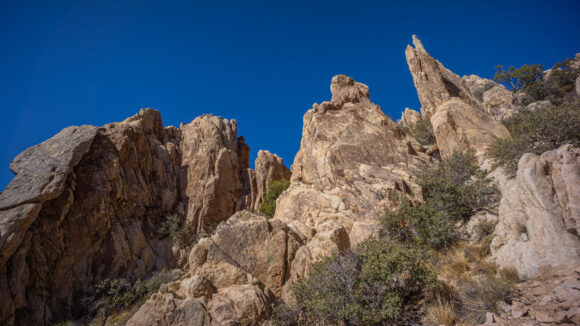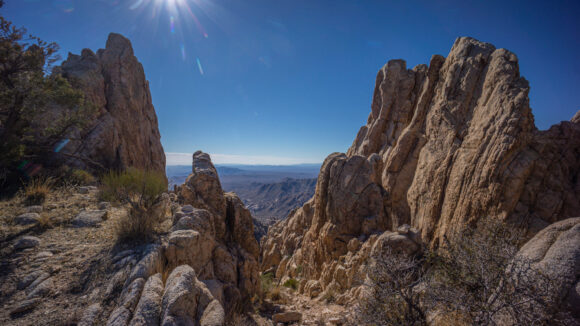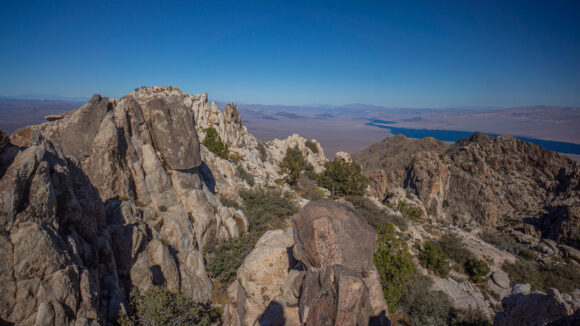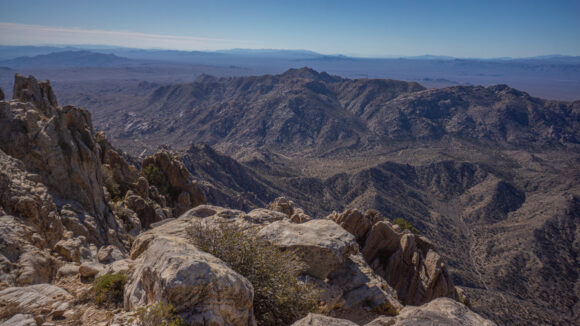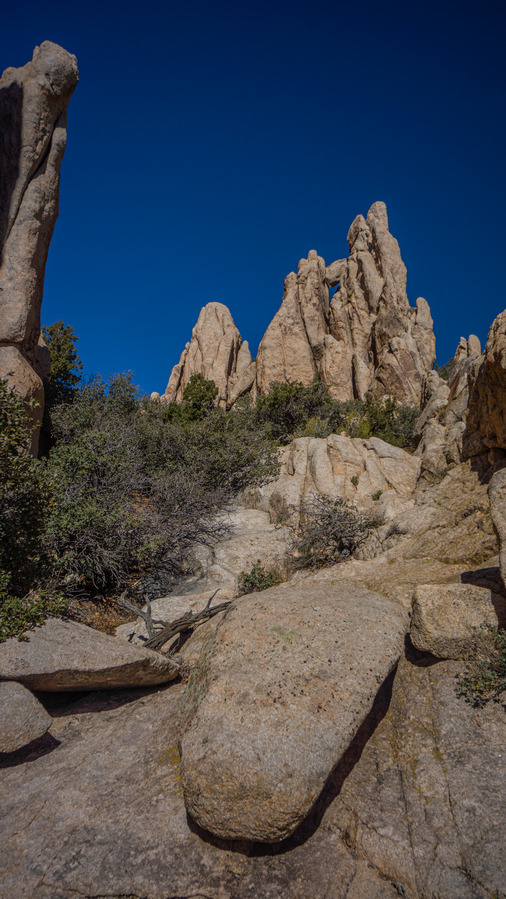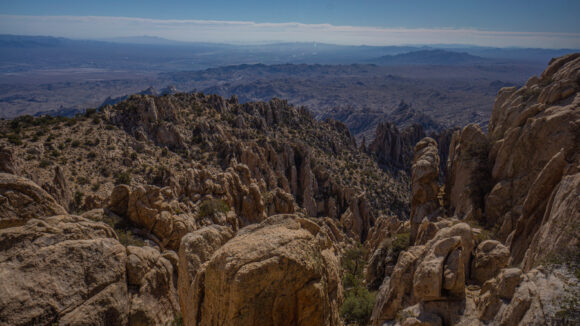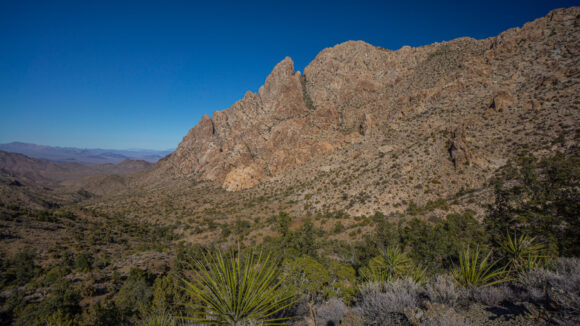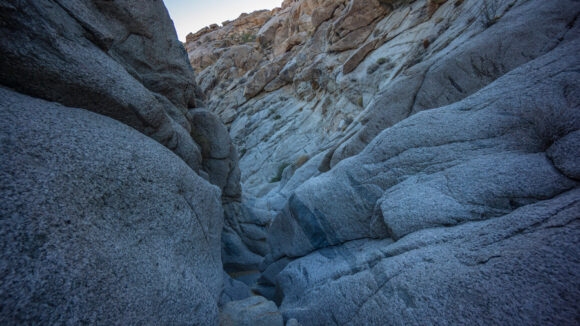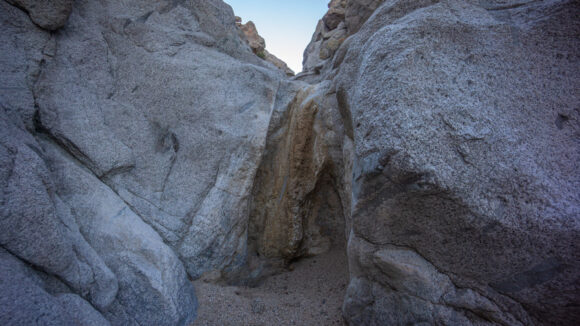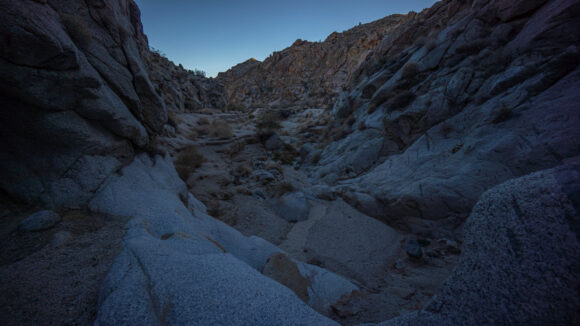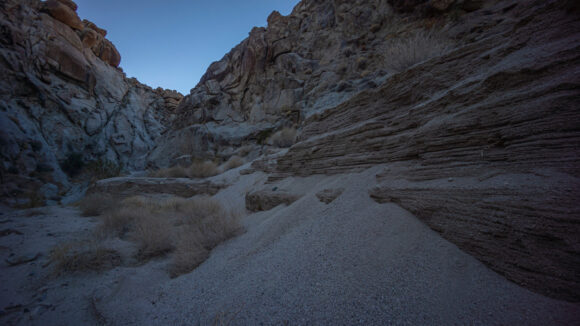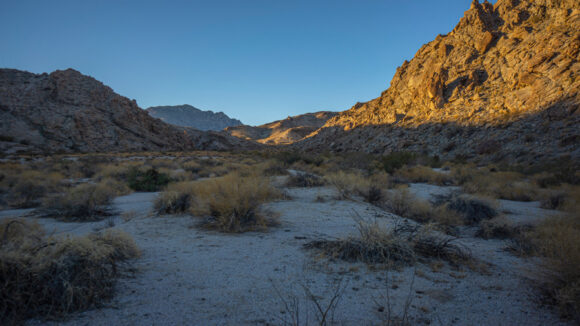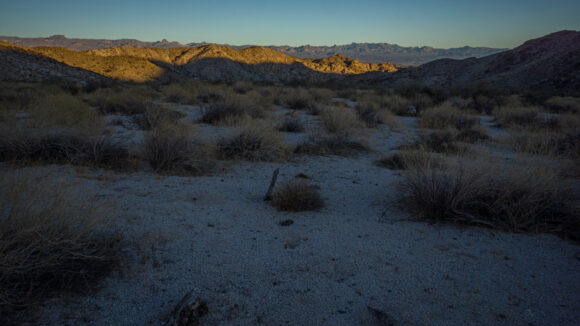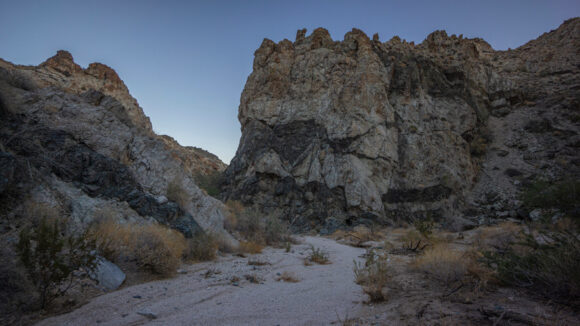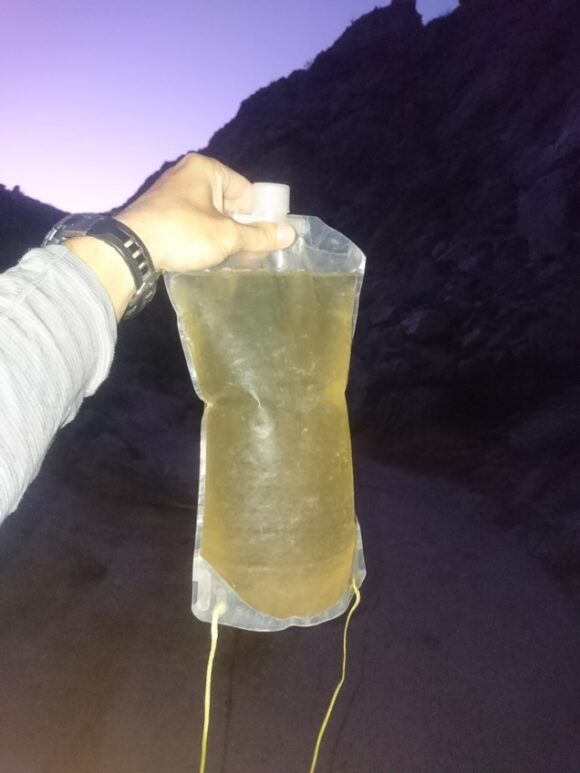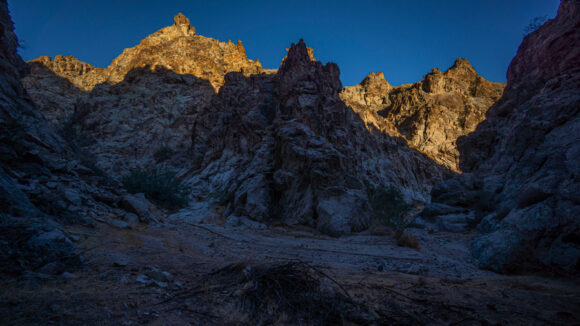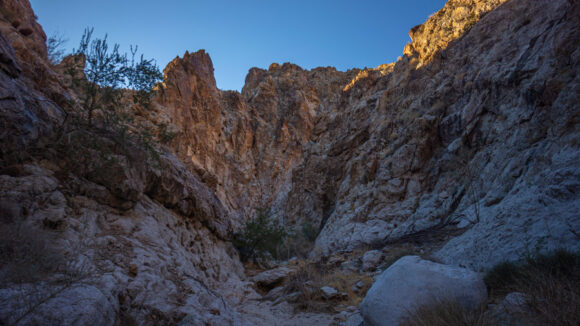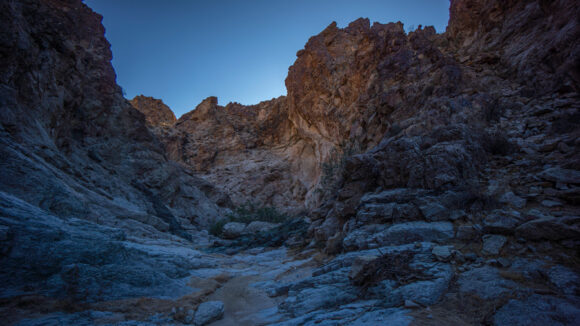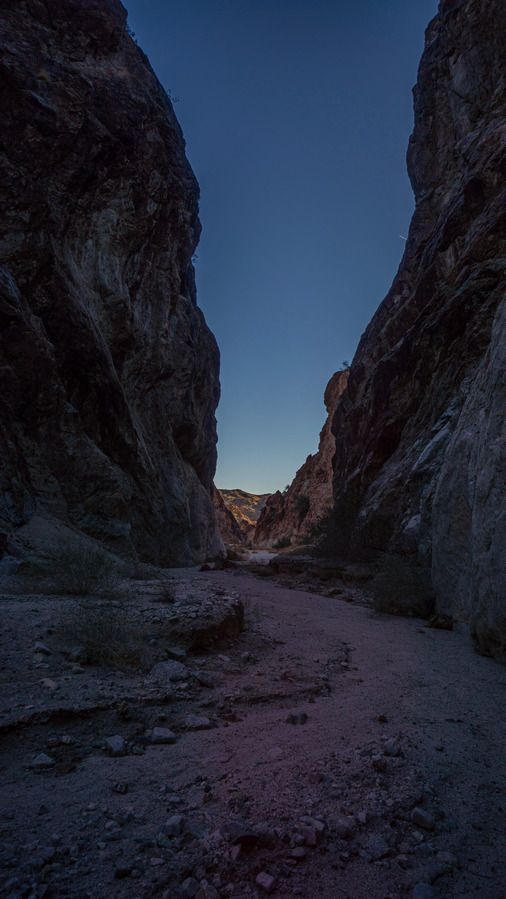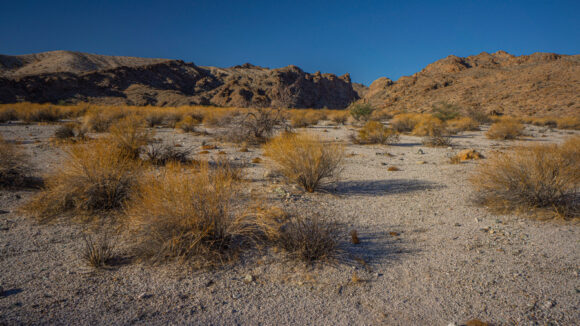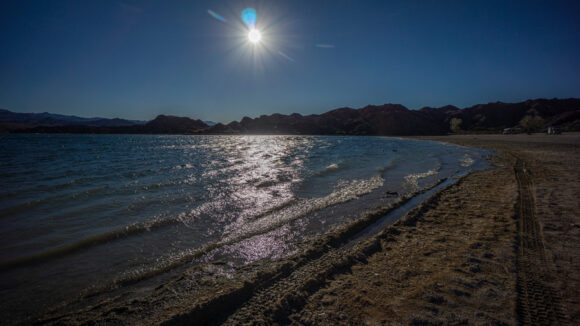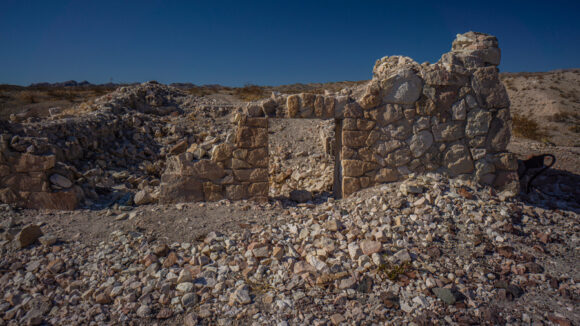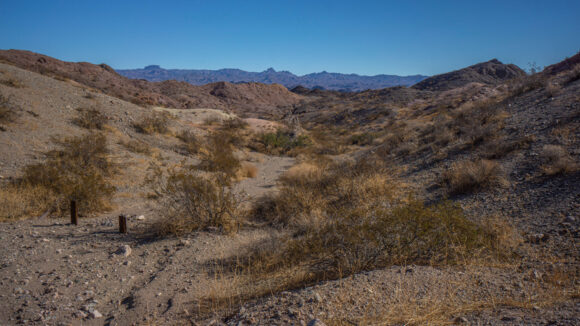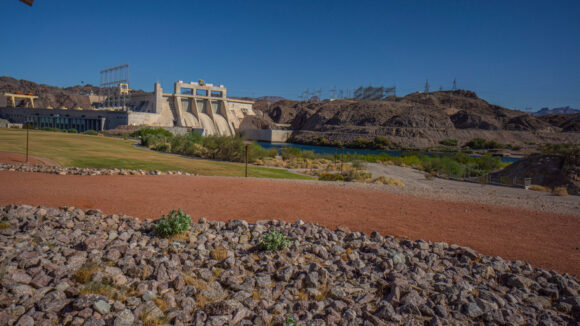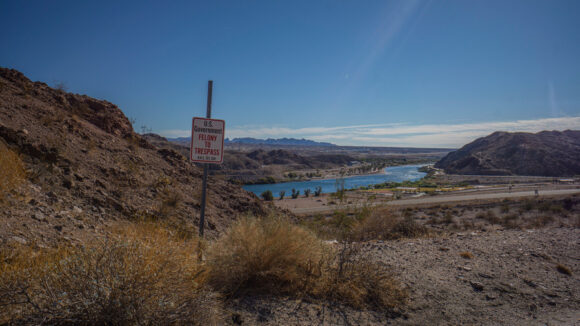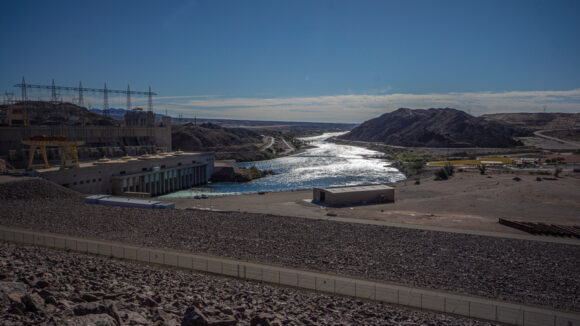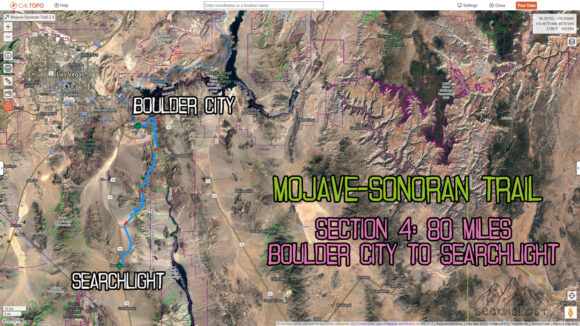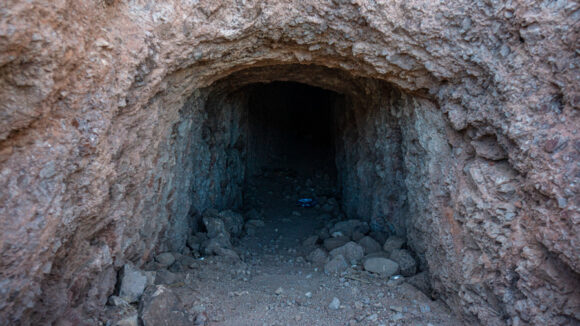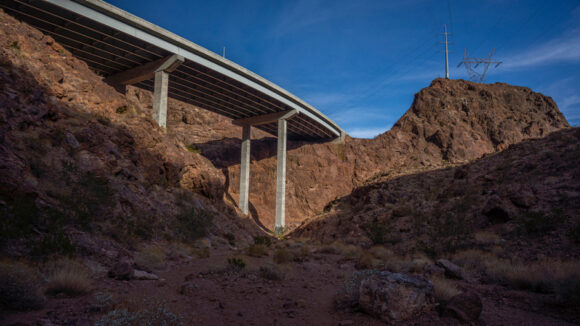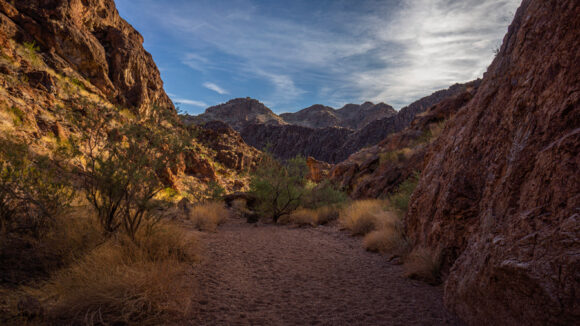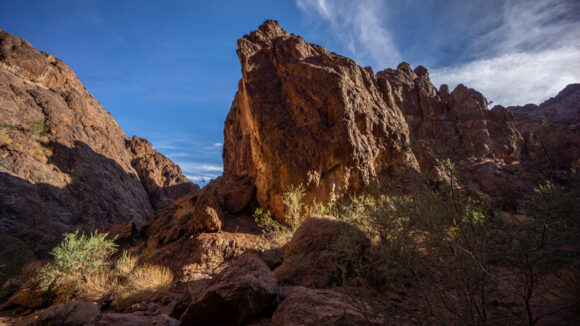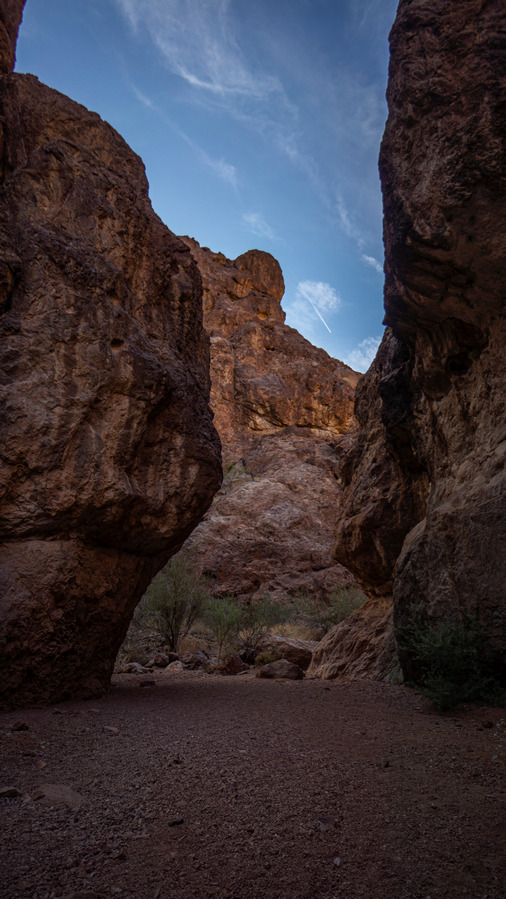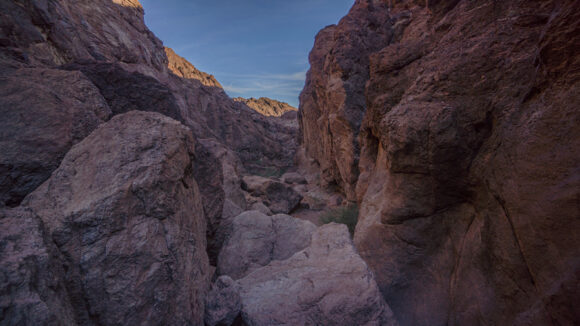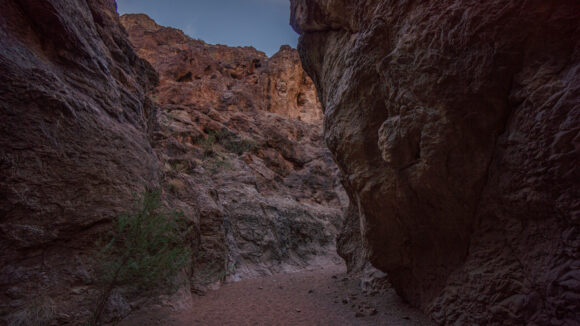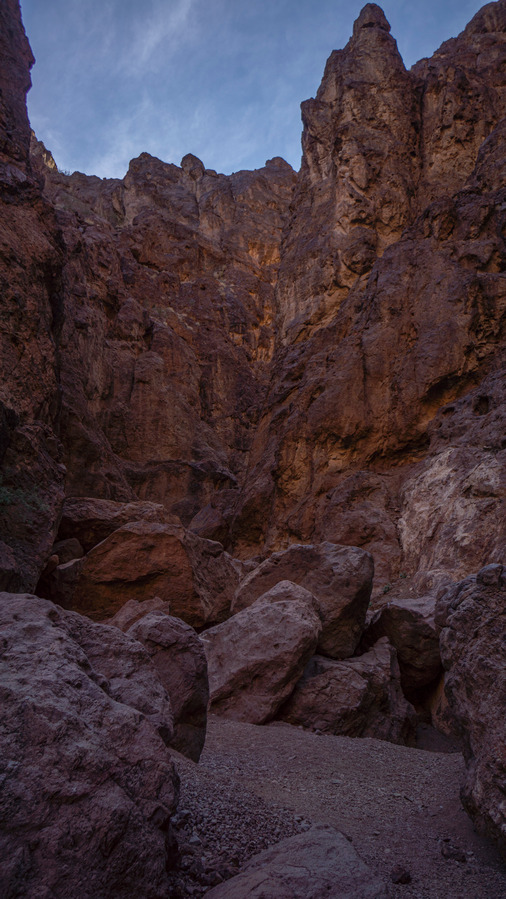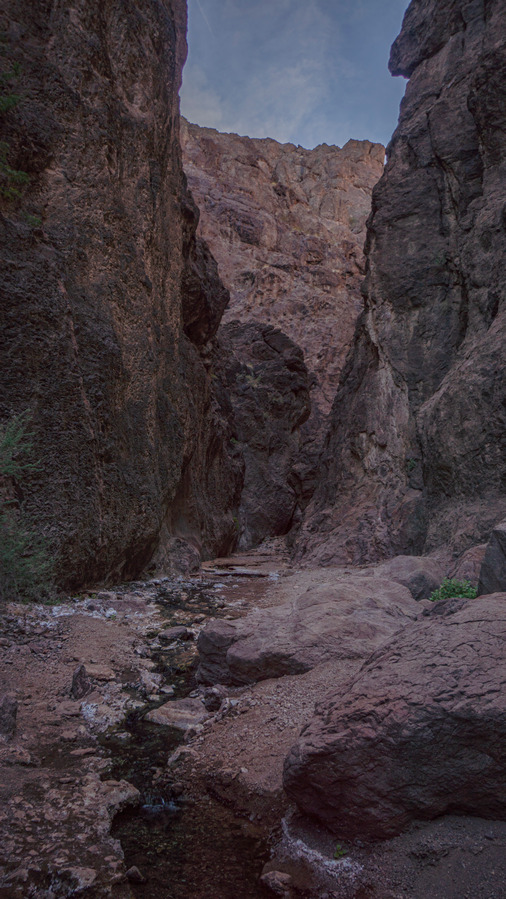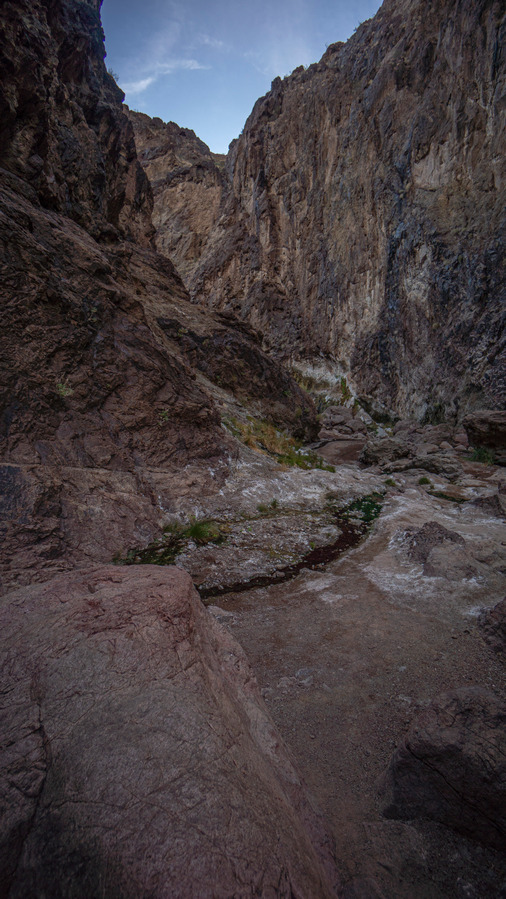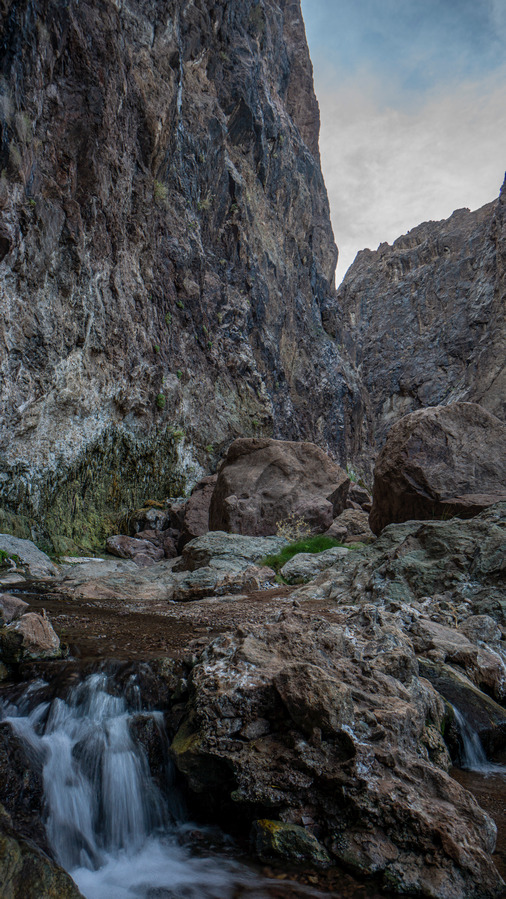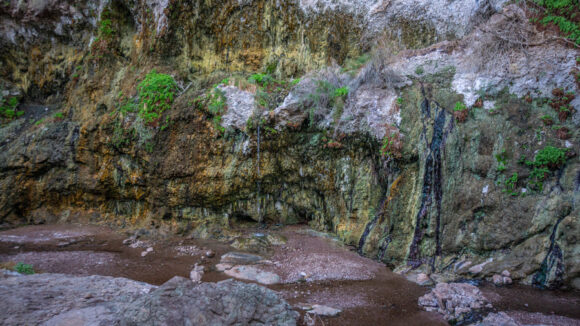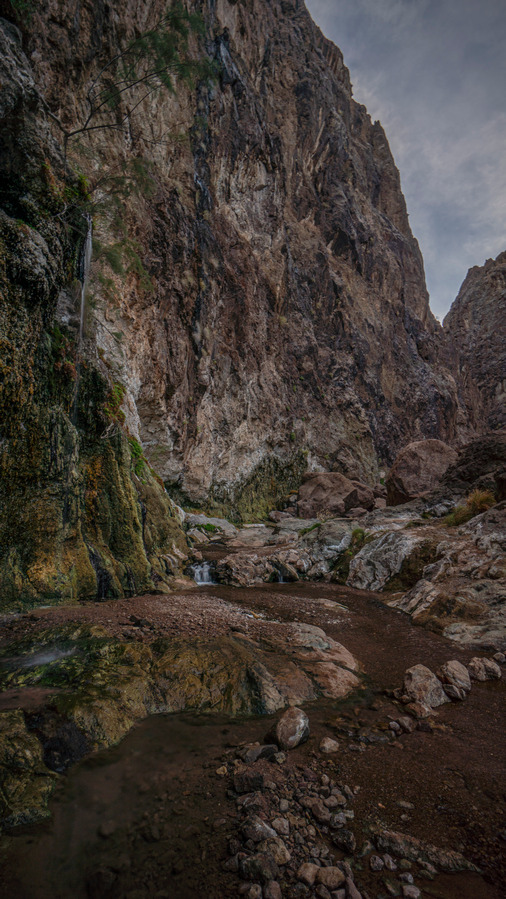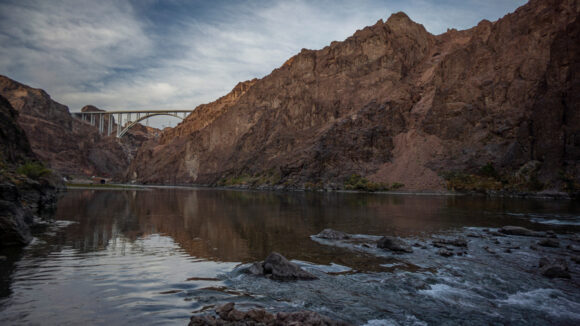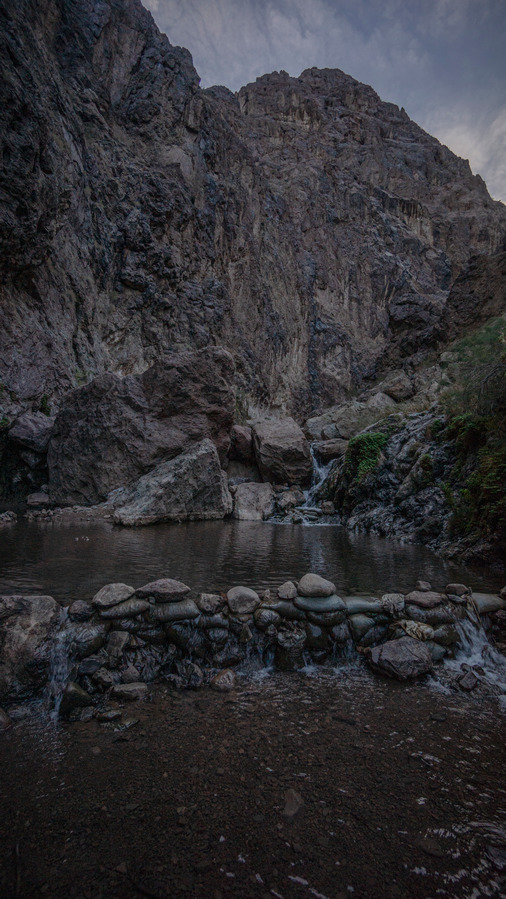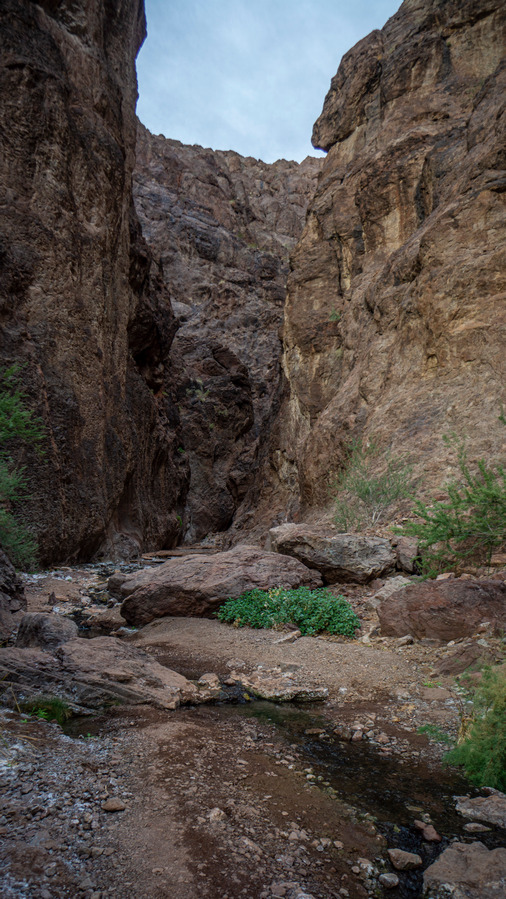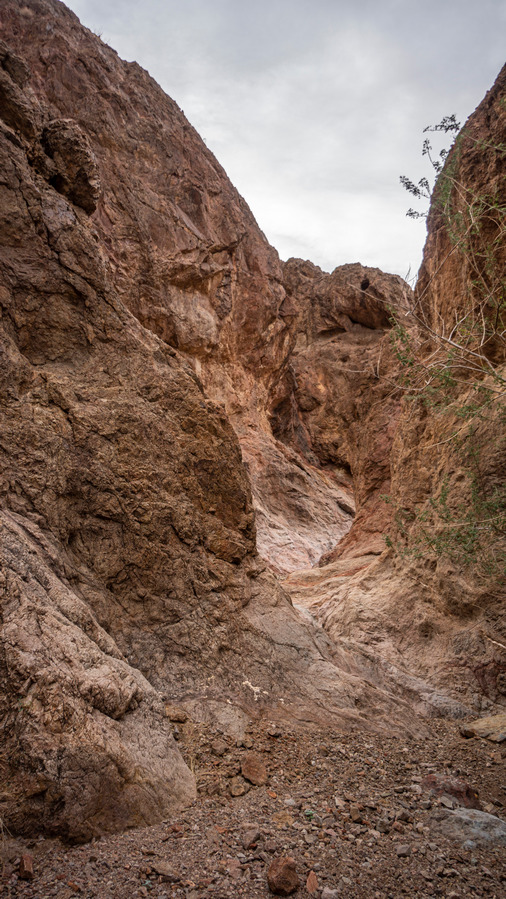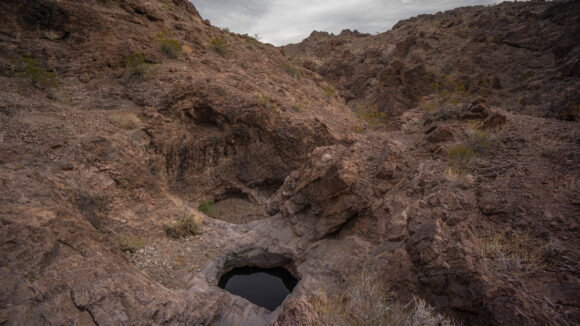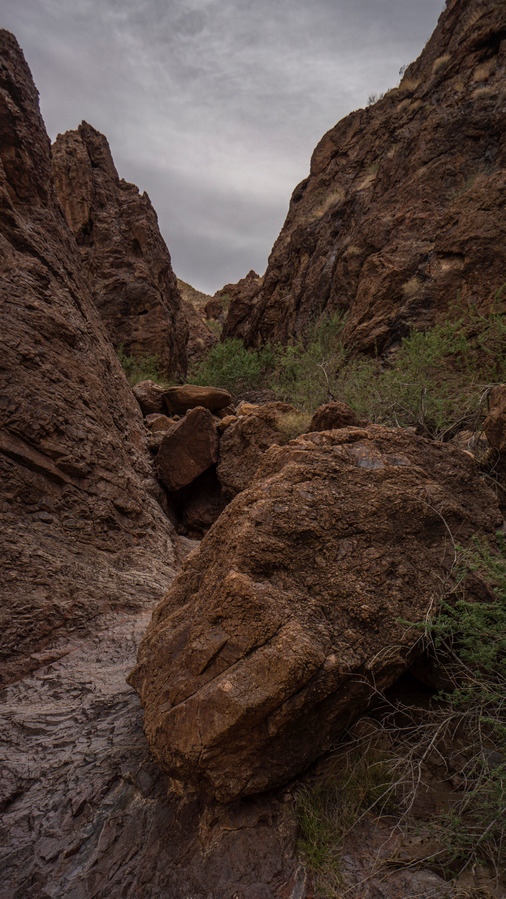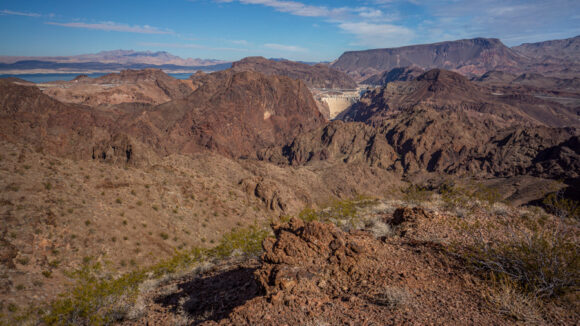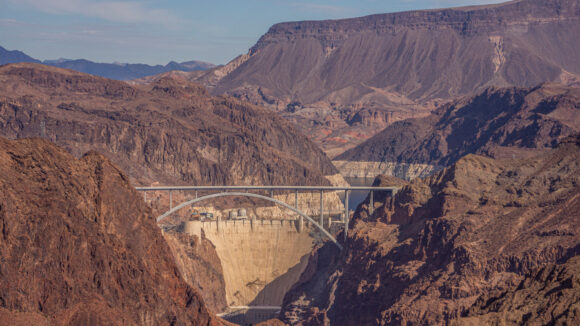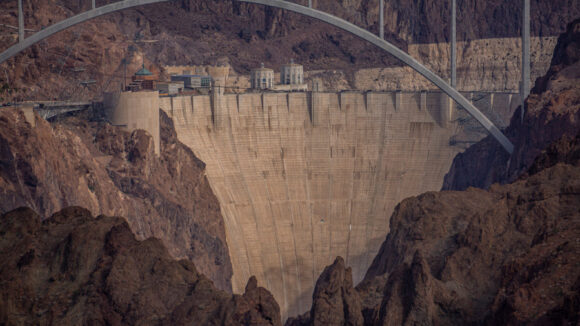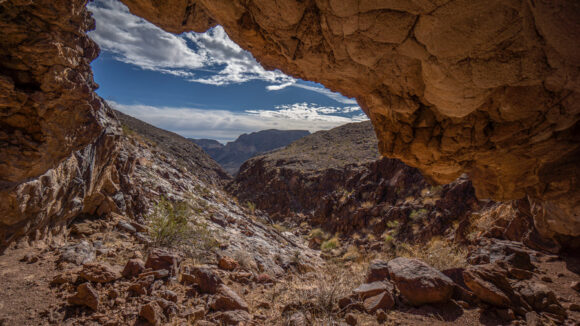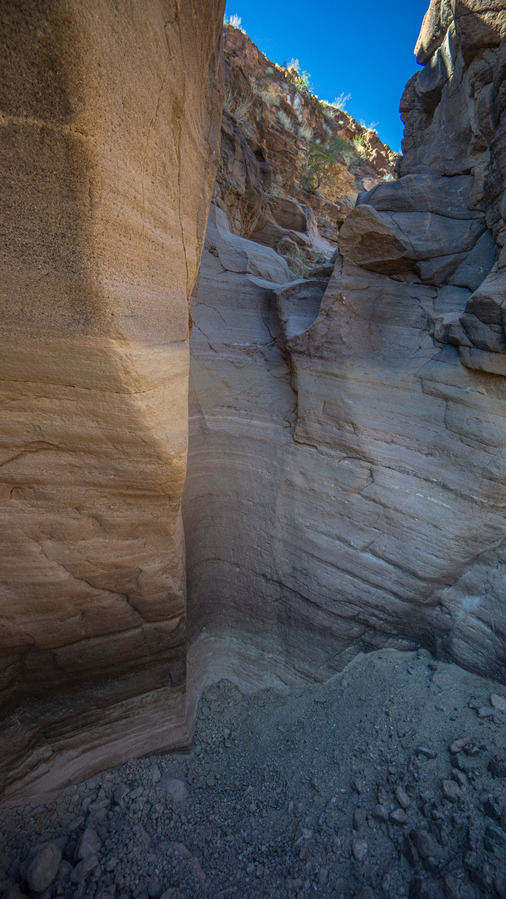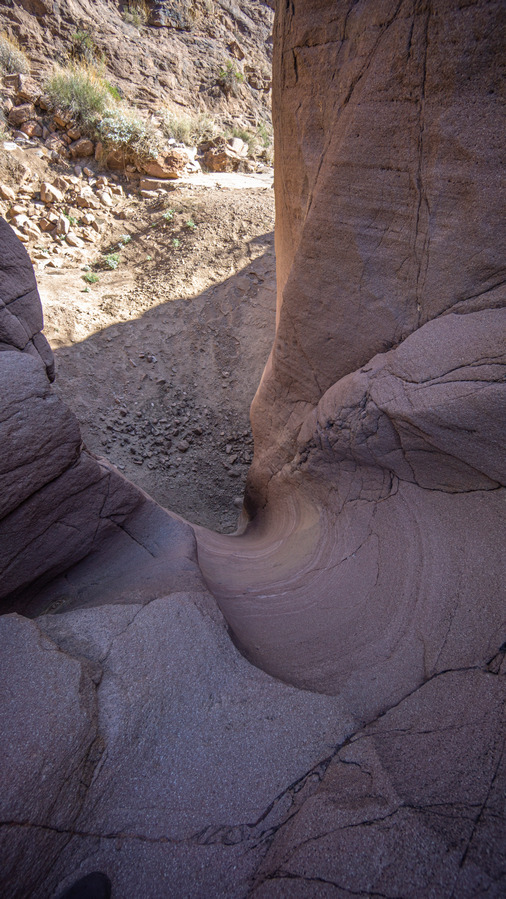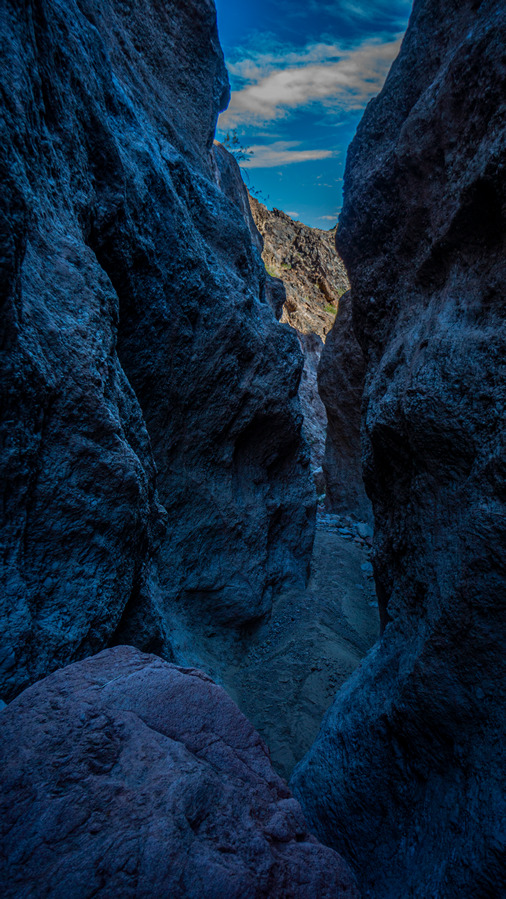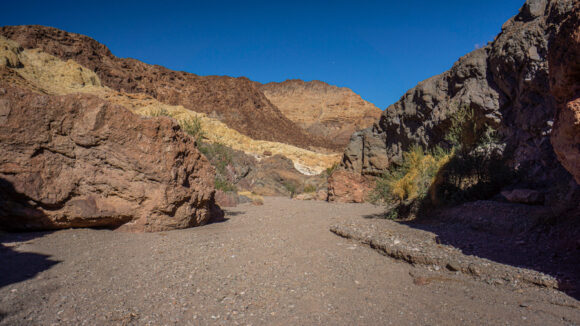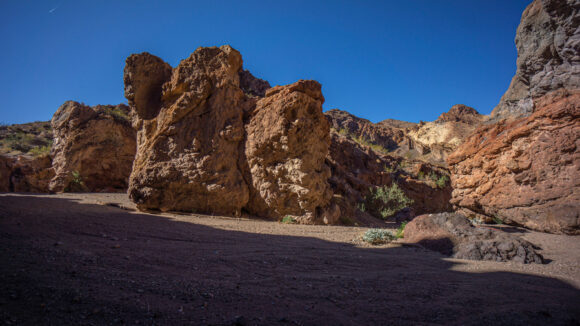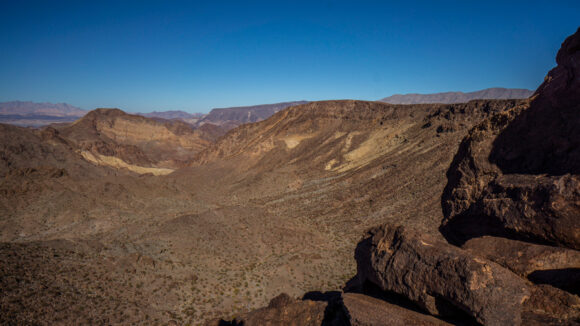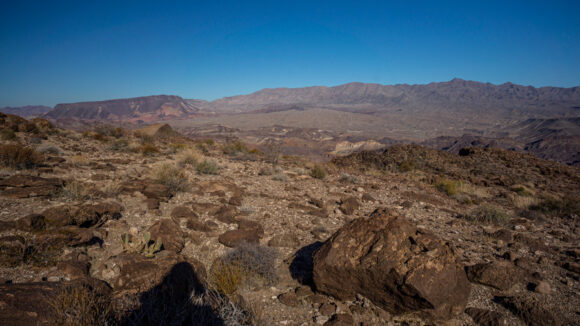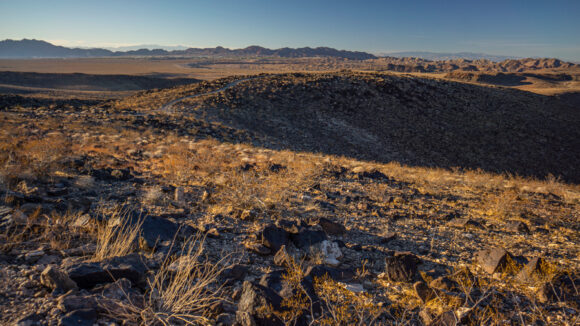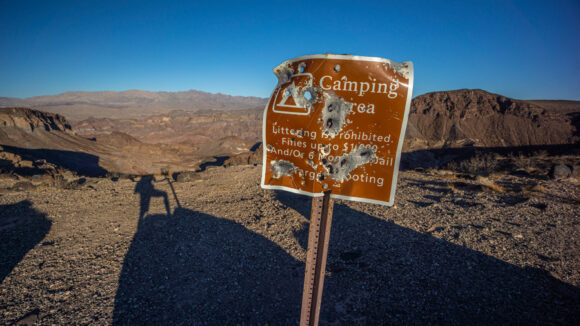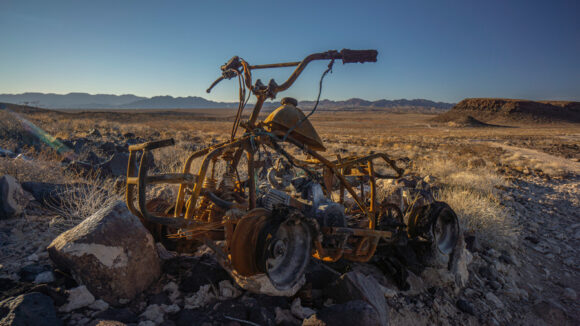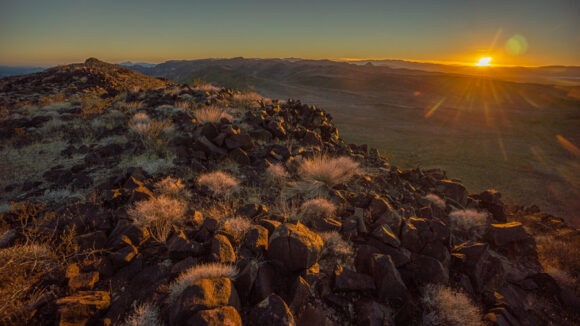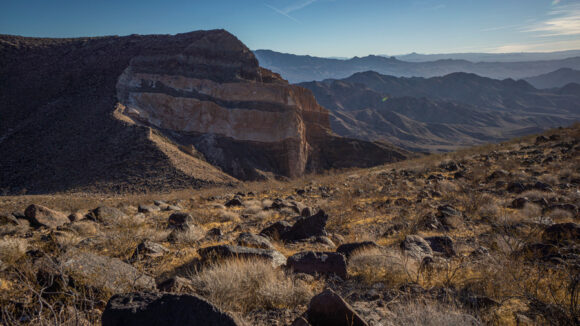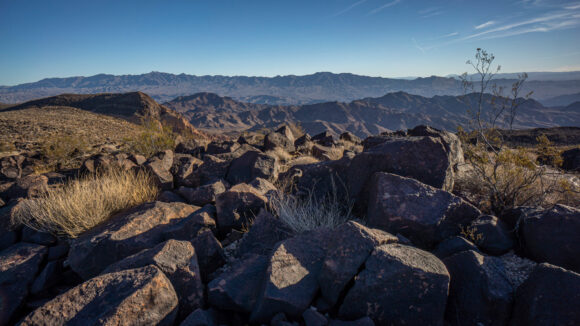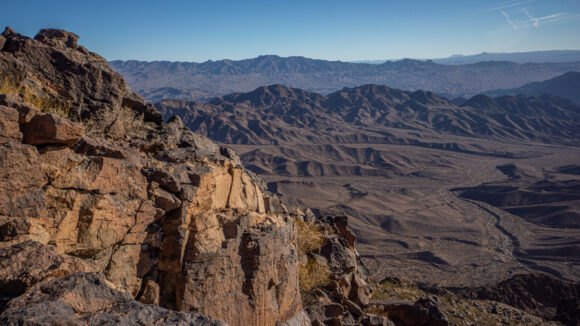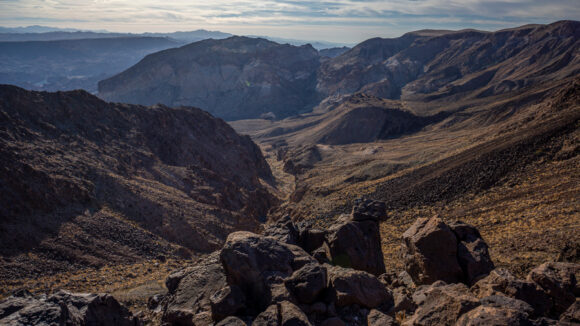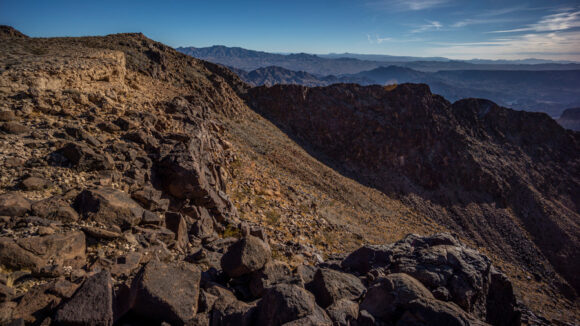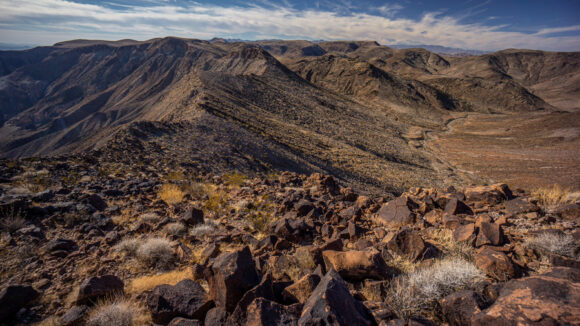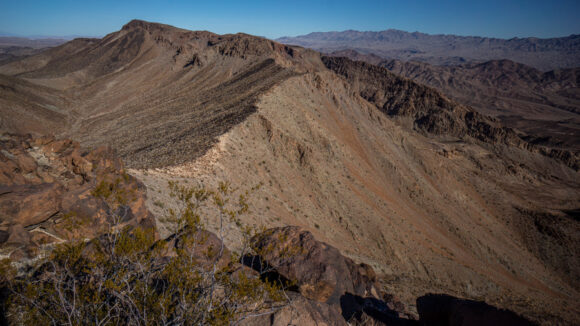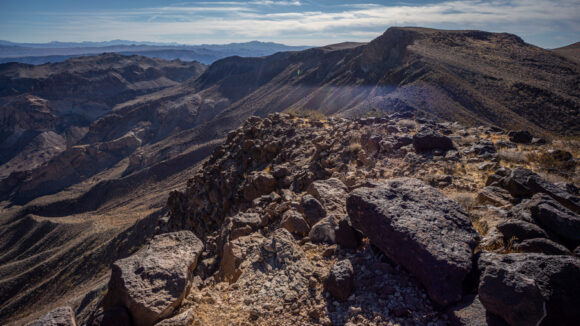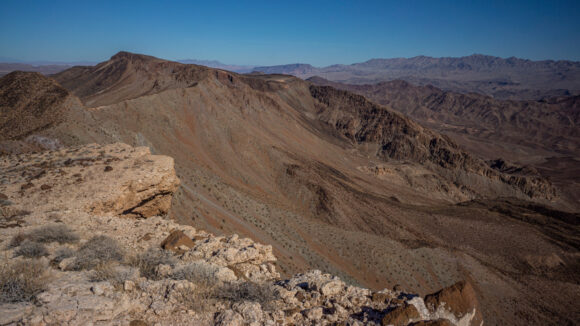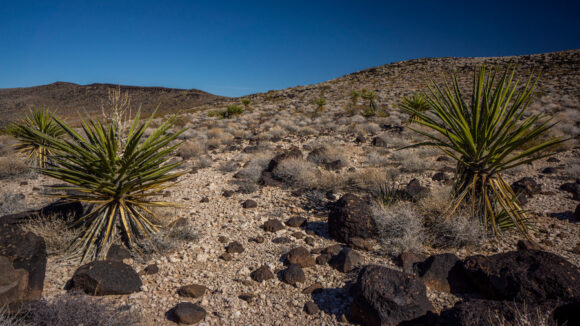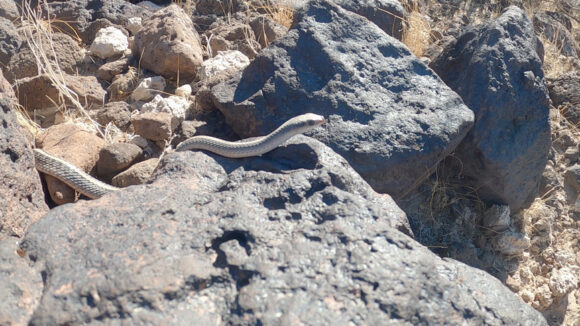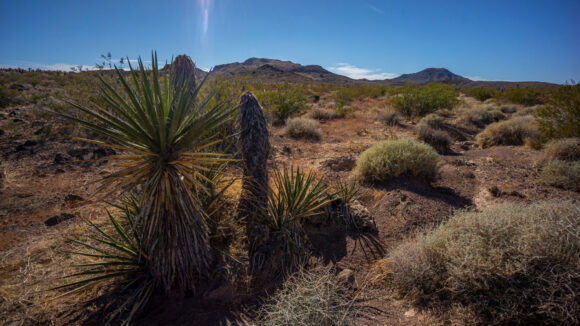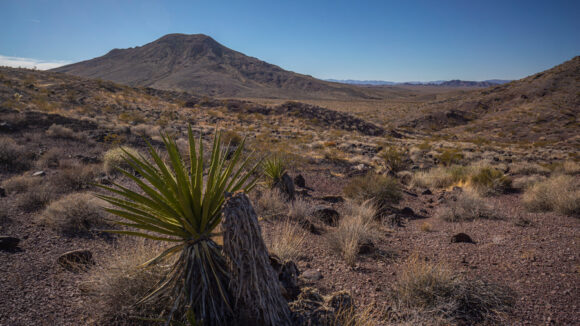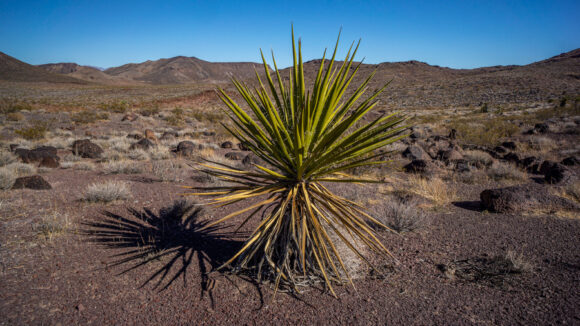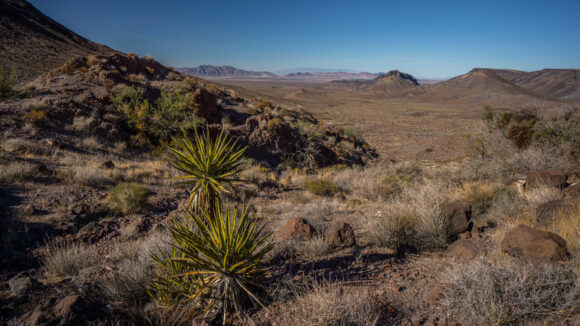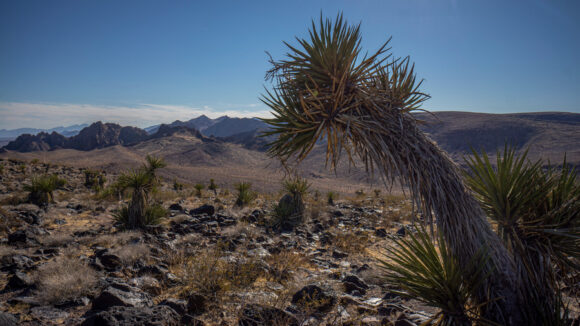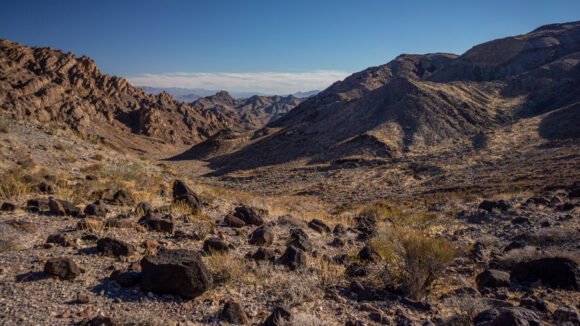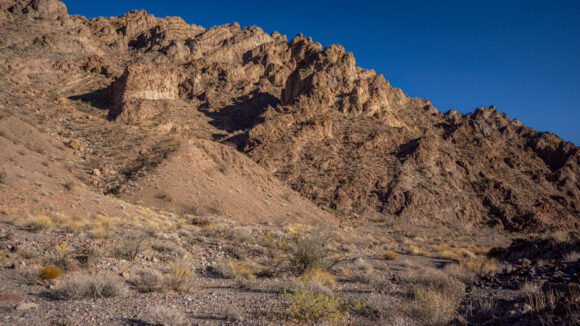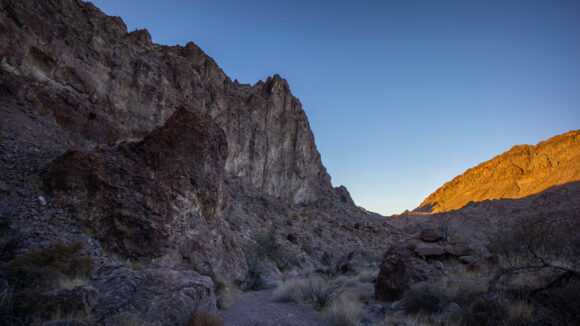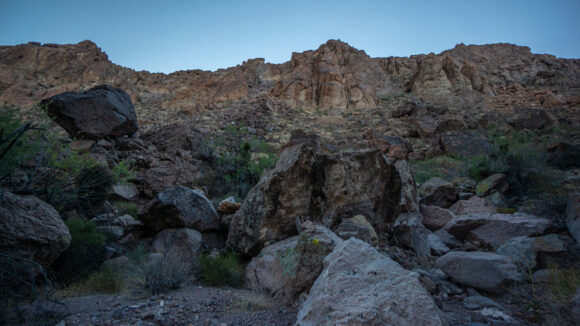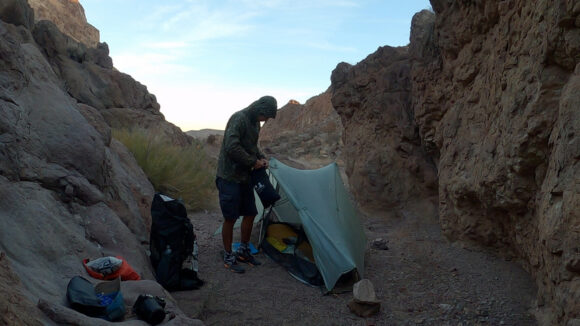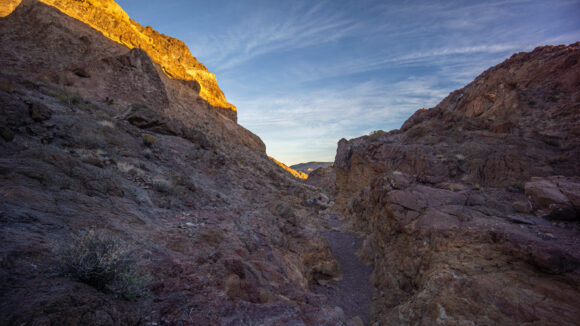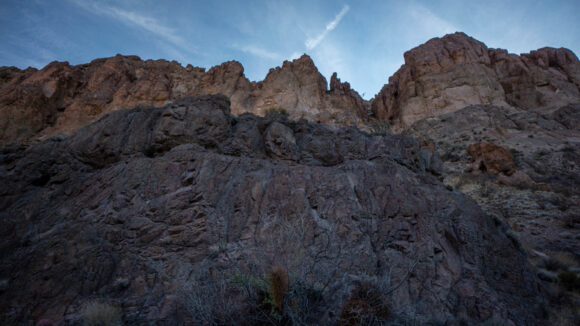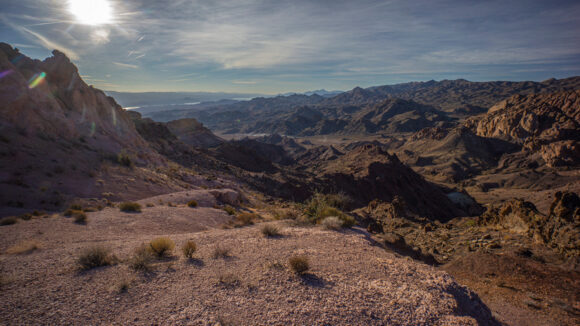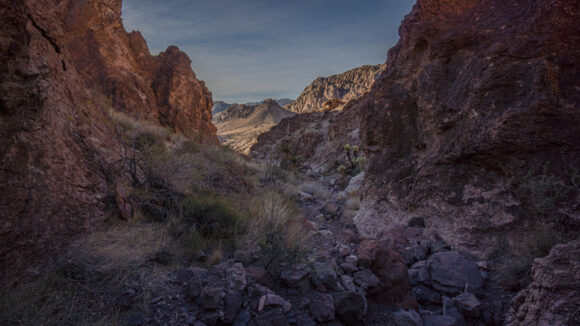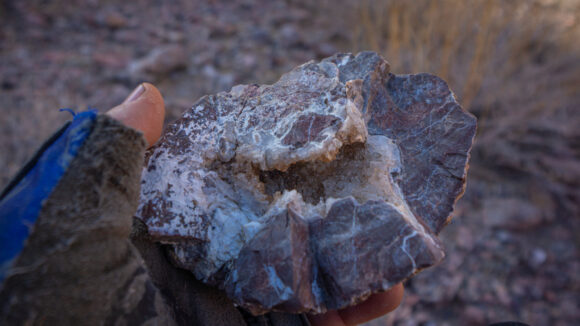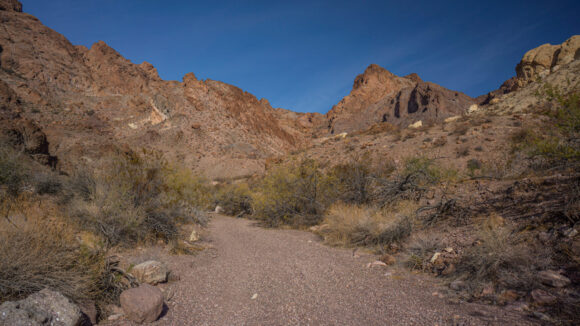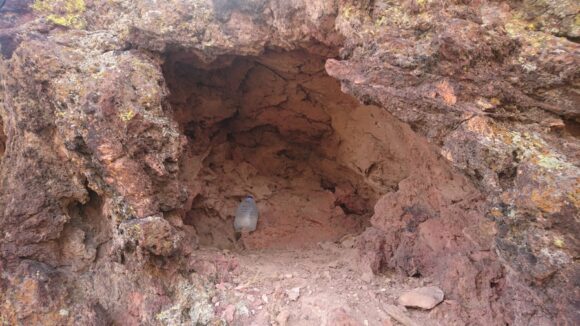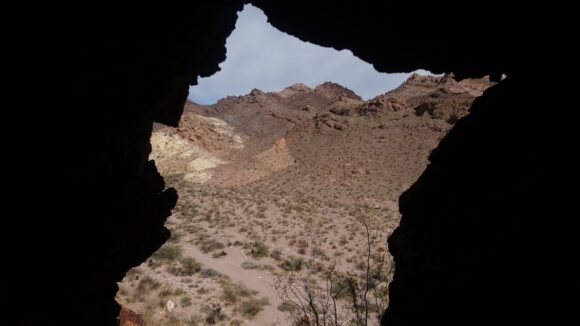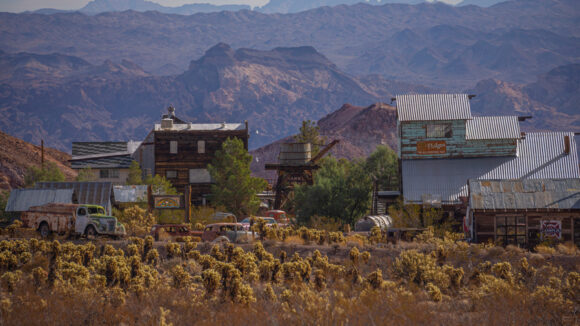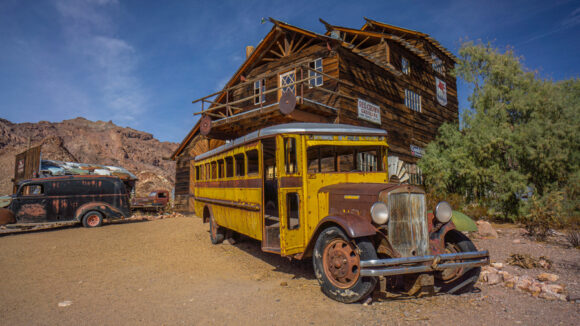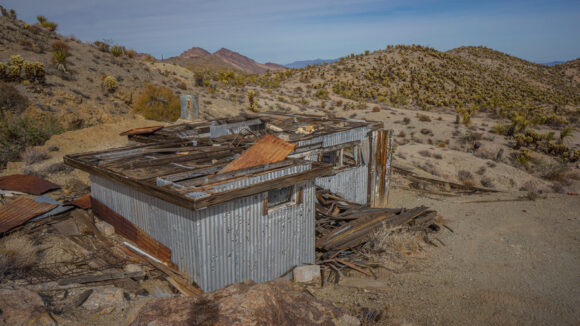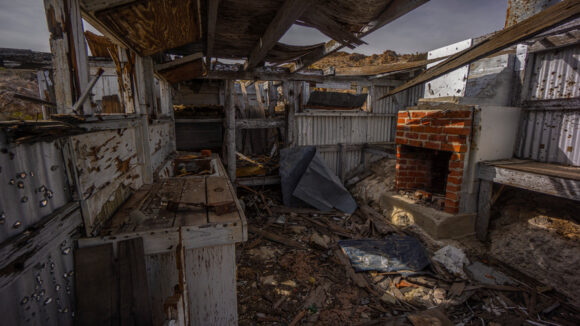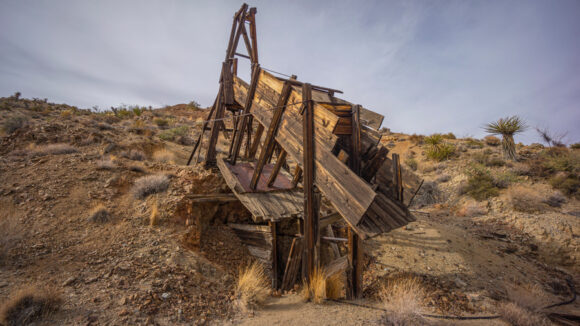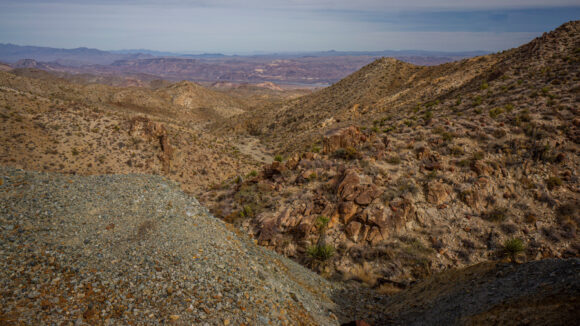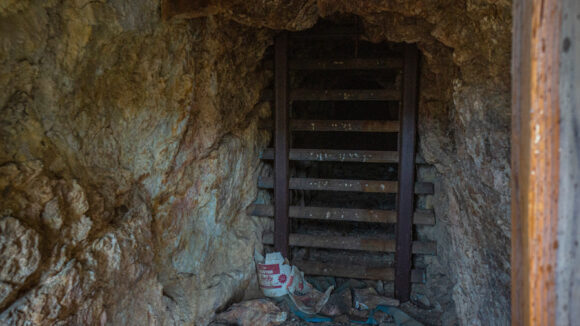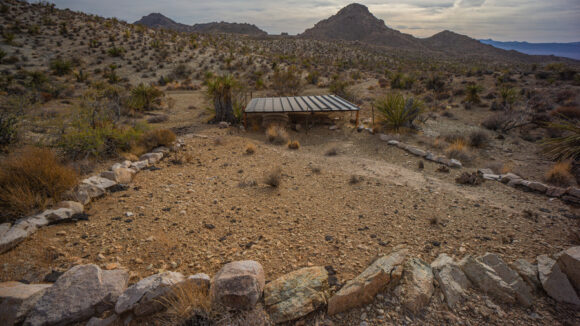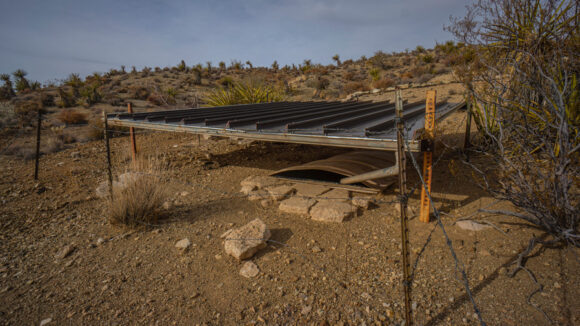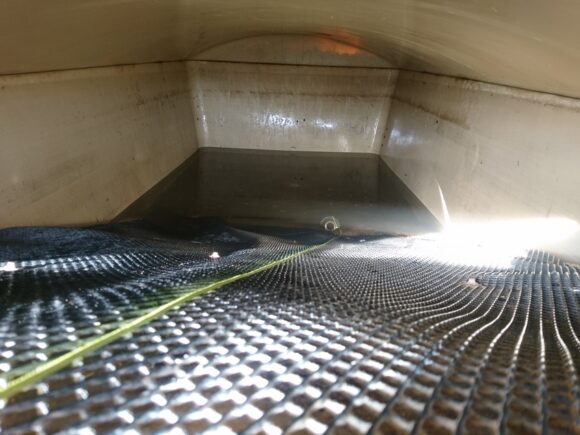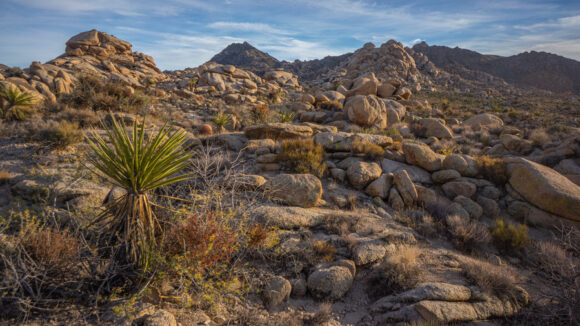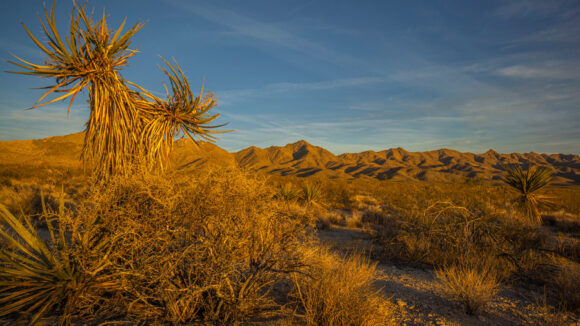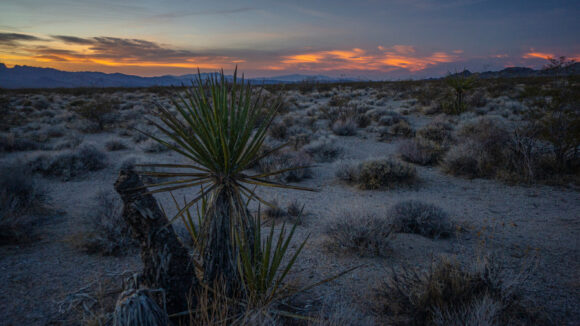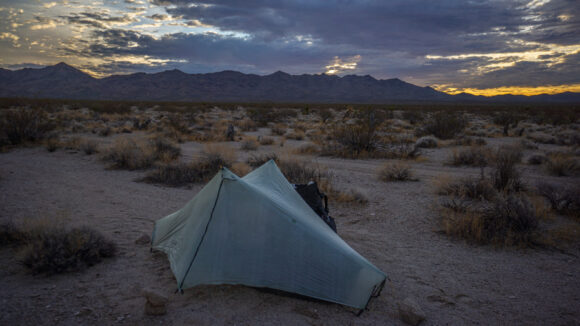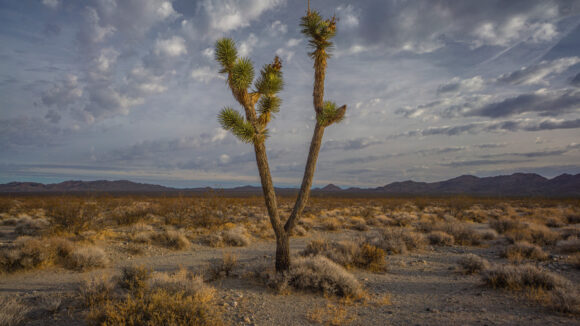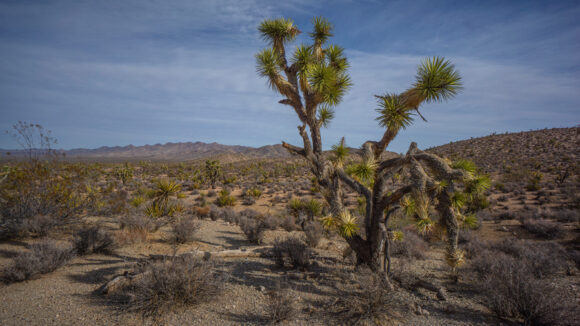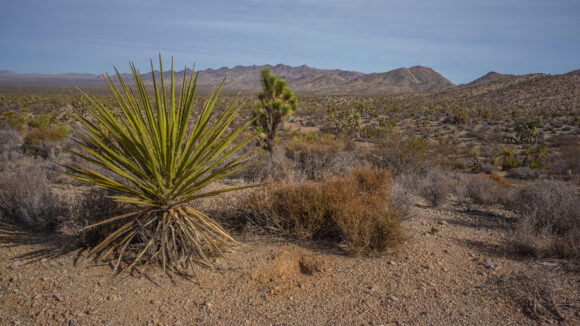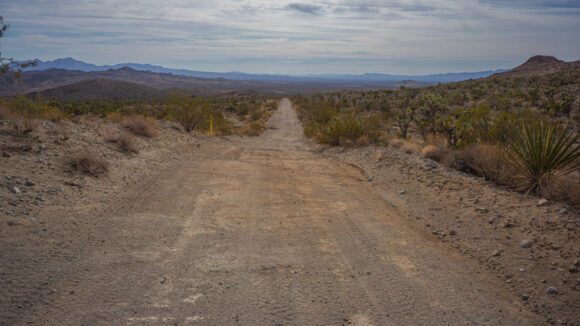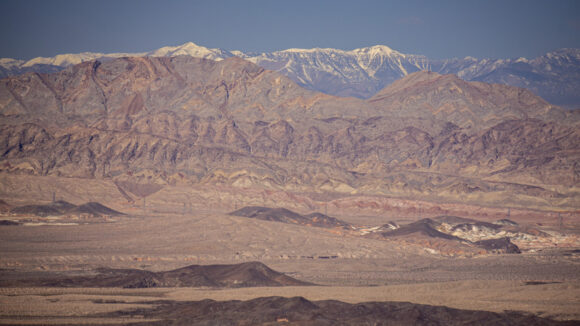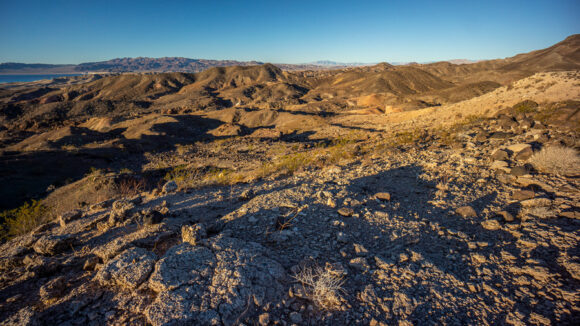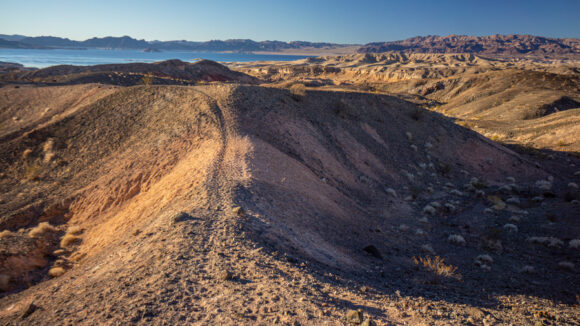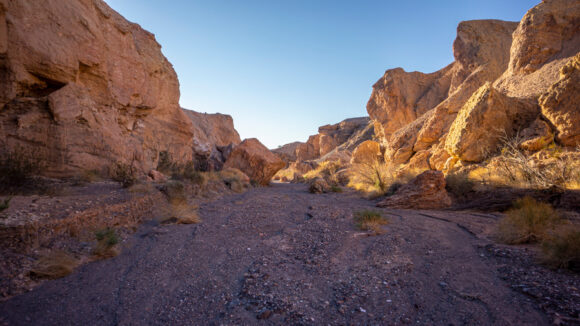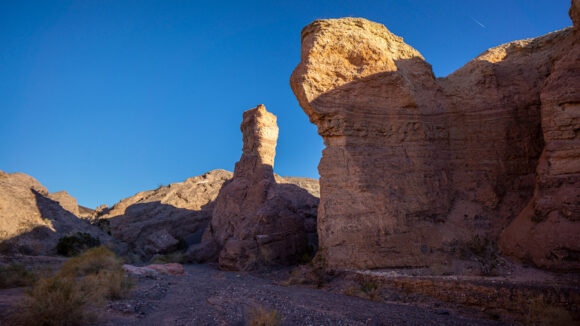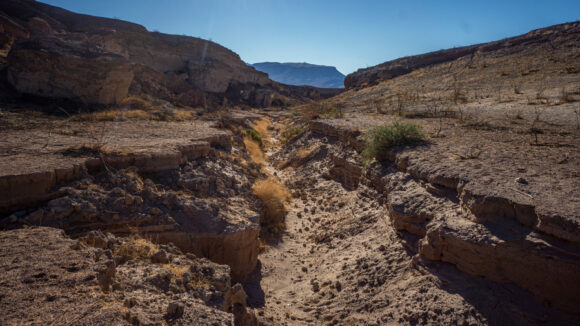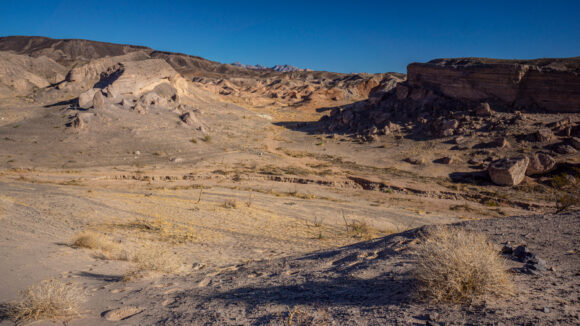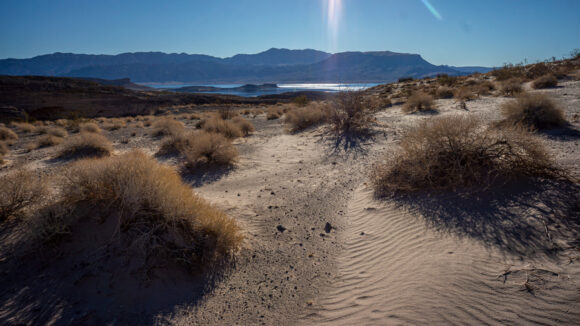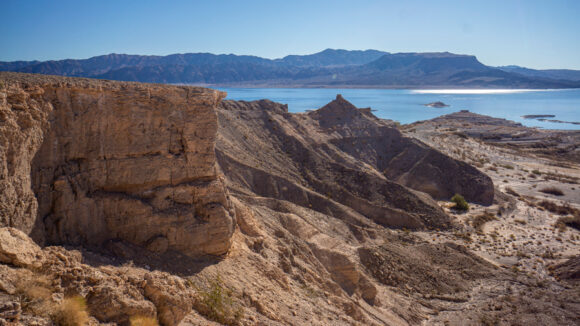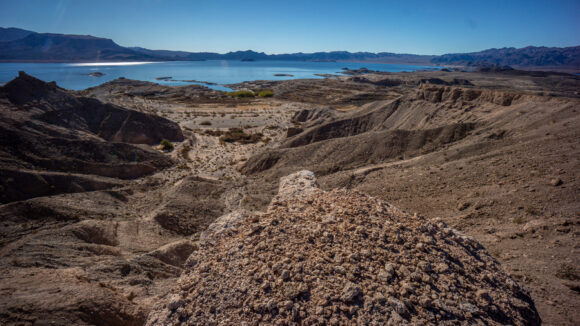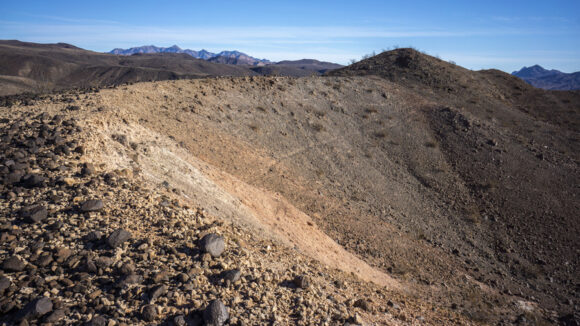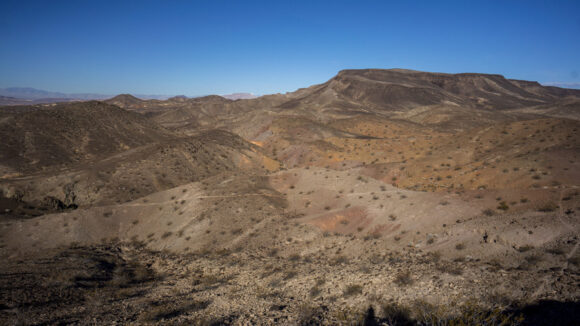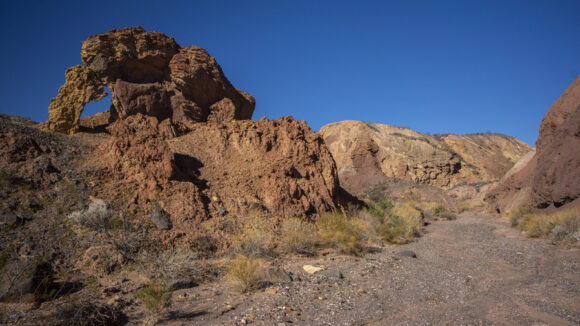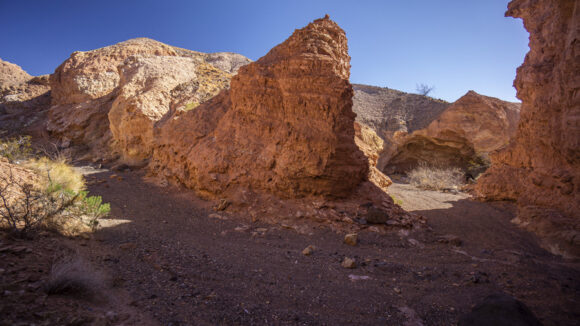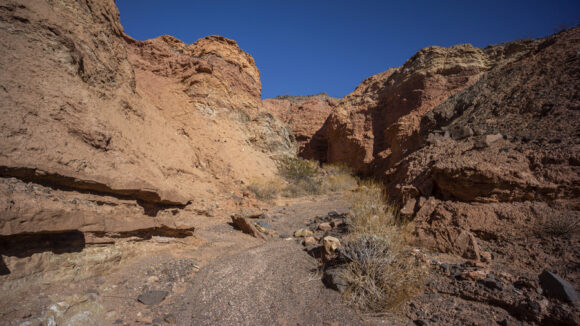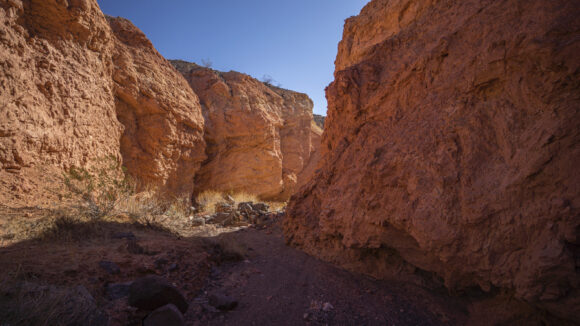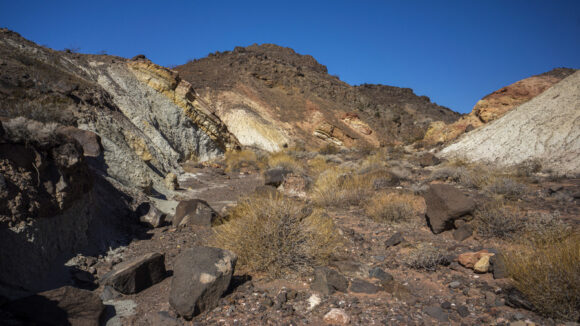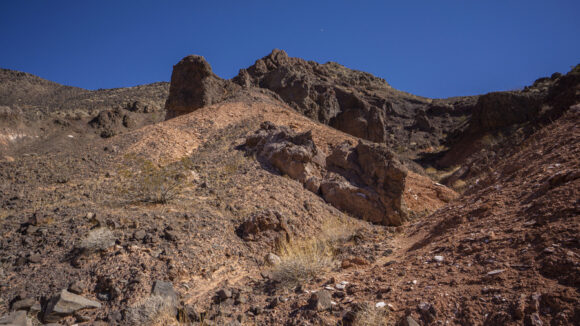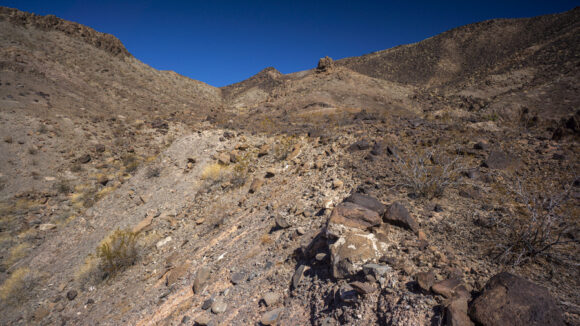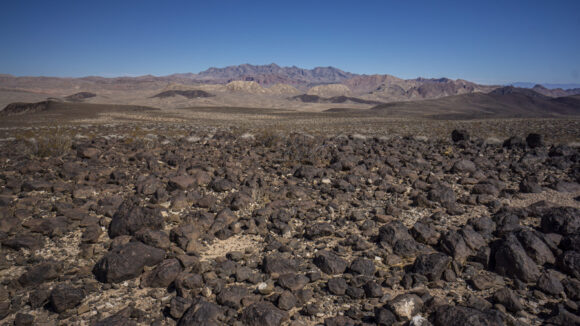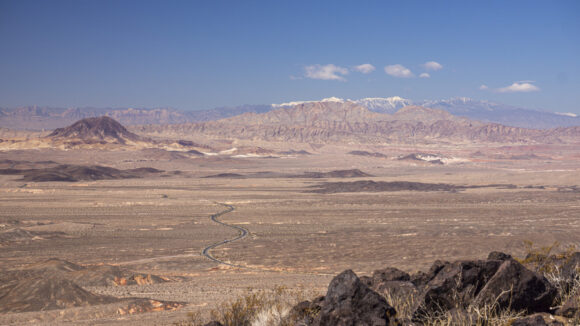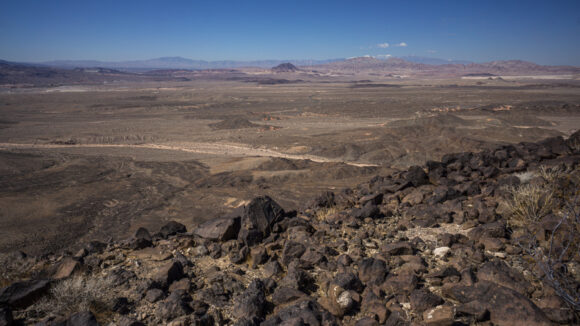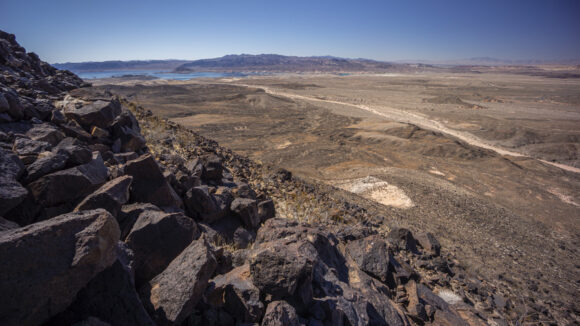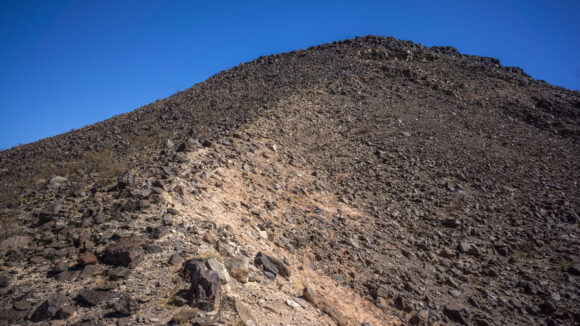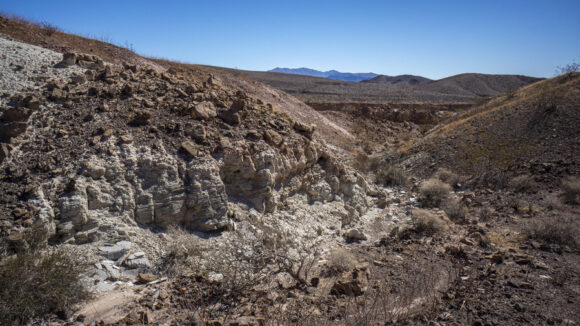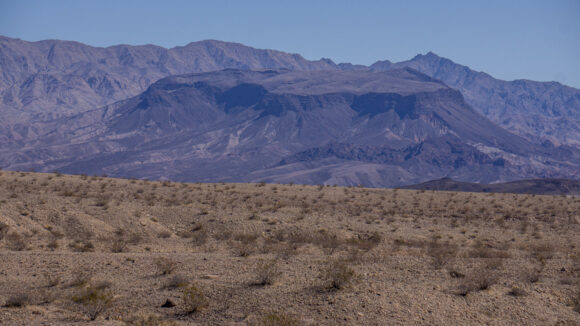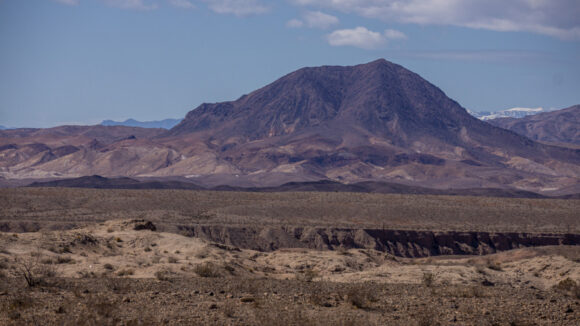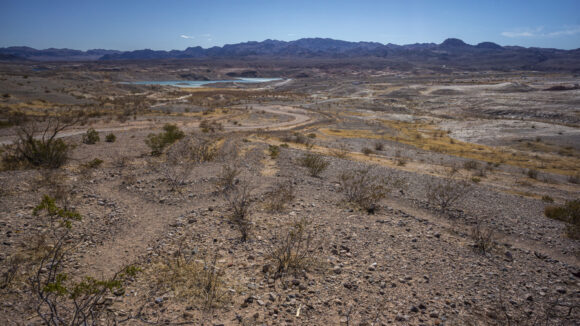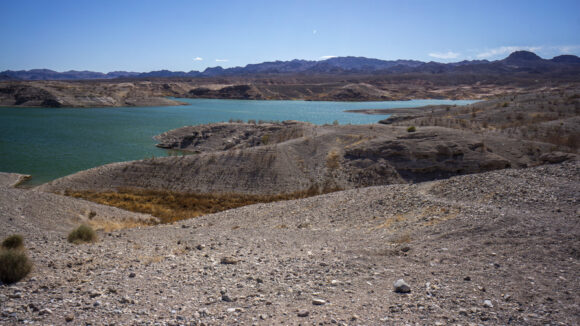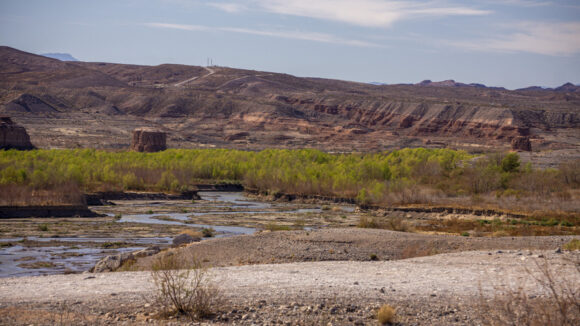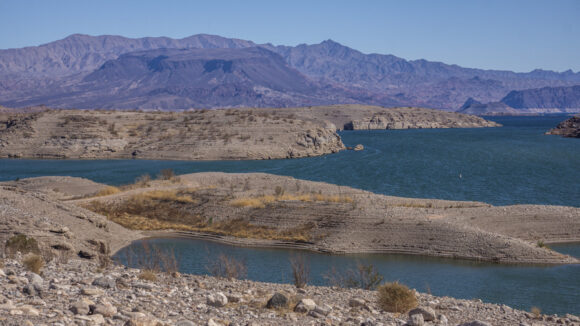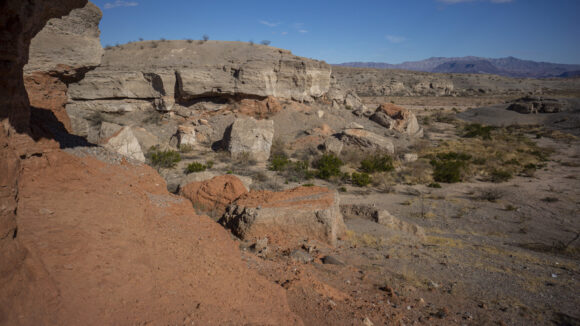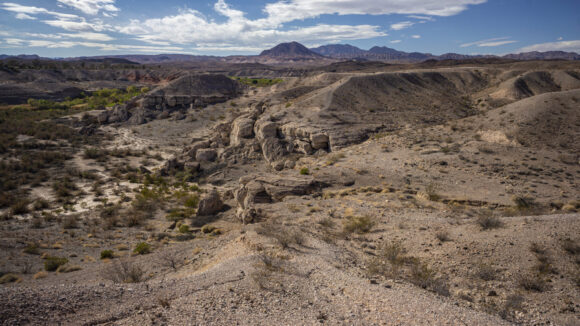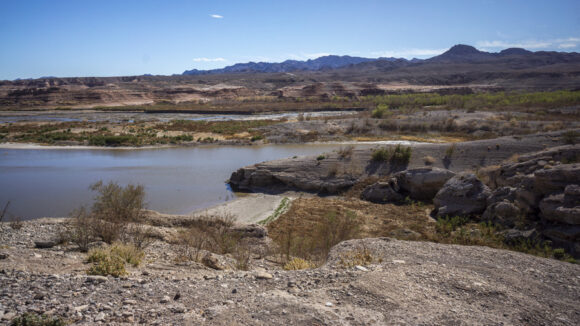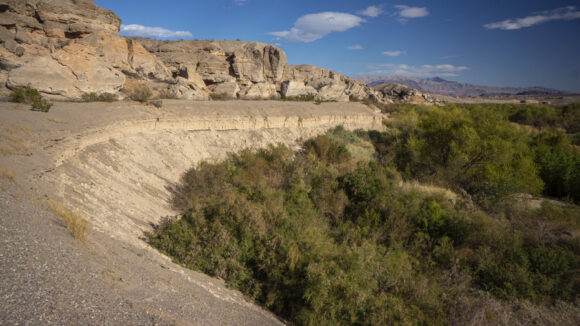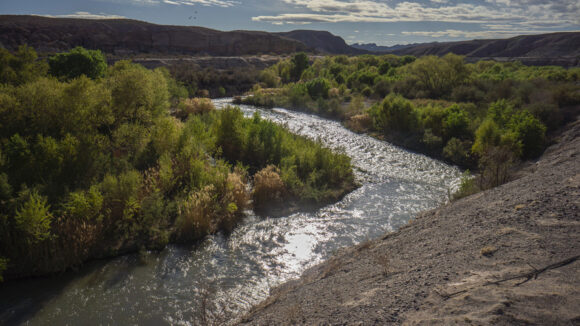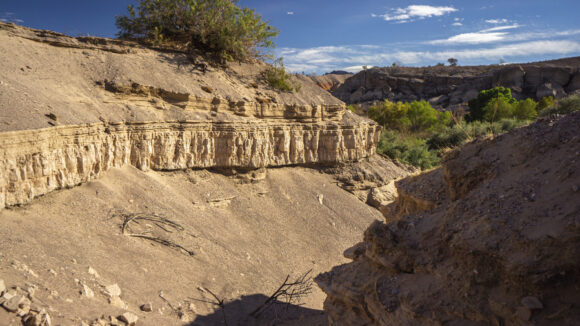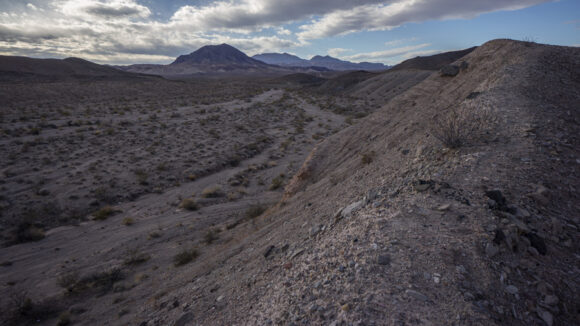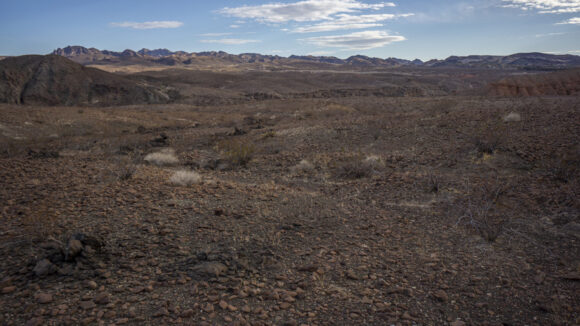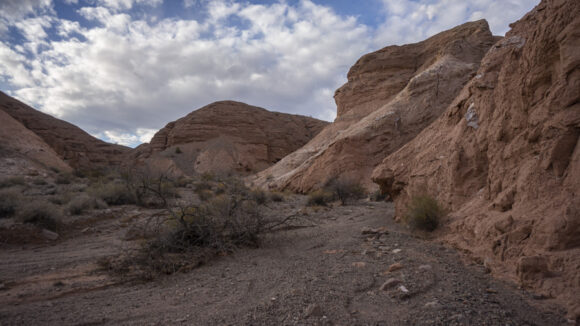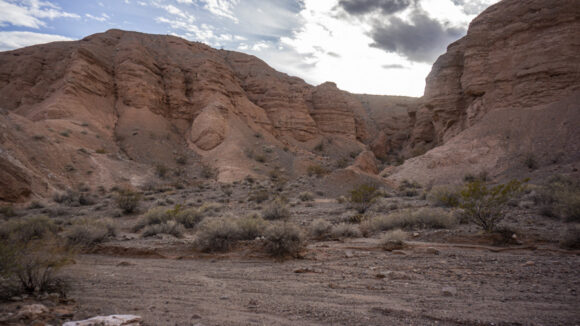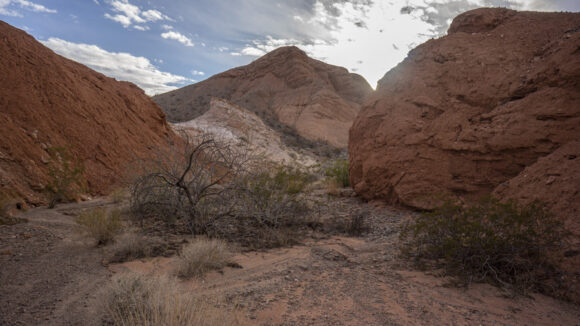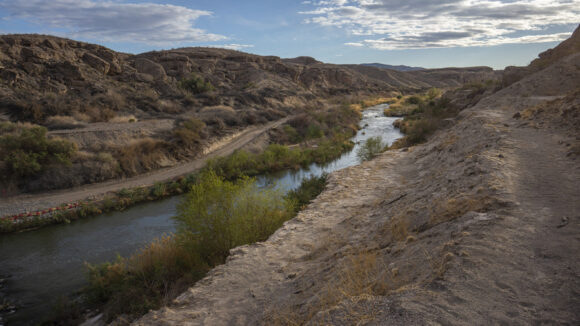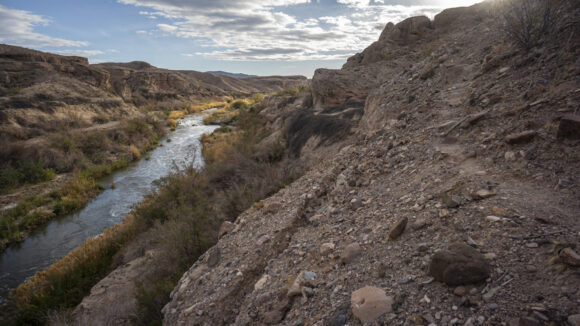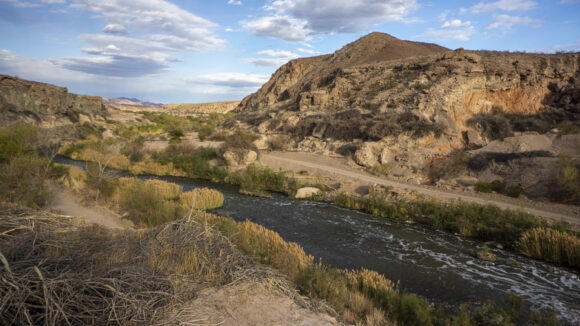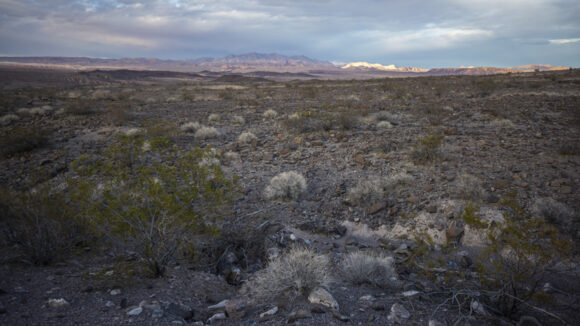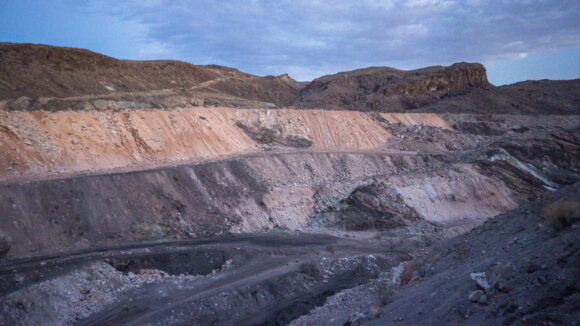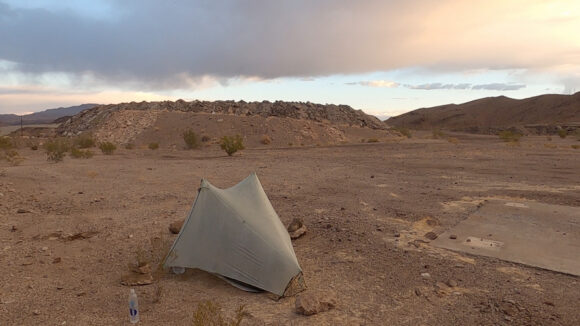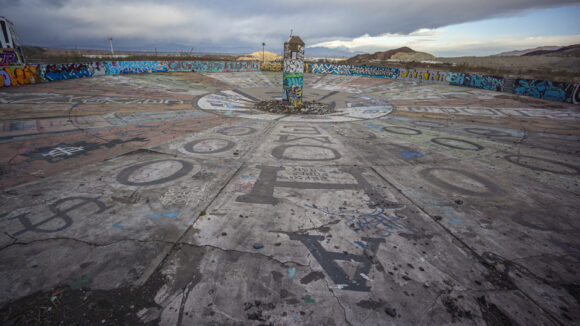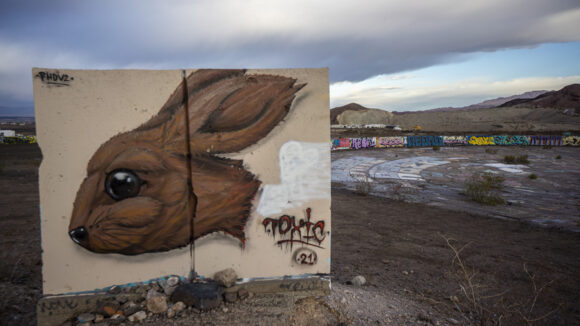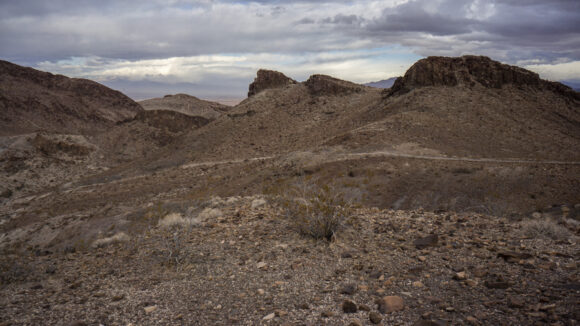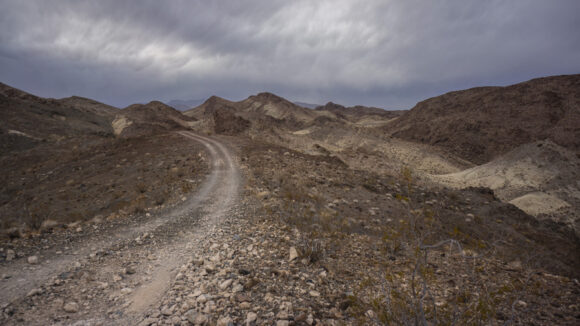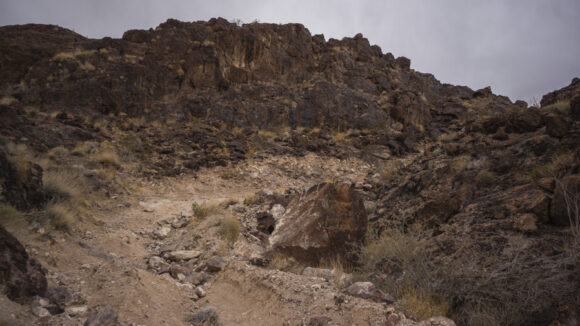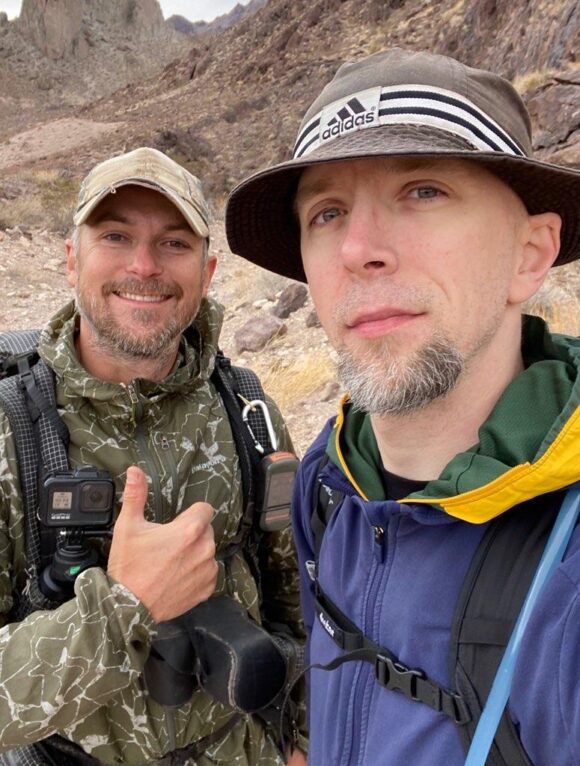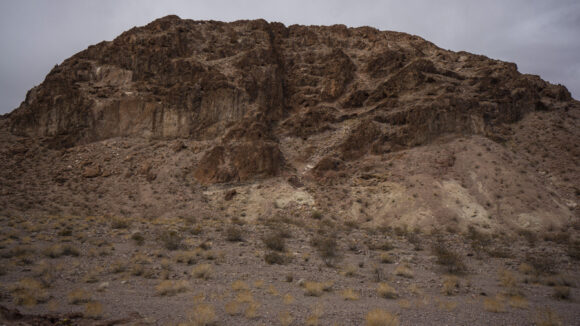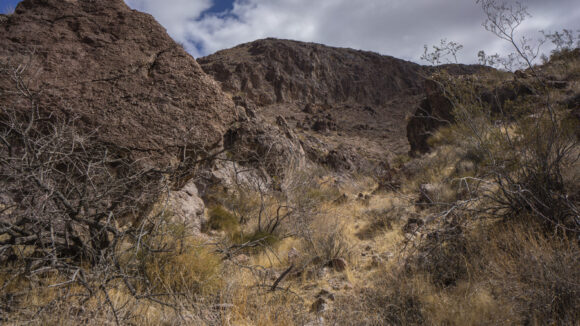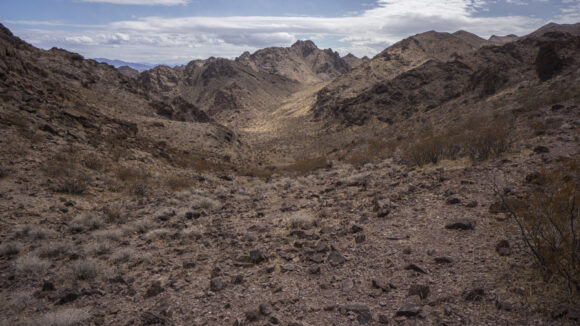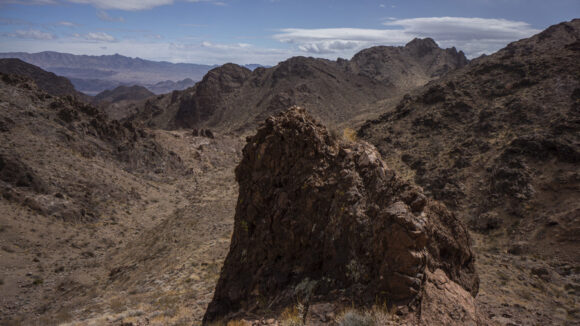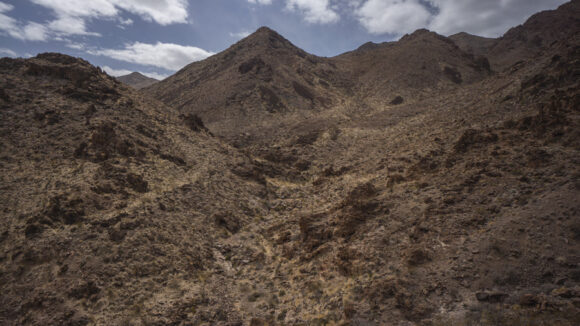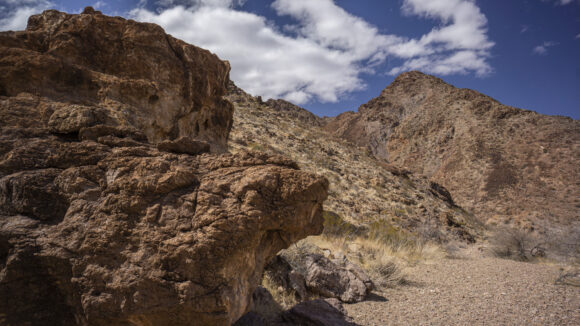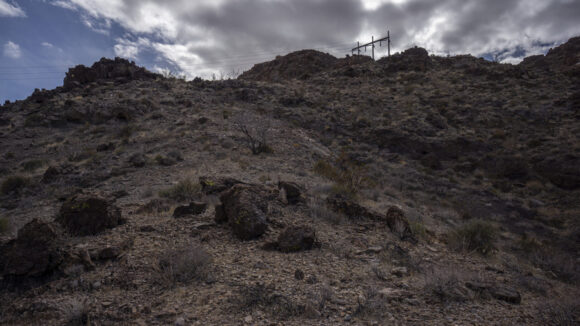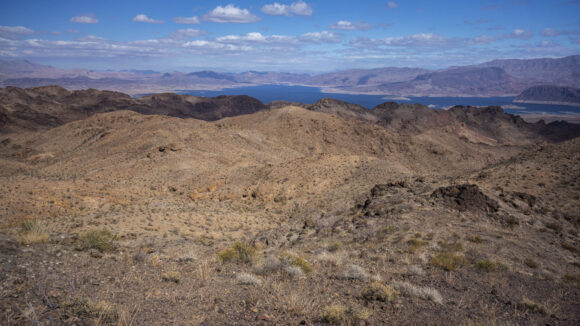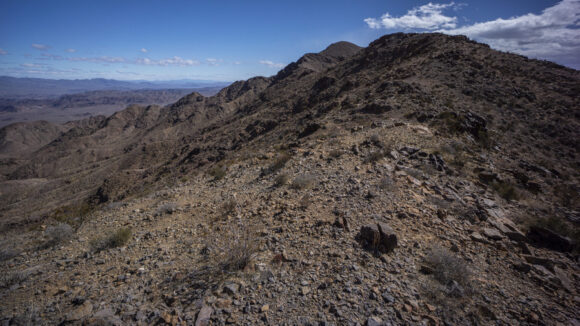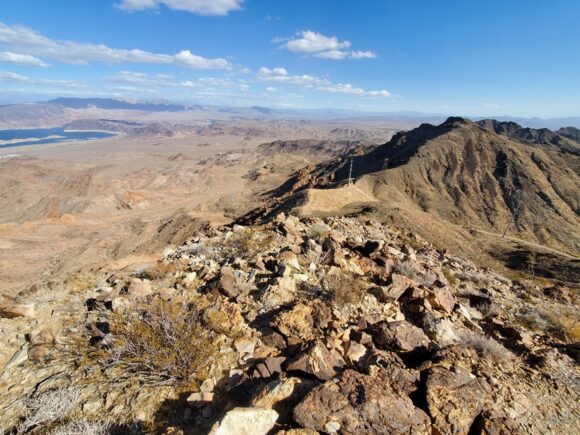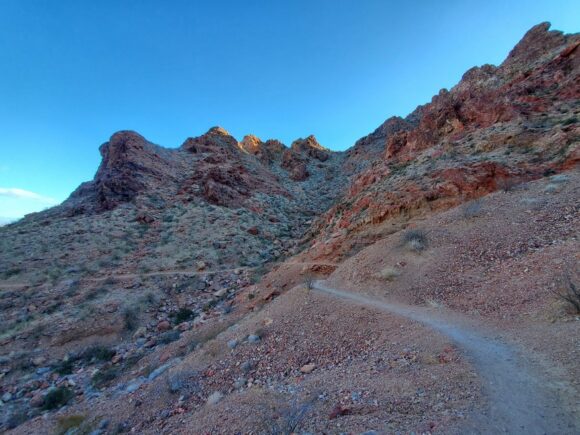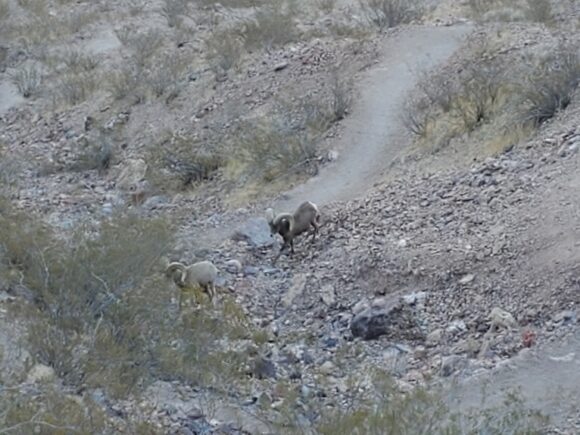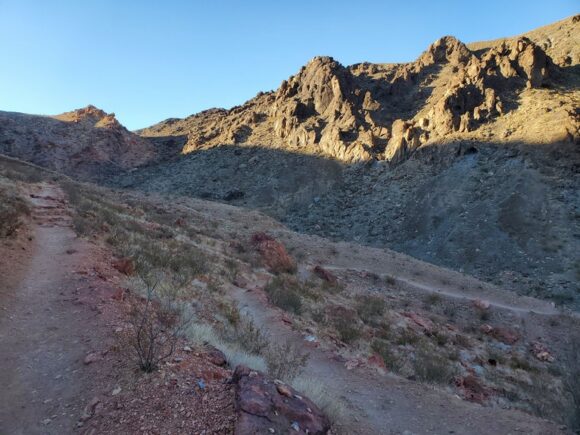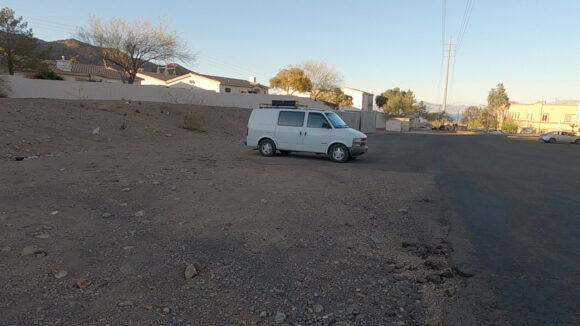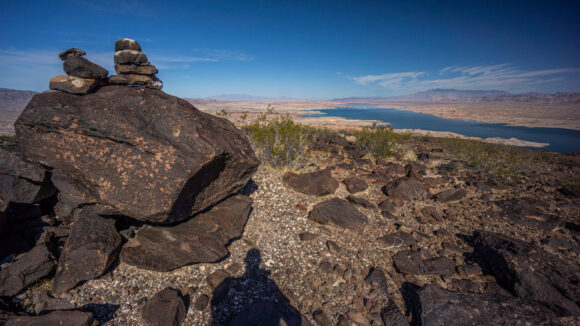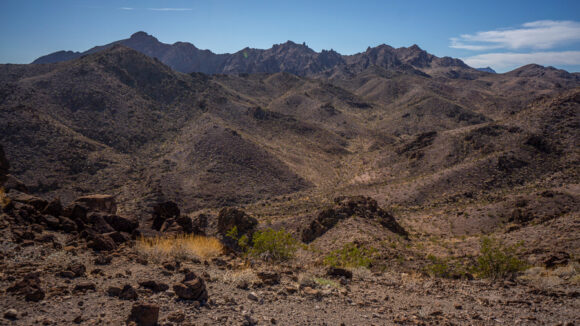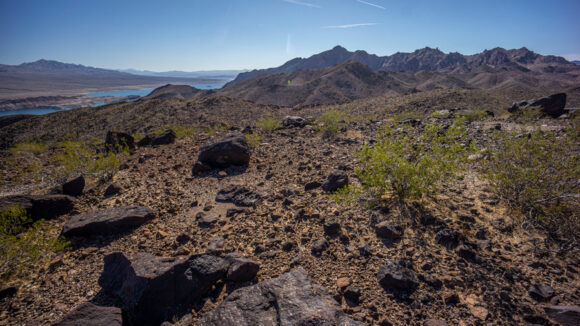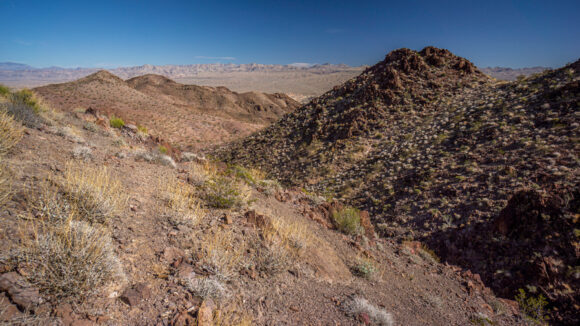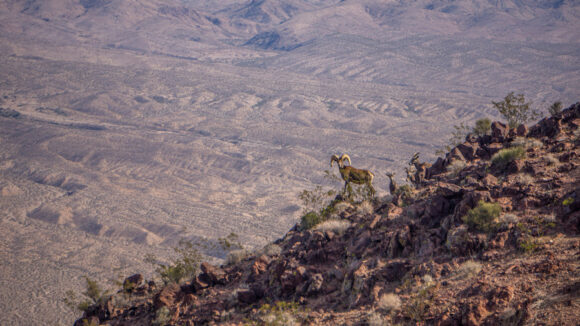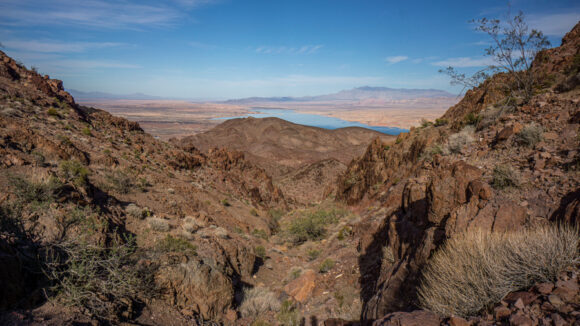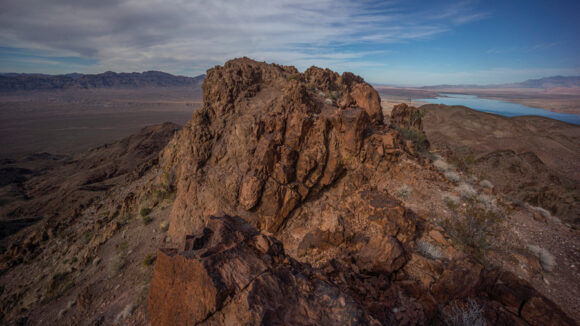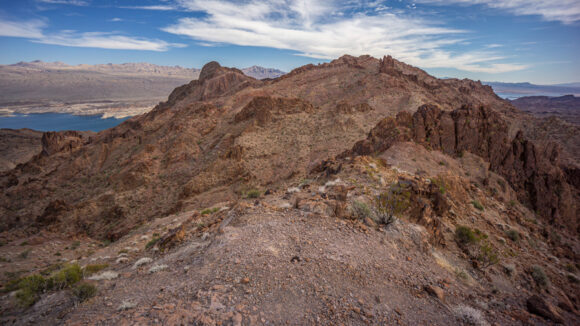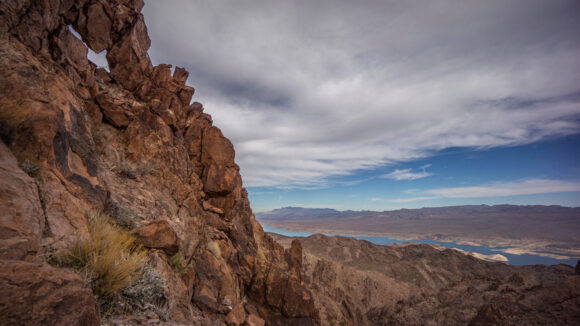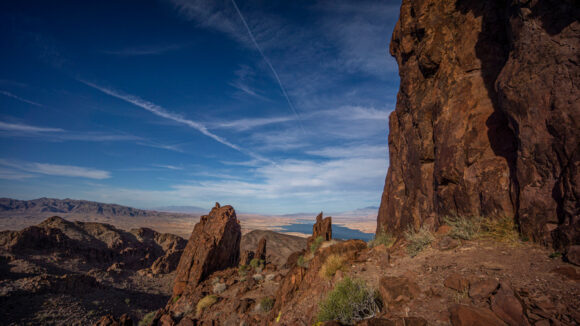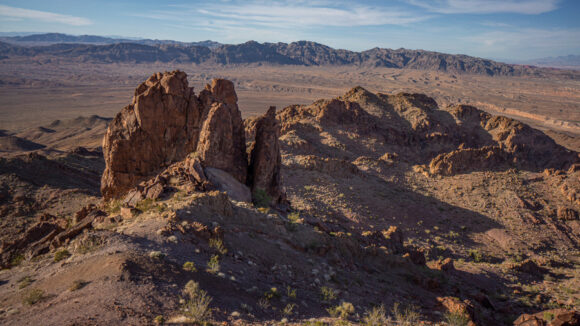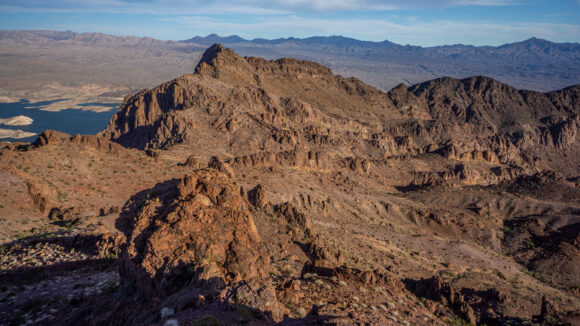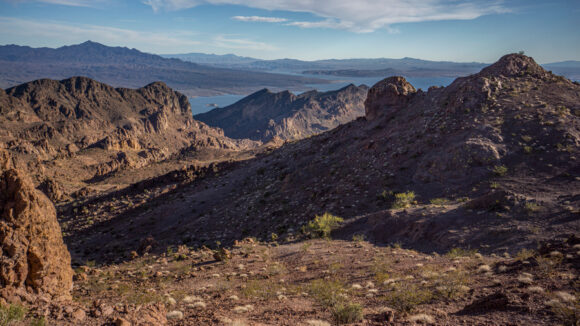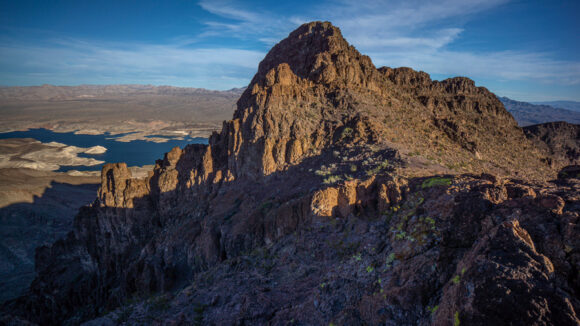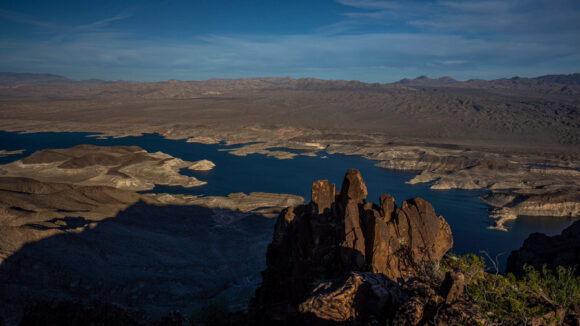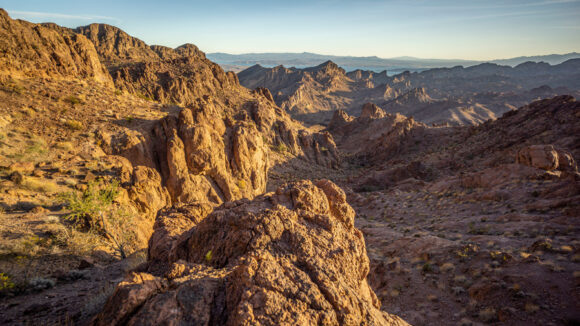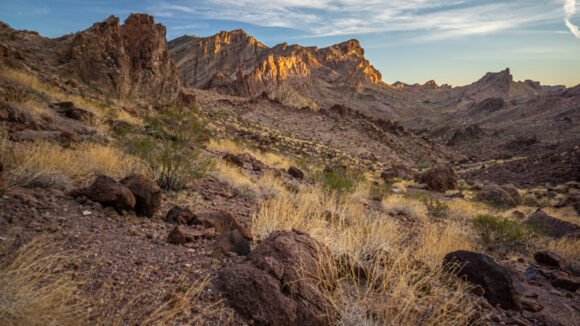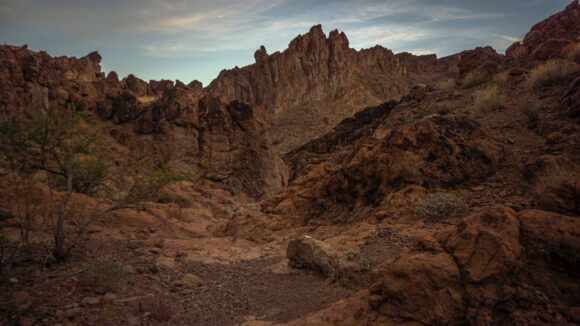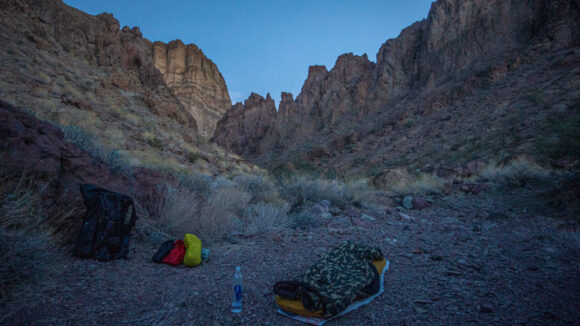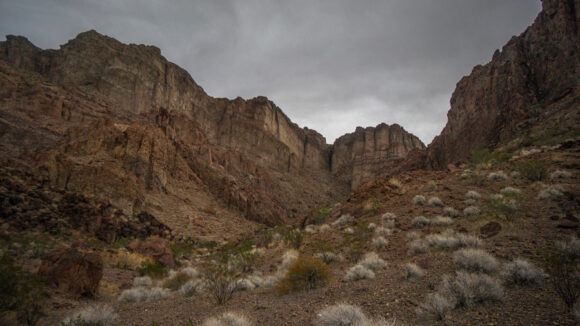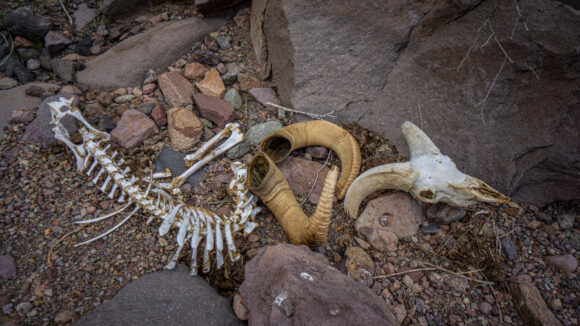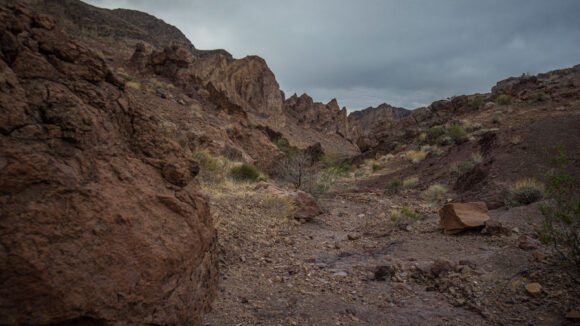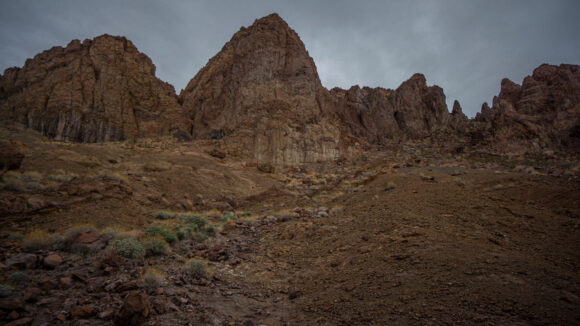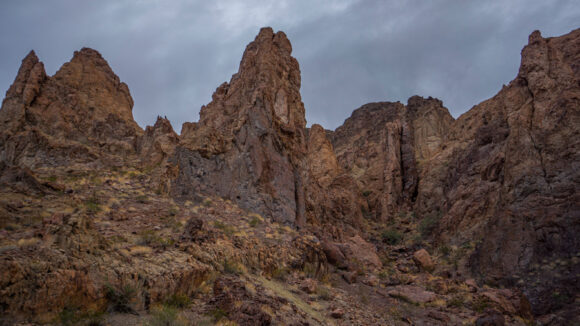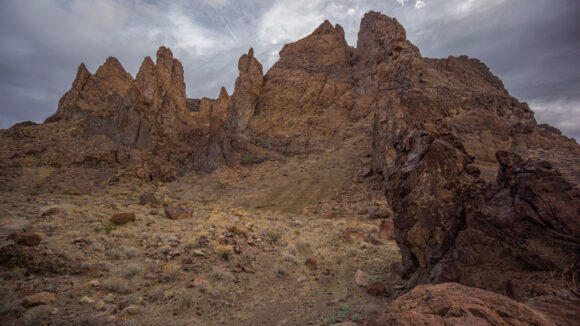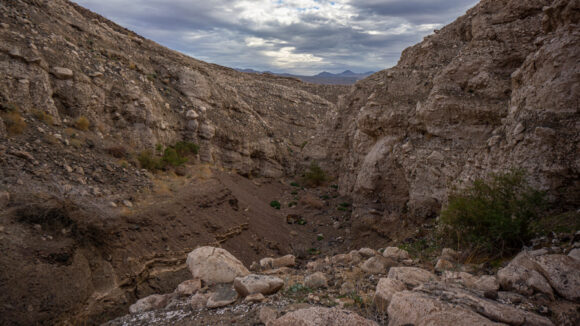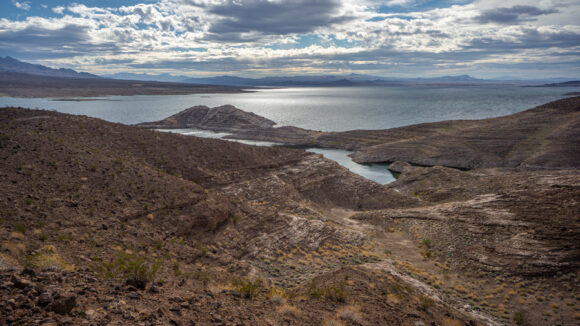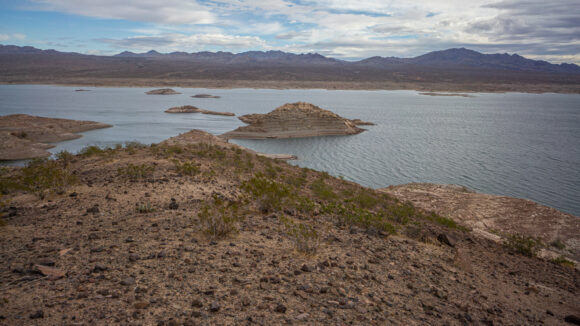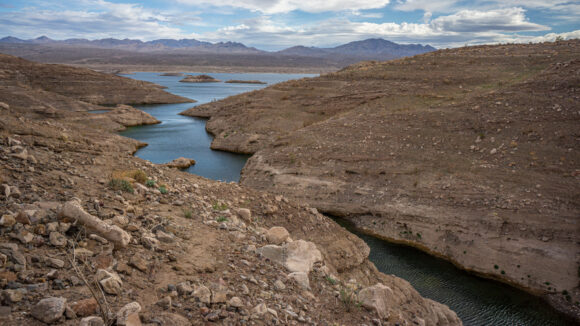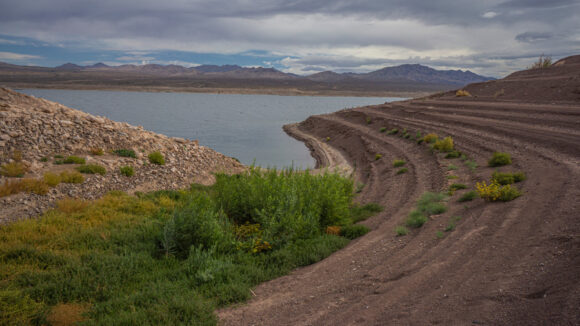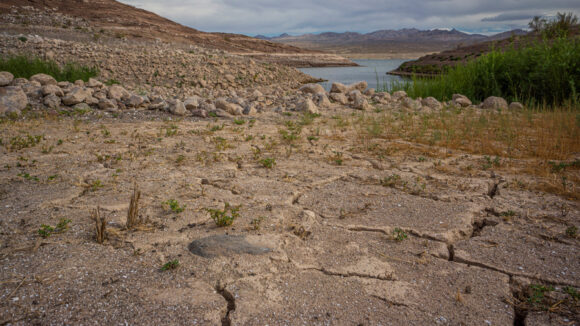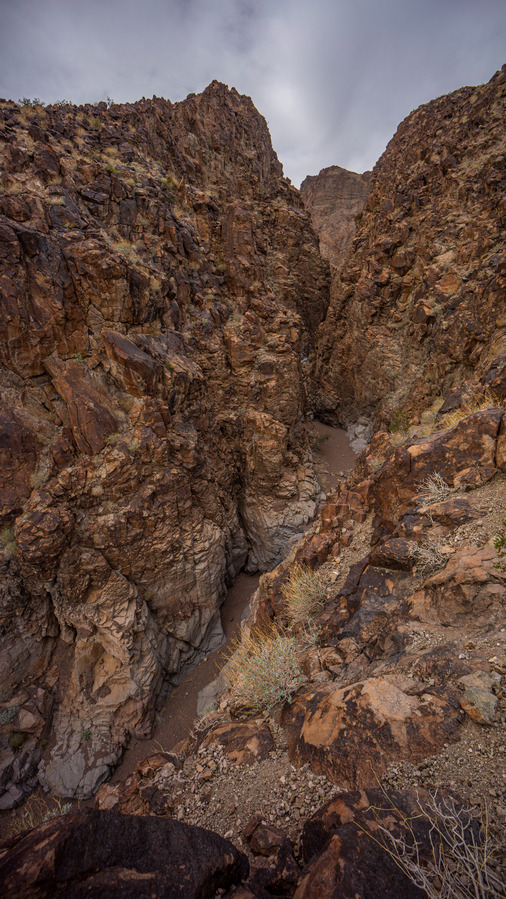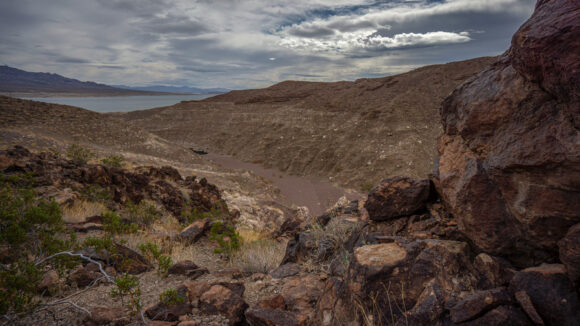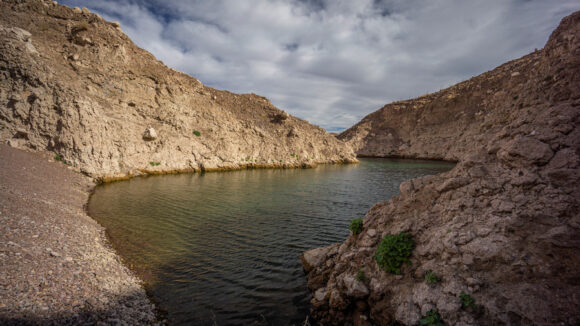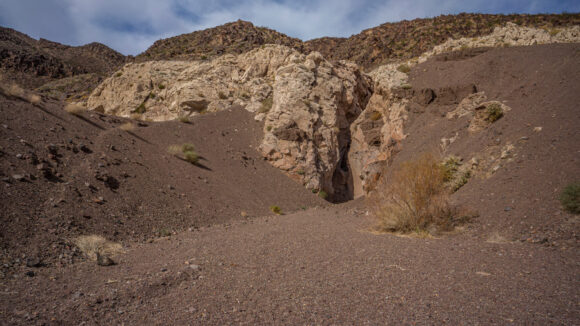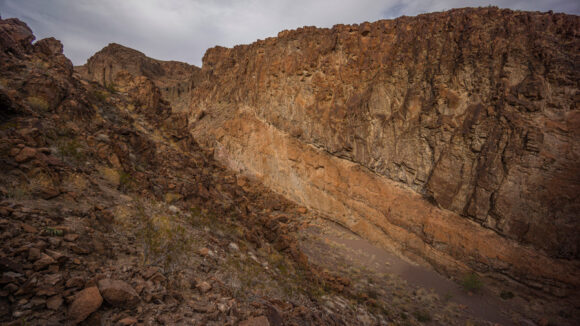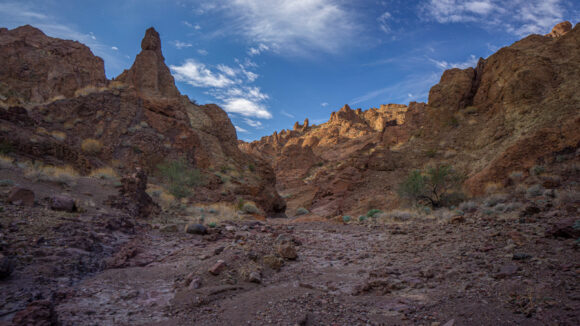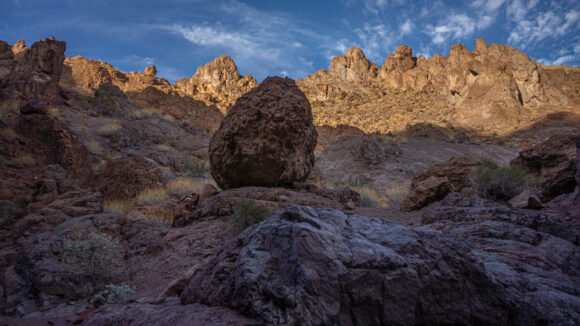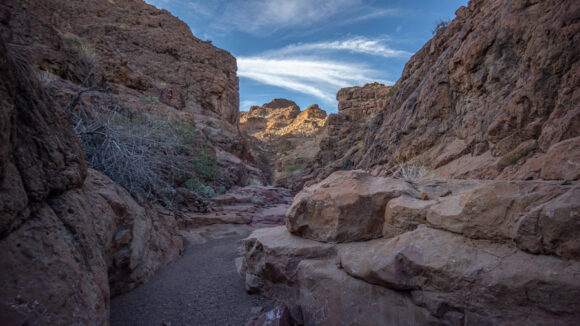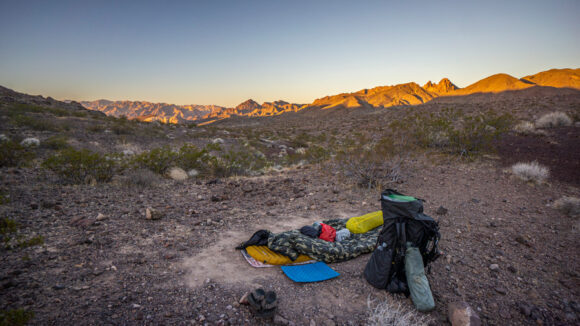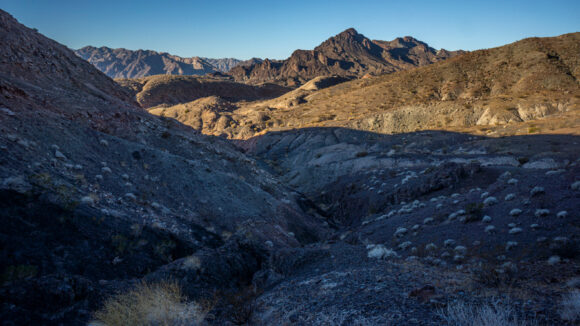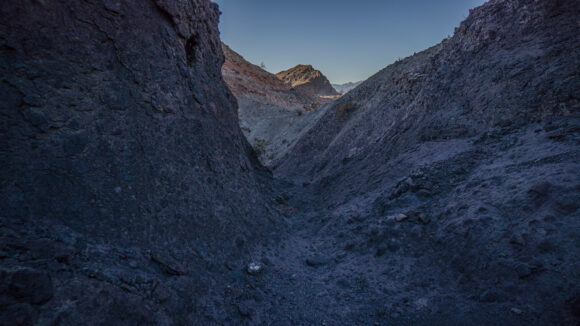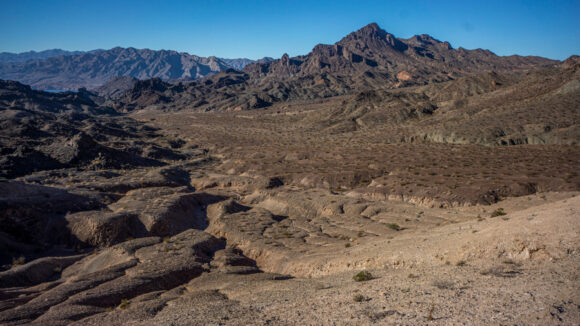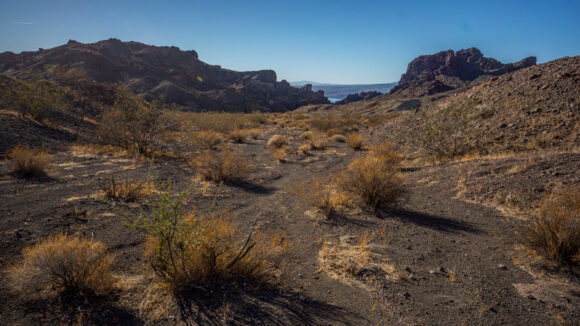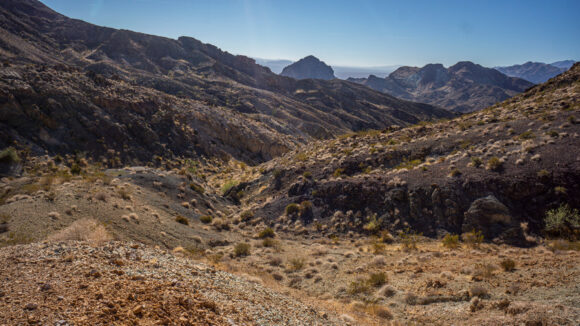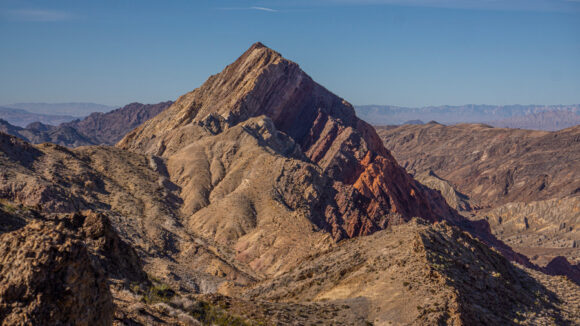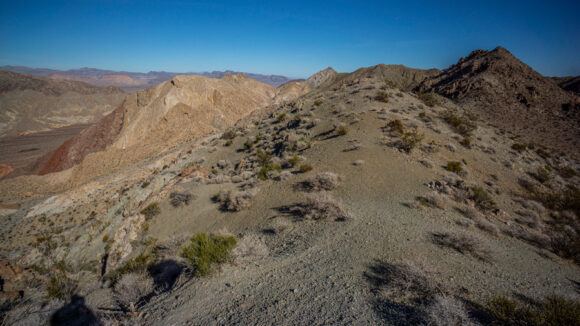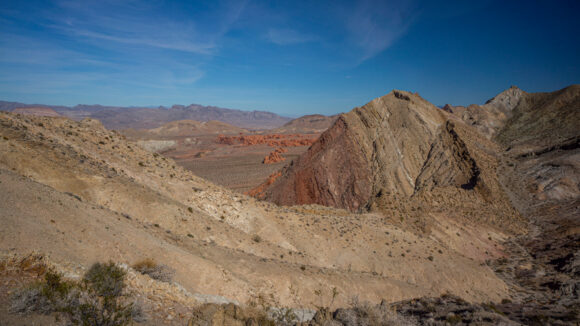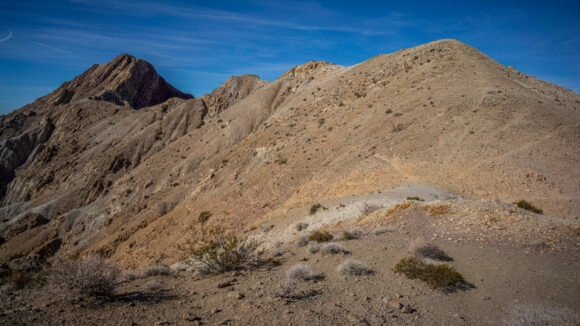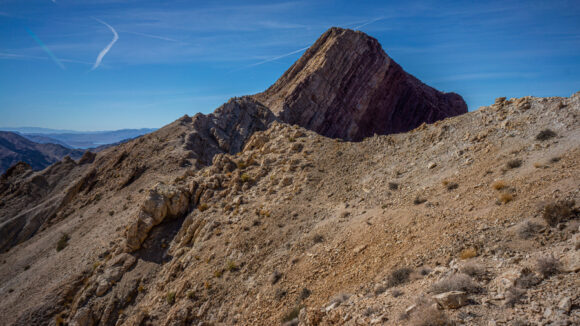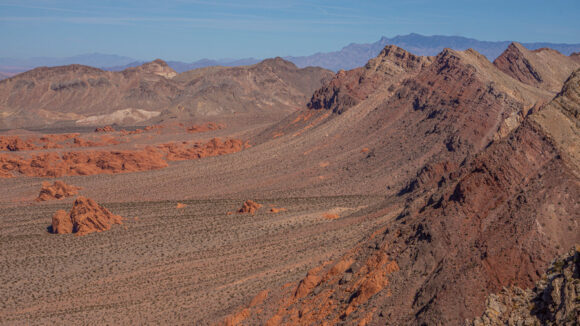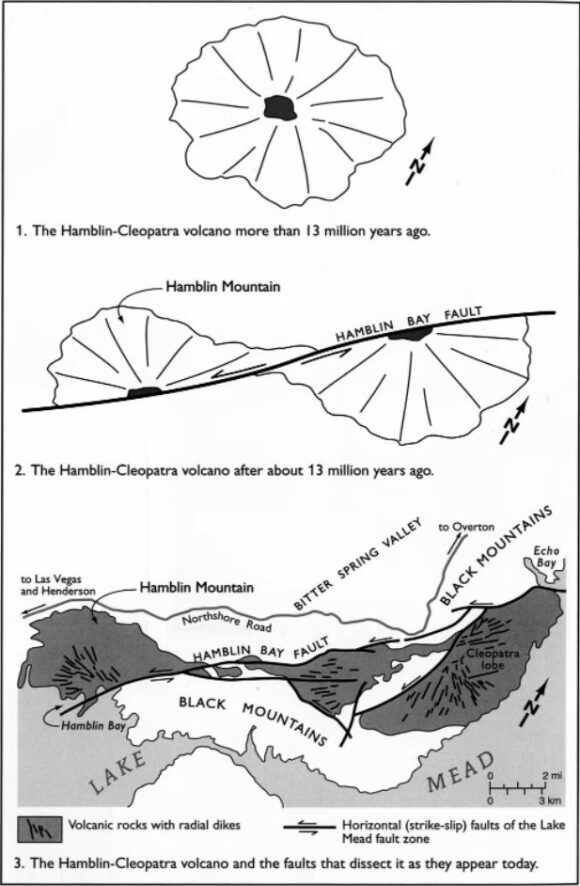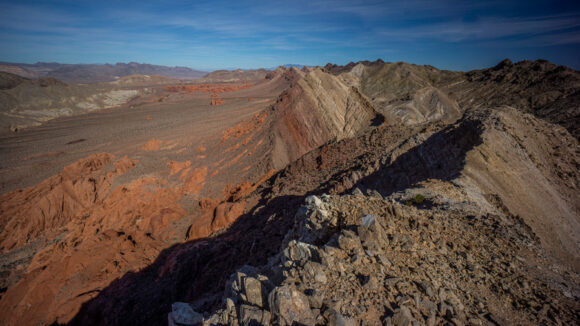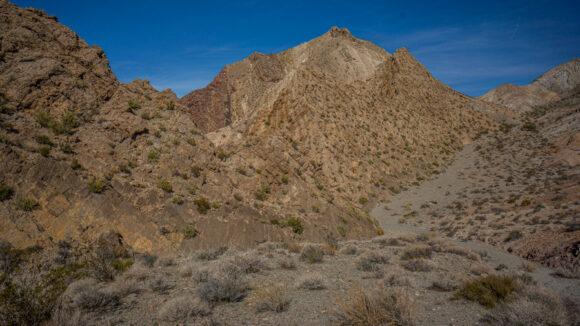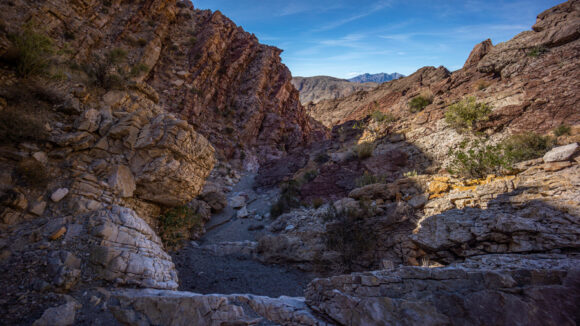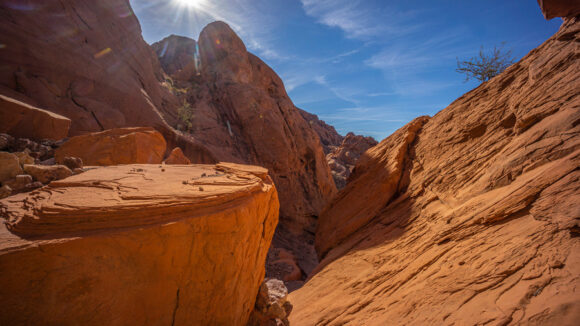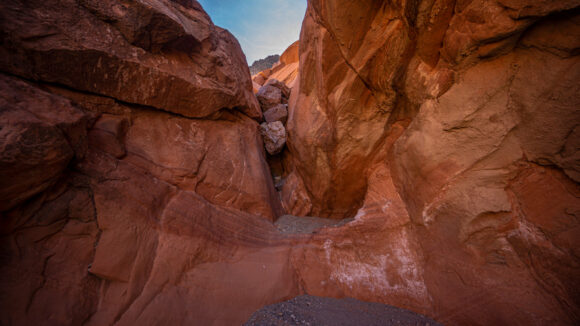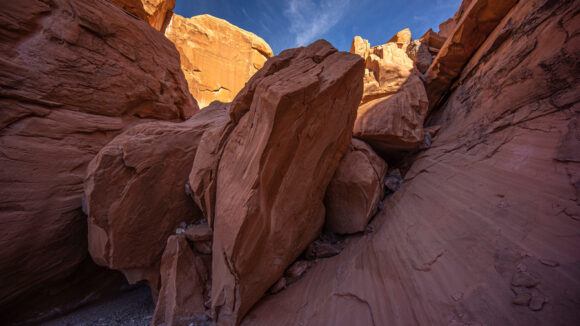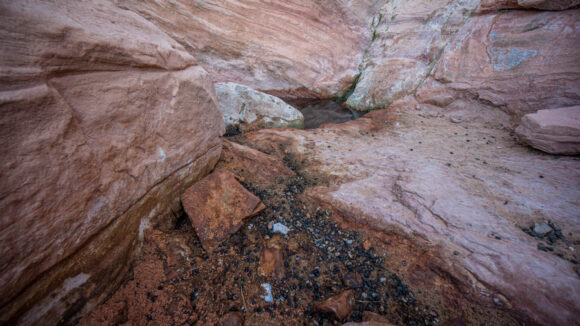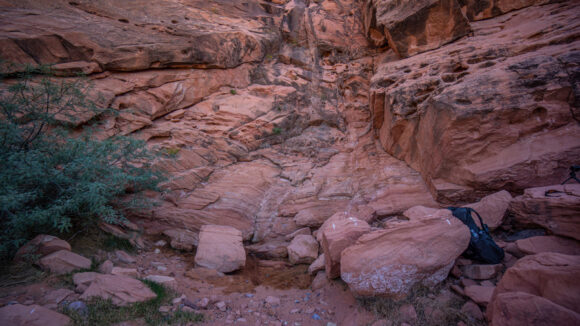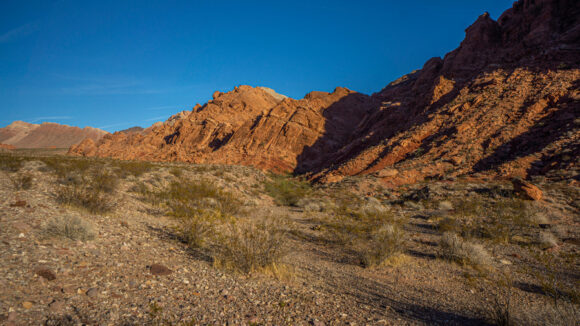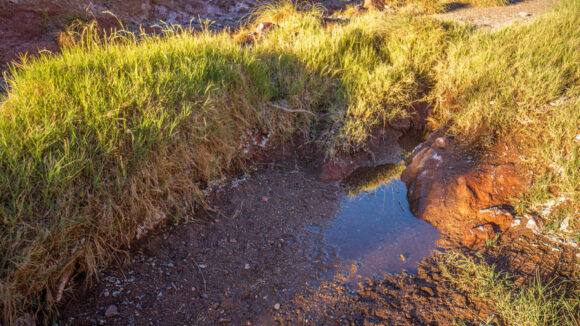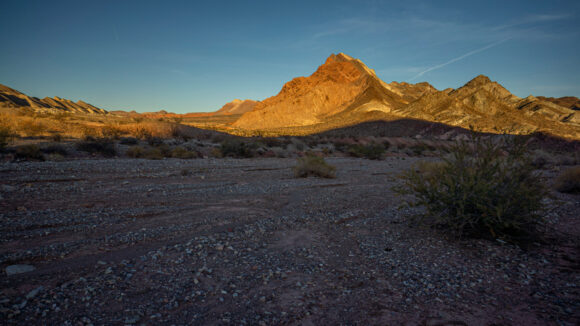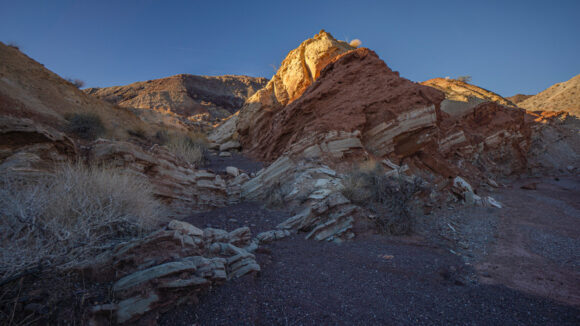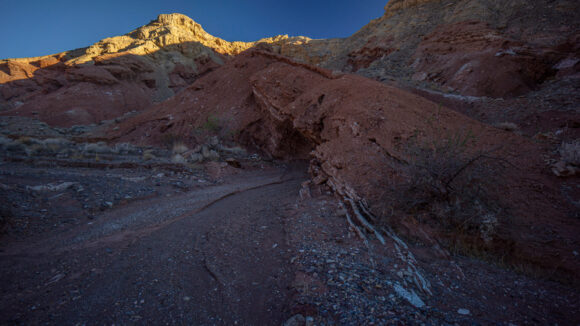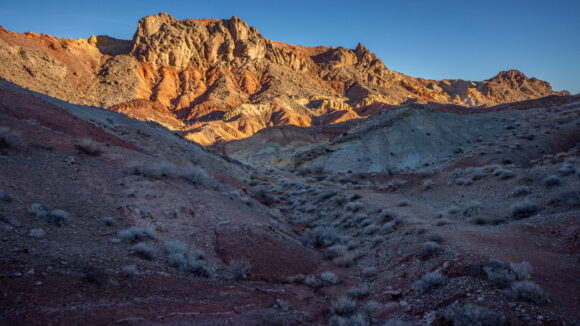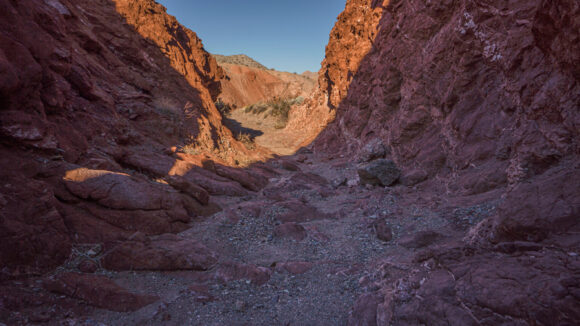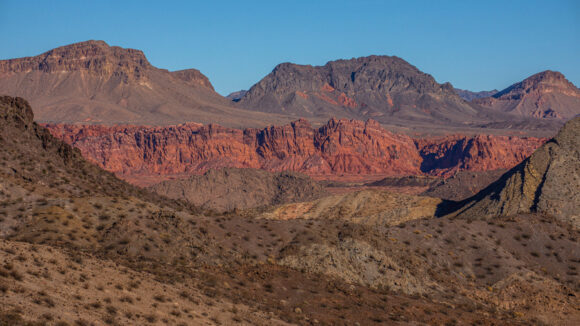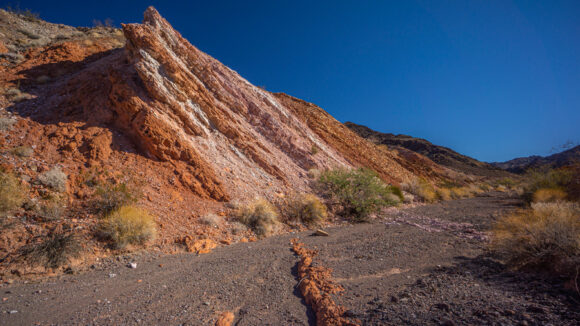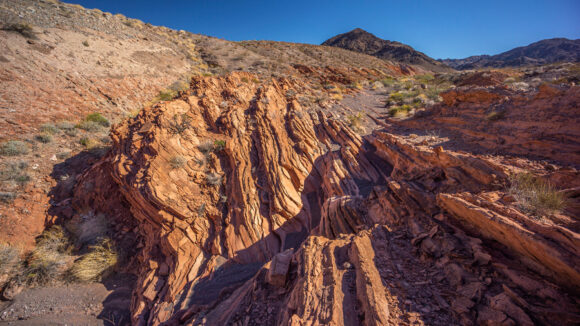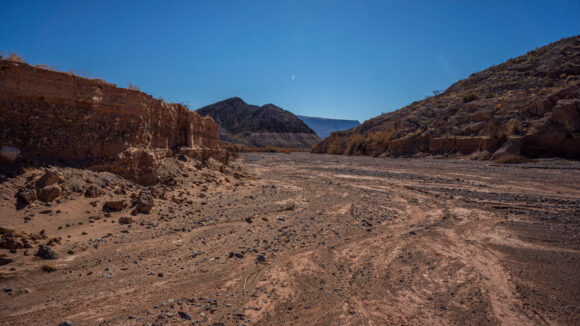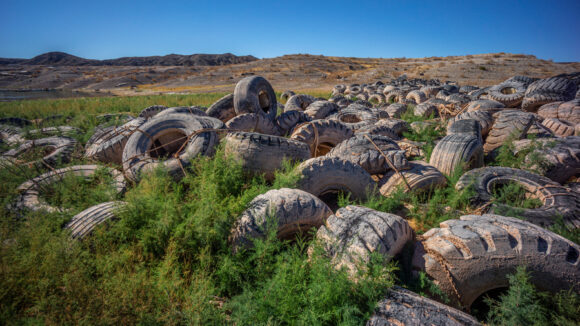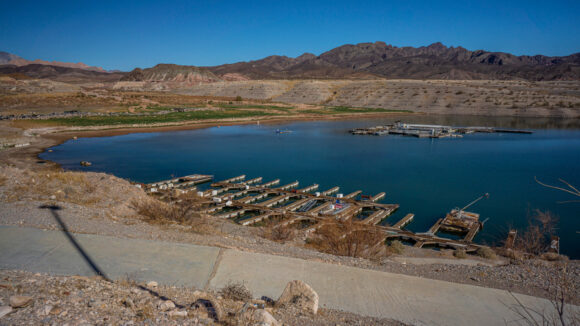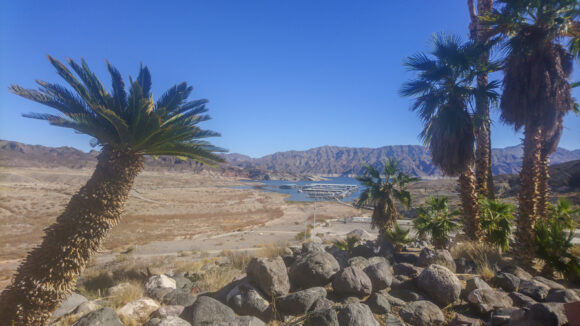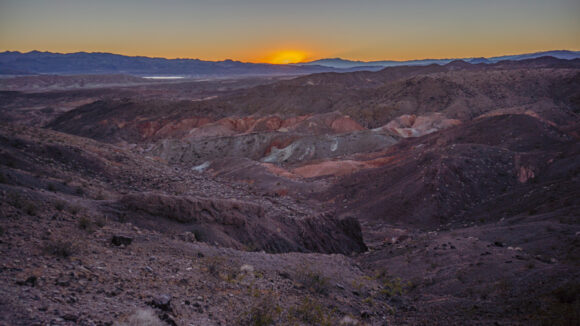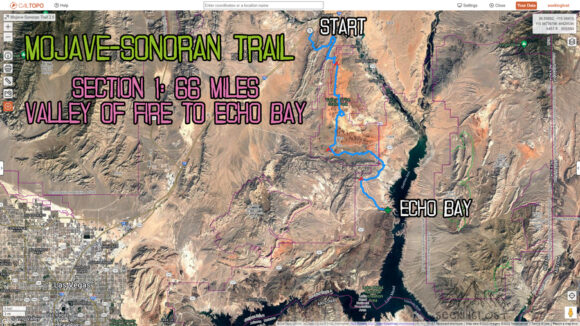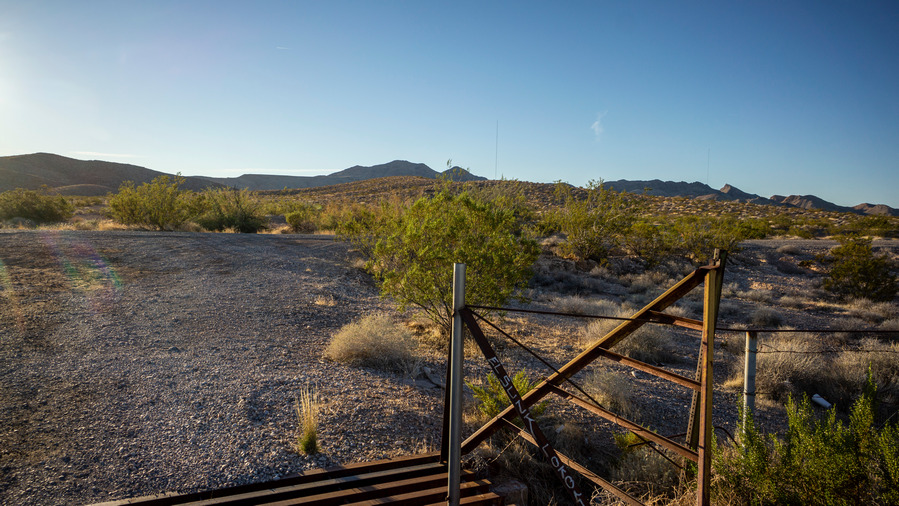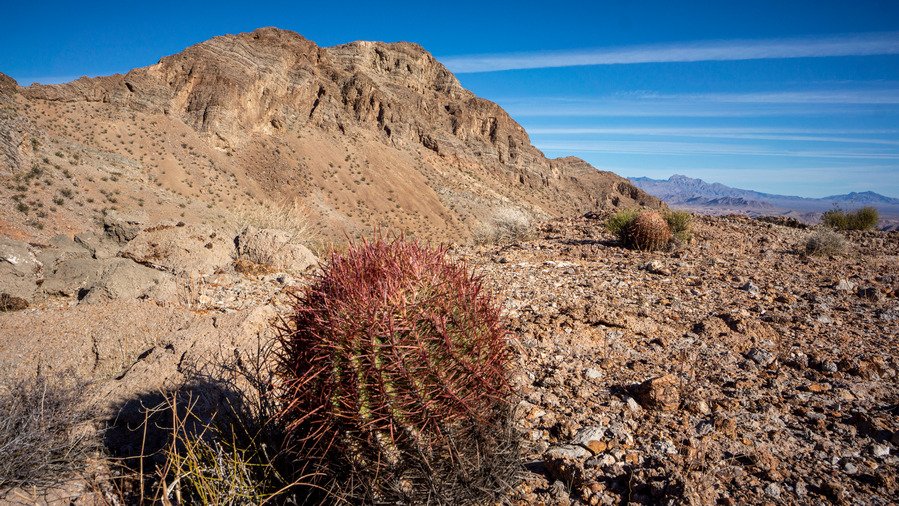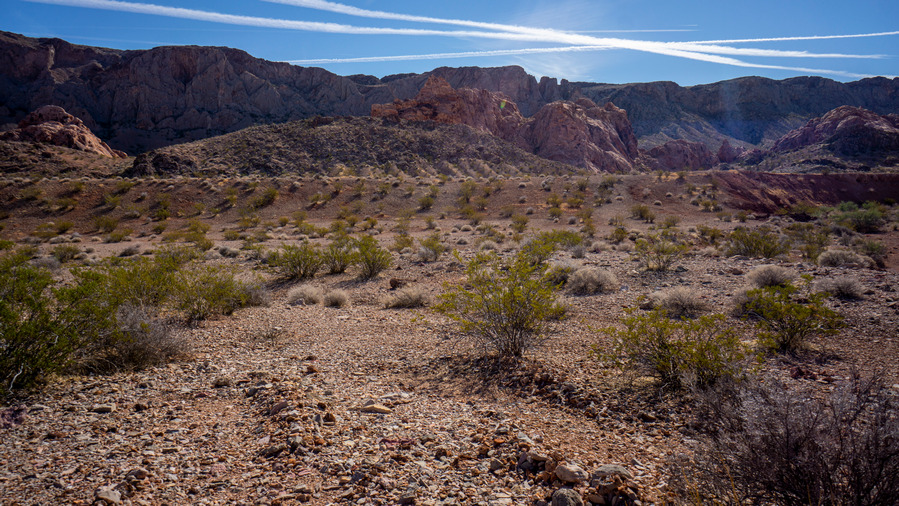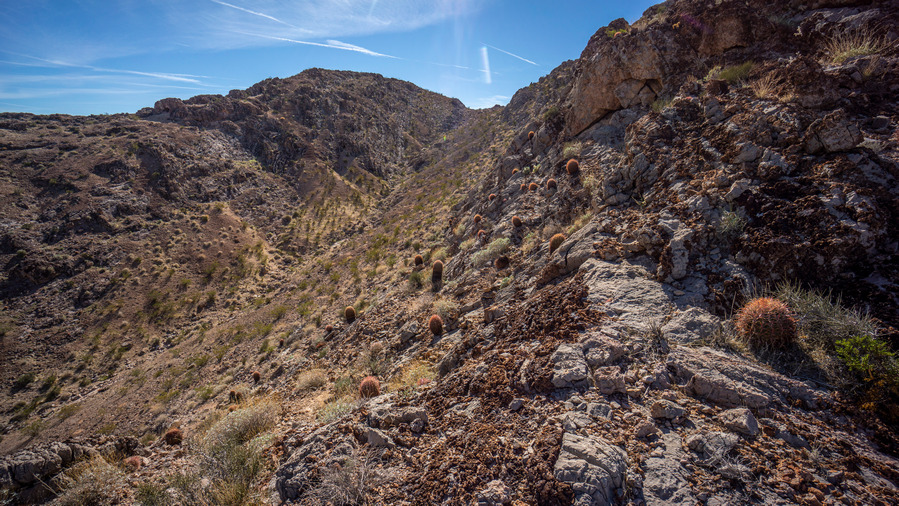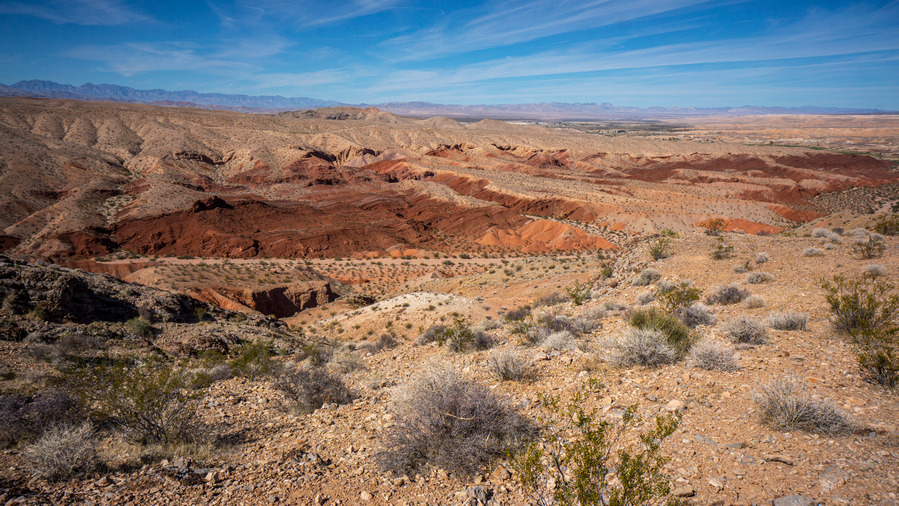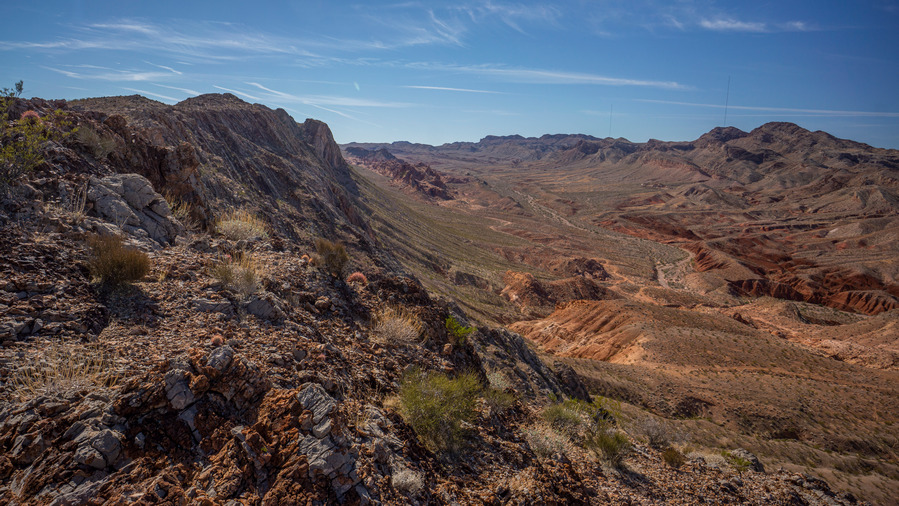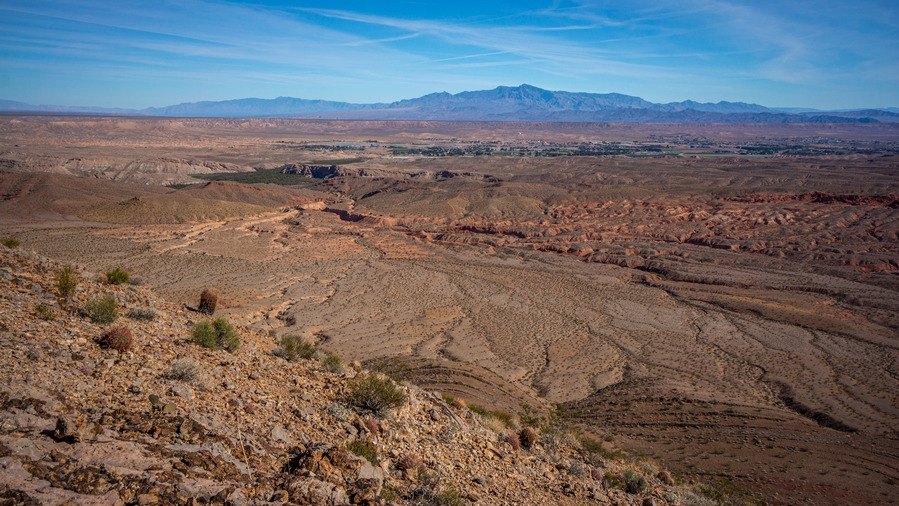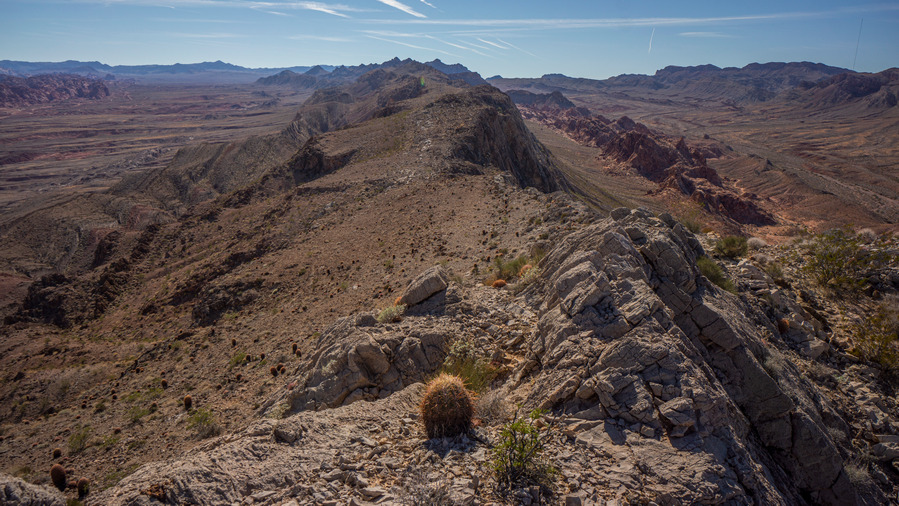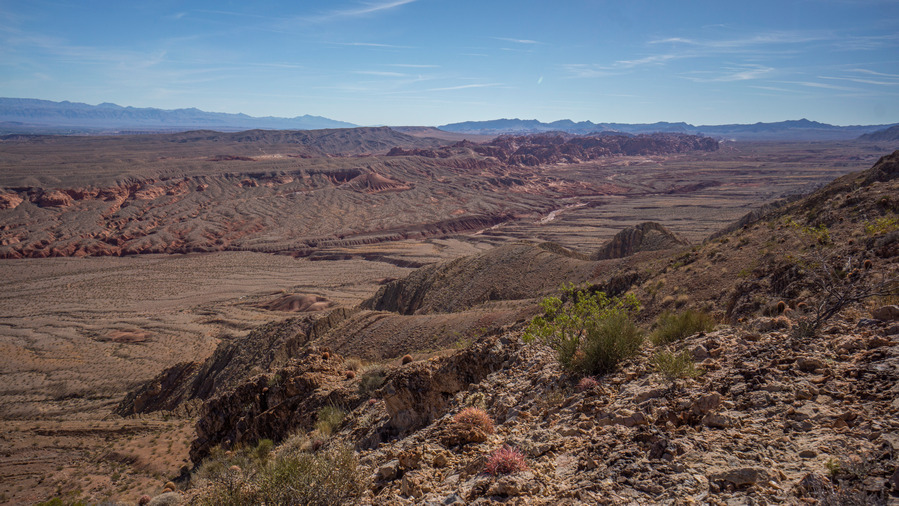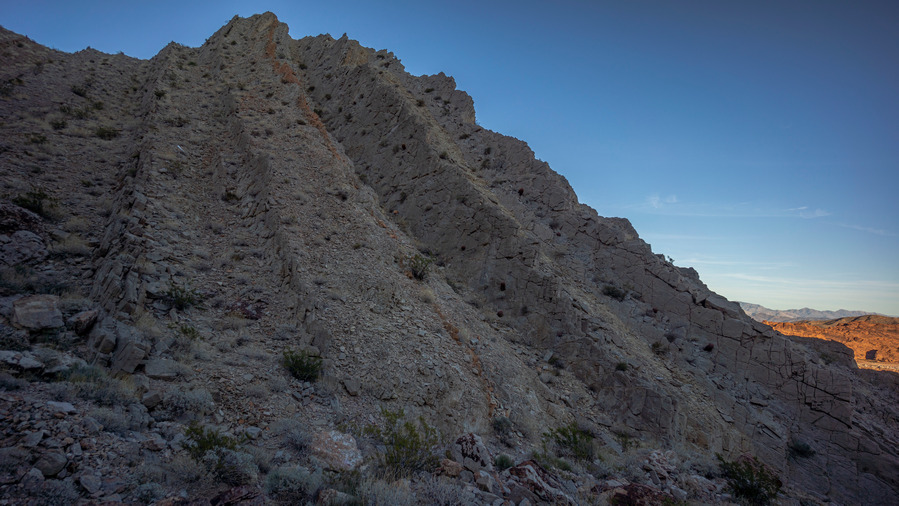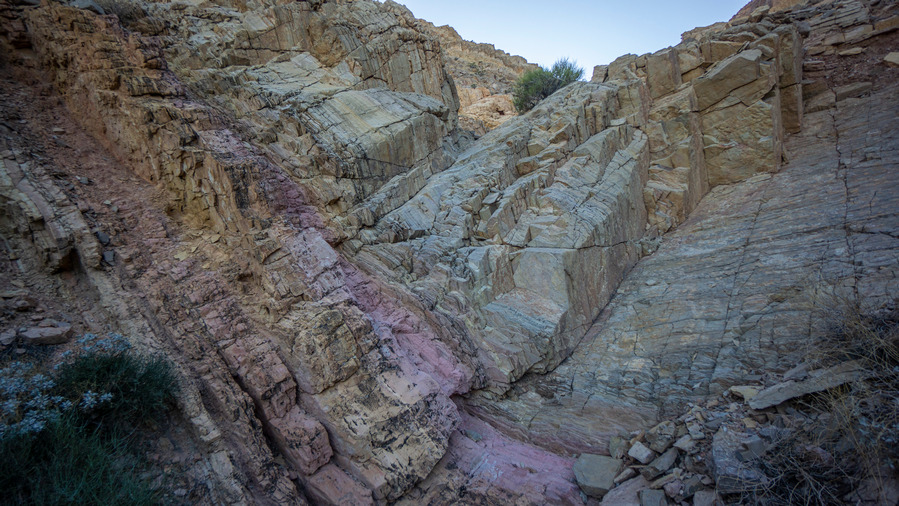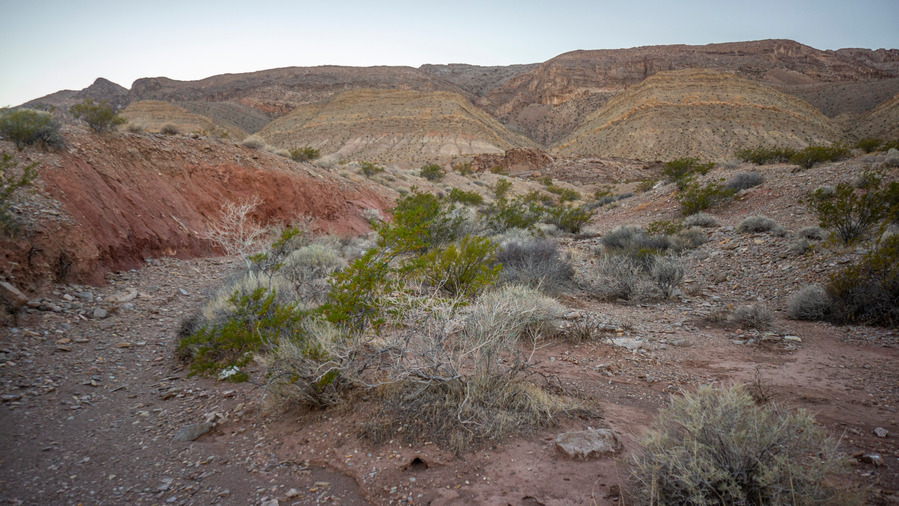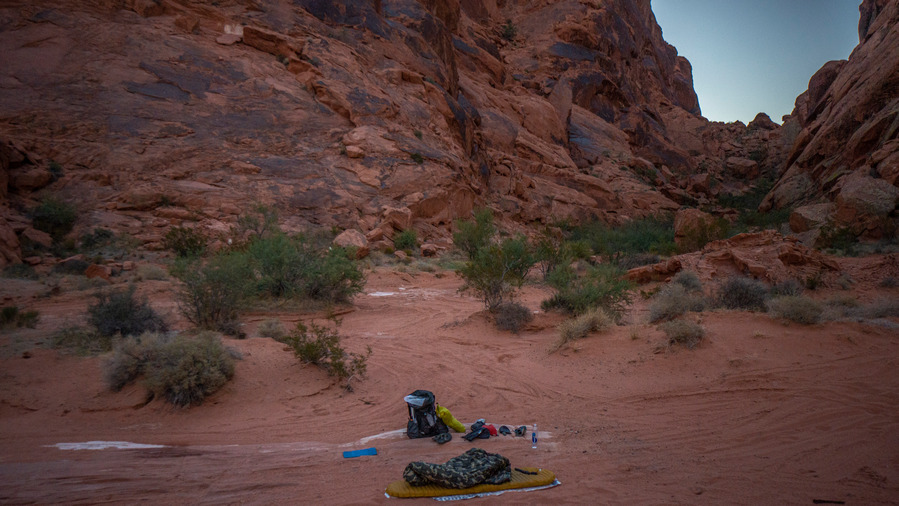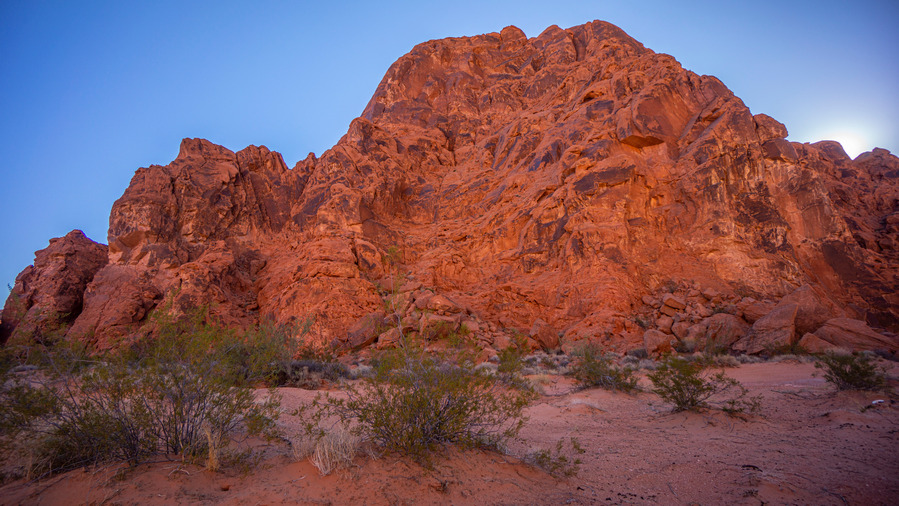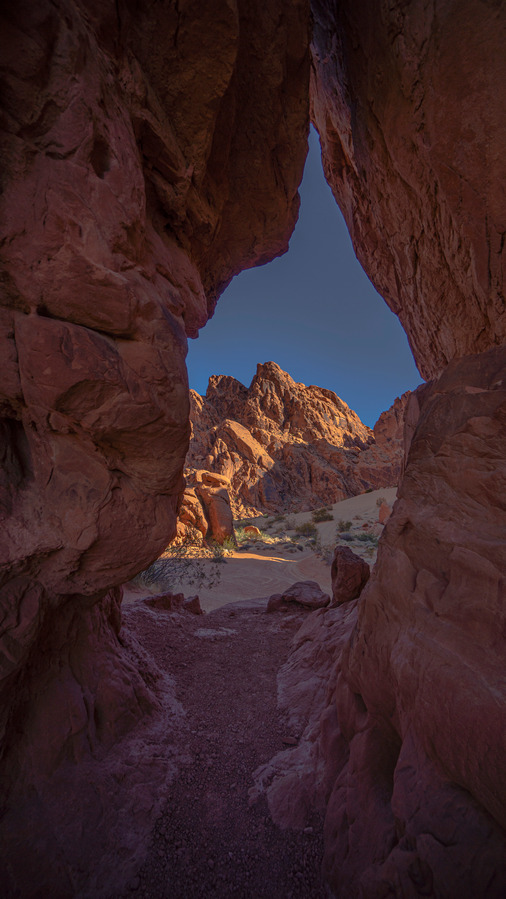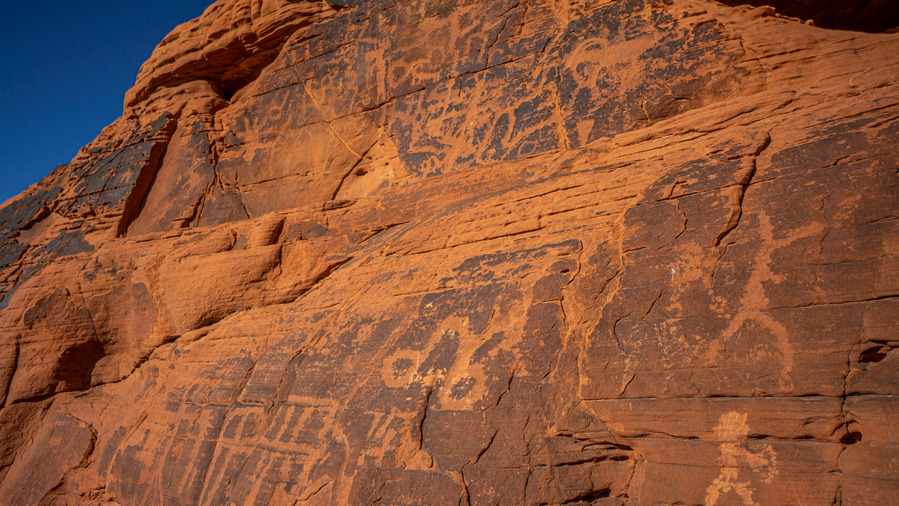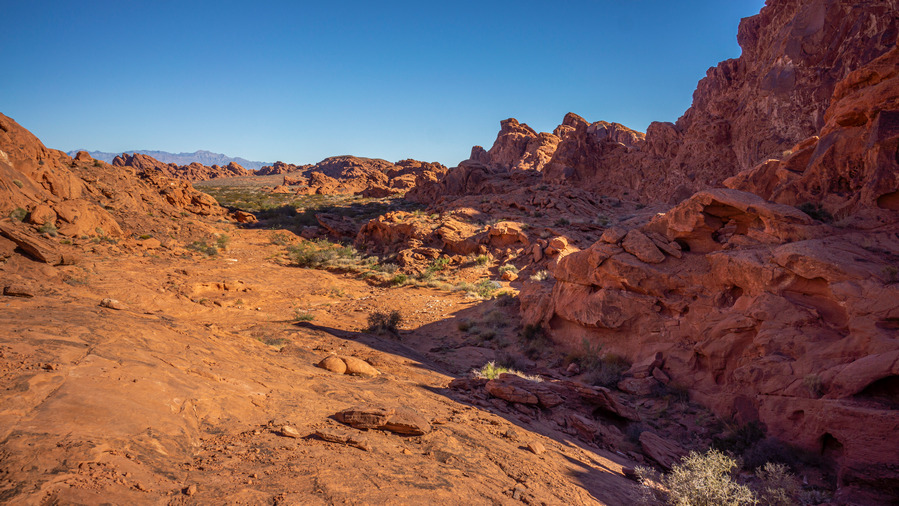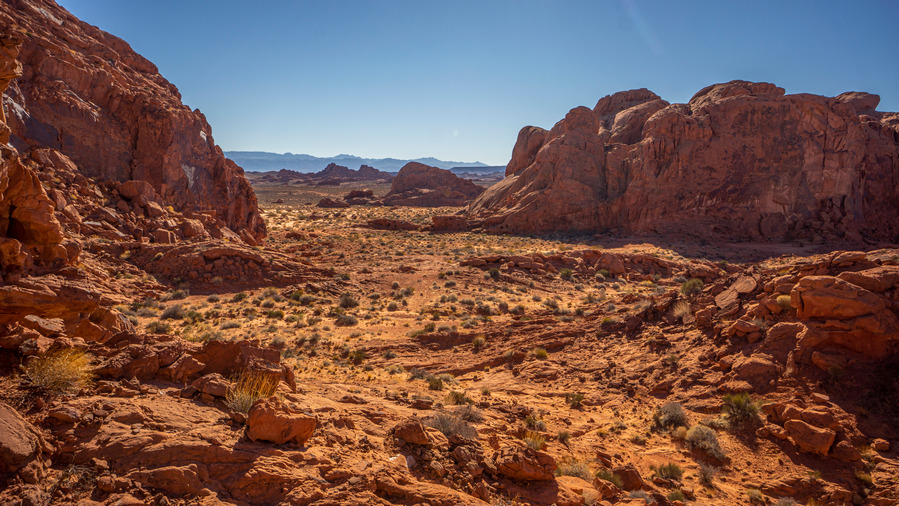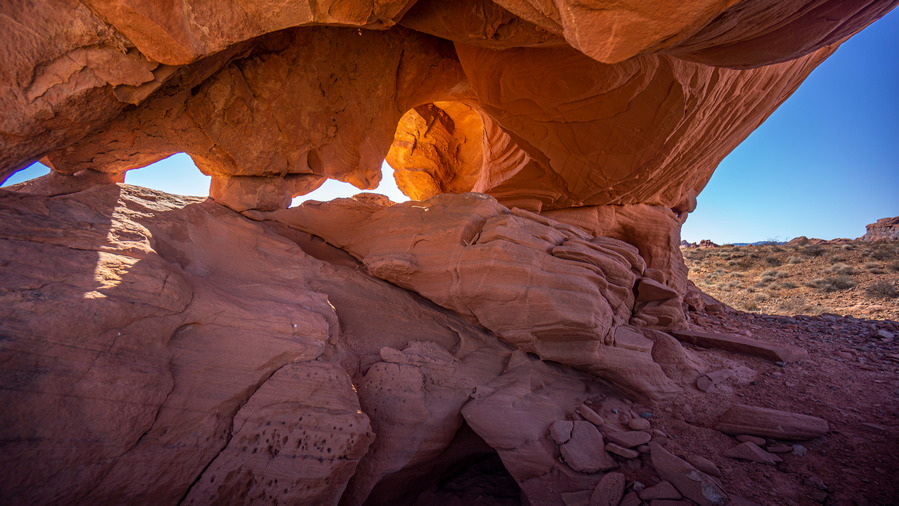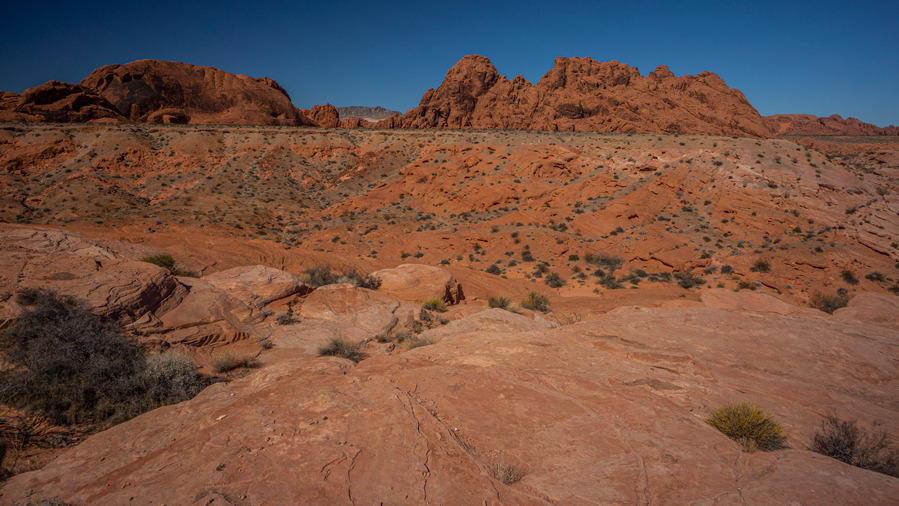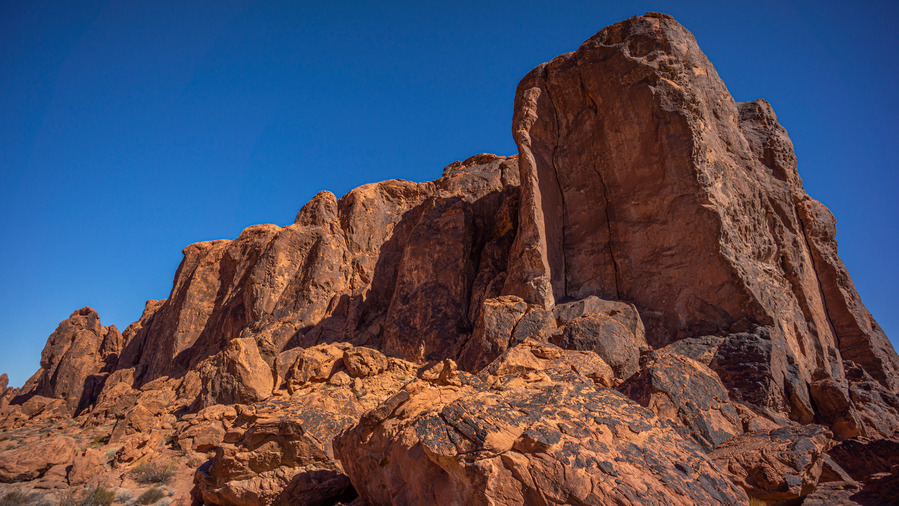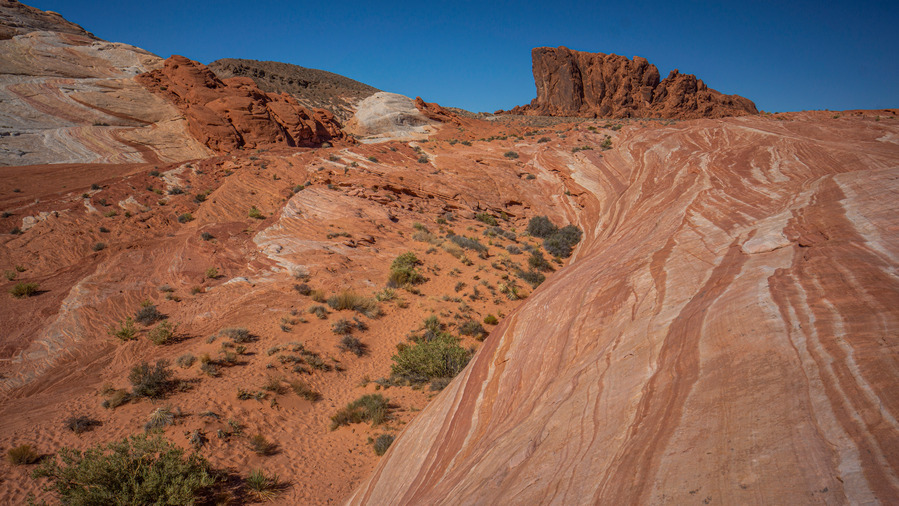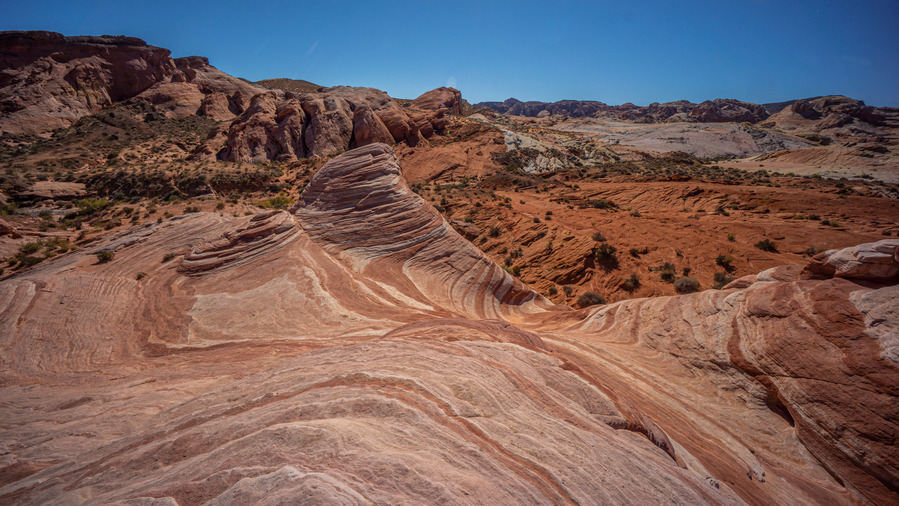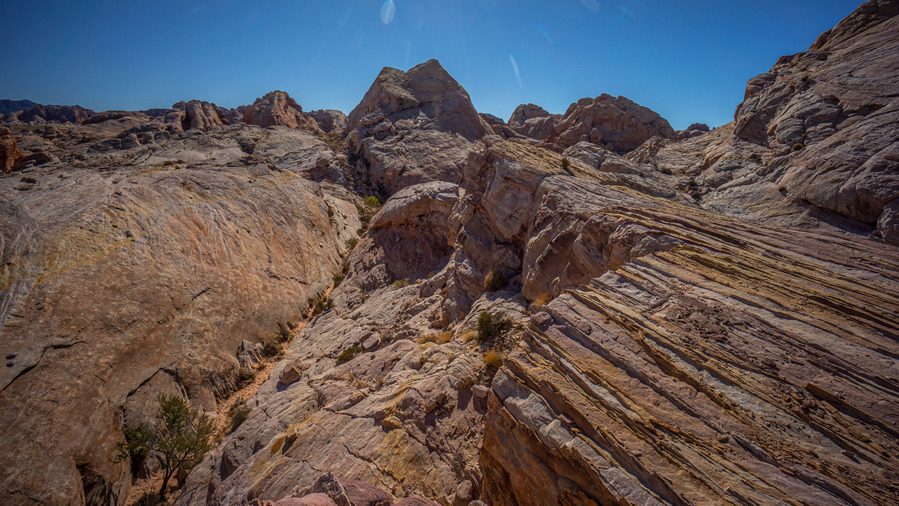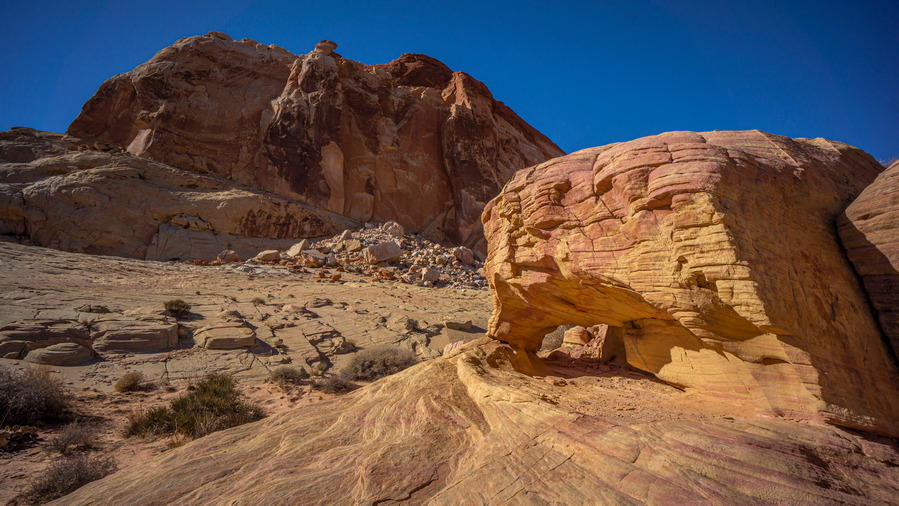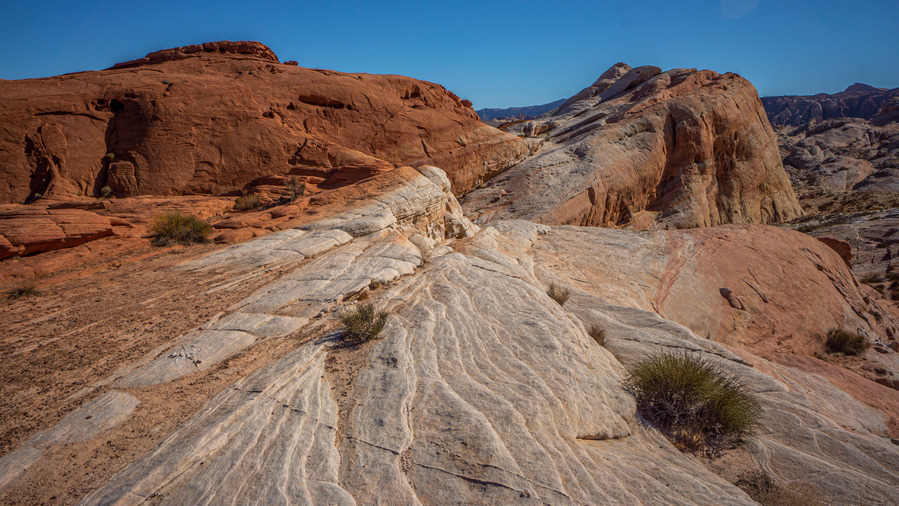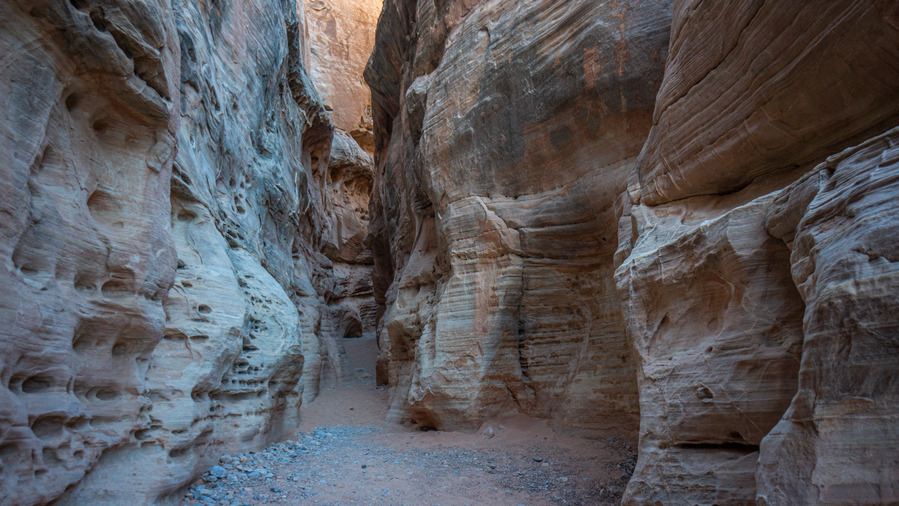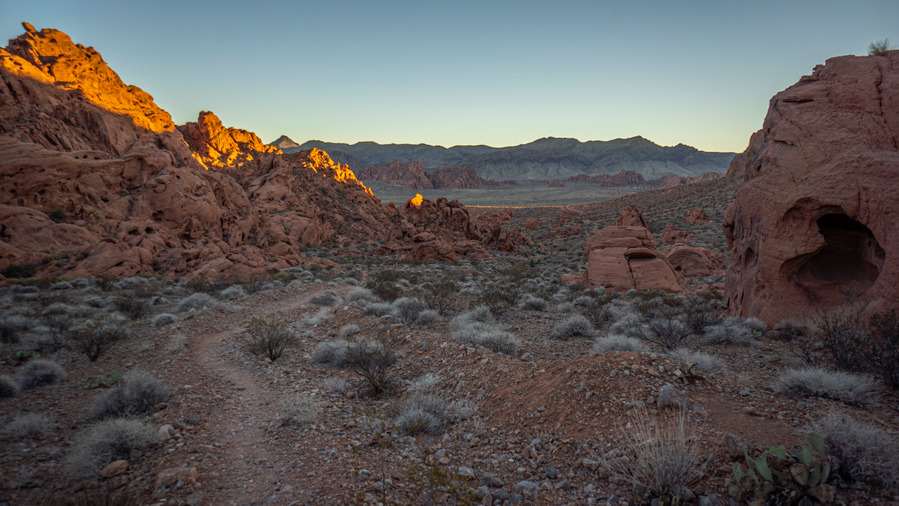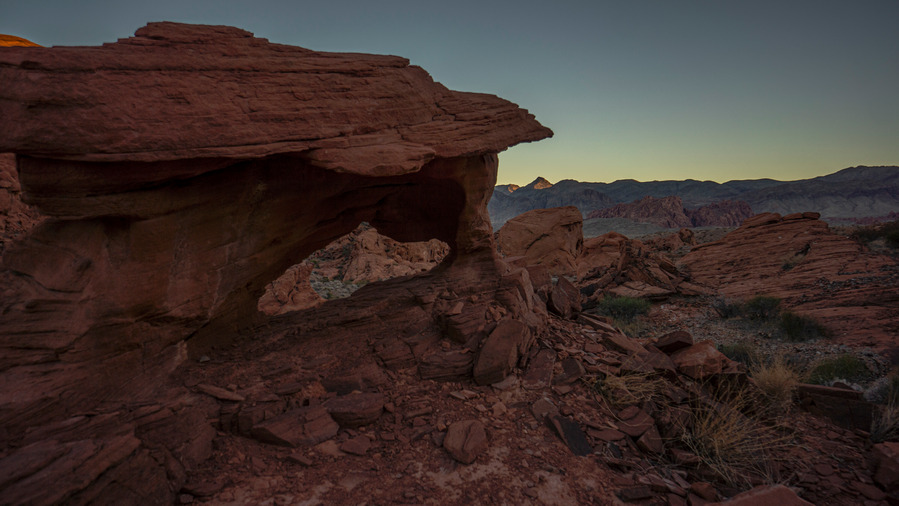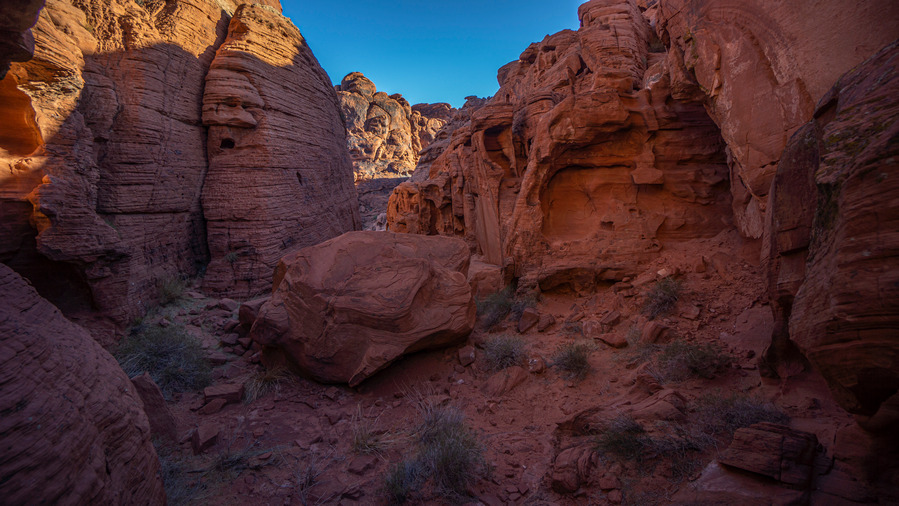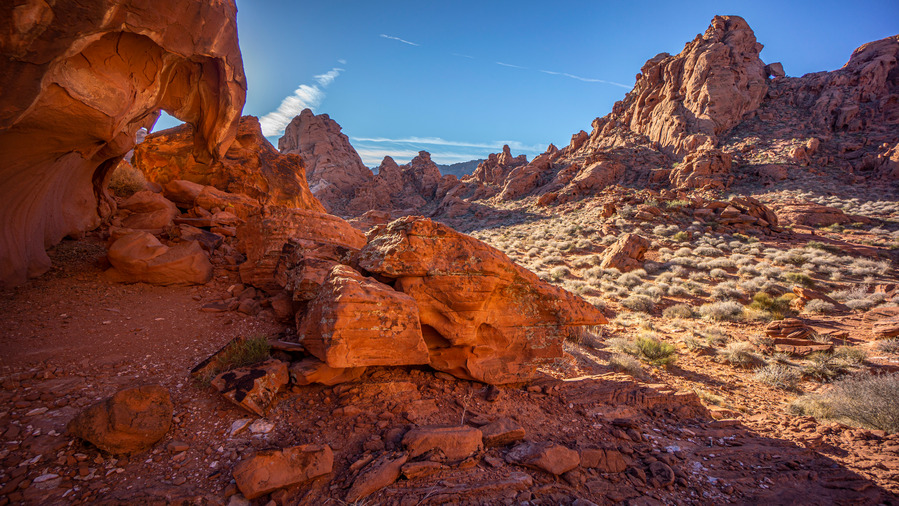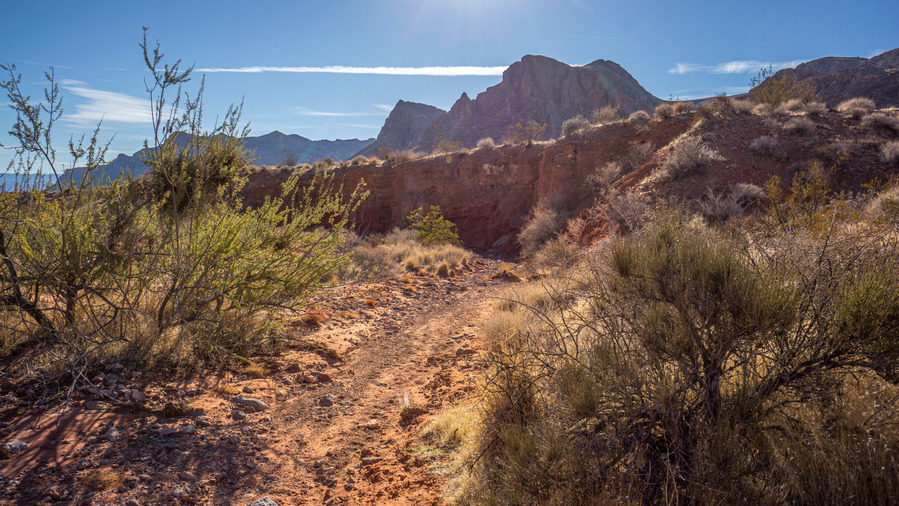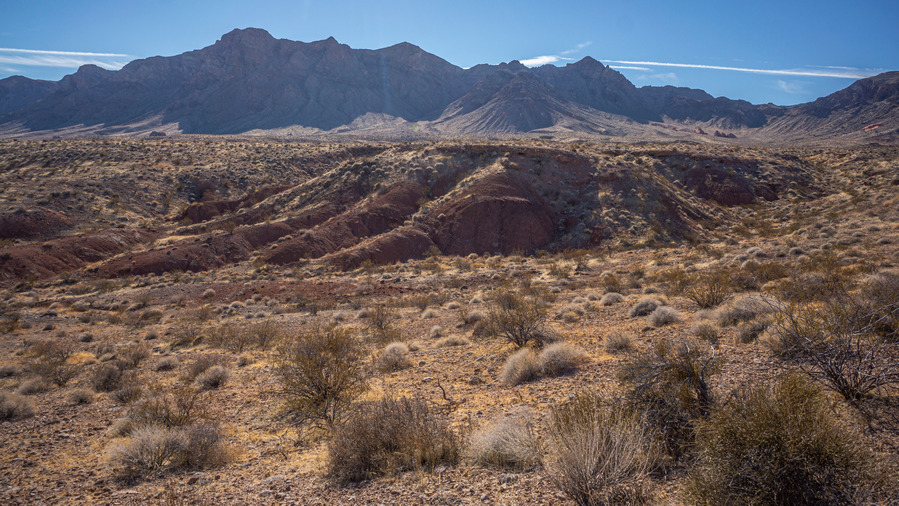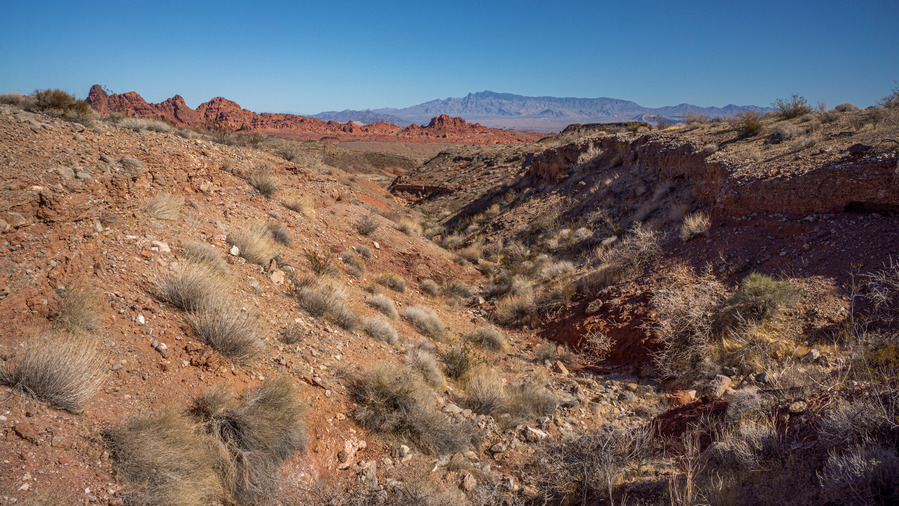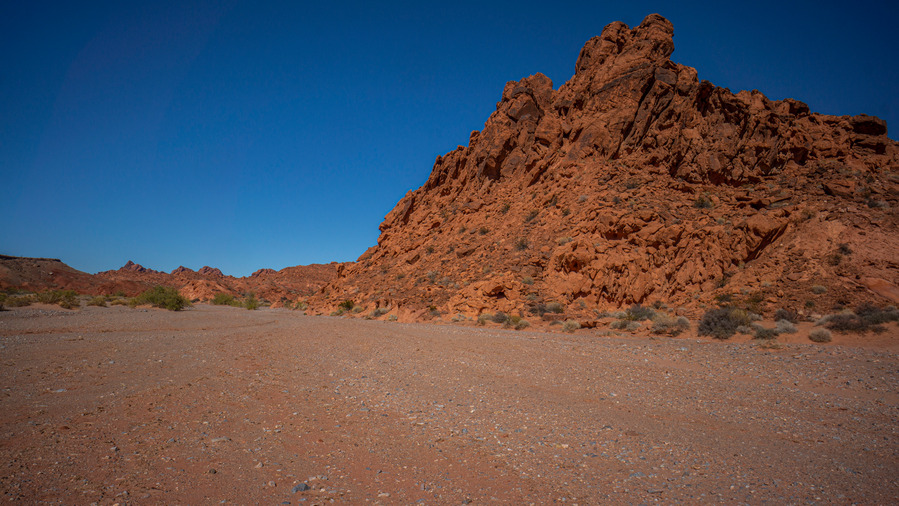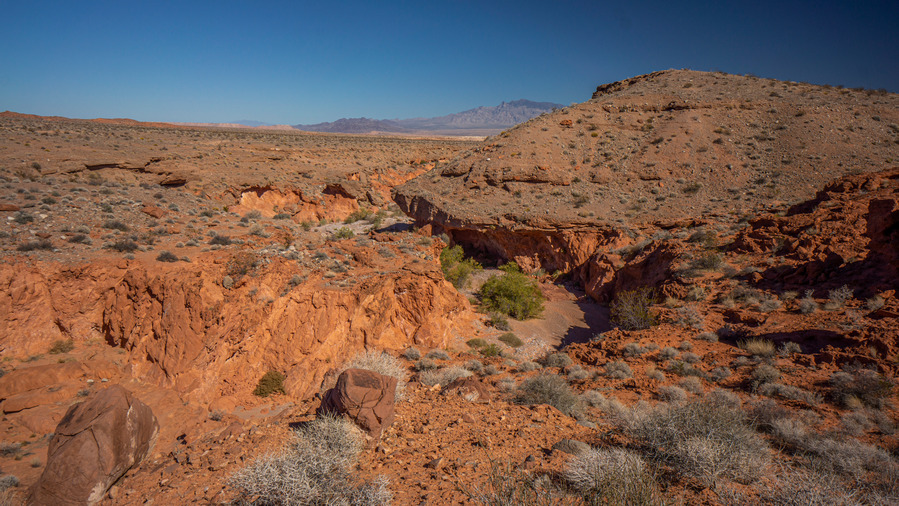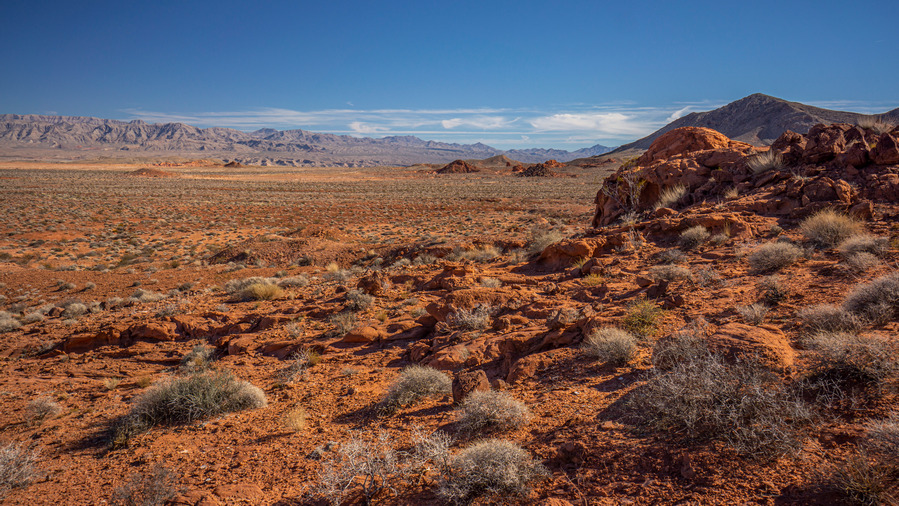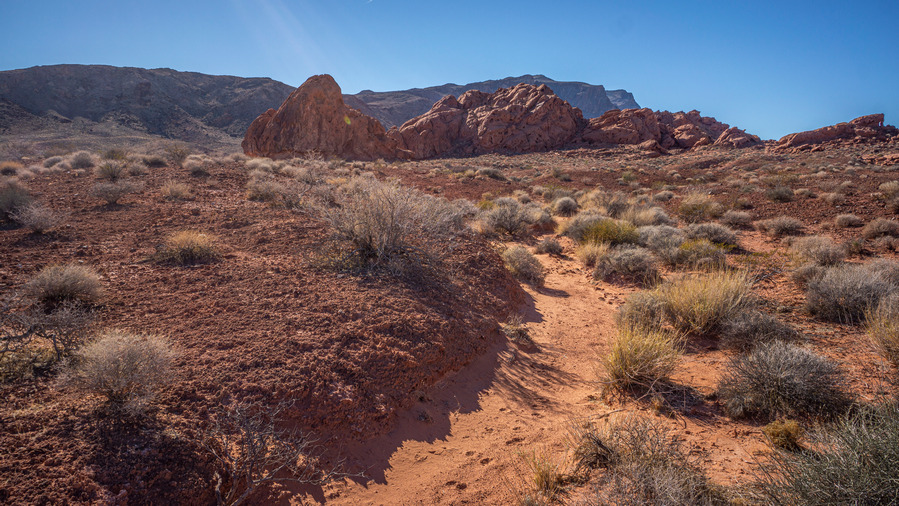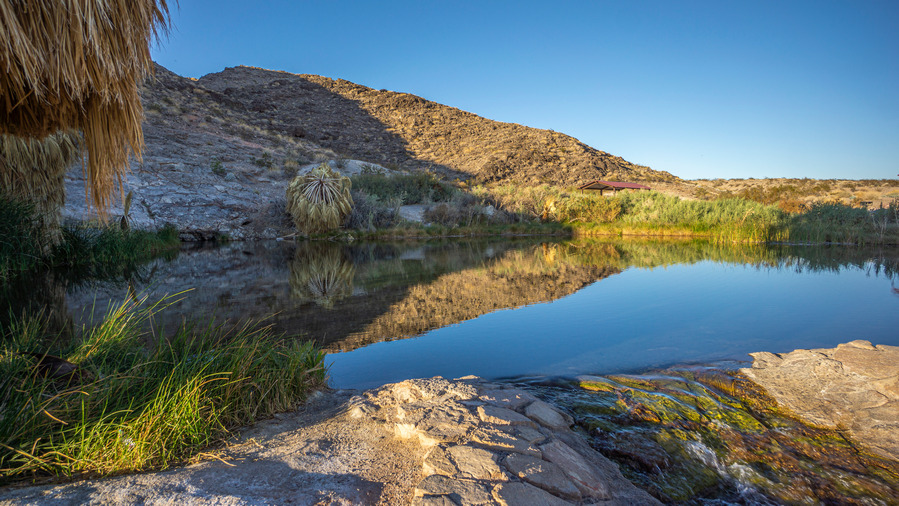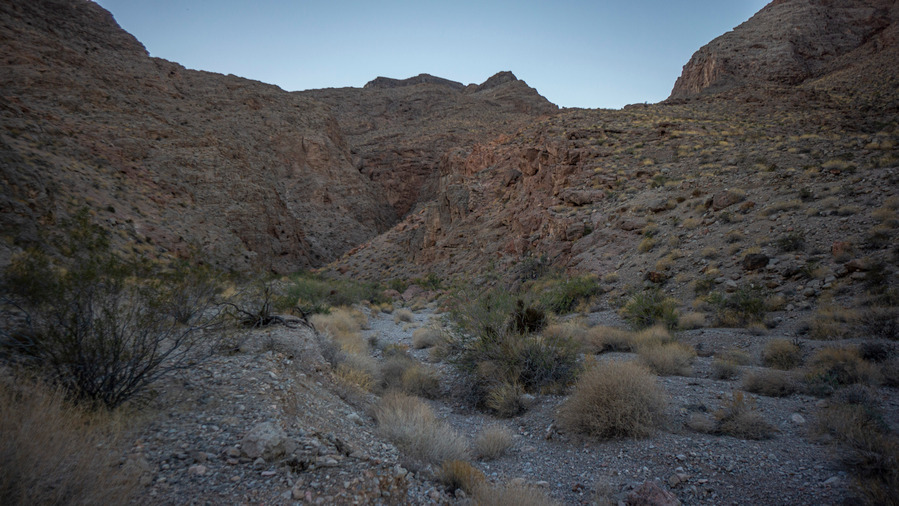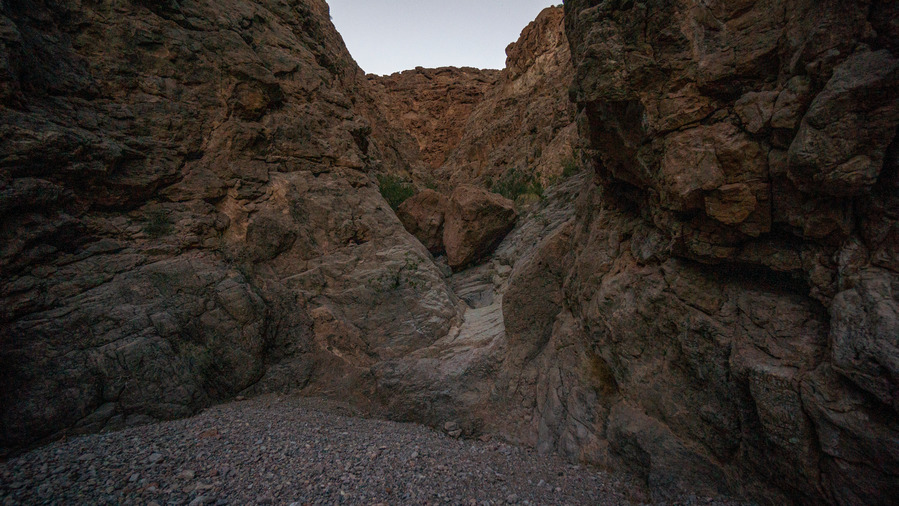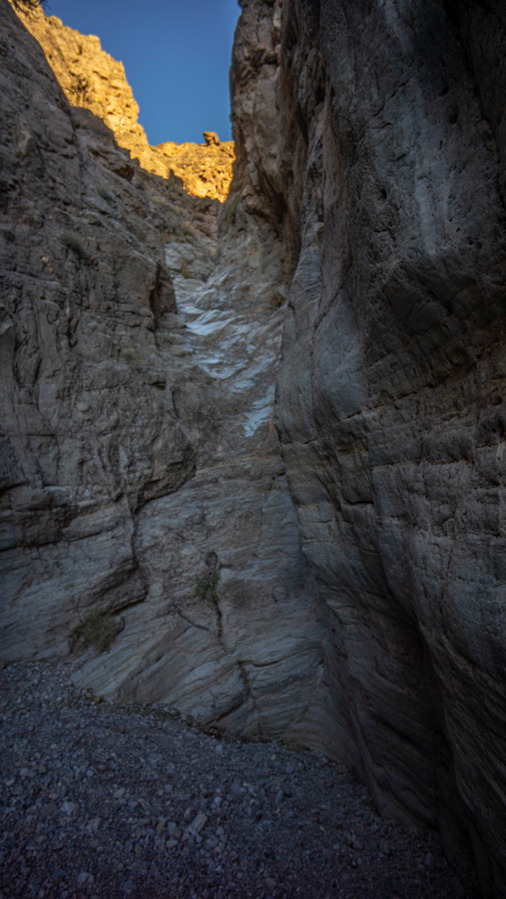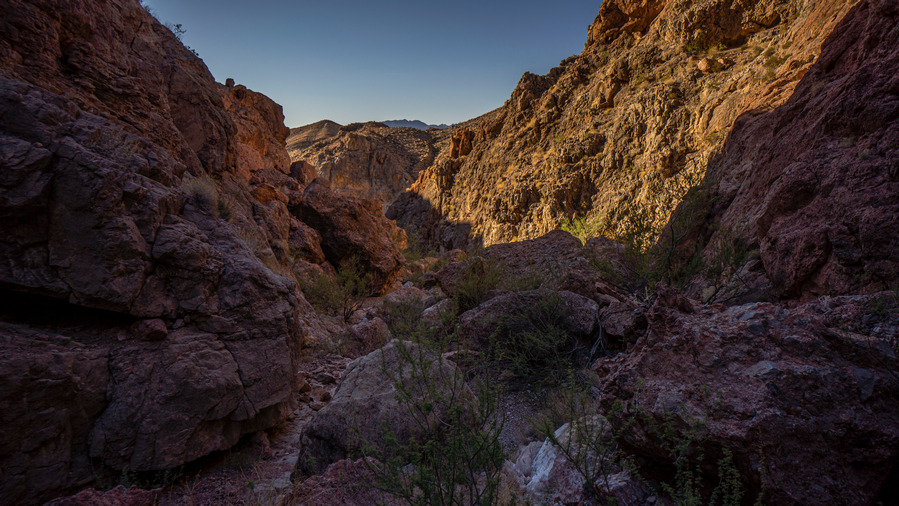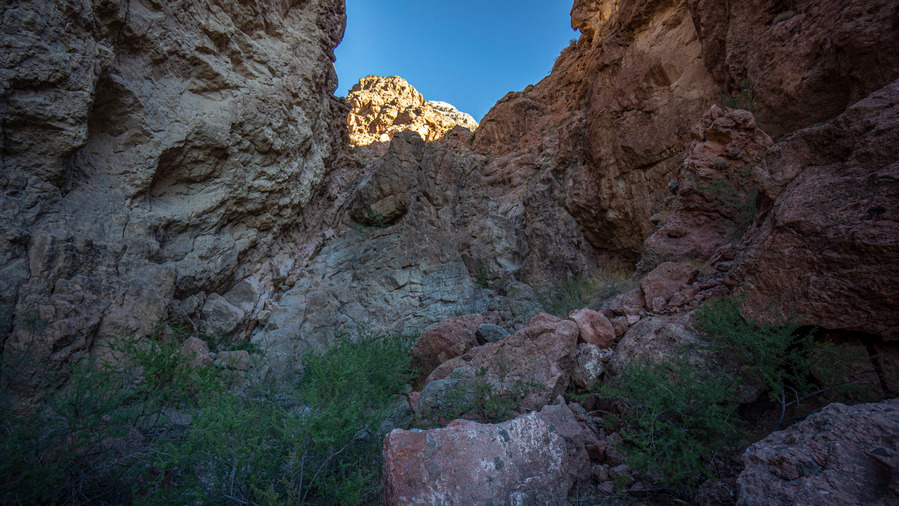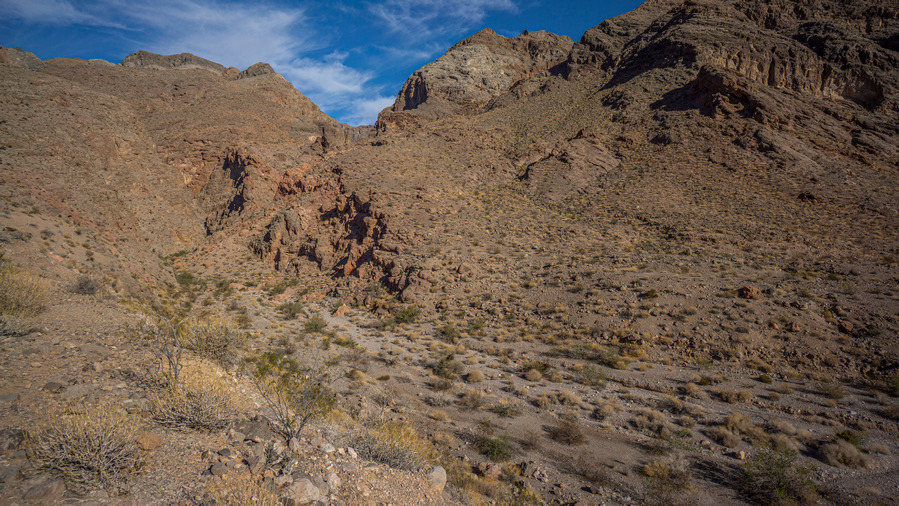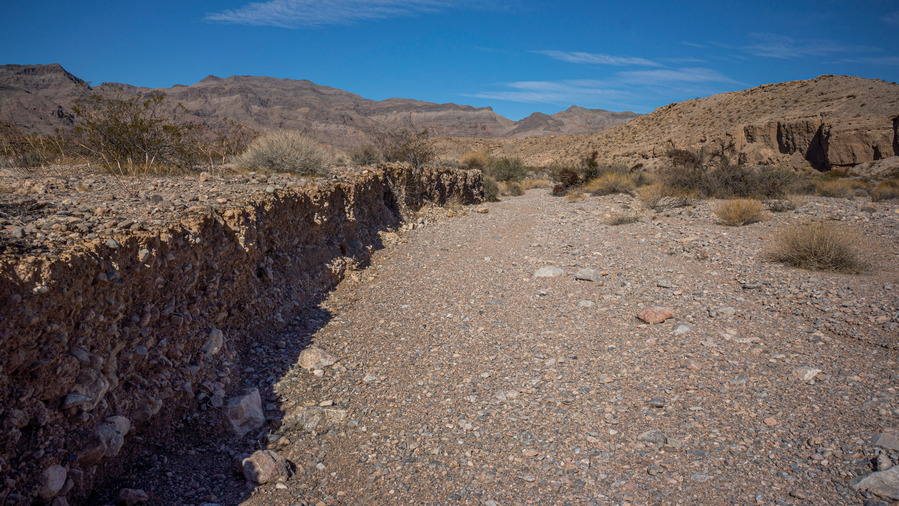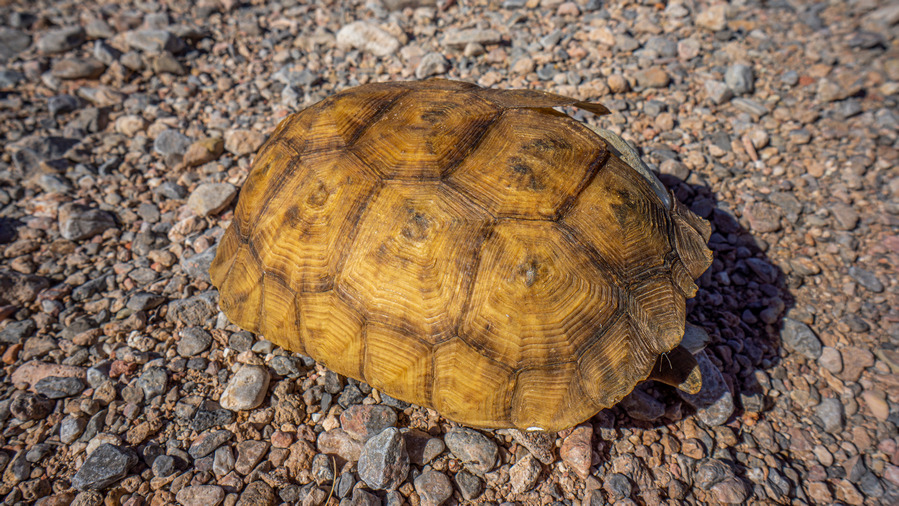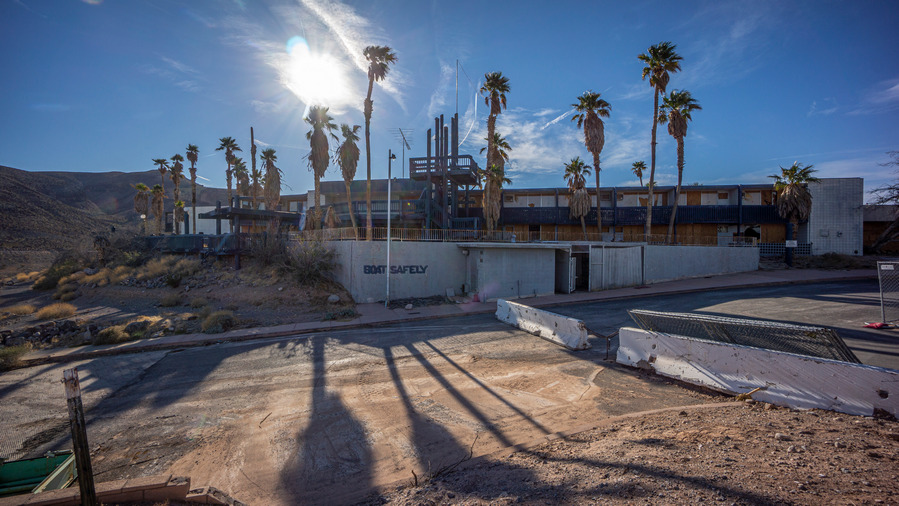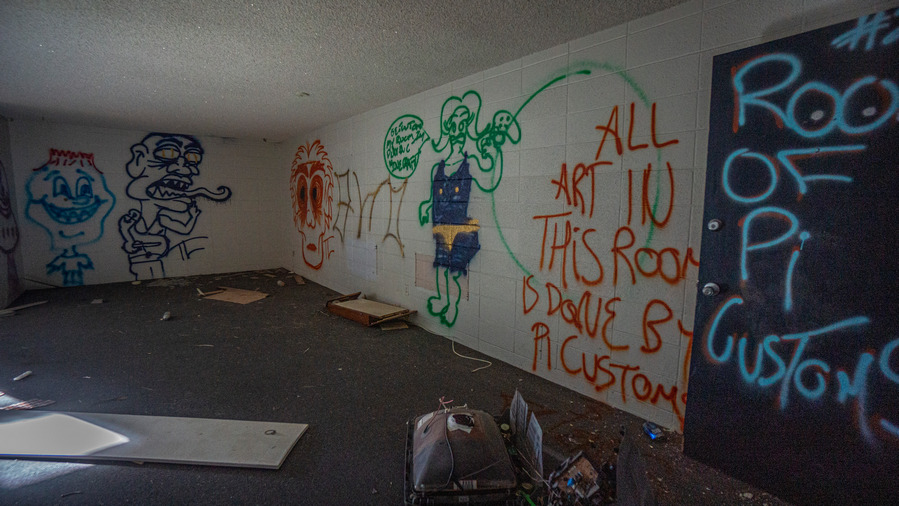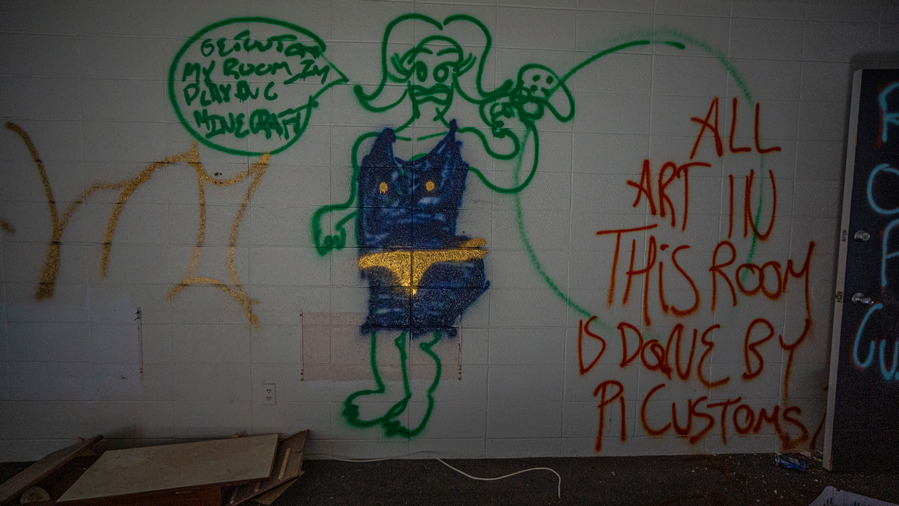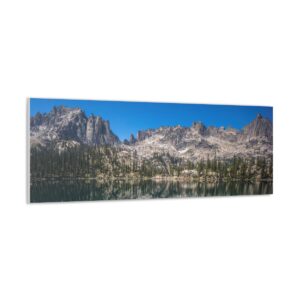Mojave-Sonoran Trail Sees Second Thru Hiker
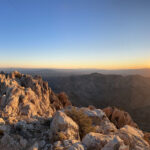
Congrats to Derek “Bear Magnet” Bowling for becoming the second person to hike the Mojave-Sonoran Trail! In January & February 2023, Bear Magnet hiked his own 360-mile version of the 625-mile MST, from Valley of Fire down to Lake Havasu, and then north back up to Laughlin, NV. While the MST still awaits it’s second finisher of the route’s entirety, this represents the largest chunk of the route that’s been hiked since I hiked it in 2021. Most importantly, this means more beta for YOU, the next Mojave-Sonoran Trail thru hiker!
Naturally, the more hikers who take on the Mojave-Sonoran Trail, the more refined this route will become. Fortunately, Bear Magnet was willing to share his experience on the route, along with his GPX file for comparison. For those of you considering hiking the MRT, you may be interested in reading his impressions of the route, notes etc.
The simplest way to pass Bear Magnet’s notes on to you is to share screenshots of our correspondence. Click on the images below for a larger and more readable version of the images:
The comment that stands out to me the most is this one:
I’ve been Thru Hiking a ton over the last 4 and a half years(over 11k) but this was the first one that felt like a true adventure!
More than anything else, this is one thing that I HOPED to hear as feedback from those who have, and will hike, this route. That’s why I created the Mojave-Sonoran Trail; to satisfy that craving for adventure, that many trails just lack. The best way to do this is to go to remote and beautiful places that few hike, plan something ambitious, and give it a shot. And of course, this is one of the only real options for a winter thru hike, for those seeking warm weather.
I was glad to hear from Bear Magnet and hear his impressions of the route. I was interested to hear what his favorite sections were, to see how the overlap with my own. And I was especially interested in what his least favorite section was. It sounds like it was the Warm Springs Wilderness area, which was insanely rocky and rather monotonous between Black Mesa and Lake Havasu Wilderness. This was one of my least favorite sections, as well. Coupled with some recent scouting trips to the area (from my camper van), I’ve been working on some alternate ideas to improve this section.
The Mojave-Sonoran Trail has so much potential, but could certainly benefit from being hiked a few more times, and along some variant routes to seek improvements. It would also be helpful to hear from more hikers like Bear Magnet as they take on this route. I’ve got some great plans for this route, but together with your help, I think the Mojave-Sonoran Trail can be truly incredible!
Read more about the MST: Mojave-Sonoran Trail Map & Guide
Mojave Sonoran Trail: A 625 Mile Thru-Hiking Route

The Mojave-Sonoran Trail
A 625-mile cross country thru-hiking route connecting southern Nevada to Southern Arizona via the Colorado River corridor
Introduction to the Mojave-Sonoran Trail
The Mojave-Sonoran Trail is a 625-mile cross country thru-hiking route along the Colorado River corridor though southern Nevada, California and Arizona. The MST traverses two distinct desert environments; the 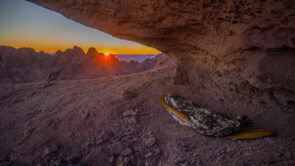 Mojave Desert and Sonoran Desert. This route allows the hiker to experience the transition zone from Mojave to Sonoran desert, while connecting 12 mountain ranges, 12 wilderness areas, 2 National Wildlife Refuges and the massive Lake Mead National Recreation Area in an effort to explore this remote and stunningly beautiful region. Experienced cross-country thru hikers looking for a challenging desert hike that can be done in the winter months will find the Mojave-Sonoran Trail fits the bill, with prime hiking season running from November to March.
Mojave Desert and Sonoran Desert. This route allows the hiker to experience the transition zone from Mojave to Sonoran desert, while connecting 12 mountain ranges, 12 wilderness areas, 2 National Wildlife Refuges and the massive Lake Mead National Recreation Area in an effort to explore this remote and stunningly beautiful region. Experienced cross-country thru hikers looking for a challenging desert hike that can be done in the winter months will find the Mojave-Sonoran Trail fits the bill, with prime hiking season running from November to March.
This region of the country doesn’t get much attention from the backpacking community, but Mojave-Sonoran Trail hikers will quickly discover that they’ve stumbled upon a
hidden gem. Walk the top of massive mesas, the bottom of colorful slot canyons, along the shores of Lake Mead and across vast desert plains. Summit lonely desert peaks, walk among red rocks and sand dunes, through deep canyons and gorges, climb dry waterfalls and walk countless ridges overlooking fairytale-like desert landscapes. Explore old mines, tunnels and caves, find cool rock and minerals, visit hot springs and ghost towns, sleep in old cabins, discover petroglyphs and artifacts. The Mojave-Sonoran Trail route presented here can be hiked as-is, or better yet, used as a blueprint for your own Mojave/Sonoran Desert trek.
Quick Facts
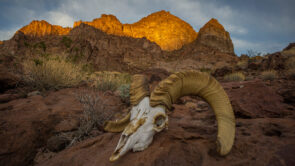
Miles: 625
Seasonality: Nov – Mar
Time to Complete: 5-7 weeks
Highest Point: Spirit Mountain, NV: 5,642′
Lowest Point: Parker Dam, AZ/CA Border: 392′
Mountain Ranges: 12
Wilderness Areas: 12
Trail Journal/Photos & Video Series
Mojave-Sonoran Trail Journals & Photos
Section 1 – Valley of Fire to Echo Bay: 66 Miles
Section 2 – Echo Bay to Callville Bay: 50 Miles
Section 3 – Callville Bay to Boulder City: 40 Miles
Section 4 – Boulder City to Searchlight: 80 Miles
Section 5 – Searchlight to Bullhead City: 58 Miles
Section 6 – Bullhead City to Lake Havasu: 104 Miles
Section 7 – Lake Havasu to Bouse: 92 Miles
Section 8 – Bouse to Quartzsite: 37 Miles
Section 9 – Quartzsite to Kofa: 95 Miles
Join the Mojave-Sonoran Trail facebook group to stay on top of the latest updates and info on the trail, as well as connect with other potential MST hikers.
Type of Hiking
The Mojave Sonoran Trail is a cross country route, not an actual hiking trail. Only about 16 miles of my route was on a hiking trail. The rest was cross country, old two track roads and less frequently, larger dirt roads  and paved roads (minimal). Roughly 40% of the route is cross country (still need to calculate exact numbers). This is a desert route, with elevations ranging from 300-5,600ft. In the Mojave Desert, there is less vegetation to contend with when hiking off-trail. The Sonoran Desert is thicker, thornier and bushier. Occasional bushwhacking is needed, but nothing extensive or daunting. While the emphasis on ridge walks, high routes and peak bagging is always high, this route is also heavily geared towards exploring scenic canyons. In both the Mojave and Sonoran deserts, spectacular deep and colorful canyons are plentiful, and are a main draw to this route. Dry waterfalls are extremely common, and there are perhaps hundreds to negotiate along the way of varying difficulty. No technical gear is needed, although a length of cord to lower your pack when downclimbing is highly recommended. Distance between resupply is 100 miles or less. Big water carries are common.
and paved roads (minimal). Roughly 40% of the route is cross country (still need to calculate exact numbers). This is a desert route, with elevations ranging from 300-5,600ft. In the Mojave Desert, there is less vegetation to contend with when hiking off-trail. The Sonoran Desert is thicker, thornier and bushier. Occasional bushwhacking is needed, but nothing extensive or daunting. While the emphasis on ridge walks, high routes and peak bagging is always high, this route is also heavily geared towards exploring scenic canyons. In both the Mojave and Sonoran deserts, spectacular deep and colorful canyons are plentiful, and are a main draw to this route. Dry waterfalls are extremely common, and there are perhaps hundreds to negotiate along the way of varying difficulty. No technical gear is needed, although a length of cord to lower your pack when downclimbing is highly recommended. Distance between resupply is 100 miles or less. Big water carries are common.
Route Overview
The Mojave-Sonoran Trail is a 600 mile cross country thru-hiking route that traverses the Colorado River corridor though southern Nevada, California and Arizona. In this region of the country, the Colorado River ROUGHLY represents the border between the Mojave and Sonoran deserts. While the route begins in the Mojave desert, and ends in the Sonoran desert, the route often meanders through the transition zone between the two different desert environments, before finishing deep within the Sonoran Desert.
country, the Colorado River ROUGHLY represents the border between the Mojave and Sonoran deserts. While the route begins in the Mojave desert, and ends in the Sonoran desert, the route often meanders through the transition zone between the two different desert environments, before finishing deep within the Sonoran Desert.
The route is mostly cross-country hiking and along old 4×4 roads, with only a few miles of marked hiking trails along the entire route. The route follows the general path of the Colorado River, but seldom does it reach the banks of the river itself. Instead, the route traverses the mountain ranges alongside the Colorado River, with open desert treks connecting these ranges as needed.
Terminus Points
The northern terminus is just outside of Valley of Fire State Park in southern Nevada, about 1 hour east of Las Vegas. The southern terminus is Palm Canyon in the Kofa Wilderness of Arizona, about 1 hour north of Yuma.
Travel to the northern terminus is easy. Fly into Las Vegas, grab an uber to the Hidden Valley exit along I-15, about 45 minutes east of Las Vegas. There’s not much here, but it makes for a short route to some excellent Day 1 hiking along the spectacular Weiser Ridge, overlooking Valley of Fire State Park.
Travel to/from the southern terminus is slightly more challenging. There is ample traffic at Palm Canyon/HWY 95 to hitch south to Yuma, where one can take a plane/train/bus to your final destination. Shuttle service is also available. Call Terri at 951-390-5818 (Faithful Shuttle) to inquire about rates.
Mojave-Sonoran Trail Terminus Point GPS Locations
Northern Terminus: 36°38’10”, -114°35’54”
Southern Terminus: 33°23’19”, -114°13’01”
Pace & Time on Trail
The MST is an off-trail route. Miles can be very slow at times. Additionally, there is limited daylight during the late fall and winter months, which cut into the time a hiker has to cover miles. I averaged 18 MPD, but I also spend about an hour a day filming and taking photos, recording waypoints, documenting water sources, exploring old mines etc. Strong hikers with solid cross-country experience should be able to get 20 MPD or more. Be prepared to be humbled by the occasional 12 mile day, though. I completed the route in 7 weeks, with 9 zero days. 6 weeks would be a good time frame for many hikers to shoot for.
Seasonality
The Mojave-Sonoran Trail is one of the few long distance hiking routes that can provide the hiker a warm climate to hike in the winter months. The MST is not a summer hike, the temperatures are simply too hot. The best time to hike the MST would be between November and March. Choose your state date depending on your tolerance for hot/cold temps.
are simply too hot. The best time to hike the MST would be between November and March. Choose your state date depending on your tolerance for hot/cold temps.
This hike could easily be done in the dead of winter. Water should be more plentiful than the fall. Mild to warm daytime temps, colder nights, and the possibility of a little snow once or twice at the higher elevations (4,000+). These storms generally move through quickly and are not prolonged. The vast majority of a winter hike along this route should see excellent hiking weather.
I hiked this route from Nov 1st – Dec 18th. It was an unusually warm and dry fall in 2021. Temps reached 90 in the Vegas area during the first few days, 80s for the first two weeks or so of November, then mostly 70ish for the duration of the route. Overnight lows were generally no lower than 45 for the majority of the trip, until the last week when the weather finally turned. My coldest night was 21.
Direction of Travel
The MST could be hiked in either direction, NOBO or SOBO. Your start date will have the biggest influence on your direction of travel. Starting Nov 1st, I chose to hike SOBO. This allowed me to have the coolest possible temps for the given time of year, by starting in the north where temps are about 8 degrees cooler on average than the southern terminus. As I travel south, the temps will increase, but they are also declining at this time of year as winter approaches. This allowed me to maintain a pretty consistent climate of 70 degrees or so for the majority of the hike. The opposite would be true starting late winter, closer to spring might consider hiking NOBO to follow the weather.
Those seeking the coolest possible temps will want to hike in December and January. Jan-Feb would be the more realistic time frame for most winter hikers (starting after the holidays), and this would still be a good time to avoid the heat. NOBO makes more sense here as the southern terminus is 12 degrees warmer than the northern terminus during the winter months.
From here on out, the information presented in this guide will be from a SOBO perspective, because that’s how I hiked it 🙂
Route Origins
Until recently, thru hikers seeking a trail or route that could be hiked in the winter months and feature warm weather/no snow had few options. Over the last few years, Brett Tucker has been developing the Desert Winter Thru Hiking Route to fill that void. And it looks like an excellent route that I myself am looking forward to walking someday in the near future. The Mojave-Sonoran Trail is my attempt at the same idea; a warm-weather winter thru hiking route in the southwest.
I got the idea for the general path of the route one day by looking at an elevation heat map of the United States. I noticed the lower elevation along the Colorado River corridor extending as far north as St. George, UT and all the way down to Mexico. Having hiked in the Las Vegas area before, I was familiar with its beauty and ruggedness, and surprised by its remoteness. However, I hadn’t spent much time exploring south of Vegas yet, along the Colorado River. There are practically zero backpacking reports from this part of the country, but the occasional peak bagger’s report gave a glimpse at the potential of the ranges that run alongside the Colorado River. Impressive, indeed. The climate fit my requirements, the terrain looks to be beautiful, and the region is lightly traveled. After mapping the most interesting route I could string together and plotting water sources, it all came together to become the route I present here; the Mojave-Sonoran Trail.
Mojave-Sonoran Trail Map
The Mojave-Sonoran Trail map is the main planning resource. Here, nearly everything you need to know about hiking the MST is presented in the map. Unfortunately, when linking to the map, the default view has all of the waypoint labels visible on the map, making it too cluttered to really view. You can download your own copy to work with. Read on to learn more.
How to use the Mojave-Sonoran Trail Map
To ensure you have the most up-to-date version of the map, view the Mojave Sonoran Trail Map in Caltopo and click “export” to download your own copy. Export the GPX format to use in a garmin device or on your phone, but if you plan on editing your own copy of the MST map, I recommend exporting the map in the JSON format. This retains all of the waypoint info that is useful… color-coding of water sources, different icons for campsites, water caches etc, different track colors for the main route vs alternate routes, and more. Next, upload your JSON (or GPX) file to caltopo (or Gaia, etc) and edit away! You can later export a GPX file from caltopo for your device when ready.
You can also download the Mojave Sonoran Trail GPX file. However, keep in mind that the GPX file here will not be as up-to-date as visiting the caltopo link above and exporting your own copy. Changes made to the Mojave-Sonoran Trail caltopo map will instantly be pushed out to anyone visiting the caltopo link. Updating a downloadable GPX file (like the one above) requires manually replacing the GPX file every time a small change is made, and that is not an efficient way to bring you the latest updates.
Here’s a breakdown of the caltopo map “categories” to help you make sense of the information presented on the map:
- MST 2.0 – This is the current suggested MST route, with revisions from the first passage
- Resupply, Terminus – View Resupply points, hitching locations, terminus points, etc. Resupply points/town are green, hitching points are yellow
- ALTs – Alternate routes. Mostly untested
- POIs – Points of interest… peaks, arches, caves, etc
- Water – Color coded by probability of having water. Blue = Definitely, Green = Maybe, Black = Dry
- Markers – Various waypoints to be aware of
- Mines & Rocks – Info on abandoned mines and old prospects along the way, for rockhounds 😎
- Cache – Suggested cache locations
- Boundaries – A waypoint to mark when you enter/exit a new land administration type
Land Administration
Land Administration along the route falls into two main categories: BLM land and National Recreation Areas/National Wildlife Refuges. Both of these can include wilderness areas. Much of the route through Nevada traverses the Lake Mead National Recreation Area, making up the first half of the MST. South of the Nevada section, the second half of the MST is mostly on BLM land, and much of this is through wilderness areas.
Land Administration Breakdown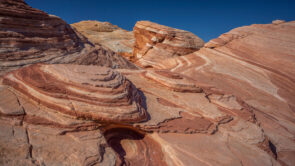
- Wilderness Areas: 12
- Wilderness Study Areas: 1
- National Wildlife Refuges: 2
- National Recreation Areas: 1
- National Monuments: 1
- State Parks: 1
- BLM Land
- Arizona State Trust Land
Permits
The majority of the first 300 miles or so are through the Lake Mead National Recreation Area. The $80 annual National Parks pass gives you entry to Lake Mead. You won’t need to show the pass to enter the park on foot, because you won’t be stopping at a booth along the road, but if you get stopped for any reason, this pass is what you need to have to be legal. You can buy this in person at the fee stations at the entrance to the Lake Mead NRA. Not all locations are manned, though. The stations on Lakeshore Rd (east of Boulder City) and on E Lake Mead Parkway/Lakeshore Rd just east of Lake Las Vegas were both manned when I passed through the area, but the stations near Moapa Valley might be open and unmanned.
Additionally, there are small sections (a few miles) of Arizona State Trust Land that require a $15 annual permit, which can be purchased online HERE. Law enforcement on Arizona State Trust land is, to the best of my knowledge, not limited to one agency. Instead, the local sheriff, BLM or whoever has the authority to cite a person for not having the necessary permit. With that said, there are only a few miles of hiking on AZ state land, and it’s highly unlikely that you’d see another human along any of it. Just know that to be legal, you need the Arizona State Trust Land permit.
Water Availability
The Mojave-Sonoran Trail is the driest route I’ve ever hiked. 2021 was an unusually warm and dry fall, which definitely impacted water availability for me. Many springs and guzzlers that would probably be reliable, were not because it was such a dry year. Still, the route presented here has been hiked successfully, thus proving its viability for sustaining a thru-hiker even in the driest of times. While the Mojave-Sonoran Trail will always be a dry route, experienced hikers should have no problem making the water sources along the MST work for them with proper planning. 160+ water sources have been identified along the route, with notes of field observations.
Water can generally be acquired once a day. The biggest carries span two days. Although the route follows the Colorado River, it’s usually not close enough to be used as a water source. Along the first half of the route, the river can be used as a lifeline in case you get into trouble… if you can get down to the water, that is.
Water along the Mojave-Sonoran trail comes from a variety of sources. Lake Mead and the Colorado River are only occasional water sources. Water can be found in springs, troughs, wells, guzzlers, campgrounds, and strategic stops through small towns or a small business. In a few select locations, such as Valley of Fire State Park, tourists are plentiful, and you can pretty much count on being able to yogi some water. Additionally, caching water ahead of time can drastically reduce the length of water carries in some sections. Small game guzzlers in Nevada offer a potential water source, if you can get to the water. These often require crawling under an awning about 18 inches off the ground, tying a cord to a wide mouth water bottle filled with rocks for weight, and chucking the bottle into the guzzler’s underground collection tank in order to retrieve water. Slow and tedious, but a viable way to extract water from these critical water sources.
What is the longest water carry?
My longest water carry was a result of two water sources not working out for me. I hiked 50 miles on 5L of water over 2.5 days in section 5, Searchlight to Bullhead City. I would now recommend placing a water cache along this section to reduce this carry to a more reasonable 30 miles or so. And in-between that, a small game guzzler exists that could yield some water with a plan to access it (the small game guzzlers are tricky). Ultimately, how long your longest water carry will be depends on whether or not you will be caching.
If you were to cache water at all of the suggested locations, the longest water carry would be:
32 – Section 5, in between Searchlight and Christmas Tree Pass. Two small game guzzlers along the way, but water extraction could be difficult in dry years. The guzzlers would reduce the carry to 19/20 miles, and may have water in wet/normal years
31 – Last 31 miles of section 6, Lake Havasu Wilderness. Unverified Spring along the way, 1 mi off route. Option to detour to Colorado River for water (1 mile) about 10 miles into this carry. Option to end this section at 16 miles into carry
27-30 – Section 7, Whipple Mountains. Water may be found at mile 27, if not at mile 30. No option to cache along this route
25 – Section 7, final 25 miles to Bouse. Very flat, easy miles
23 – Section 9, final 25 miles to end the hike.
If you don’t cache at any of the suggested water cache locations, you longest water carries would be:
35 – Section 1, days 1 & 2. Option to yogi water from some of the only day hikers you’ll see on this route (easy) at mile 25. Caching splits this up to ~17 miles
31-40 – Section 4, Gold Strike Hot Springs to Nelson. Caching reduces the carry to ~19 miles
45+ – Section 5 is full of unreliable water sources. It could be 45-50 miles to Lake Mojave for water if you can’t get water from small game guzzlers, if Sacatone Spring is dry and potholes are dry Cache at Christmas Tree Pass to mitigate this risk.
52 – Section 6, Warm Springs to Lake Havasu City. Don’t freak out about this one. There are many options to make this carry much shorter, but you need to look at the map and pick one of the options yourself. An alternate to a truck stop, an unverified spring, detour to the Colorado River, and cutting miles off the end of this section are all options to reduce the water carry mileage. You might not want to cache here at all, but it’s an option.
Typical/most liters of water carried?
On average, I was expecting water once per day, and carried 5L… 4 for one day, plus an extra liter in case it takes a little longer. The most I carried was 8L, for two days. Future hikers can benefit from caching at a couple of locations I didn’t, as well as benefiting from having some beta on water sources along the route in the form of the Mojave-Sonoran Trail Water Chart.
Caching Water
Caching water ahead of time at a few key places along the route is a good option. For those flying into Vegas, you can rent a car and drop off water over the course of 2-3 days. This also gives you a chance to scout the route a little, and some of the towns along the way. Not caching water would result in water carries of 2+ days in a couple of places. The route is still doable without caching, but caching water certainly makes it easier. Suggested caching locations are marked on the Mojave-Sonoran Trail map for reference.
Mojave-Sonoran Trail Water Chart
I’m working on releasing some sort of water chart for the MST, but for now, you’ll need to do the leg work yourself to determine distance between water sources. Just use the “profile” function in caltopo to read the mileage of each water waypoint, and the mileage to the next one. All of the water waypoints have notes from field observations in the waypoint descriptions. This is what the info in the water chart will eventually be populated with.
Water sources that I’ve personally visited will have notes describing what I saw. Water sources I did NOT visit will still have notes, based on what I saw from satellite when I researched them prior to my hike, and any other sources of information I could fine (water report, etc).
Resupply Strategy
Resupply on the Mojave Sonoran Trail has been broken down into 9 sections, with 8 resupply stops. Much of the Mojave-Sonoran Trail can be hiked without the need to hitch into town for resupply. It’s a 4 mile hitch into Bullhead City, if you want to. The only place it would be truly necessary is 14 miles into Quartzsite.
Mojave Sonoran Trail Resupply Strategy Spreadsheet Download
I use a spreadsheet to organize my plans for resupply along my long hikes. It gives me a quick way to refer to all of the information I need on the go. I just load the spreadsheet on my phone and refer to it as needed. You can download my template to get started, and modify it to fit your plans:
Resupply & Logistics Tips
Before the hike, it’s recommended to cache water (and possibly one box of food) along the route if you can. If you are driving your own vehicle to Vegas to start the hike, this will be easy for logistically, having your own vehicle. If you are flying in, you can rent a car for 2 days or so to make the drive to the cache locations. This route can be done with no caching, but that will result in longer water carries. That would mean 2 days of water vs one day in a few locations. I did two day carries in many locations, so it’s possible without caching if you aren’t able to do that pre-hike.
Sections 1-3: The most difficult sections to resupply are at the beginning of the hike, in the Lake Mead National Recreation Area. At the end of section 1 (Echo Bay) and section 2 (Callville Bay), resupply options are limited. Echo Bay used to be thriving, but the low water levels of Lake Mead have left the place largely abandoned these days. To a lesser extent, Callville Bay was also effected, but had held on more than Echo Bay. It’s 156 miles from the northern northern terminus to Boulder City over 3 sections, and there are a couple of options for resupply during this stretch:
- Leave a food box at Echo Bay. There is NO MAIL here, so you must drive here before the hike and visit in person, unfortunately. Try to leave a box with the store clerk, RV park camp
host, etc. If that fails, try stashing your food in the abandoned motel next to the c-store. Make sure to use odor proof bags if doing this. Caching food by burying it is not specifically listed as prohibited on the Lake Mead National Rec Area’s website, but because it’s federally owned, you can bet it’s not allowed. I haven’t clarified this yet, though. You will want to cache enough food to last to Boulder City for sections 2 AND 3, minus basic c-store snack items like nuts, chips, jerky and candy from Callville Bay’s Marina Store. You can also get a hot meal for lunch or dinner here at the restaurant, so factor that into your resupply plan as well.
- Skip Echo Bay, and hike 111 miles from the northern terminus to Callville Bay. From there, it’s about 40 miles from Callville Bay to Boulder City, a two day walk. Callville Bay Marina Store offers chips, jerky, candy, nuts etc, not much else for food. They do have a restaurant for lunch and dinner. From the northern Terminus, you could bring enough of your staple food items (that you can’t get at Callville Bay) to last to Boulder City, and use Callville Bay to resupply basic c-store snack items, and pig out at their restaurant.
- Hitch into Overton to resupply (full grocery store). The best place to hitch into Overton would be along Northshore Drive, before hiking towards Echo Bay. This is roughly 50 miles into the hike, with about 105 to reach Boulder City, the next full resupply opportunity. Hitching is difficult here. Most people driving around here aren’t heading into Overton. Getting a hitch back out to Echo Bay is even harder. But it is possible. By hitching into Overton and resupply at 50 miles in, you could carry food for sections 2 and 3, over 105 miles, minus the food you can eat at Callville Bay’s restaurant and the snack items you can buy there at the Marina Store.
Boulder City: Once you reach Boulder City, your resupply and logistics for the rest of the hike is a little easier and more straightforward. Boulder City is a full resupply, with an Albertsons and everything you need. Since Searchlight, the next town stop, only has two c-stores (no actual grocery store or market), you might consider sending yourself food items from Boulder City… the things you can only find in larger grocery stores. Send to the PO if you think you’ll get there during operating hours/days, otherwise, call one of the two hotels and ask to send a box. I recommend starting with the El Rey motel first, and only considering the BV Motel as a last resort. That place is wild, and not in a good way.
Searchlight: This was not my favorite town stop. The town is rundown and appears to be a high crime place. Everything you need in town is within two blocks though… two C-Stores, McDonalds, Denny’s, PO, 2 motels. Full resupply is not really possible here. but it’s only 2.5 days to Bullhead City… so if you aren’t picky, you could do a combination of McDonald’s food and gas station stuff and probably make it work. However, the recommended strategy would be to send a food box from Boulder City that has anything you can’t get here. The El Rey Motel was booked, so I had to stay at the BV Motel next door. This place was cash only ($60), dirty, and full of oddities. For example, the full size mattress on a twin size box spring… the mattress hangs off the edge of the box spring. Door knobs under the bed, no shower curtain, dirty, no wifi, can see under the front door, just a weird place. In the distance, a man with the most shrill, frantic voice I’ve ever heard was screaming for hours about how he was going to kill someone. The good news, this motivated me to not take a zero, and just leave the next morning.
Bullhead City: Everything you need, but unfortunately, the layout of the town is spread apart. All the hotels are in one place, the restaurants in another, grocery and retail stores somewhere else. Uber and Lyft operate here, and there is also a bus (red route) that runs once per hour. Apparently the Post Office is pretty bad here (read the google reviews before sending anything), so it would be best to send packages to a motel instead if needed.
Lake Havasu City: This section has a few different alternates and options. Cold Springs Station (40 miles into this section) offers chips, jerky, a few candy and snack items, soda… maybe enough to be considered “lunch”. Around mile 60 into this section, there is an option to take a 6.6 mile alternate route to a truck stop/travel station with multiple fast food restaurants, shower and typical large c-store food items. This route would add about 4 miles to your overall distance. It would also mean that those 4 miles would be paralleling Interstate 40, so keep that in mind. Lake Havasu City is a large (55k population) and sprawling city. The ideal location to stay is near the London Bridge… this is right next to the docks for the ferry across Lake Mojave to start the next section, there are multiple grocery stores, hotels, PO, restaurant, etc. Lake Place Inn offers cheaper rates, and is 1.5 miles from the Havasu Landing Ferry.
Bouse: After crossing the Parker Dam (must hitch across, no pedestrians allowed), you’ll reach the Hez-ron gas station/C-store, around 45 miles into this section. Typical c-store food, with some microwavable items like burritos and hot pockets. The owner is not very welcoming, and will insist you remove your pack and put it behind the counter while in the store. This doesn’t stop him from staring and scowling, though. Not a pleasant man. It’s unlikely he would let you use his hose or spigot for water, but you can always just buy a gallon of water from the cooler. In Bouse, resupply options are slim. The Coachman Cafe is only open until 2:30pm, and closed Mondays. You can get a meal here, but you better hope you have the same political affiliation as the owner. Yeah, it’s one of those kind of places. The Somewhere Bar has food too, and is open to 6pm, but is a little farther away. A Family Dollar exists, and a small store called the Roadrunner Market. The Market has a small selection of grocery items, probably enough for most people to cobble together 2 days of food. If you have any doubts though, you can send a food box to the Bouse PO. The worst part about Bouse is that there is nowhere to stay the night and get a shower. The Bouse RV Park refused service to me because I was in a tent. Yup! There’s the Just For Fun RV Park across the street, but they have no shower. What’s the point, then? There’s the Bouse Community Park about 1.25 miles west of town on Plamosa Rd. but they also don’t have showers, and charge $14 a night. There is a day use area here where you can fill up water, use the bathroom, and a pavilion with electrical outlets that were OFF. The camp host was unfriendly, circling a bunch of times in her golf cart before finally approaching and saying “you know this is a day use area, right? You need to be gone by dark”. Geez. Bouse was hands down the least welcoming town stop I’ve ever had as a hiker. Fortunately, Bouse is a great town to get what you need quickly and walk out without staying the night. BLM land is right across the street from the Bouse Community Park, camp there for free and move on.
Quartzsite: Quartzsite is a weird town. This area is home to a massive influx of RV campers who spend the winter in the desert nearby, to the tune of about 250,000 people a year. The entire town is a mixture of trailer parks and flea markets. Quartzsite has everything you need, though. The Super 8 Motel is located on the far west side of town, far away from everything else. There is also the Stagecoach Inn which is much more centrally located. In addition to these two hotels, you might find a room to stay in for the night by walking the streets near the flea markets, there are signs advertising rooms, showers etc, despite not showing up on internet searches for motel rooms. The Camel Express (Quartzsite public transportation) bus provides transport across the city, anywhere you want to go, for $.50 each way. They will make multiple stops along the way for you too, while you run into a store, they will wait. Call (928) 927-4333, Option 3 to schedule a ride. There are multiple small markets, but the Roadrunner Market is probably the best stocked. Still, the selection is thin, barely meeting the threshold to be called “full resupply”. They don’t have basic things like whole wheat bread, tortillas etc. Between the Roadrunner, Family Dollar, Coyote Fresh Foods and multiple C-stores, I’m confident you will find Quartzsite to be a full resupply city, albeit just barely.
Gear List & Recommendations
A link to my lighterpack gear list: https://lighterpack.com/r/4aj6eq
The Mojave-Sonoran Trail is a pretty easy hike to pack for. The weather is very consistent and generally warm to mild. Winter hikers will want a 20 degree bag, and fall/spring hikers will probably be good with a 30 degree bag. For my hike (Nov-Dec) I used a 40 degree bag, and only regretted it one night, the rogue cold night of 21 degrees. I used a Tarptent Notch Li tent, and cowboy camped maybe 1/3 nights. I was debating whether or not to bring a foam sleeping pad, but went with my thermarest neoair inflatable. I’m glad I did, because it held up pretty well. I got a couple of pinholes along the ay, likely from one or two campsites, and just patched them in town when I got to a bathtub to submerge/test it. Make sure you carry a patch kit if you bring an inflatable!
This is a desert hike, so go light on the rain gear. I carried a zpacks Vertice rain jacket, and carried no rain pants. Wind Pants like the EE Copperfield pants would work well for what little rain you would possibly encounter, if you wanted to bring a pair.
This route will have you using your hands quite a bit. Not only for climbing, but on bushes and branches, and cacti (inevitably). I recommend some type of gloves to protect your hands. I’m using the Fish Monkey fingerless gloves, which I find almost perfect for this type of thing. Fingerless is a must for me for using electronics, and these are thin and flexible enough to not be cumbersome, yet still provide plenty of protection.
I went through two pairs of Brooks Cascadia 13’s on this hike. Yup, still rocking 3 year old shoes, I buy them cheap after the new models come out. I lost like 70% of the tread on my shoes on day 1, due to some razor rock (limestone) along Weiser Ridge near Valley of Fire. There are parts of this route that will eat up your shoes, so be prepared to swap them out half way, perhaps Bullhead City or Lake Havasu.
TIP: Bring an end-of-life pair of shoes for the first day of this hike, since you’ll eat all of the tread on new shoes on Weiser Ridge (Day 1). Carry your new pair of shoes until day 2 when you get to the trailhead in Valley of Fire State Park, throw out your old ones here, and carry on in your new pair.
Some sort of pre filter is a good idea to have in your water filtration kit. I use women’s pantyhose for this. Weighs nothing and works well. Use your hand to spread apart the fabric when filtering water to allow it to seep in. You will also need to have a plan to draw water from the small game guzzlers along the route. For example, mine included a wide-mouth Gatorade/Powerade bottle and cord. I also use the cord to lower my pack on downclimbs.
Mojave-Sonoran Trail Thru Hike 2021 – Section 9: Quartzsite to Kofa

Mojave-Sonoran Trail Thru Hike 2021 – Section 9: Quartzsite to Kofa
Mojave-Sonoran Trail Section 9 Map
Mojave Sonoran Trail Thru-Hike Section 9 – Quartzsite to kofa, 40 Miles
The above map only represents represents section 9 of 9 on the MST. For a more detailed map and general route info, see the Mojave-Sonoran Trail Guide page.
Mojave-Sonoran Trail Section 9 Journal
Day 40 – December 12th
Miles: 10.9 (half day)
Animals Seen: 4 bighorn sheep
I had a ride scheduled back out to the highway where I left off for 8:30 this morning. I packed up my stuff, stuffed my face with as much food as I could, and hydrated with two liters of water. Got down to the hotel lobby and my ride didn’t show up until 10:30, so that’s a good chunk of time missing from my day. Still, I figured this is better than hitching since I would have to get a ride down the interstate which is very hard.
The shuttle driver dropped me off along the off-ramp exit from Interstate 10 to highway 60. It’s nothing but desert along the road here. “Right here will do”, I said.
Of course, this is very strange to most people, and I love the reactions I get. I got out and started walking south into the desert. My pack was heavy, with 6L of water and 7 days of food. Probably more than seven days of food actually, I went a little overboard on this one.
My original plan was to follow the highway West a bit and then cut south along a dirt road on the map. However, that would easily add two or three miles to the hike. It’s hard to know ahead of time what things will look like and what the terrain will be, but once I was here and got my eyes on it, I decided a cross country Trek directly towards my destination would do just fine. So that’s just what I did; set a course for Black Mesa and go.
It was cross-country hiking at first, until I met up with a wash. There were tire tracks here, and leading the direction I want to go, so I followed. A few miles up, I saw a sign marking the 4×4 roads. Interesting, because these roads were not on my map. And really, one shouldn’t use the word “road”. It’s just a wash with lots of gravel. It’s pretty open and clear, but sometimes the loose gravel is tougher to walk then it would be to not walk on the “road”.
The scenery was pretty nice leading up to Black Mesa. Despite the loose gravel, it was pretty easy walking and I couldn’t complain. The wash eventually narrowed, became thicker with vegetation, and presented a few pour offs to climb. Easy though, no biggie.
I reached a point where it was no longer worth staying low in the wash, it was too difficult. I climbed up to the Ridge above and continued to make progress that way. Out of the wash and on top of the ridge now, I followed it uphill some more before I had to drop down into another wash on the other side. Black mesa was getting closer, and the views were nice. There were lots of basketball sized rocks to step over with tons of cactus in between. An obstacle course.
As I entered the new water mountains wilderness, I joined an old dirt road leading up to black masa mine. My notes list a bunch of interesting minerals here, and it’s time for a lunch break. I brought way too much food for this section, including some leftover town food such as pizza and chicken strips. Great lunch, and I poked around through the tailings while I ate.
After lunch, I explored a couple of the mining tunnels into the mountain. There were several openings, and most of them link up underground. There were a couple of different tunnels to explore. I found one interesting specimen that I kept, hoping to identify it later. It featured metallic red and yellow colors that I have not seen before. Pretty cool.
After leaving the mine behind, I continued uphill past the point where the road ends. This climb was easy in the sense that it wasn’t too steep, but tough because of the thick brush among large boulders, in addition to my heavy pack.
I reached the top of the Mesa, and the view was pretty much non-existent at first. A slight uphill grade hides the horizon, and the terrain is still choked with vegetation and boulders. I need to climb the high point to see what I’m working with here. Another 50 feet of elevation gain and I’m there. I was surprised to see a large rock cairn at the top, and there was even a summit register in a glass jar. There are almost no signs of use leading up here, no path or cairns along the way. The register had two entries from 2021, and nothing prior.
I could see the Kofa Wilderness to the south, and the new water mountains to the northeast, where I’m headed next. But first, I head east across the Mesa towards its twin. It looks like part of the same Mesa from here, but a canyon separates the two.
I was hoping the Mesa would be more clear and open, easier to walk, but it really wasn’t what I’d hoped for. When I did reach the canyon, my first thought was how much deeper and steeper it looked then the map implies. I need to find a way down this thing.
I worked my way around the edge of the mesa until I found a weakness. I followed this down into a side canyon that I would take down to the main canyon separating the two mesas. However, it’s steep and the rock is loose. I fell a couple of times, despite moving slowly and being aware of the dangers.
After a tedious and treacherous decent, I reached the bottom. My original plan was to go back up and walk the other Mesa as well. This too would involve some treacherous hiking to descend the other side, judging by the maps. With less than two hours of daylight left, I chose to skip the second Mesa. This too had its challenges. I briefly walked the canyon uphill, which forms a saddle at the top. Descending this also looks like quite a chore.
I started Contouring around the hillside more than simply descending. I fell again, this time I felt lucky to have not tumbled and hurt myself. Loose rock gave way and I Tumbled backwards, falling on my ass. My hand struck a cactus, but Thankfully not a cholla. Whew. Getting tired of these falls, though. There weren’t many other places along the route that compare.
It was slow going on the descent here. Time is ticking away and I’m still quite far from the bottom. I found some interesting quartz veins on the way down as well which further distracted me. There were a couple of small crystals, well-formed and excellent clarity. Didn’t have time to find anything worth keeping though, at least not without any tools to utilize here. I saw another 3 big horn sheep as well.
Like most nights, I found a suitable camp with only a few minutes to spare before dusk. I was glad to be off the slopes of the mesa and ready to ditch my heavy pack for the night.
Day 41 – December 13th
Miles: 14.6
Animals Seen: Bighorn sheep
The wind started picking up as the sun rose. This made packing up camp a bit of a chore. It also made it feel Cold, even though the coldest overnight lows are still to come in the next few days.
This morning’s walk picked up where last night’s challenges left off. It’s off trail, the terrain is Rocky, and the vegetation is often thick. It’s a pain in the ass.
It wasn’t long before I reached a dirt road. What a relief. I could cover some ground now, and do so without tripping every other step, sliding on loose rocks, and dodging cacti. No matter how you slice it, the next several miles will be less interesting as I move between black mesa and the new water mountains, so I might as well do it efficiently.
I reached the Ramsey mine, where the map marks a water tank. However, there was no water here. There was one spot it looked like it could have held water at one time, an Earthen berm with the remnants of some sort of black liner. This would have been many years ago though, nothing recent.
The mine itself featured a couple of vertical shafts and a wooden structure. I poked around the tailings for a bit, but didn’t find anything that caught my eye.
Leaving the mine, I followed a road that heads towards the New Water Mountains. This was an open desert walk through the foothills of the Plamosa and New Water Mountains. Somewhere along this section is the transition between the two mountain ranges.
As I approached, mountains grew taller and their character began to show. Some impressive formations, both near and distant. Twin peaks is the closest, and it dominates the view here. My route wraps around Twin Peaks, and it’s a great view from every angle.
Just below twin peaks, I encountered a guzzler. This one was actually a combination of a permanent guzzler and a more temporary one. I’m guessing that the permanent guzzler has been running dry, and so the second temporary guzzler was added to ensure the animals don’t go thirsty. Either way, there was good water in both drinkers (troughs). Better water in the permanent one, actually. Crystal clear, despite some green algae on the bottom.
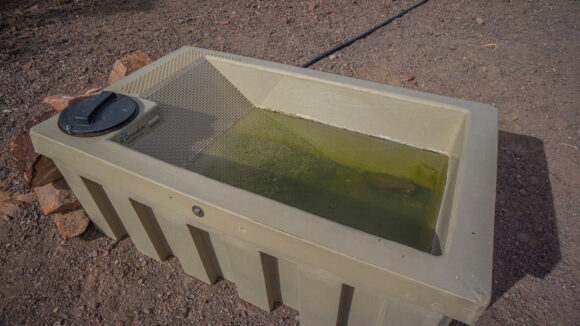
In addition to the permanent trough, there was also this portable guzzler. Dual drinkers, this one is filly-loaded
No less than 6 game cameras were set up here at the guzzler. Surely one was left by the BLM or whoever administers this land and looks after the guzzlers, but the others can be attributed to unsportsmanlike Hunters. Might as well just go “hunt” at the zoo. Anyhow, they got me on camera filling my water. I chugged a litter, and filtered 4. This gives me 6L for the rest of today and tomorrow. There’s a chance I might get water tomorrow evening, but it doesn’t look very promising. So it’ll probably be two full days before next water. In retrospect, I probably should have taken 8L, but I’ve done this several times on this route now and I know I’ll be just fine.
Leaving the guzzler, I found the canyons I hiked through to be very pleasant. I followed the dirt road four ways until it led me to the boundary for the new water mountains wilderness.
Now I walked a wash through an increasingly narrow canyon. I reached a side Canyon that looked choked with vegetation… Yep, that’s the one I’m looking for. This one will take me to my next destination, a summit called “the eagles eye”.
The walking from here on out was pretty slow. The canyons were often narrow, there were small pour offs to climb, more thick vegetation. It wasn’t long before I reached a side canyon that caught my eye. It was very narrow, a slot. As I approached, I could see a game camera setup here. Entering the slot, there was water! I haven’t seen anything like this on my route yet. The water was a foot deep where I could see, maybe two feet deep farther back. There was plenty of water here and it looked to be fairly good quality. Very cool. As I exited small slot canyon, I had to look at one of the cameras set up here and one was marked as “mountain lion detection project”. This is big cat county, after all.
After exiting the canyon that had water, I was still walking a narrow canyon seeing where that led me. The wash let me to a spot where I could climb up a little hill and enter a new Canyon.
As I worked my way up into the Basin below the eagle’s eye, I saw a few cairns. However, these would be the last I’d see. The route up was very cryptic. There are many small Canyons, ridges and washes to choose from, and so the route up was not obvious at all. A bit of trial and error mixed with instincts.
The Eagles eye is a large arch along the crest of the mountains. The arch becomes visible as you work your way up into the basin below. I took a route that led me directly below the arch. There was a lot of loose rock here and a little bit of class 2/3 scrambling, but easy enough.
I reached the top of the ridge and walked over the crest of the New Water Mountains, now looking North to interstate 10. I startled a big horn sheep, which promptly ran away. I walked along a Rockwall that led me to the eagle’s eye, a hole in the Rockwall about 15′ in diameter. Eagle’s Eye was much Cooler than I thought it would be. Farther down the ridge line was a large volcanic plume, which served as a great background prop for the arch.
Not surprisingly, there’s is a summit register here as well. This peak gets some traffic, also not surprising being that it’s a pretty unique one.
I descended the summit and took a different route this time. Like the route up, the route down involved some trial and error as well. The descent went quicker though than the Ascent.
Once I had dropped back down to the main lower wash, it was time to go up and over a small pass that would take me to the next Canyon over to the north. This pass was pretty straightforward and Simple.
I descended the pass and found myself in the wash below. The next segment of my route goes back up to the ridge line, but it’s after 4:30 now So I’ll have to find a spot to camp somewhere down here and tackle that in the morning. It took a bit of searching to find a place to set up my tent, but found a spot around 5pm. This is one of the earliest campsites this whole route. Seems like every night I’m pushing it right up to darkness.
Day 42 – December 14th
Miles: 10.4
Animals Seen: 1 bighorn sheep, 3 Jack rabbits
It was a very calm and still night. Since I got to camp a little early last evening, I was able to finish my evening routine earlier, and went to sleep earlier. 12 full hours of sleep was enough. Only one week now to the winter solstice, shortest day of the year in terms of sunlight.
Today began with the climb uphill. It wasn’t bad though, not overly steep or loose, and quite scenic the whole way. The sky was mostly clear when I woke up, with the exception of clouds building over the Kofa Ridgeline. The clouds continued to build as I Climbed, but this only enhanced the views, adding some extra flair to the scene.
The higher I Climbed, the better the views. I was really digging my surroundings this morning in the New Water Mountains. I was really looking forward to the view from the crest once again.
I’m climbing up to a peak called hidden benchmark. It’s aptly named, since the summit is hidden until the last moment. It took twice as long to climb up as it should, because I kept turning around to admire the landscape, take photos, and film from a slightly different angle, each better than the last. I dodged cholla the whole way up, which seems like second nature now.
Kofa Mountains to the south, where I’m headed next
The summit of hidden benchmark was grand. Each direction had something to offer; the massive Renegras Plain to the north, the rugged Ridgeline of the New Water mountains to the west, Kofa Mountains and black mesa to the south, and the stunning peaks and ridges of the New Water Range to the east. I stopped here for a good while to soak it all in. There was a summit register here, placed all the way back in 1987! There were only seven or eight entries Since then. This benchmark truly is “hidden”.
The summit of hidden benchmark was also choked with cholla. I tiptoed my way through a Minefield of these monsters as I descended the summit and made my way east along the ridge line. The north face of the ridge was a sheer drop-off, and despite the horrendous field of Cactus, was an enjoyable walk. I spooked a big horn sheep along the way. I’ve been seeing them lately, Although not in the same numbers as the Lake Mead area in the beginning of my hike.

This view over the Ranegras Plain is just so massive. It’s hard not to stop here for a moment and just realize how small you are
This was one moment where I really stopped to reflect on this hike as a whole. I’m just a few days from the end now. From here, looking north over the massive Ranegras Plain, I can see much of the route I traversed over the past couple hundred miles. There is now a story to accompany the view. The landscape has meaning to it now, stories attached to it, and a personal connection to it. What a journey it’s been it get here.
I followed the ridge around a couple of saddles, and continued on until it became more effort than it was worth. Then I dropped down from the ridge line and made my way into the Canyon below. The descent was easy, a nice change of pace. Soon I met up with the wash below.
Walking the wash now, I was also surprised to find it so easy going. While stopped for lunch, I found a tick on my leg, crawling, not digging. Only the second of the trip, the first being in the Plamosa Mountains during the last section. Surprising to see any on this hike, considering it’s the desert, and the weather pattern has been so dry.
I was covering good ground now. I follow this out of the canyon and into the open desert. Here, I left the new water mountains wilderness and entered the Kofa national wildlife refuge. Managed by the fish and wildlife service, this 665,000 acre plot of land contains the Kofa Wilderness, which is 550,000 acres. That makes it the second largest and Arizona. It’s a massive landscape.
After a few miles in the wash, it was time to set a course cross county towards my next destination; a well, and a cabin. I picked a distant landmark, in this case a power line transmission tower, and headed for that. A 4×4 road parallels this as well.
I passed the power lines and the dirt road, and from there it was a short walk to the well that is marked on the map. When I got closer, I could see a windmill, it’s blades moving rapidly. Clearly this one is functional. As I approached, I could see the windmill working as it should, pumping water into a large tank. From there, and underground pipe Sends water over to a trough. The trough was covered with an awning, which is why I didn’t see any water here from satellite when I did my research. The trough was also full to the brim. The water looked pretty green, but upon dipping my bottle into it, It was a little bit more clear than I was expecting. Still, pretty green.
I had three liters of water on me at this point. I filled my two-liter platypus bag with water, but didn’t filter it now. The Kofa cabin is only a half mile away, So I took the dirty water with me and headed for that.
As I approached the cabin, I could see it was a pretty solid structure. I had been told that it was, but I was expecting a wooden structure cobbled together with pieces of scrap metal, or something of the like. Instead, it was a stone structure. There was a plaque out front that said it had been built in the 30s by the CCC.
I opened the door and was surprised how nice it was inside. The floor and walls are all concrete, there are no holes in the walls or ceiling, and it looked solid all around. There were two wooden beds to set an air mattress and sleeping bag on, a wooden table with chair, a shelf full of random knickknacks and things left behind by previous visitors, and even a wood burning stove. Hell yeah, this will do!
It was only 3pm now, but this evening it’s supposed to rain. Not only that, but the winds are forecasted to be 25 miles an hour, gusts 40+. This would not be a fun night to be in a tent out in the open desert. I can’t sleep at all when the tent is whipping in the Wind. Additionally, when dirt and dust is flying around in high winds, it wreaks havoc on my tent zippers. I would gladly forgo a few extra miles of progress today to avoid the hassle of spending the night out in this storm. For once, a nice solid cabin to spend the night in, when it’s truly convenient.
First things first, I made my bed and unpacked my bag. Then I made inventory of what was on the shelf. There was quite an array of items here. There were several beverages; 3 16.9 ounce flavored propel water bottles, one bottle of water, a Capri Sun, iced tea, two cans of beer and one spiked sparkling water. All of these were unopened, and were looking pretty good to me right about now. A couple of granola bars, some canned food, etc. Lamp oil, but no lamp. Some less than interesting rocks, some books and magazines, first aid kit, etc. There was a guest log as well, with several recent entries including three people who stayed here only the night before.
I think the weirdest thing here was two pool cues. The rest of this stuff at least made sense.
I ate lunch, and wandered around the property for a bit. It was nice to just hang out for a little while and not be pressured to cover miles. Then, I heard a vehicle approaching. From afar, It looked like a modern and high-tech version of the Ghostbusters vehicle. Instead, it was a tricked out Toyota 4Runner, built into a camper. “Sweet rig!” I said to the guy as he approached.
The occupants, Ben and Asuki (spelling?), were from Denver and on a road trip. This was their first time in the region, and they were doing some exploring. He was pretty excited about seeing saguaro cacti for the first time, as I was years ago on my first Arizona trip. We chatted for a good half hour before they moved on.
The rest of the evening was uneventful. I watched the sunset from my front porch while drinking an adult beverage. The winds really picked up as night fell, absolutely howling. I can only imagine how stressful tonight would have been in my tent. There was a small amount of wood next to the stove, So I threw that in and warmed up the place before going to bed. Man, what a luxury.
Day 43 – December 15th
Miles: 19.8
No Animals Seen
The wind was absolutely howling last night. I never heard it rain, but apparently it did. I was extremely thankful for this cabin; it was so nice waking up with a roof over my head.
This skies were clear and the air was crisp, to say the least. I was bundled up as I began my walk this morning. The new water mountains generally run east and west, and to the south, there are two more east-west running ranges within the Kofa Wilderness. Each one of these ranges is separated by a valley of about 25 miles. Today, I will walk that first valley, between the new water mountains and the range at the heart of the Kofa Wilderness. In the valley are some low hills, mostly uninteresting. Therefore, I have chosen to stay on a dirt road most of the way.
I passed Wilkinson seep, which was the next water source south of the well near Kofa cabin. There were a few liters of water here, and it looked like decent quality. With 2.5L of water on my back already, I skipped this one.
The hillsides became thicker with grasses, albeit dry grasses, as I walked south. This was a bit different landscape than I had seen along much of my route.
Today was remarkably uneventful. Practically nothing happened. I covered some good ground quickly, and made it to Mid Well shortly after 2pm. Here, a windmill pumps water into a tank, which is then piped into a trough. Just like the windmill near the Kofa cabin yesterday. The water here was even better. The trough was filled to the brim with clear water, despite a lot of algae growth and shine little swimmers. I filled up with 5.5L here.
About a half mile away I encountered the Wilbanks Cabin. This one is a wooden structure, and I could immediately tell it was nowhere near as solid as last night’s cabin. The front door was wide open, and upon entering, I could see light shining through many of the boards in the walls. Some of the windows were missing glass, with only screen remaining. Some of the screen was pulled down, leaving large gaps for anything to enter. And worst of all, the place was absolutely littered with rodent feces.
There’s a windmill here on the property as well. The blades are turning and the mechanics seem to be functioning properly, but the tank next to it was empty and the nearby trough was bone dry.
Still, I debated whether or not to stay here. I’ve covered nearly 20 miles today and don’t really need to cover any more ground to stay on track. I have 2.5 more days of this hike, and the things I want to do and see are spaced out pretty good from here, roughly 12 miles per day. So I decided to stay in the cabin. There are two bed platforms to get me and my gear up off the ground away from the rodents that will surely be active after sunset. There’s a pretty solid breeze coming in through the windows, but I don’t think I would be that much warmer in my tent anyways. This is just a more convenient way to cowboy camp, I suppose.
Day 44 – December 16th
Miles: 12.4
Animals Seen: 3 bighorn sheep, 3 Jack rabbits
Last night was miserable. It was far colder than I expected it to be… 22 degrees this morning when I woke up! My quilt is only rated for 40 degrees, and to make matters worse, it has horizontal baffles, so all of the insulation slides from the top to the sides leaving many cold spots. I had on every piece of clothing available to me, in addition to using my trash compactor bag (backpack liner) around my feet and legs. Still, I was cold all night. The weather has been very mild this entire trip, and the clothing and gear I brought have been perfect until last night. I suppose I could have sent a warmer sleeping bag and a fleece or puffy jacket for this last section, but I was expecting overnight lows in the mid-30s, not low twenties! Additionally, all of the rodents living in and around the cabin were quite active, scurrying around pretty much all night. They mostly seemed to be in the ceiling and other parts of the cabin, not directly near me, thankfully.
I have been getting up around 7, but today I waited for the Sun to rise above the Horizon before I got out of my bag, closer to 8. It was just too cold. My feet were freezing l, and I was shivering until I could go outside and stand in the sunlight. Just a miserable start to the day. I was about an hour late to start walking today as a result, and not that motivated.
Part of my lack of motivation this morning was due to the fact that the scenery was just not that interesting. Yesterday’s road walk was quite Bland, and today picked up where yesterday left off. The exception was that I started today with a bushwhack instead of a road walk.
The route this morning was a bit difficult to follow. There were a lot of low Hills, no large landmarks to work with. This type of terrain always seems to make it difficult for me to see the path forward. I was just kind of stumbling around anyway, trying to warm up. It really didn’t take too long though oh, I had to stop and shed off my base layers. It was good to be warm again!
My cryptic route led me up to a small pass. Then I dropped down to the wash below. It was here where the scenery began to improve. As I looked back behind me, multiple craggy outcrops and Peaks meet up the ridge line that surrounded me. I followed this wash up to another pass.
I dropped down into a very colorful wash with some cool jagged peaks sticking up all around me. Now this is what I’m talking about.
After emerging from the wash, the views opened up. The colors were intense here, strong reds and oranges, which always make for a beautiful scene.
The scenery now was stunning. Ultimately, I would drop down into a canyon on the other side of the pass, but this pass was also somewhat of a Ridgeline, and I made it a point to explore as much of it as I could. I headed up to a point along the ridge that looked like it would offer the best vantage point, even though it was out of my way. I’m here to see the sights, there is no point in walking by amazing things just because they are a little out of the way, as long as I have the time. And today, I do.
I bagged a small Peak along the top, and ate lunch. Every direction now was stunning. Deep Canyons, Jagged Peaks, Red Rocks. Aesthetically pleasing and just what I needed after yesterday’s boring Road walk.
I followed the Ridgeline to the point where I would drop down into my next Canyon, enjoying the excellent views along the way. At the top of the Canyon, the route ahead looked difficult.
The canyon was moderately difficult. There was a lot of vegetation and some loose Rock in the beginning. Eventually I reached the wash below, and the route became a little easier. This Canyon was beautiful as well, both the upper and the lower portions.
The lower part of the canyon widens out. I hadn’t see many (any?) wildflowers along the way, but there were some here in this canyon.
This Canyon dumps into King Valley, which separates the Kofa range from the castle Dome range to the South. But before reaching King Valley, I Veer off to the next Canyon to the West. It’s name? Big dick Canyon. Yep. Alright then.
Big dick Canyon was fairly easy to walk throughout the majority of it. It was fairly scenic, but I preferred the unnamed Canyon I walked prior to this one. It was beginning to get late in the day now, and my pace quickened.
I’m glad the majority of the lower canyon was an easy walk, because the final six or seven hundred feet were more difficult. It was moderately steep, and mostly they climb up large boulders spaced out in the wash. Basically, a big stair climb. Not too bad, except for all the occasional Thorn bushes mixed in. They drew blood a few times.
At the top of the pass, I was expecting the game Trail or something on the way down, but nothing. After descending 100 feet or so along loose Rock and thick vegetation, my route veers off into a side Canyon. This would take me up to the Ridgeline.
When I reached the Crest, roughly around 5 p.m., I was quite happy with what I saw. In fact, stunned would be a better word. I knew instantly this was going to be a great walk, and right at Sunset too. The Northside of the Ridgeline is Rolling Hills, basically all the stuff I was walking yesterday and this morning. Not all that interesting. But from the crest, looking South, it’s all Jagged Peaks, sheer Cliffs and downright incredible Mountain scenery. Wow!
I walked this Ridgeline with excitement, not caring so much about the fact that I need to find camp. Just enjoying the moment, fixated on the Setting Sun and the constantly changing Vantage points Along The Ridge that constantly commanded my full attention.
In the distance, I saw an arch along the Ridgeline. Soon enough, I was standing underneath it, trying to find the perfect angle for the right photo. I probably had a huge grin on my face the whole time.
The sun seems like it took forever to set. Sunsets like these are few and far between. To be able to walk such a beautiful place, at the perfect time of day, with the best lighting possible, it’s what every outdoor photographer dreams of.
The Ridgeline itself was pretty Rocky. There’s no soil here, nor is there if you drop down to the lower Ridgeline that run perpendicular to it. I began to think about the possibility of cowboy camping. I was hoping to set up my tent, for the extra warmth it will provide. But the opportunity to sleep up on this incredible Ridgeline is too good to pass up. I found an overhanging Rock, not quite a cave, but just a few feet from a huge cliff with an outstanding View. It’s not exactly flat, but one’s head and feet would be slightly elevated. This I think I can manage. Surely this would be one of the coolest campsites I’ve ever had!
I watched the last remaining rays of sunlight fade just beyond the jagged Ridgeline to the South. The Moon is nearly full tonight, Nature’s night light. I sat on the edge of the cliff eating dinner, completely in awe of my surroundings. So special, so meaningful to have a campsite like this, on the second to the last night, on such an incredible journey. Indeed, moments like this are very sparse in life. Even for all the walking I’ve done, I recognize this tonight. I’ve had a lot of great campsites over the years, and a lot of great campsites on this hike. But seldom do they invoke such profound feelings.
Day 45 – December 17th
Miles: 14.7
Animals Seen: 1 bighorn sheep
The first half of last night was awesome. I was warm, there was no wind, and it was comfortable. The second half of the night, not so much. The wind started picking up and by 7am, it was freezing cold. I waited until 8am, when the sun hit me, to pack up. Still, an amazing place to wake up to, and totally worth it!
I continued walking to Ridgeline this morning, but it was much less Pleasant than last evening. I couldn’t feel my hands, and my GoPro batteries were dying. Great views, but similar to the night before. Time to drop off the ridge.
Next I hiked over a series washes and ridges to reach Squaw tank. There was plenty of water here, both in Natural Pools and man-made improvements. The water was good. Seems like a reliable source.
Then I followed hoodoo wash upstream to a saddle, over to another saddle, and through a series of washes that led me to an old (no longer in use) 4×4 road in Kofa Queen Canyon. The first half this walk was a pain in the ass. There were lots of thorn bushes and cacti to stab me. I took a cholla ball to the ankle, one of the few along this route that got me. On top of this, it was still cold. It wasn’t warming up much, like yesterday.
I eventually hit a wash that was much easier to walk. I made good time through this section.
Next I reached an old dirt road running through Kofa Queen Canyon, and is closed as it’s inside the Kofa Wilderness. An easy walk though. The road eventually reaches a point where it crosses the Wilderness boundary and is open to vehicle traffic. It’s Wilderness on all sides of the road, but the road itself is technically not wilderness and open to vehicles.
I followed the road past Summit Canyon to Indian canyon. Here, I’ll begin the hike up to the summit of signal peak. One 4×4 passed me along the dirt road, and didn’t slow down at all. Typical. I always slow down for humans walking or riding bikes, especially on dirt roads. Maybe it’s just me.
Lower Indian Canyon was stunning. This whole area is stunning! Looking back at my photos, they do nothing to convey how amazing this canyon is. Sometimes the camera just can’t match the eye. Super impressive rock walls and formations all around. I passed an older lady with her dog, the only hiker I’ve seen since day 2! Just up the trail, a family, flying a drone illegally. I could hear the buzzing overhead for a while.
There was a variety of braided trails to choose from in the lower part the canyon. It wasn’t obvious at all which one is the main one I should be following. I chose poorly, and strayed off Trail. I took a pretty horrible path up, and it would be a long while before I regained the correct path again.
I Climbed boulders and fought thick vegetation, making life much harder than it needed to be. I just didn’t know where the trail was, and went by the route I had mapped out at home as a back up. This peak is the high point of the Kofa range, and this canyon gets a decent amount of traffic. I do know there is a social trail here, with the occasional cairn. It’s somewhere.
I found small game trails and an occasional cairn, but they were not the main path. Bummer, because I fought my way up the steepest part of the climb, basically off trail. It was steep, loose and thorny. I dreaded coming back down. The views remained excellent, though!
I made it up to the top of the steepest section, but since I missed the main trail, I was not where I should have been. I had to drop down into the canyon below in order to progress forward. This is where I intersected the main trail, finally.
Most of the rest of the way up was easier to walk, despite losing the main trail a couple more times. It was less steep now, and much less vegetation, so this made life easier all around.
I climbed out of the canyon and gained the ridge. The summit of Signal Peak was just a short ways away now. The views really began to wow me, opening up to massive Vistas of the Kofa range, King Valley, and pretty much everything in every direction.
When I reached the summit, the winds were very strong. I was freezing cold, could barely feel my hands. I wanted nothing more than to sit on this Summit and soak it in, being the last high point along my route, but today was not the day for that. I snapped a few pictures, signed the summit register, and drop down off the summit as quickly as I could. I was really bummed about this, putting in so much effort to get up here and not being able to enjoy it properly. But sometimes that’s the way it goes, especially when climbing mountains.
I ate a quick snack below the summit, with a small Windbreak. It was 3:30 now, and it has taken me about an hour and 45 minutes to get up here. I should probably hurry down now.
Fortunately, I found the route down to be much more straightforward. I never lost the main route once, and made hit town in 1 hour. I was really happy about this, especially through the steepest section where I had basically bushwhacked my way up.
Next it was a half mile walk down the dirt road to Skull Rock. I was really looking forward to Camping here, but I was disappointed to see 4 vehicles here. It’s Friday night, so I guess I shouldn’t be surprised. Still, this entire Kofa Queen Canyon is pretty stunning. I walked a quarter mile away and hiked up hill short ways to an outcrop of rocks. I found a few places suitable to camp, under small overhangs, like the one from last night. I chose a lower one, hoping it would be more out of the Wind. If it was this cold today, tonight will be freezing. Hopefully the wind dies down, but I will do everything I can to get out of the wind at this point.
The view from tonight’s camp was spectacular. Probably even better than from Skull Rock, but I won’t be able to say that I camped inside a skull shaped Rock. Oh well. I’ll be shivering tonight and tomorrow morning no matter where I camp, just gotta make out through one more long ass night. Longest day of the year is only 4 days away now.
Day 46 – December 18th
Miles: 12.4 (half day)
No Animals Seen
Last night was pretty tolerable compared to th
e previous nights, in terms of the cold temps. Low 40s, with only an occasional mild gust of winds. It was a nice campsite, and I’m really starting to dig these kind of caves/overhangs for cowboy camping. But today is my last day of hiking, and that’s what’s on my mind now. I know this when I wake, but later, it will set in even more.
I start the day with an off-trail climb of about 400′. It’s easy going at first, a grassy hillside with excellent views of lower Kofa Queen Canyon. It becomes steeper at the top, and brushier. Pretty manageable though. And, great views! Impressive unnamed peaks and rock formations make up the nearby ridges and please the eyes.
I reached the saddle and took in the view from the top. I could now see down into upper Four Palms Canyon, and I could tell it was going to be an awesome place.
The views were great from the top, but they really seemed to improve as I dropped lower. There wasn’t much of a game trail or anything to follow, so I made my way down as I saw fit. The upper reaches were slow, but manageable.
After dropping down over 300′, it was time to go up and over a small saddle, instead of a really steep side canyon that lies below. As I dropped down from the saddle, I would take the main body of Four Palms Canyon downhill.
The north face of Signal Peak, which I atop yesterday afternoon, makes up the south side of Four Palms Canyon, and it’s incredibly scenic. The steep, jagged crags give the rock walls some depth, and the orangey-red rocks mixed with green vegetation give this canyon some great color. A truly majestic place. I was quite happy to have this be my last canyon of my Mojave-Sonoran Trail thru hike.
The lower reaches of Four Palms Canyon flatten out, and become a network of braided washes. I kept looking back over my shoulder, at the beauty of this canyon, but also symbolically, not ready to end my hike. Not while walking this kind of canyon.
Large outcrops of pillars and lone rock formations guard the entrance of Four Palms Canyon. Once past these, I would be in the open desert. Passing these pillars was the moment it hit me. These pillars represented the symbolic end of my route, despite a 2+ hour road walk that separates me from Hwy 95, the physical end point. I paused here to appreciate the profoundness of the moment, and all it meant to me.
After passing the pillars, I emerged from the shadows of the canyon and into the sunlight of the desert flats. Surprisingly, there was a decent trail connecting Four Palms Canyon with Palm Canyon, to the south. I hiked this trail to get to Palm Canyon Rd. This is what I’ll be walking to my end point now.
There were car and RV campers along much of Palm Canyon Rd. It’s the most popular spot in the Kofa National Wildlife Refuge, so this is no surprise.
Now that the off-trail hiking is done for the day, and for the entire route, I begin to reflect on the journey. It’s difficult to find the words to describe the feeling, and my mind struggles to comprehend the moment. When reaching the end of a thru hike, I think we expect there to be some eureka moment all of the sudden, some intensely profound lesson to be learned. But for me, it doesn’t happen like that. Nothing happens all of the sudden. The lessons learned aren’t learned at the end, they are learned in the moment.
So what did I learn from hiking this route, the Mojave-Sonoran Trail? For me, hiking is about progression. I’ve expanded my desert and canyon skillsets, along with my confidence to find water and to cover ground without it. I’ve grown more confident in my mapping abilities, choosing scenic routes and routes that offer safe (but challenging) passage. At the same time, I’ve learned to embrace flexibility, having the confidence to “hike anywhere” and not simply along a route that’s been planned ahead of time. I’ve learned that I feel more comfortable in the desert than almost anywhere else.
As the final miles tick away, I’m ready to close the chapter on this journey. I’m ending the hike at Hwy 95 in the middle of nowhere, seemingly a illogical end point. But since the Yuma Proving Grounds military base basically surrounds the Kofa NWR, sitting in a big “U” shape, the route has no logistical way to proceed south unless it’s a long road walk. And even then, there isn’t much farther to the south worth seeing, unless one was set on ending at the border of Mexico. No, the Kofa Wilderness is a fine place to end this hike. Palm Canyon Rd and Hwy 95 will be my southern terminus. Here, I have a close friend in Phoenix (2.5 hour drive each way) who will pick me up. There is also an option for a shuttle service to Yuma or Quartzsite for end point travel logistics.
When I reached hwy 95, my friend was just pulling in. His wife was using the Jeep today, so he was driving his C6 Corvette. I get to ride in style back to Phoenix, and stink up his vette with my dirty hiker trash aroma. He was kind enough to bring me some McDonald’s cheeseburgers and a bottle of champagne to celebrate. Having a good friend here at the end with me, even if he wasn’t there with me along the hike, was an awesome moment. Something I didn’t have on the Basin and Range Trail, or the Continental Divide Trail. It really meant a lot to me to have him there with me.
I shook up the champagne and tried to blow the cork, but this wasn’t the kind that does that, apparently. I got a minor eruption of champagne, which I tried to drink as it fizzed out of the bottle. Good enough. Now, time to pair it with a cheeseburger. If you hike long enough, there really are cheeseburgers at the end of the rainbow!
That’s the end of my journey. I have no idea what’s next. Life has evolved into an extremely impulsive array of decisions that I call adventures. My past experiences have given me the confidence to set out on these journeys with less planning and less research, simply taking the experience as it comes. The good, and the bad. Indeed, I don’t know where life will take me next. But I move forward knowing I have the courage to take on whatever it is I dream up next. And above all, I know that I can’t face the future knowing my last adventure was my greatest. I fear that day, and that motivates me more than anything else.
Mojave-Sonoran Trail Thru Hike 2021 – Section 8: Bouse to Quartzsite

Mojave-Sonoran Trail Thru Hike 2021 – Section 8: Bouse to Quartzsite
Mojave-Sonoran Trail Section 8 Map
Mojave Sonoran Trail Thru-Hike Section 8 – Bouse to Quartzsite, 40 Miles
The above map only represents represents section 8 of 9 on the MST. For a more detailed map and general route info, see the Mojave-Sonoran Trail Guide page.
Mojave-Sonoran Trail Section 8 Journal
Day 36 – December 8th
Miles: 19.8
No Animals Seen
*Technically, I started section 8 last night, on Day 35. I walked out of Bouse at sunset and hiked about 2.5 miles out of town. It’s nice when the dates fit nicely into the sections of the route that I’m hiking, but in this case, one day spans two sections. I’ve just left all that as part of section 7 to make things easier.
A very brief moment of sprinkles last night, extremely light and barely worth mentioning. Still cloudy when I woke up this morning.
I continued walking the dirt road into the mountains. This mountain range exists within BLM land, not wilderness as much of the previous route has. That means there are more 4×4 roads, rv campers and a lot of active mining claims. There will be little off trail hiking in this section, only to connect one 4×4 road to another on occasion.
This section is not going to be one of the highlights. I figure about 45 miles, and much of it will be along a low route on 4×4 roads. There really isn’t much of a continuous ridge line to speak of, and therefore a higher route is not feasible. One could certainly bag the occasional peak or hill, but it hardly seems worth the effort unless one is feeling energetic.
I walked past a mine, a horizontal tunnel into the earth. I had camped by this mine in my camper van about two months ago while scouting this area. I found small samples of barite and fluorite here previously, but nothing too exciting. Across the road was perhaps the best marked mining claim I’ve ever seen. I happened to meet the claim owners when camping here in my camper van. Their claim encompassed most of a small mountain, and they were after gold. They had many large yellow metal signs up making it clear this was an active mining claim. Most of the other mining claims I see are simply marked with wooden posts. If they are newer, pretty obvious it’s active. However, many claim owners like to reuse very old wooden posts which doesn’t make it clear at all that it’s active. In fact, it does the opposite, one would assume it’s inactive due to the age of the posts and the lack of signage. I figured these folks aren’t very concerned with prospectors encroaching on their claim if they don’t take the effort to properly mark it.
I left the road and followed a wash into the mountains. There were tons of interesting rocks here. Some I recognized, many I didn’t. Progress was slow, but as the rocks became less interesting, my pace increased.
This off trail section lasted a few miles, and had me going up and over a few small passes and many washes/ridges. None of it was particularly interesting or scenic.
I joined a 4×4 road and continued south. The route mostly stays on the east side of the Plamosa mountains Divide, and the town of Bouse is occasionally visible in the distance. I had 4g signal for the first few hours of today’s walk, but not after mid-morning. It must be blowing in from Parker, to the west.
For much of the rest of the morning, I followed a network of dirt roads and past countless small mining prospects. There was one tunnel into the hillside that I entered. You could walk in about 30 feet, but At some point, The mine owner or the BLM had sealed off the rest of the mine with a stone /cement wall. However, previous visitors to the mine had broken down this wall to regain entry to the rest of the mine. Looking in through the hole, it slants downward and goes an unknown distance. I was going to put on my headlamp and explore further, but there were a ton of bats flying around inside, and the smell was kind of strong. I decided to skip this one.
Next I followed some dirt roads towards a guzzler. I found this area to be a little more scenic than this morning. Some really nice red colored rock and soil, and the Four Peak area was kinda cool looking.
I reached a guzzler early afternoon, the first water source along this section. A group of three off roaders were just leaving as I approached. The Guzzler looked like the last one I encountered, near the beginning of the aqueduct in the previous section. The water in the drinker (trough) was full, but pretty gross. It was a deep green color with a film on the top, and a bunch of feathers floating around in it. I had 3.5L, so I passed on this one. I’ve filtered water like this before, just need to back flush the Sawyer filter every other liter.
While I was taking down notes on this guzzler, another group of three off-roaders showed up. I talked to these guys for a while, and asked them if they had any extra water. I scored a half liter water bottle and a 12oz Gatorade. Thank you, fellas.
The peak above the guzzler was probably the most scenic one yet. It looked like an old volcano. After leaving this behind, I followed 4×4 roads for pretty much the rest of the day. There are many more roads in existence then the map indicates. When looking at the map, If you are trying to work around a landforms, there is probably a road there whether it’s on the map or not.
Haystack and Ibex peaks dominate the horizon now, and are growing closer. I’ll be hiking around these peaks tomorrow. For now, I follow dirt roads and washes towards these peaks while passing more prospects and old mines.
It was late afternoon when I crossed the paved road (Plamosa Rd) that cuts across the Plamosa Mountains. I continued up a wash on the south side.
I found my campsite about 20 minutes before dark, with a good view of Haystack and Ibex peaks. The southern part of the Plamosa Range is definitely more scenic than the north.
Day 37 – December 9th
Miles: 17.1
Animals Seen: Jack rabbit, mule deer
I woke up to a nice view of haystack and Ibex peaks, with the sun creeping over the ridge line just as I broke camp. I continued walking dirt roads through fields of teddy bear Cholla, up and over a series of small washes. Today, I hope to reach the highway and make my way into Quartzsite to resupply. It’s day 7 since I’ve left Lake Havasu City now.
I walked dirt roads around the southern end of Ibex Peak, and followed a wash over the divide to the west side of the Plamosa Mountains for the first time.
By late morning, the clouds started building. The wind picked up, and it was colder now. At the same time, I began to notice the impressiveness of this Canyon. Not on a spectacular level, but for this section at least, it was beginning to get interesting.
I reached a guzzler, my second water source along this section. This one featured two troughs (drinkers), and both had water. As expected though, the water was pretty green and unappealing. One of the troughs was fed by a float system that dispensed water from a large tank, pretty similar to the design of the guzzler I visited just before reaching the Hayden Rhodes aqueduct on the last section. Good, I thought. However, once I push down in the float and began to dispense water into my platypus bag, I could see the water had a pretty brown and cloudy appearance. Would this water be filterable? Absolutely. But I have 2L of water and a 12 oz Gatorade on me, enough to reach the highway this afternoon. And so, I passed on another water source.
The dirt road ends here at the guzzler, and now I begin hiking off Trail. The canyon ahead of me looked fairly thick with vegetation, along with some rugged-looking Terrain. However, as it made my way up the canyon, the route became less daunting and much more manageable.
I found some interesting rocks on the way up to the Ridgeline. A really nice piece of agate with some druzy quartz. It was about the size of my hand, but since I am getting into town today, I figured I’d carry this one with me. Totally ultralight, I know.
The climb up to the Ridgeline could be broken down into two sections. The first was a fairly easy going Canyon up to a saddle. My map shows a guzzler just below the saddle on the other side. I didn’t see anything here oh, and even if I did, it would be pretty hard to down climb the steep Canyon to get to it. There was a pretty nice view here though, really the first elevated and somewhat sweeping view of the whole section.
The second segment of the climb up to the Ridgeline leaves the saddle and continues up a more challenging looking Canyon. Again, what looks daunting from below is typically more manageable than you think, if you just start walking up it. There were a couple of small pour offs to climb, and a few spots with thick brush as the canyon funnels you into the wash, but really, just par for the course.
I climbed the final Hillside, littered with volcanic rock and teddy bear Cholla, up to the crest the Ridgeline. Wow! My first distant view since The Mesa, overlooking the Bill Williams River Valley. And with the dark clouds that fill the skies, a completely different feel to this view than almost anything else along three route thus far. The views were quite massive; the desolate looking mountains in California to the West, large desert valleys on both sides of the Plamosa mountains, the Rugged Ridge line of the new water mountains to the South, and the alluring Kofa wilderness just beyond that.
This was the slowest part of my day. Not only due to the terrain, but because of the scenic beauty. Renegras Plain lies to the south, the massive valley that I’m overlooking.
From here, it’s less than 2 miles of walking along the crest of this Ridgeline before I drop down to the valley below. This is not an easy ridge to walk, though. Mostly, the best path forward is following game Trails just below the crest of the bridge on either side. The true crest is often a knife-edge or jagged rock formations. There’s some Cholla appear as well, just to add to the challenge.
Walking South along the Ridgeline, some views improve of the mountains to the east, part of the haystack mountain formation. Maybe it was the lighting, but the views over the surrounding landscape look greener than much of what I’ve been walking through over the last few weeks. The hiking is slow up here, but easily the most scenic of the section. I’m glad I chose to walk this Ridgeline.
The route down off of the Ridgeline is a little cryptic. There’s a series of different ridges leading down off the crest, and one needs to be careful, ensuring you’re on the right one before covering too much ground. Eventually I reached the valley floor, thankful to be on flat-ground now and no longer sliding down loose rock and scree. Here, I met a dirt road and began walking South towards the highway.
Shortly after descending the Ridgeline, I took a break at the Black Beauty mine and ate lunch. There were supposed to be some more rare and interesting minerals here, but my untrained eye doesn’t know what they look like and what to look for, and I kept nothing.
Leaving the mine now, I followed a series of dirt roads South. One guy on a 4×4 passed me, likely coming from a pop-up city of RV campers that are living out in the desert a few miles away. I could see this from the Ridgeline that I had walked earlier. At this time of the year, the Quartzsite and surrounding areas see a massive influx of people that flock to this area for the warm winter weather. Instead of spreading out, they Camp a few feet away from each other and form small cities and communities. I’ve heard the Quartzsite area draws a quarter of a million people each year. It’s an interesting culture, for sure. I’m new to the van life thing, but when I think of camping, I typically think of camping in places where I can’t see another person. The concept of being so close together is a bit foreign to me.
I left the dirt roads when they no longer took me in the direction I need to go. I chose a distant landmark and set out on a cross-country track crossed about 5 miles of open desert. I’m shooting for the junction of Highway 60 and Interstate 10. Obviously, I won’t be able to hitchhike on the interstate, so I’m shooting for Highway 60 right before it dumps into the Interstate.
The first half of this desert track was quite easy. Very open, very few obstacles. A decent amount of interesting rocks too… Mostly red jasper and agates, with some chalcedony sprinkled in.
The second half of the walk, the final 2 miles or so before the highway, presented more obstacles. There were more washes to climb in and out of, it was thicker with brush, and towards the end it was littered with a sea of large black rocks to step over.
When I reached highway 60, I had a rickety looking barbed wire gate to open and close. Traffic buzzed by occasionally as I dropped my backpack. An RV was parked on the side of the road 100 ft away, surely looking on at the drifter who just emerged from the desert.
I put my thumb out to every passing vehicle, which worked out to be one every couple of minutes. I regret not bringing a piece of cardboard with me to write “Quartzsite” on, since anyone getting on the highway here might assume I’m looking for a longer ride than just 15 minutes down the road. It was 4 p.m. when I arrived, which gives me almost 2 hours to try and get a ride before Darkness. After that, I’d be stuck here, camping alongside the highway somewhere for the night. This is the worst feeling, being so close to town and having to spend another night out, and a crappy one with road noise at that.
After an hour, I was getting nervous. I had phone service, but there was no Uber service here as expected. I looked up taxi services in Quartzsite, but came up dry. While I was up on the Ridgeline earlier today and had good cell phone signal, I used Priceline to book my hotel for tonight in Quartzsite. If I don’t make it, it’s nonrefundable. As a last-ditch effort, I gave the hotel a call and asked if they knew anyone in town that gives rides for money. In a stroke of luck, the guy at the front desk immediately had a person that runs a shuttle service to recommend. He gave me a woman’s number, who was able to come pick me up in just 20 minutes. It’s amazing how the trail provides, even if it means being a little resourceful on your end.
The sprinkles started falling on the way into Quartzsite, so the timing worked out perfectly. The Super 8 Motel oh, the only motel in town, is on the far side of town away from pretty much everything a hiker wants. There’s also no pizza or food delivery in town. I didn’t have much Choice except to walk a mile in the dark, in the rain, up to Carl’s Jr. It’s a dangerous walk to, along roads that have no shoulder, thick bushes along the roadside that force you to walk on the blacktop, no street lights. I also had to walk over a highway overpass that had no sidewalk, no lights, and no guardrail. Stupid semi truck drivers barely acknowledge a human being waking here and don’t have the courtesy to move over, buzzing by without a care. A monster thickburger combo made things better though, as I stuffed myself full of fatty goodness. What a day.
Day 38 – December 10th
Zero day
Today was spent doing Town chores. I did some laundry last night, and the rest today. I walked up to the Carl’s Junior again for lunch, and utilized the community Transportation program for the rest of today’s errands across town. It’s called The Camel Express, and they operate as a curb-to-curb transportation service. It’s $2.50 one way to wherever you want to go in town. I had them pick me up at the Carl’s Junior and drop me off at the post office. Here, I mailed back nearly eight pounds of rocks from the last section!
After the post office, I walked a few blocks away to the Roadrunner Market, probably the biggest grocery store in town. This isn’t saying much though; the selection is pretty poor. Generally, enough for a full resupply, but they lack a lot of basic items. I stopped in the coyote Fresh Foods Market another two blocks away to check their selection, which was even more scarce.
Next I hit up the pizza place in town call Silly Al’s. I ordered two medium pizzas, these would last me for the next two days in the hotel so I don’t have to leave again just to get a meal.
I spent the rest of the day going through photos from the fast to sections and updating my journal. Typical zero day stuff.
Day 39 – December 11th
Zero day
Today was spent getting food together and making plans to wrap up this hike. I called my friend in Phoenix, who would be picking me up at the end of my hike along Highway 95 outside of the Kofa Wilderness. I can’t believe the end is so near now, but I’m looking forward to it.
Mojave-Sonoran Trail Thru Hike 2021 – Section 7: Lake Havasu to Bouse

Mojave-Sonoran Trail Thru Hike 2021 – Section 7: Lake Havasu to Bouse
Mojave-Sonoran Trail Section 7 Map
Mojave Sonoran Trail Thru-Hike Section 7 – Lake Havasu to Bouse, 95 Miles
The above map only represents represents section 7 of 9 on the MST. For a more detailed map and general route info, see the Mojave-Sonoran Trail Guide page.
Mojave-Sonoran Trail Section 7 Journal
Day 31 – December 3rd
Miles: 14
No Animals Seen
Spent the morning wrapping up town chores and Getting my things together for the next section. Didn’t leave the hotel until nearly 11 o’clock. I have three large packages to mail out, so instead of walking a mile to the post office, I used the transit service that partners with Uber to get a ride there for three bucks. The same service then drove me to the boat docks. There’s a casino on the California side of the Colorado River called Havasu Landing that operates a ferry service that runs every hour, shuttling passengers across the river for the low price of $2. This is how I will be getting across to California, where I will begin this section.
Near the boat docks is the London Bridge. It was originally built in the 1830s and formerly spanned the River Thames in London, England. Apparently, this bridge was going to be replaced, and Lake Havasu “bought it”. I know it sounds weird, but yes, they bought a used Bridge. They disassembled it piece-by-piece and shipped it here, and reassembled it. They’re quite proud of this here in Lake Havasu. The weirdest thing about this is thinking about how the buyer and seller came together. Typically, if you’re going to replace a bridge, one would assume that you just tear it down and that’s the end of it. What did they do, put an ad in the newspaper? “Used bridge for sale. best offer takes it. You must disassemble and move it yourself. No trades.”

Ferry ride across the Colorado River/Lake Mojave from Lake Havasu City, AZ to Havasu Landing at Havasu Lake, CA. All things Havasu…
The ferry ride was a cool way to get across the river. It added a fun and unique element to this hike. It’s about a fifteen-minute ride, and dropped you right off at the casino. Of course, I wasn’t there to gamble, so I just walked out of the casino parking lot and began my walk through town. Ironically, this town is called Havasu Lake, the opposite of Lake Havasu, on the Arizona side. Havasu Lake is located on the Chemehuevi Reservation as well. But it’s only a short walk about two miles to get out of town and enter BLM land.
After leaving the paved road, I was faced with a long dirt road walk to the base of the Whipple mountains. I don’t expect anything interesting out of this, simply the lead-up, the connector between town and the mountains. Since my next planned water source is 25 miles from the casino, I carried 6 L of water and one fresh Gatorade, since I seem to have misplaced my old gatorade bottle. 25 miles doesn’t sound like that much, but this will be spread out over a day and a half and will have a lot of off-Trail hiking in between.
The first few miles of the road had moderate construction traffic, with a few large trucks passing by. I have no idea what they were doing or where they were going. I left this road and began to walk a wash, that was off Trail on the map, but did have some 4×4 paths to follow. I saw 3 razors cruising around. One of them actually stopped and asked if I needed any water or anything, which is extremely rare from the 4×4 crowd. Remember my lasts section, where I ranted about the 4×4 guy purposely covering me in dirt? Well now the ratio is only 10 bad encounters per 1 good one. That’s the reality of it.
Today’s walk alternated between good solid dirt roads and soft gravel washes. I could see the City of Lake Havasu across the river, and the Havasu Wilderness north of that that I walked on the previous section. None of the views were outstanding or anything, but I wasn’t expecting much out of today’s walk anyhow. I just put my head down and walked as fast as I could.
My goal for today was the War Eagle mine. I reached this around 5pm, and spent a few minutes exploring. There was an old truck and car here, both of them flipped upside down on their roofs. There was a cement mixer and some other construction like debris, but not much in the way of interesting rocks. At least, not to my untrained eye.
I walked another 15 minutes from the mind, mostly looking for a place to camp at this point. I settled on a flat spot in a wash nearby. This’ll do for the night.
Day 32 – December 4th
Miles: 19.2
No Animals Seen
Last night was calm and quiet. Believe it or not, I don’t really sleep that well in town when I get a hotel. I barely get eight hours of sleep, compared to 10 or 11 out here. I was feeling tired and a little out of it yesterday, but after a solid night’s rest out here, I was feeling pretty good this morning. Ready for the Whipple Mountains!
I followed the wash I camped in, jumping over to another parallel wash. I followed this for a while, and eventually reached a point where the Canyon walls narrowed in the terrain became steeper. Now the real work begins.
This wash was pretty easy to walk overall, with only minor brush and all of the climbing obstacles were quite manageable. It was fairly scenic at times, but nothing spectacular. Still, a pretty enjoyable walk.
The route I had planned from home had me leaving this wash at some point and following the nose of a ridge line uphill. However, walking in the wash was fairly easy here and I decided to keep doing that. I took a different route up a wash that looked a bit narrow on the map, but this all worked out well in the end.
The wash led me to large open basin, with the crest of the Whipple mountains just above me. From here I climbed up to a ridge and followed that up to the crest.
Upon reaching the crest of the Whipples, my first impression was that the walking look like it was going to be very easy. Secondly, I had a sweeping view West into California now. It looked incredibly desolate, just open desert and barren Mountain ridges. I began walking the Crest Northeast over to the high point of the range. As expected, the walking was pretty easy.
The high point of the range is marked on the map as Axtel peak, but is generally referred to as the Whipple range high point. I reached the 4,130 foot summit around 11 am, and stopped to sign the summit register. The register only goes back to 2015, and it appears to get two or three visitors a year.
The view is good because you can see a long ways, but this mountain itself doesn’t have a whole lot of character. It’s simply the highest point on a rather dull ridge line. Still, I could see most of the rest of my route for the next 200 plus miles. I could see the Mesa, above Bill Williams River, the Gibraltar mountains wilderness, cactus plains. The air is thick with haze, and it’s difficult to make out anything beyond that with great detail. Still, I could see the outline of the Plamosa mountains, new water mountains, and the Kofa Wilderness, my end point.
After leaving the high point, I continued along the ridge line for a little while. The first bit was easy.
I reached a point where the crest of the range was no longer that easy to walk. I had planned to continue walking the ridge line for a while, but came up with an alternate plan. I was standing above the beginnings of Whipple Wash, where I will ultimately be heading. Instead, I chose to drop down from the ridge line here and follow Whipple wash all the way from its very beginning here on the ridge line.
The upper part of Whipple Wash was not that interesting, and had more vegetation. There was some cholla here, but thankfully it disappeared as the canyon narrowed. I think this stuff prefers open fields with a lot of sunlight, it doesn’t seem to grow as much in places that get less light.
The scenery improved as I made my way down Whipple Wash. The canyon narrowed here and there, the bedrock tilted and slanted at times making for some cool landforms.
There was one spot on the map that looked like it adds the largest potential for a dry waterfall. When I reached this spot, the Canyon walls narrowed and the wash meandered in an S shape. A short but very cool little Canyon led to the biggest obstacle of the entire wash; a climb down dry waterfall. Fortunately this one wasn’t any more challenging than everything else I’ve already encountered. Whew. Wasn’t sure how tis one was going to work out.
Below this, the Canyon opened up slightly and the walking became easier again for a little while. There was one more section of obstacles though. The grade became steeper, and rocks and boulders piled up here. There was one larger pour off, probably climbable but wouldn’t be my first choice. Instead, I looked for another route a little higher up and found a much easier path to down climb. This dropped me into a mess of boulders, but after a short descent, I was back down in the wash again on a relatively easy path.
Eventually the wash widened as another large canyon intersects the one I’m walking. This now is the main wash running through the Whipple Mountains, and I could tell it was going to be a nice walk. The towering Canyon walls in the distance give it away. Also, the next five miles or so are the best chance of finding water.
I passed the uppermost spot I had marked for water, but it was dry here. Below this was The beginning of some incredible Canyon Scenery. Perhaps some of the best along the entire route. Shortly after the walls narrowed, I came across one puddle of water tucked away under a rock wall. There was less than five gallons of water here. There were a few frogs swimming in it and a bunch of bugs. The water was clear enough though and I would have drank it, but the main spring in this canyon is only a few miles down Now and I figured I would just fill up there. So, I skipped this little puddle.
The next few miles were incredible. The Canyon walls were towering above me. They were pointy, they were glowing red and orange in the setting sun, they had caves and arches. Along the bottom of the wash sat house sized boulders that made for the perfect foreground prop for the photogenic Canyon. You couldn’t look and any direction without being stunned by the majestic scenery.
With less than an hour of daylight left now, I had to move quickly if I wanted to reach to spring tonight. This was a little disheartening since the scenery was so incredible. I hate to move so quickly through such a beautiful place, but, water. I want it. To further distract me, I found and outcrop of rocks that had a ton of malachite, indicating copper deposits. If I wasn’t already jogging through the canyon to beat the setting sun, I would have certainly stopped here to poke around.
I reached the spring with 10 minutes of light left. However, I was disappointed to see it dry. Nothing I can do now except set up camp. I’m about five miles away from copper basin Reservoir, so I’ll get my water there tomorrow. I have about one liter of water left, so I will have to ration that to last throughout dinner, breakfast and the hike to the Reservoir. Not the end of the world, but I was really hoping to Chug some water tonight. There’s always tomorrow.
Day 33 – December 5th
Miles: 19.2
Animals Seen: 5 burros
Pretty calm night. However, I didn’t sleep very well. It was warm enough that I kept the tent vestibule open for a little airflow. I haven’t done this in a while. The impressive Canyon walls of Whipple wash were almost forgotten over a night sleep. When I open my tent this morning, bam! The reminder is instant.
I began walking up the wash, climbing up a few small pour offs. I didn’t go far, just slightly further than I went last night to check for water, and I found a large pothole containing many gallons of water. It was probably one foot deep, and 8 ft by 8 ft in surface area. The water was green, but really not all that bad. However, I figured that I would be at Copper Basin Reservoir in 2 hours or so, and opted to skip this water source. Little did I know, this would be a big mistake. I started the morning with a little less than a liter of water, and now have about a quarter of a liter to my name. Thirsty, but manageable for the distance I have to what I think is a sure thing.
The Crux of the canyon was just above this pothole. It was not a difficult climb though. After this, the canyon really opens up. More impressive Canyon walls towering above me. Overall, this Canyon was a nice walk. Boulders and vegetation created occasional obstacles.
In the upper reaches of this Canyon, I saw my first burros of this section. I had been seeing some scat, but it’s drier here than other places I had seen burros along this route.
Eventually I joined a dirt road. It took me up and over a small pass, and I got my first View of Copper Basin Reservoir. Water, and lots of it! Just a few miles away.
This walk was one that I wanted to go by as quickly as possible. The scenery was nice though, with a cool group of mountains to the West. Part of the Ridgeline featured a couple of pinnacles that really stood out. In addition to being pretty thirsty, hunger was almost the stronger Drive now. I was just waiting to reach the shoreline for a break.
Only a few hundred yards away now from the shore, I reached a barbed wire fence littered with no trespassing signs. Are you serious? I couldn’t believe it. When I did my research for this route, I couldn’t find much info on the Copper Basin Reservoir, not even which entity or land Administration branch owned the land. Using caltopo, the public lands map layer indicated that it was “local”, which is not something I often deal with. There were dirt roads leading around the reservoir, one of them marked as Bandit pass. This is the one that I wanted to take through the mountains that flank the Reservoir. But now my plan is dead in the water. The water that I can’t reach. So close, so cruel.
I checked my maps and looked for a way around the reservoir. Fortunately, there was a break in the mountains that flank the reservoir, on the Wilderness side. It would require backtracking about a half a mile and climbing up about 600 feet. Fine, but I’m really thirsty now and at this point there is no other source of water available to me along my route.
The climb up and over the mountains initially looks pretty daunting, mostly because the terrain from Below looks like a pile of Boulders with a ton of thick vegetation mixed in. However, as I began to climb, I found a path through it all. I was feeling really thirsty at this point though, moving slower and starting to feel less Sharp mentally. Behind me, was an excellent view of the reservoir. The water glimmered in the Sun, teasing me. Such a cruel, cruel sight.
I made it up to the top of the pass and had my first View to the east. It was actually quite scenic. I began The Descent down the other side, which had some steep moments but all in all was very manageable.
During The Descent, I stumbled across an outcrop of rocks that were littered with malachite, indicating a copper deposit. In addition to The Tell-Tale green colors was veins of a sparkling silver colored mineral, most likely Galena. These were some of the largest, best looking veins of Galena I have ever come across in the field. Not that I am a master rockhound or anything, but impressive to me. I pocketed a few samples and marked the spot on my map for further research after the hike.
Farther downhill, I encountered countless mineral deposits of Interest, mostly the same copper/galena deposits. I marked these as well and became excited about the possibility of returning to this place someday to poke around a little bit further.
I followed a wash to a dirt road, which I followed briefly before it dumped me out into a paved Road. This road leads to Black Meadow Landing on the Colorado River, and gets occasional traffic. I’m quite thirsty now, and since I had to reroute around Copper Basin Reservoir, I now have something like 8 miles to cover on this road instead of 3 or so. So that sucks. Most of the land coming up is owned by the same entity that owns Copper Basin Reservoir, and therefore also displays no trespassing signs. This road leads me to Parker Dam, which doesn’t allow pedestrian traffic. Ultimately, I will need to Hitch a crossed the damn to make it back to the Arizona side.
After walking a couple hours along this road, I neared the Parker Dam and threw out my thumb to hitch. The first car that passed by stopped and thankfully, they were able to drive me over the dam and drop me off on the other side. Almost immediately after crossing the dam, there is a small community with a gas station. I had them drop me off here, which works out because I was planning on stopping here anyway.
Inside the gas station, I immediately encountered the rather unfriendly owner. Intimidated by my backpack, probably sizing me up as bum or Criminal, insisted that I leave my pack with him behind the counter. I told him that I have a few thousand dollars’ worth of gear in this pack, and I don’t like separating from it. But if that’s your policy, fine, but please watch over it. Super annoying when stores do this though.
I bought two gallons of water and a Gatorade. I wanted to get lunch, but first, I needed to hydrate. I went outside the store and try to utilize what little shade there was 2 hang out and get some fluids in me. I took five and a half liters of water from the two one-gallon jugs, chugged about two liters of water and the Gatorade. Man that felt great. It was so cold though that it was almost hard to drink. I couldn’t help but think about all of those stores that claim to have the coldest beer in town. This guy must be a contender… Coldest water in town!
As I was hanging out in front of the store, a guy walked up and asked if I needed anything, food water whatever. Another person assuming I am homeless. My clothes are pretty tattered on this trip, The Thorn bushes have really done a number on my shirt and it does look pretty rough. I told him I was good, just hiking. And that spawned a lengthy conversation on what I was doing. This guy was a bit eccentric, asking me a million questions but so hyper that he couldn’t wait for the answer and just blurted out more questions. Still, it’s human interaction and I kind of enjoy humoring some of the more eccentric folks that I encounter along these trips. Characters like this is what I’ll remember when it’s all said and done.
My new friend John went into the store and came out with a liter of Smart water and a shooter of fireball to give me. And fireball for himself, of course. Ha, fireball… I’ve noticed that this is the most commonly discarded type of liquor bottle along the side of any road. Still, a very fine gesture. After more rapid fire conversing, he insisted that he would buy me lunch from inside the store. I took him up on the offer and let him buy me two hot pockets and a Monster energy drink. Now this really hit the spot!
I probably spent an hour at the store. It was a little after 3 p.m. now when I finally decided I needed to get back to walkin’. I walked a half mile down hwy 95 before reaching the spot I had planned to leave the road and enter a canyon that would lead me to the top of a Mesa, named “the mesa” on the map. There’s a No Trespassing sign here at the canyon entrance. The next couple of miles are on Arizona State Trust land, which requires a $15 annual permit to be legal. Since the canyon was unnamed, I called it Forbidden Canyon.
I found this Canyon to be incredibly enjoyable. There were Red Rocks, towering Cliff walls, and farther up, fun obstacles like small pour offs. I was in a great mood now, having been able to rehydrate, get a hot meal and just take an hour break talking to some random guy. Ha!
There was only one point where the canyon narrows to a pour off. It was a 20ft climb, and that was that. A beautiful spot.
I’m making good progress up the canyon now. There have been occasional cairns along the way, but I wonder how much traffic this wash gets. Probably, not much.
Getting steeper now
I reached the point where the grade steepens, and there were more boulders to climb up and over now. Still, not all that difficult really. I moved relatively fast over these, noting that I have an hour and a half of daylight left.
Eventually reached a point where the terrain became very steep, which was the Crux of the climb. There were two different paths I could take, and both of them involved a vertical climb of 40 or 50 ft. The path I chose was ledgy, but still precarious. There was one move where a cactus was sticking out right where I needed to place my knee. There was no way around it. I opted for a different path. Many of the Rocks were loose, and I was pulling my hand holds off the rock wall and throwing them down below me. Eventually, I made my way to the top, feeling a rush of adrenaline from this one. I couldn’t help but let out a howl at the top.
Now, I found myself in an open area, an upper basin. I still had another couple hundred feet to climb up to the top of the Mesa, but first I had to walk across this Basin. There was teddy bear Cholla and I almost fell victim to one of the loose balls on the ground. Fortunately, I picked it off my shoe before it could impale the back of my other leg.
Daylight was fading fast now, and my pace hastened. The route I was following led me to a canyon, which was pretty choked with vegetation at times. There was a tricky pour off to climb, only 15 or 20 feet or so, but overhanging. Also, the entire pour off was made of a sedimentary conglomerate… in other words, a bunch of loose Pebbles smashed together. Not the kind of thing you want to be climbing up. Nevertheless, it held, and I made it to the
Now I was really hoofing it. My route led me to a canyon that I couldn’t really see a way out of when I entered it. It looked like another vertical rock wall to climb. However, there’s no way to tell until you get right up to the base of it. It was getting dark now, but this was my last obstacle before reaching the top. Once I got close to the rock wall, I saw my route up. A bunch of loose Boulders were piled up along one side of the rock wall, allowing me to climb up these Boulders instead of the Rockwall itself. Then, it was a hand over hand scramble up to the top, dodging the lone cactus obstacle along the way. I was breathing heavily now, really pushing myself to move as fast as possible.
It’s hard to describe the feeling of reaching the top on this one. The sun had gone down and the only light left was Twilight. In the distance, the Colorado River reflected the last bits of glimmering light amongst a backdrop of and otherwise black landscape. The last hues of orange red and purple in the sky were fading. I was worried I was going to be stuck in this Canyon, in a field of boulders, when’s sunset. But like many times, when things look bleak, they work out in the end, right at the very last moment. People don’t usually associate hiking with adrenaline, but when you put yourself in situations like these and really push yourself, you’d be surprised. And I was feeling it now.
On top of the Mesa, I found a 4×4 Road. I followed this and began looking for a spot to camp. Upon checking my map, I noticed that I was a little over a half mile from a spot that jetted out to a narrow point. Yeah, this is where I want to set up camp. I missed the opportunity to witness a sunset, but I won’t miss the sun rise tomorrow. And so, with nearly six liters of water on my back, I began jogging. The adrenaline still there, guiding me over the rocks that littered the road, I made it to my destination in what seems like no time at all.
There really wasn’t any obvious campsite here, but it was the end of the road. It was the clearest I had seen the ground, which was mostly poof dirt. This is that really loose fine stuff that everyone hates to walk through. And unfortunately, it’s a little windy right now. I don’t have a choice but to set by 10 up here, but I am a little annoyed by the proof dirt since I just spent a solid hour cleaning dirt and grime out of the zippers of my tent with a toothbrush while in Lake Havasu, and lubed them up with silicone spray. With every gust of wind, this fine poof dirt was blowing around and was certainly going to wreak havoc on my zipper’s again. I built a small rock wall to protect my tent as best I could. I really despise sleeping in high winds.
What a day. I’m looking forward to walking the rim of The Mesa tomorrow and enjoying the incredible view.
Day 34 – December 6th
Miles: 21.1
Animals Seen: Jack rabbit
The wind died down last night a few hours after night fall. Before that though, every gust of wind sent proof dirt flying around inside my tent. When I opened my tent this morning, I was greeted by an orange sky, with the sun still below the Horizon. But now, I had a better view of my surroundings then the night before. The sunrise was nice, and I was glad I made the effort to make it to this spot to catch it this morning.
Once the sun had fully risen, I could see the valley below in which Bill Williams River flows through. However, It didn’t look quite like the photos I had seen. It was brown and barren looking, not green and lush. It looks like a forest fire had ravaged this area. Upstream and downstream from this spot, the scenery was much greener and more lively looking, supporting this theory. That’s too bad. I later found out, a fire did burn here; the Planet Ranch Fire, June 2021. It burned 1260 acres along the Bill Williams River.
I left camp and began walking the 4×4 roads that follow the closest to the edge of the Mesa. The road is generally not all that close to the edge, so to walk it, you’ll need to stray from the road for a view sometimes.
I followed one road out to another arm of the Mesa that jets out from the main body, providing a sweeping vantage point, like the one I camped on last night. Another fine view. There was a spot here that looked like one could potentially set up a tent, but nothing that great.
I continue down and network of 4×4 roads to the next arm of the Mesa. I’m beginning to notice more Saguaro cacti now. Very cool. This next arm of the Mesa takes me quite a bit out of the way, probably a good mile and a half. A debated for a brief moment to cut it off, but ultimately decided to go for it. After all, that’s why I’m out here, to see this place.
At the end of this dirt road I reached my scenic Vista. The view is great, overlooking The River Valley, mountains and Mesa like landforms in the distance, and a large Canyon that sits in between this arm of the Mesa and the last one I walked. And yet, no campsites here. I thought the 4×4 crowd would have cleared something out, but no.
On the way back to the main body of The Mesa, I walked the edge of a deep canyon. I really enjoyed tis view.
Done with arms of the Mesa that take me out of the way, I followed a dirt road along the edge of the Mesa for a while. The views here where the best of any of roads I walked on top of the Mesa.
Soon enough though, it was time to leave the edge and drop down off the Mesa towards the lowlands below. I almost missed the old dirt road that follows a ridge line downhill, it didn’t look like it gets much use. The walk down the Mesa was rather easy and offered mediocre views.
I reached a wash at the bottom and left The road behind to make my own path through the desert now. The walking here was easy. It was a couple of miles to a guzzler on the map, where I’m hoping to refill my water.
When I reached the guzzler, I was happy to see water in the drinker (trough). This guzzler looks completely different than any other I’ve seen before, throughout Central and Southern Nevada. Many of the guzzlers I’ve seen on the satellite maps for Arizona though mimic this design, so this must be how Arizona does their guzzlers. The metal “roofing” area that collects water was much larger than I’ve seen before. This funnels water into a large round tank that has another series of metal roofing over it. A pipe leaving the tank is routed underground over to the drinker. The drinker is made of concrete, and has two sections to it. One is open for the animals to drink out of, the other has wood over it and protects a float system. You can push down on the float to dispense more water. I like this system much more than the guzzlers in Nevada. However, this guzzler was likely a one-off. The Hayden-Rhodes Aqueduct runs directly underneath this guzzler, and the aqueduct emerges from the mountain about a mile from here. The aqueduct is likely feeding this guzzler, which may be why the water is so clear.
I chugged 1.5L of my existing water, and filtered two more. I will be following the Hayden Rhodes Aqueduct for the next 15 miles or so, then just 8 miles into Bouse. I was hoping there might be some way to access the water in the aqueduct along the way, and didn’t think to take any more than 3L with me.
I followed a dirt road up over a small hill and got my first view of the aqueduct. There were power lines running through this area, the large metal tower kind. On the California side of the Colorado River, an aqueduct supplies water to Southern California, pumping it from the Colorado. Arizona does the same thing and has their own aqueduct running in the opposite direction, 336 miles towards Tucson. I will be following the aqueduct for the next day or so on my way into Bouse, my next resupply stop. Not very exciting, but there isn’t really a direct way to get into town from here. The only other option is a 20 mile cross country track across the cactus plain, which turns into sand dunes upon leaving the aqueduct. That doesn’t sound particularly enticing, So the aqueduct it is.
It’s still a bit hilly here as high transition from mountains to low desert. The dirt road I’m following stays a bit further away from the aqueduct, which is fenced off. From my research, I remember the satellite maps showing a path that runs parallel to the aqueduct, only a few yards away from it, for its entire length. I’m not seeing that here, and this has me a little worried. Additionally, any plans of drawing water from the aqueduct itself have been squashed. As I get closer, I can see that not only the fence will keep me out but even if I could get close to the aqueduct, it wouldn’t be easy to draw water from it at all. There’s a swift current to it, and the angle of the ditch it runs through is such that you would not want to walk down it to the water’s edge. I’m now regretting only 3L from the guzzler, for what could be a day and a half’s walk.
After walking two miles or so along the aqueduct but set back from it, There’s a road on the map that crosses over it. I’m hoping it’s not gated off, and upon my arrival, I was relieved to see it open for vehicles to drive over the bridge. Whew. You never really know when looking at this stuff from satellite maps.
Now I’m on the south side of the aqueduct, and I can see A pretty solid path that Hugs the fence line. It doesn’t look like a fun walk, but at least it’s something. Then, and pick up truck drove by and the driver asked if I needed anything. Why yes, extra water would be great. And the trail provides… 1 gallon of cold water was bestowed upon me, just like that. It’s amazing how these things work out sometimes. Of course the driver asked where I was going, and Bouse made sense since it was the closest town. But then he asked where I was coming from, and I said “Vegas”. That always gets a reaction.
Only 30 minutes earlier I was feeling pretty Unsure about my plan… the lack of water and the lack of a proper path to follow. And just like that, right on track again. Nothing to do now but put my head down and walk this fence line.
Right before dark I encountered a small but steep set of hills that butt up to the aqueduct. The path goes up and over, which provided the best view so far of the Aqueduct. Tomorrow is supposed to be cloudy, a rarity for this region, and The clouds have begun to move in this evening. This provided the necessary ingredients for and incredible sunset, and this was a great vantage point to witness it from. Truth is, I was hoping for it camp spot up on the top here, but there wasn’t anything close.
I made my way down from the hills and found A decent spot to set up my tent for the night in the lowlands below. The sunset over the Cactus Plain wilderness study area was an intense red, the most vibrant I’ve seen along this route so far.
Day 35 – December 7th
Miles: 23
Animals Seen: Jack rabbit
Woke up to a really nice Sunrise of vibrant Reds. It’s overcast today, as forecasted. Long day ahead with a lot of walking, tried to get going as fast as possible this morning.
The area at Camp last night was just outside of a few prospects and Old Mines. I saw a couple of diggings, one horizontal tunnel about 60 ft in length, and a few vertical pits from 10 to 20 ft deep. There were tailings with malachite in them, so there was probably some copper here. My notes indicate one of the mines was named the new standard mine, with Bornite, Chalcopyrite, and Hematite listed as the main deposits.
After leaving the prospects behind, the rest of the day was pretty dull. Back to following the fence line, mindlessly. A helicopter Flew Over the aqueduct at one point, it looked like some sort of routine monitoring procedure. The Chopper was only a few hundred feet above the water and followed the course of the aqueduct.
I figured I had about 20 miles to cover before I reached the town of Bouse. If I get there before 2:30, I can eat a hot meal at the Coachman Cafe. Otherwise, there’s another place to eat called the somewhere bar, but that’s only open till 5:30 or 6pm. I also need to hit the post office before that closes. Fortunately, the path along the fence line is a fairly good one, and besides the occasional encroachment of sand dunes over the road, it’s pretty easy walking.
It was around noon when I reached the old railroad grade, Where I Leave the aqueduct and follow a road into town. I figure it’s about eight miles from here, so I’m on track to make it to the cafe before it closes. I’m walking the fastest Pace that I can maintain.
Almost nothing notable happened along today’s walk. I made it into town at 1:45, plenty of time before the cafe closes. Everyone inside was staring at me when I walked in; my backpack, my tattered clothes, my GPS and camera gear. It wasn’t long before they asked the typical questions and a conversation ensued amongst the handful local patrons. I got a cheeseburger and fries, but of course, I asked them to make it a double, to make sure it was big enough to satisfy my hiker hunger.
After leaving the cafe, I went to the Bouse RV Park. I found the camp host and asked for a spot to rest my head tonight. Seeing that I walked in with a backpack, they asked what I was driving. I said I don’t have an RV, just a tent. They said they don’t accept tents. I replied, ” I understand you don’t have any tent sites, but I am more than willing to pay for an RV site worth electricity and just plop my tent down for the night”. They still said no, saying tents are against their policy. Really? I couldn’t understand this. The camp host got the owner on the phone for me and he made a bunch of lame excuses about tents not being allowed by their insurance policy, and something about having to provide public bathrooms and showers… which they already do! What a load of crap. The truth? It’s a closed-minded retirement community, and they aren’t going to share their space with some dirty drifter. I see what kind of place this is.
I went to the post office and mailed back the rocks I picked up from this section, while picking up the box of food I sent from Lake Havasu to general delivery. I went to another RV park down the road, but this one didn’t have showers or Wi-Fi, keypads on the bathroom and just didn’t seem like there would be anywhere to charge my electronics since there was no Clubhouse or laundry. Not really worth staying at without those amenities.
I left this RV park and went down to the laundromat next to the Roadrunner Market. The laundromat was under construction and so I had nowhere to sit in charge of my electronics. Frustrated with the town of Bouse now, I sat in front of the market and opened my food box. I distributed my food amongst my Opsaks, and started walking out of town. On my way out, there’s the Bouse Community Park, which has RV sites. I stopped in here to see what they had. 10 bucks for the night for tents, no shower. There’s a day use area, I stopped in the bathroom to see if they had any Outlets. Nope. They had a Pavilion which had electrical outlets, but they were all turned off. I gave up on the idea of staying here for the night, and just used the garden hose to fill up my water bottles. It was 4:45 now, so about an hour of daylight left. Even though I was in the day use area, the camp host made it a point to circle around me several times, stopping one time to say “you know this closes at sundown, right? You have to be gone by dark.” Yeah, I said, don’t worry I’ll be out of here. Seriously, this was the most unwelcoming town I’ve ever visited as a hiker. A bunch of cranky old people living in shitty trailers that are afraid of all outsiders. What a sad little town.
I hit the road again at 5pm, beginning Section 8 of the Mojave-Sonoran Trail. Since it’s only about 2 miles out of town, I’m just including this evening within the section 7 post. BLM land is literally right across the street from the community park, so that’s where I headed. I started up the dirt road towards the Plamosa mountains. Not only was it cloudy and overcast now, but it looked like rain approaching. I walked quickly down the dirt road, passing piles of garbage and glass, looking for a spot to set up my tent.
This area is mostly used by RVs to camp, so the small rocks on the ground are not cleared out to make any good tent sites. With raindrops falling, I picked a spot quickly and used my foot to clear out the rocks to place my tent. It was nothing more than sprinkles, only the second time on this entire route. And it’s been a solid month since the last time I’ve seen any amount of precipitation.
Mojave-Sonoran Trail Thru Hike 2021 – Section 6: Bullhead City to Lake Havasu

Mojave-Sonoran Trail Thru Hike 2021 – Section 6: Bullhead City to Lake Havasu
Mojave-Sonoran Trail Section 6 Map
Mojave Sonoran Trail Thru-Hike Section 6 – Bullhead City to Lake Havasu, 91 Miles
The above map only represents represents section 6 of 9 on the MST. For a more detailed map and general route info, see the Mojave-Sonoran Trail Guide page.
Mojave-Sonoran Trail Section 6 Journal
Day 23 – November 25th (Thanksgiving)
Miles: 18.4 (3/4 day)
Animals Seen: Jack rabbit, burro
Took an uber to McDonalds for breakfast. Chugged a bunch of water to camel up, assuming it will be as dry as the last section. A man came up to me and tried to hand me some money to buy coffee or whatever, assuming I was homeless. I told him no thank you, I’m just a hiker. Man, if he would have seen me the day I walked into town as opposed to the day I’m leaving, I would have really fit the part.
I took a second Uber back to the spot I left off at the Davis Dam. Ironically, the same Uber driver who pick me up from the dam was the one who took me back to it. She couldn’t quite grasp The concept of what I was doing. I told her my next stop was Lake Havasu, and she said you’re going the wrong way. I tried to explain to her that I’m not taking the most direct route, I’m taking the most scenic one. Still, there was a disconnect. Ah well, not everyone needs to understand.
I walked a paved for a couple hundred feet before dipping down into a wash. To be quite honest, this wash sucked. It was two solid hours of deep gravel, pretty crappy to walk through. I also had six days of food and seven liters of water on my back, making it even worse. It was extremely windy yesterday, and the same today… 40 mph gusts. It felt cold, but Thankfully the highs would be in the seventies today.
I walked the wash to a dirt road, which I walked to a paved road… Hwy 68, a divided highway. Cross this and head to walk another crappy wash with deep gravel for a little ways. I went up over a hill and left the highway behind. A little quieter now, but Now it was the 4×4 crowd ripping around here. I believe this is the first 4×4 I’ve seen on my hike so far. The view is pretty awesome from the top of this little hill, So I stopped for lunch here. Last cell phone service here as well.
I dropped down into another wash and started hiking towards thumb Butte. This was a pretty cool area, colorful and jagged rock formations. As I stopped to take off my wind jacket, a 4×4 zipped by. Pretty sure he sped up as he saw me, so I could eat his dust. What a dick. I hate to say it, but pretty typical of this crowd, not very kind to people on foot. They rarely slow down when passing me. And, they seem to leave a trail of garbage in their wake. I’m sorry if this offends any of the responsible 4×4 users out there, but there are just too many bad apples in that crowd for me to have a positive opinion of them as a whole. There, I said it.
I took a route over a hill next to Thumb Butte to connect to another wash. I’m now entering the Black Mountains, for the second time. Remember the Black Mountains, north of Lake Med, in the Jimbilnan Wilderness? This is the same range, it extends all the way down here. The Black Range was pretty awesome up there, and so far, it’s looking pretty cool here, too.
Past Thumb Butte, there’s a pretty extensive network of dirt roads and 4×4 trails here, which make walking mostly pretty easy. However, in the off trail sections, it’s quite rugged.
I came across the spring early in the afternoon. I had this one marked on my map, but Since the last section was so dry, I didn’t have my hopes up. I was relieved to see several pools of water throughout this canyon. Now I could comfortably dip into my seven-liter reserve. I didn’t need any water here, but this gave me the confidence I needed to not ration my water supply as strictly as had planned on for this section.
Unfortunately, There was an immense amount of garbage in the area, thanks to the 4×4 folks. Lots of it was burned, used for target practice, and it looks like a lot of it was just plain left here. Needless to say, the wilderness boundary can’t come soon enough. Since I’ve been hiking mostly within the Lake Mead National Recreation Area up to this point, there has been little 4×4 use along the way.
I walked a wash up to the top of a pass, which yielded excellent views along the way.
Although this pass is not named on the map, I happen to know there’s an old mine/prospect here called Union Pass Mine. So perhaps this is Union Pass. Whatever it’s called, I like it.
I saw my first Ocotillo plant in this next valley, a sign of the Sonoran and Chihuahuan deserts. I don’t believe they typically grow in the Mojave. Of course, these deserts don’t end abruptly just because I crossed the Colorado River or state lines. The region I’m in now is essentially a transition zone between the Mohave and Sonoran Deserts, containing a mix of both environments. These type of things fascinate me, seeing one landscape or environment transition into another. This is one thing I really like about thru hiking, experiencing these transitions.
I dropped down into another wash at the bottom of the valley and began walking back up into the mountains. I have no idea why they would be named the black mountains, because they are colorful as hell. This is where I really began to the impressed with this mountain range. Not only was there a wide array of colors to these mountains, but they were pointy, jagged, craggy. An excellent combination, perhaps one of the few universal formulas for natural beauty.
I missed a turn that I had planned, and ended up walking a little out of the way, adding more climbing then was necessary. However, things have a way of working out sometimes. I thoroughly enjoyed the view from this vantage point, with the sun setting over sawtooth-like ridges. A deep and narrow canyon cut through the ridge line, forming a window. I was mesmerized by the view, and glad I had missed that turn.
I drop down off the mistake of a hill I was on and watched the jagged peaks grow taller as I approached their base. Simultaneously, the sun was going down and the sky turning orange and red. I could have stopped here and camped, but of course, I kept going, through the notch/window I saw from above.
If I thought the views were good from above, they were nearly perfect here. As I entered the window and began to walk down the wash, tall and colorful rock formations surrounded me on all sides. Yup, I’m ready to camp here. But where? There was nothing flat nor clear.
View from camp
I walked up hill a ways, and found a spot that a burro had used to bed down for the night. I know it was a burro because of all the scat nearby, and moments later, he showed himself a few hundred feet away. Sorry bud, you’re gonna have to sleep somewhere else tonight. My tent is going right here!
Today is Thanksgiving, but I’m not eating anything special for dinner. Certainly not Turkey. It was sort of a weird feeling all day today, being on this long hike during a holiday. But the truth is, I have a pretty small family, and these days it’s scattered around the country anyhow. Thanksgiving at home would be nearly as lonely. But, I did splurge on some sour patch children for dessert. Beats that tube of cranberry gelatin stuff!
Day 24 – November 26th
Miles: 11.6
Animals Seen: 2 bighorn sheep, ~20 burros
The wind was whipping pretty hard last night, especially for the first couple hours. It was pretty much constant too. I put my earplugs in, something I almost never do in the backcountry. This was the only way I could get some sleep with the sound of the tent flapping in the Wind. It seemed to subside early in the morning.
When I got out of my tent this morning, I almost forgot how beautiful this area is. What an amazing place to wake up to. I began walking down the wash, and realized what a slow day this will be. Not only a beautiful one, but it looks like a lot of off-trail hiking ahead as well. And not the easy kind either.
Walk through this Canyon was short, but I took my time given the beauty of it. There were small caves and arches to see if looking up, and where else would one be looking here? I was completely surrounded by towering rock walls and Crags. The wash was fairly easy to walk here, surprisingly. I certainly wasn’t complaining.
As I reached the lower portion of the canyon, the map made it look like there could be a pour off here. There was a cable running across the canyon too, but it was unclear for what purpose. Perhaps left over from the old mining days? Either way, this area was insanely beautiful. I made my way down the steepest part, about a hundred foot descent, a walk down with no pour off this time.
The canyon I have been walking was a feeder Canyon to the larger “secret pass Canyon”. This too was stunning. I saw a bighorn sheep running away on a Ridgeline above me as I walked through an opening of towering rock walls, deserving of some cool name on its own… Guardians of Eden, Gates of Fantasia, something! It almost didn’t even seem real. This morning’s walk was easily among the highlights of this entire route, for me.
I took a short break in the wash that runs through Secret Pass Canyon. I sat under a small overhang in the rock wall, which was dramatically carved out in such a way that when one looks up, the contour of the overhang matched the overall shape and contour of the top of the canyon walls. They fit together like a puzzle.
The excellent scenery of Secret Pass Canyon continued as I left the deepest and steepest part behind. This canyon heads east though, and I need to leave it soon.
After Secret Pass Canyon, I took a side wash that led me south towards the Wilderness boundary. Here, I will enter Mount Nutt wilderness, which I walked briefly yesterday. This time, I’ll be staying awhile.
The walk up this Canyon was another beautiful one. However, much more rugged. The wash split around a Ridge, and I had a choice, go left or go right. My original plan was to go right, and once here in person, the pathway to the right did indeed look a lot more scenic. So that’s just what I did. The upper reaches became thick, Steep and rugged, but paid off with some really awesome scenery.
At the top of the pass, again there was a choice to go left or right. Only this time, you’d have to have a death wish to go right. This was a Labyrinth of vertical Rock Spires and extremely Steep and narrow Canyons, which really didn’t even look physically possible to walk. Left it is!
The upper reaches of this Canyon were very Scenic as well. Steep it first, and I wasn’t sure what exactly I was getting myself into from the top since the bottom was out of sight. However, as I descended, I could see this one was not going to be a problem. Whew.
Then I reached the wash. This canyon had a very remote feel to it. There were no signs of human use here. No foot prints, no trash, no ammo casings, no cairns. It’s canyon like this that really make you feel like you are exploring something, and not just hiking it. Sure, it may be the same thing, essentially, but different landscapes, environments and experiences can have a different effect on us. And for me, I felt like I was stepping back in time, or perhaps, into a forgotten corner of the Arizona Wilderness.
The further down I went, the thicker the vegetation became. This Canyon was easily the most vegetation choked of any along this entire route thus far. There were seas of thorn bushes lining the wash, so I took every opportunity I could to follow game trails that stayed high above it. This generally worked out, but at some point, there was always a need to go back down to the wash to cross it and get to the other side or even just follow the wash itself. So, there was much bushwhacking here.
The brush cleared up towards the lower section of the canyon. There were no big pour offs to climb in this one, making it pretty easy, besides the brush.
The canyon I was following led me to a larger one. No name, but it seemed deserving of one. There were some impressive rock walls here in this Canyon as well, but the colors reminded me of Utah.
I walked the wash downhill through a mix of open areas of bedrock and pour offs, which was relatively lush at times. There were some larger trees growing in here, like cottonwoods, that provided shade and a feeling of secrecy.
Eventually hit a spot in the canyon where there were two large pour offs to choose from, and both were unclimbable. I saw a bighorn sheep on the ridge above the wash, and so I took a high route instead. That’s the ticket, these animals know how to navigate this canyon better than I do. On the other side was the spring I was looking for. I figured it had water, because there were several large cottonwoods growing here, and they were glowing green like they were Radioactive.
I dropped down to the spring and felt like I was in a forest for a brief moment. There was no doubt I would find water here, and sure enough, I found several pools of water throughout this section of the canyon. I chose the pool that looks the clearest, and filtered 2 L of water. I chugged one right away, just to rehydrate, and took the other one with me, bringing my water reserves to 4L. This should get me by to my next source.
Now it was time to climb out of this Canyon and continue south. This looked daunting at first, but just a few feet above the wash there was an excellent network of game trails to follow, complete with switchbacks and all. I followed this up about half of the distance I needed to go to reach the top. The lower half was very easygoing. The top half, not so much.
The upper reaches of the canyon now are quite rugged. The train often Narrows and forces me into the wash itself, which is often a series of Rocky pour offs. All climbable, but obstacles nonetheless. Of course, there’s plenty of vegetation sprinkled in between all of this.

For some reason, the burros chose to shit on this yucca plant, a few feet off the ground. Piles of it, mixed with cholla balls. Avoid.
I reached the top of the pass and could see my next objective: mount Nutt. The terrain ahead looks very challenging. I took a moment to go over my maps hand get eyes on the route I had planned on taking up to the Ridgeline leading to mount Nutt. From here it all looks pretty tough. I’ll drop down to Grapevine Canyon below and have a look at it from below.
I dropped down into Grapevine valley below, and scared up another herd of wild burros. Seven or eight, perhaps. I have seen a bunch of these guys today, a good twenty of them now.
I started to climb up to the Ridgeline, which would be about 1,700 feet. As always, it looks pretty daunting from Below. Nothing to do but get walkin’.
Once I made it up to the top of my first small saddle, I could see that the nose of the Ridgeline I was wanting to take uphill was more rugged than the map indicates. It sure seems like a lot of 39 ft Cliffs hiding in those 40 ft contour lines. I tried to walk around the base of one, but ultimately ended up climbing to the top. It was about 40 ft, so there’s just no way the map can reflect these challenges. This one was not difficult, just more of an obstacle.
Above This climb was a series of saddles and more steep climbs, featuring more rock faces like the one I had just climbed. I kept going up, and found some interesting rocks along the way. At one point I found a fragment of an arrowhead, the first one I had seen this entire trip.
Eventually I reached the spot on the map where the nose of this Ridgeline looked the steepest. What I thought should be a relatively easy climb from the map is lookig a lot more challenging in person. Sometimes it’s like that.
I found myself at the base of a 60-80 ft vertical rock wall. I walked along the base of it, to the left into the right, as long as I could. There was no easy/obvious route up it, and there was no route around it. I went back to the nose of the Ridgeline, where the rock wall looked like it had the most weaknesses. I could see a climbing route up, but it’s class 4 or class 5. Lots of exposure. With a full backpack on, the difficulty of the climb is magnified.
I decided to give it a go. I began climbing up some awkward obstacles at the base of the climb, and made it up to the first ledge. I was beginning to discover that there was a lot of loose Rock here. I grabbed a few pieces that fell off instantly, and so it was kind of hard to trust anything. To get up to the next ledge, the easiest route was choked with vegetation, including a silver cholla cactus. I kicked the cactus out of the way, and began to rip out some of the little shrubs that were rooting in the cracks. This gave me the room I needed to climb up to the next ledge above.
There was definitely a route up to the top from here. There were excellent footholds the bottom, but the handholds I was unsure of. They just didn’t feel solid enough to trust. My heavy pack doesn’t help, either. With solid hand holds, I’m confident this climb was possible. But the consequences of getting it wrong just weren’t worth it to me. A 50 ft fall would mean certain injury, if not death. I turned around and was thankful that I was able to down climb what I had come up, and reach the safety of solid round again.
The sun was setting fast now, with about 30 minutes of daylight to go. I headed back down to a saddle below, where I had seen a spot that burros had cleared to bed down. The spot looked even better now, having just made it down off that rock wall and with the sun below the Horizon now.
I was hoping to have made it up to the Ridgeline leading to Mount Nutt this evening. That would have set me up real nice for tomorrow’s hike, bagging the summit and continuing on the Ridgeline South for a few miles. Now, I am not sure how I will be able to reach the Ridgeline, if it all. I only covered 11.6 miles today, which was also disappointing. However, this was one of the most scenic days for me along this route, so I can’t be too disappointed with the low mileage day. Still, I need to figure out a way up on that Ridgeline, or will have to come up with some alternate route. Things have worked out pretty well for me on this route so far, this is pretty much the first time I’ve been in this situation. Considering what I had planned, I guess I can’t be too upset with that.
Day 25 – November 27th
Miles: 13
Animals Seen: 15 burros, Jack rabbit
Sleep came easy last night, however, every time I moved the slightest bit my knee hurt. This was from being impaled by the thorn of a yucca plant yesterday. It drew blood, but I didn’t think anything of it. I did hit it pretty hard, straight on the kneecap, it probably hit bone. And it was extremely sore.
After breaking down camp, I made my way down into the valley below. Technically, this was still Grapevine Valley, which I will follow pretty much all the way up. It was thick and thorny, exactly why I wanted to avoid the wash in the first place and take a high route, like I did yesterday. But I’m on Plan B now. There were a couple of burros dorm in the canyon. These guys are literally everywhere.
I follow the main wash up until it was time to take a side Canyon. This Canyon contained what looked like the Crux of the entire route up to the Ridgeline, a 200-foot section or so of steep terrain where I would be funneled into the steepest part of the canyon. It was very thick and thorny, but much of it could be avoided by following game trails that stay a little higher than the wash itself. This eventually led me to the choke point. Here, it was extremely Brushy, with a couple of larger cottonwood trees. After crawling through some brush, I reached a pour off, about 12 ft tall. I was surprised to see water dripping down the rocks and into a small pool below. It was definitely filterable. I probably should have filtered a liter or two here, but I passed. This poor off was easily climbable, and I was surprised to see a rope in place here. I guess I’m not the first one to come through here. However, this is definitely not the standard route for those who want to climb mount Nutt. It’s typically approached from Cottonwood Canyon on the Southside.
I climbed up the first pour off and reached a second one. Another rope in place, more thick brush. This led me to a third pour off, with yet another rope. All of these pour offs were easily climbable without the ropes.
After climbing out of the canyon, I began zigzagging my way up the mountain side, avoiding the steepest parts. At times, there were excellent game trails to follow. Other times, it was a bushwhack. Overall it felt slow going for the amount of distance I covered.
The views were pretty good throughout this morning’s climb, with Mount Nutt looking quite prominent now above me at times. After looking at my maps, I realized mount Nutt wasn’t even the high point. It was actually Nutt benchmark, about 100′ higher. Perhaps mount Nutt offered a better view, that I don’t doubt, but since it would add at least a mile of tough hiking/scrambling to reach it once I reached the Ridgeline, I decided that I would skip it. It’s been so slow going that I need to cover the miles.
Still, even without the summit, I still need to gain the crest of the black mountains. Eventually I did so and was glad to be out of the canyon. However, the Ridgeline wasn’t quite as nice as I was hoping. In fact, it looks quite barren at times. That was my initial impression, anyways.
I would say that even though my immediate surroundings looked pretty bland, the bigger picture was very impressive. The views were big and it was a nice change to being down in the canyons for the last few days. It was pretty flat here, but I could see Nutt Benchmark, my next destination, not all that far away.
The approach to Nutt Benchmark was pretty nice. I walked along the edge of the steep drop off along the crest of the Black Mountains, overlooking Sacramento Valley to the east.
I reached Nutt benchmark, 5210′, and soaked in the highest View of this section, and the second-highest so far along this route, I believe. It was a Wilderness view to the North and South, but to the east and west, civilization. It was cool looking back to the north at everything I had recently traversed, from Spirit Mountain and Lake Mohave to thumb Butte and the secret pass canyon area.
Looking to the South from Nutt Benchmark, black Mesa looms large on the horizon. Still looking quite distant, but with the haze in the air, seemed shrouded in mystery. The wonders and challenges ahead weigh heavy on my mind.
I descended the benchmark and began walking the Ridgeline South. Of course, it looks more rugged in person than it did on the map. This was the beginning of a long and tedious afternoon, hopping rocks and dodging cacti. Silver cholla and prickly pear were prominent, among others.
Views continued to be quite good here. I got the impression this ridgeline is seldom hiked.
I reached the base of peak 4975, and was thankful for a game trail that skirted the side of it. At the top, it looked like the rock wall I faced last night. I was even happier when the game Trail took me around multiple faces of the mountain and directly to the saddle I wanted to reach, avoiding any elevation gain. It was steep at times but quite manageable.
On the map, the route ahead now looked quite easy. But of course, it was tedious and slow. Black boulders were scattered everywhere, and the name “black mountains” now made more sense. There was no trail or path to follow here, one can only hop rocks and boulders of black basalt.
The final bit of the ridgeline became quite tedious. None of it was terribly steep, but required constant concentration of footing on all of the odd shaped rocks and boulders.
I reached the final saddle on the Ridgeline, where it was time to drop down into the canyon below and make my way down to Cold Springs station. The Descent looked like it was going to be a slip and slide Fest, and for the most part, it was. At least for the first few hundred feet, then it was time to Contour over to a saddle on another Ridgeline. This was very tedious as well, going up and over a series of small undulations littered with rocks and boulders. And like always, cactus in between. I just put my head down and went as fast as I could, knowing that the faster I go, the sooner I reach water.
When I reached the Ridgeline I was contouring to, it seemed like they’re were even more cacti here. Further down the Ridgeline, I encountered a teddy bear Cholla Forest. Well, that’s the end of my walk on this Ridgeline. Only a crazy person would walk through that. Wait, that sounds like me, though. I like to bushwhack, but noth through cholla. That’s where i draw the line. I dropped down to the canyon east of the Ridgeline in an attempt to avoid the cholla.
Down in the wash now, there were less cactus but the Bedrock the wash was cut deep at times, making progress slow in that way. I found a few potholes of water, which I passed on because it was nasty, tough to reach and I was so close to cold springs Station. I saw my first a saguaro cactus of the trip here in this Canyon as well. Like the Joshua tree is the iconic symbol of the Mojave Desert, the Saguaro is the iconic symbol of the Sonoran Desert. Always fascinated by the slow transition of landscapes, seeing this first saguaro cactus made me happy.
The wash became somewhat of a Slot Canyon at times, especially towards the lower reaches. It was Brushy, but no Thorn bushes. It was fairly enjoyable for what it was. There were a lot of skeletons an animal bones in here, including a bighorn sheep.
The mount Nutt wilderness boundary finally came, and I was only a half mile Now from the main road. I believe I was crossing a thin strip of private property here, so I stayed low in the wash. I climbed a steep Bank leading up to the main road and had a short walk to Cold Springs station from here.
Cold Spring Station is located on the historic Route 66 road, and operates mostly as a souvenir shop. I knew they had cold drinks, and figured they wouldn’t mind letting me use their water spigot as a paying customer, so this was my goal with this stop. When I arrived, the power was out at the store. Turns out, somebody had hit a power pole in the nearby town of Oatman. I browsed the store by flashlight, bought a Gatorade, Coke, hot fries and beef jerky. The woman running the store took me out back to use the hose for water, but with the power out, water trickled out of the hose for a moment and that was it. Bummer. For the moment though, I enjoyed a bench to sit on with a couple of cold drinks and food that was different from what I had in my bag. There were some friendly folks to talk to and share stories with.
As I was getting ready to leave, the power came back on. Sweet! I filled up with six liters, hoping this will get me across black Mesa. With the Sun setting, I walked Route 66 for half a mile or so before taking a dirt road towards black Mesa. After a hard day in the mountains like today, this stop at Cold Spring Station really lifted my spirits.
I walked a mile or so down the dirt road and set up camp. Nothing special, but the day has passed and its time to stop. I will be set up pretty nice for black Mesa tomorrow, which is beginning to look quite a bit longer than I thought from memory! What little references there are to it online list it as 10 miles long, yet when I checked this evening, I estimate my route will be at least 23 miles to traverse its entire length. Geez. I hope it’s easier walking then today was.
Day 26 – November 28th
Miles: 18.9
Animals Seen: 35 burros
Last night there were several burros in coyotes nearby. None of them caused any issues, but they could be heard. There was also some one car camping a half mile up the road from where I camped. I could see their flashlights after Dark, and walked right by them on the way into the Warm Springs Wilderness this morning.
There was a spring called Cool Spring just up the road from where I camped, right before reaching the Wilderness boundary. There was more water here been almost anywhere else I’ve come across on this route, besides large pools of water like Rogers spring near Lake Mead. I followed the creek bed and found multiple pools of water, some of them flowing, and even saw tadpoles in one. Of course, the burros had shit everywhere. I kept walking Upstream with the hope that I would find the source, but all I found was more water. I eventually settled on one of the larger and more clear pools to draw water from. I had 5L of water, so I filtered 2, chugged one, and walked away with 6. This ought to get me across black Mesa, which I hope to do most of in one day.
After leaving the spring behind, the road ended abruptly as I reached the Wilderness boundary. The map marked a Jeep trail running into the Wilderness, which I had planned on walking. This was nowhere to be found. The route I had planned to take was a roundabout way to get up to the top of the Mesa, but it would have been faster if the Jeep Trail existed. Since it didn’t, I figured I might as well take a shorter and more direct route, since I’ll be off Trail either way.
After looking at the map and scouting a new route, I began to follow game trails that led me in that direction. The task ahead of me looked daunting, reaching the top of the Mesa by Crossing this Valley choked with rocks and Cactus. The game Trails were fairly weak down this low, braided and nothing more than a couple of non-human footprints here and there. Lots of interesting rocks though!
As the terrain became steeper, the game Trails became stronger. This was a good indication, as there must be a good path leading up if there are so many animals following it. I saw several burros on the way up. I noticed that the best trails were littered with scat, which made it easy to choose when they branched off. The views were getting quite a bit better as I gained elevation.
I made it to the top of black Mesa around 10 am. From here, I still had to climb up another 300+ ft to reach peak 4360, the high point of my route along the Mesa. None of the “peaks” here have any prominence, they’re mostly just slightly higher than everything else. This one was just a broad flat top.
My first impression from the top of the Mesa was a good one. It did not seem to Rocky or full of vegetation, mostly just flat and easy to walk with some good mountain views in the distance.
However, I didn’t have to walk far before encountering a lot more rocks and Cactus obstacles. Maybe this wouldn’t be the easy walk I was hoping for. After all, I need to cover something like 25 miles today in order to do the Mesa in one day. While I don’t expect to cover 25 miles, I would at least like to hit 20 and do the majority of the Mesa today.
The walking alternated between easy and tedious throughout the day. Sometimes there were a lot of cacti, rocks and boulders and other times it was a bit more barren. Still, progress was not that fast. I tripped over a ton of rocks, and twisted my ankle more than once. The views were enticing at first, looking down into large desolate Canyons that form a maze all the way around this Mesa. But it wasn’t often that I had a view from the edge. Typically, I was just walking a broad flat landform overlooking a hazy skyline of distant mountains.
I reached a critical point where I had two options. One, I could continue on the route as planned and attempt to hike the entire Mesa in one day. My water cache is placed at the end of this. However, getting off the Mesa at the end appeared to involve some cliffs. It didn’t look very promising from satellite, although the topographical maps didn’t make it look all that bad. Option 2, follow a very long section of the Mesa down to the valley floor at Warm Springs, the spring for which this Wilderness Area is named. I would have to come back and get my water cache after the hike, but this route would shave off a solid 10 miles, and be much more direct to my next destination. Since the previous two days I had only totaled 13 and 11 miles, I felt like I needed to make up for this. I also felt like I wouldn’t be missing a whole lot since I had already walked half the Mesa and got a pretty good vibe for what it is. If it was an incredible walk, things would be different, but it was slow and tedious. This made the decision rather easy. Option 2 it is.
While walking my option 2 route, I came across something interesting in the distance. I saw a small American flag waving, with some sort of debris propped up against a yucca plant. With a closer look, it was obvious this debris was from an airplane, part of a plane crash. This was a memorial. Now, I had come across plane crashes in the past that I was expecting to find, having known they were there. But coming across one unexpectedly, alone, all the way out here in the middle of nowhere, just hit me. It was a somber moment. One couldn’t help but think about those who lost their lives here in this remote place, their last moments up here on this mesa. Indeed, a reminder to be thankful for each day we are here on this planet.
When it was time to begin dropping down off the Mesa, the real tedious work began. There were many rocks and Cactus obstacles now, with the occasional game Trail to follow. Even the game Trails though, they are littered with rocks as well. It’s not a solid path, it’s still full of tripping hazards. The steepest part of The Descent really began to wear on me. A sea of Basalt boulders to climb over, my patience wearing thin. It’s very mentally taxing to have to concentrate on every step in this way, with no opportunity to let your guard down.
The final descent down to Warm Springs and the valley below did, however, yield some excellent views. I completed the obstacle course and reached the valley floor. This too was littered with many boulders, here at the very base of the mesa.
Warm Springs, which was guarded by about 25 burros. They scattered and let me have the spring for a while. Honestly, I wasn’t really that interested in it. It reminded me of a cattle pond in New Mexico on the Continental Divide Trail. The dirtiest of dirty, smelling just as foul. A sea of shit and skeletons. No thanks, you burros can keep the toilet you created. I did, however, stop and utilize the shade of one of the nearby trees. I have been in direct sunlight all day and was feeling it now. A 10-minute break sure felt great.
The map marks a road leading out of here, but this is a Wilderness Area now, and the road is no longer in existence. It’s extremely Rocky too, not much better than walking off Trail. I followed this to the Wilderness boundary, where the road appeared. It seemed pretty good, for a minute.
There were some nice views of high country behind me as I hiked towards the southern end of Warm Springs Wilderness. I sure did feel good to be walking this flat, open valley now after a few days off-trail.
With the sun setting I walked as fast as I could down the road. There were some spots where it was good, others where it was so Rocky that it was not even helpful being a road at all. Especially the final 45 minutes of the day. The road was littered with so many rocks that all I could do was awkwardly stumble down the road. There was also nowhere to camp. This road ran straight to the Horizon, and on both sides it was just Boulders of basalt. Eventually, I found a spot where, perhaps, someone had cleared out some rocks to make room for a car camping spot. It was about the size of a small car. After clearing a few more rocks out of the way, I finally found a spot to set up my tent. Whew, what a day.
Day 27 – November 29th
Miles: 13.4
Animals Seen: 10 burros
Slept poorly last night. Set up camp on a downward slope, apparently, and head to flip my air mattress around in the middle of the night. There was an occasional burro walking around nearby making noise, too.
The road I was walking last night continued to suck this morning. It was so bad that I eventually gave up on the road and started to walk across country directly towards my destination, a couple of truck stops along I-40 with fast food options. Surprisingly, this was much easier than walking the road. In fact, it was almost comical how much easier it was. It doesn’t make any sense; a road is supposed to be better than not having a road. It’s almost as if they made the road worse on purpose somehow.
The cross country walk was pretty easy here. There was an occasional drainage to go up and over comma but the tallest I had to climb over was like 40 feet, and this was very occasional. The walk was rather dull, but there were some cool rocks scattered throughout this area. Chalcedony, agate, jasper, fire agate, and even finger sized quartz crystals with points. The quartz crystals we’re pretty far downstream in the washes though, and a little weathered. I marked the location, hoping to return some day and follow the wash up stream, perhaps finding the source.
I saw a truck in the distance, parked in the middle of the desert. It was basically along the route I was walking, and instead of avoiding it, I walked right up to it. I thought it might be a rail road or utility worker. I noticed very new looking picnic table, a fire pit, and some scrap wood.
I said hello as I approached, and I could see a guy somewhat scrambling to get his stuff together, putting his shirt on and such. I asked him what was going on with the picnic table, he said he built it recently. I asked if this was a mining claim or something, but he said it was just a small plot of land he bought to enjoy for retirement. I was surprised to learn it was private property, and apologized for encroaching. He didn’t mind my presence though, I think he was just curious about what I was doing, seeing a random guy walking through the vast expanse of this desert valley. His name was Duane, and in his words, He was just out here drinking whiskey and shooting stuff. Well alright then. He offered me a swig of whiskey, but it was 10 AM and so I declined. Perhaps if it were closer to quittin’ time. Nice guy though. We talked for about 10 minutes and I moved on.
The constant drone of engines on the interstate became louder and louder. Soon, I could see with detail now The truck stops in the distance; a pilot station with a Wendy’s, and a loves station with a Carl’s Jr. Paralleling the interstate is an extremely busy railway. Trains pass here at least every five minutes. Tracks run in both directions, and as I waited for one train to pass, before I could cross the tracks, another train passed in the other direction. This is one of the busiest rail systems in the west, bringing goods in and out of the ports In California and distributing them throughout the country. Consume those goods, America. Be a good consumer and buy, buy BUY!!
I walked up the final steep hill leading out of the wash and up the embankment for the overpass above interstate 40. It’s a bizarre feeling, to crest one final hill and be instantly presented with the madness of civilization just a few feet away. But there it was.
I walked into Carl’s Jr at the loves station and ordered monster Angus thick burger combo. It’s a full one-pound burger, but I put it down like it was nothing. I could have eaten perhaps another one. I could feel the eyes of others upon me, watching me scarf down my meal, noticing my backpack and gear, criticizing my dirty and tattered clothes. I kind of enjoy playing the homeless guy, although my high end gear gives me away. People don’t know what to make of me. It’s comical watching them whisper amongst themselves.
After my meal it was time for a shower. I had never actually gotten a shower from a truck stop before, so I was trying to figure out the process. I went up to the counter and asked for a shower, and I was given a slip with a keycode on it and told to proceed to shower number one. I was a little confused because I was expecting to pay for this, but she just said “you’re good to go”. So now I’m thinking, maybe I pay after the shower? Maybe it’s timed, maybe I put quarters in, something.
The showers were really nice. You get a private shower room, there were towels waiting, the whole room was done up in tile. It was clean and comfortable. Much more than I was expecting. Washing off five days of filth felt Amazing.
After my shower, I went back up to the counter, but there was somebody different there. I said I just had a shower, how do I pay? The guy said, you pay before the shower… He just smiled and said I guess you’re good to go! So that was a really nice experience. I can only imagine the first Clerk I spoke to saw how dirty I looked and maybe just felt bad for me. Ha.
I thought about asking if I could fill my water bottles from the fountain drink machine, but considering I just got a free shower, just bought a gallon jug of water and distributed that amongst my smart water bottles. All topped off and ready for more hiking.
From here it’s a 6.5 mile walk along I-40. Yeah, that’s the downside of taking this route over to these truck stops. The other route I plotted directly connects Warm Springs with Havasu Wilderness, skipping this stop and the possibility of getting water before entering the wilderness again. Pros and cons. And unfortunately, it’s not really possible to walk too far away from the highway, because there are many washes and ridges perpendicular to it. They’re deep enough that you’ll find the route closest to the interstate the easiest, and just make quick work of it.
I left I-40 at the Needle Mountain Rd exit. It was only two and a half mile walk from the interstate to the Havasu Wilderness boundary. On google maps, there’s a spot marked “Desert Tromp”, which is apparently a big RV camper meet up event. You can really tell too, the place looks trashed. There were abandoned vehicles here, one was burned and all shot up. Gee, this seems like an event I really want to be part of!
There was an old copper prospect along the way, which I spent a good while exploring. There was no infrastructure here, just a ton of blue and green colored rocks on the ground. Malachite is the green, Azurite is the blue. Most copper deposits I’ve seen in the past, likely pretty low grade, featured malachite. Here though, blue was the dominant color. Very cool to find.
When I reached the Havasu Wilderness Boundary, I was disappointed to see assigned that said no camping. The Havasu Wilderness lies within the Havasu Wildlife Refuge, and anything that has national in it Typically comes with a bunch of regulations. When I was doing my planning for this hike, I must have overlooked this. I was planning on camping high up on a ridge line of a peak, but that’s not happening now. I’m glad it was close to 4 PM at this point, that’s it where midday or early morning this would have been a real hassle because I don’t think I could hike the entire Wilderness without a full day.
So, without any other choice really, I set up camp just before the wilderness boundary. On the bright side, I used the rest of the daylight to explore another prospect just walk around looking for rocks. After all, I always want to have time to do these kind of things, but I always end up just walking and walking. Now I have the perfect excuse to stop early for the day.
Tomorrow though, I will walk the entire wilderness and bag a few peaks along the way. It’s almost certain now that I will reach Lake Havasu City late in the afternoon or early evening.
Day 28 – November 30th
Miles: 15.6
Animals Seen: 5 burros, 2 Jack rabbits
After leaving camp, it was a short walk before the scenery started to impress. As I walked a wash, around each Corner and Bend, above each Ridge, pointy Peaks came into view. I could tell today was going to be a good day.
I began the climb up to an unnamed Peak, the only reference to it I could find online calls it “havasuper peak”. It’s not just a peak though, it’s a long Ridgeline with a sheer vertical rock wall. It looked pretty walkable on the map, so that’s where I’m headed. Like many of the peaks in the Havasu wilderness, the climb is a few hundred feet, not thousands. Yet somehow, they seem to offer the same wow factor as much taller mountains.
In less than 10 minutes climbing, I gained the Ridgeline. Good view, sure, but I still had a short climb to a higher vantage point uphill along the Ridgeline. And here, wow! The east side is a big drop, and farther up the Ridgeline, a higher point Looms, even over hanging a bit. Just incredible. This part of the Havasu Wilderness is called “The Needles”, and it’s the view for which the town of Needles, CA across the Colorado River was named for. Fun fact.
As I continue to climb in elevation along the Ridgeline, I reach a point where I need to skirt around the High Points on a lower route. This is short-lived, and I find myself back up on the Ridgeline soon.
Not only is the Ridgeline I’m walking outstanding on its own, but across the valley, Gold Dome Peak commands your attention. One large vertical spire surrounded by slightly lower Spires and Crags, it’s impossible to ignore.
Next, I get a proper view to the west of the Colorado River and into the Mojave Desert of California beyond. Here, you can really appreciate the Colorado River for what it is; a lifeline. Water in the desert, and lots of it. It sustains life for 40 million people, as well as makes large-scale agriculture in this otherwise arid region possible. When you think of things like this, it makes your surroundings seem so much more significant. And that’s what these long hikes are all about. Exploring landscapes in great detail, learning about it, understanding it and how it works, and ultimately, gaining a new respect for the land.
I skirt around another high point. This one requires a climb up a rather steep looking rockface, but fortunately, the grippy “velcro rock” makes it easy to gain the ridge again. The view just don’t stop!
Back up on the top of the ridge line, A View to the South opens up. Here, much of the rest of the ridge line I’m walking becomes visible. This, as well as the rest of the Havasu wilderness to the South. This view was probably my favorite along this entire route so far. And honestly, one of the most awe-inspiring places I’ve been. The Ridgeline south of gold Dome Peak continues to be pointy and jagged. Beyond that, a short section of open desert with scattered mountain peaks give way to a field of sand dunes at the base of a Lone Peak. To the West, Topock Gorge and the Colorado River. The shores are green, and the water is a deep turquoise blue. The air is hazy, adding a feeling of mystery to the distant mountains. Every direction I looked, I was dumbfounded, refusing to believe what my eyes are showing me. It felt like a dream world, something made for lord of the rings or the like.
Probably the best vantage point came from a knife edge section. Just below the top of the knife-edge, there was a bit of a cave carved into the Mountainside. It was large enough and flat enough to Cowboy Camp here, if only it were legal. This would provide killer view of gold Dome Peak. If only. Sections of Rock just below the top of the knife-edge for hollow, almost as if it was a small lava tube.
I spent way too much time up here on this Ridgeline. But I don’t regret it. It just means that I probably won’t have time to bag some of the other Peaks I was planning on hitting along this route. I began The Descent down the knife edge. As I looked back, the section of the Ridgeline I had been walking was over hanging. So cool!
I reached a point on the Ridgeline where I needed to drop down off of it, as forward progress was no longer possible. The initial descent was steep but very manageable. This led me into a series of canyons and washes, a maze of sorts. There were small and large pour offs, but eventually I found my way by skirting the hillside above all of this.
I went over a small pass and dropped down into the canyon separating the Ridgeline I had just walked from gold Dome Peak. Outstanding views here as well.
Down in the wash, I was making better progress now. There were a couple of climbs down small pour offs, and at the end of the canyon, one final obstacle; a 15-foot down climb of a vertical pour off.
Next, I walked a short section of open desert, surrounded by peaks I wish I had time to climb. I headed for the sand dunes, which I will need to go up and over. I had debated on climbing Peak 1144, which sits just south of, and surrounded by, the sand dunes. On the map it looks pretty simple and straightforward. Up close, I could tell it would be more involved, more time consuming. I had to pass. Since there’s no camping allowed in the wilderness here, I need to make sure I can get out before sunset. I’d really like to make it to the main Highway before dark.
Even though I’ll skip peak 1144, I’ll still walk the sand dunes. The dunes were a cool experience, providing unique views of the Needles in the distance with the textured look of the wavy, untouched sand in the foreground. Plus, not all of the sand was deep, much of it was packed hard enough to not be a complete nuisance to hike through.
After the sand dunes, it was a couple mile slog through a loose gravel wash. Tough to walk through, and the scenery was less impressive. I saw a couple of burros here.
Open up over pass at the head of the canyon to drop me down into another wash on the other side. I could see Lake Havasu City in the distance now, but still a long way off. In between looks to me at least a few more miles of some pretty rugged country.
I had planned on taking a different route, a different direction, through this Canyon, up and over another small pass. However, I noticed some cairns leading down another Canyon. This one will take me where I want to go, roughly, so I followed the cairned route. I hope not to regret this.
The canyon quickly narrowed, an turnout out to be a really great hike. It was mostly pretty easy to walk, but I knew there was probably a big obstacle at the end. But that’s a problem for later.
The lower part of the canyon widened a bit, but was very deep and comprised of some pretty sheer rock faces. There even appeared to be some saves, but I didn’t have time to poke around. After all, it’s town day, and there’s a cheeseburger at the end of the rainbow for me if I hurry.
After a couple of small pour offs and down climbs in the lower reaches of this Canyon, I reached one final obstacle at the end; an 80-100′ vertical pour off. There were a couple of anchor points at the top of it for ropes, but no ropes.
Luckily, there is a way to skirt around the top of the pour off, and walk a class 2 route down around the worst of it. Whew! I am really glad I took this route down this canyon, it really worked out.
Down in the wash now, I was two and a half miles away from the main road with an hour of daylight left. I followed this wash, up another Ridge line and down into another wash, and followed that to the end of the Wilderness boundary. About a mile before hitting the main road, there were a bunch of RVs parked. I passed about 20 of them. These are more of the long-term crowd, common to the Lake Havasu area and the general region here.
I reached hwy 95 at sunset, and opted for an Uber ride instead of hitching. Nobody picks up hitchhikers at this time today, especially not in this part of the country. Lake Havasu City is pretty spread out, and my hotel is pretty far away… it’s unlikely I would be able to Hitch directly there anyways, so the Uber ride really saved the day.
I stayed at the lake Place Inn, mainly for its location. Fairly close to grocery, post office, and the marina that I will be utilizing to take a ferry ride across with the Colorado River to begin section 7. I checked in at the motel and picked up my bounce box. Time to get started on backing up all of my media from the last three sections.
Day 29 – December 1st
Zero day
Didn’t sleep that great last night. Someone tried to get into my hotel room in the middle of the night, trying to enter the wrong room I guess. I walked about a mile to McDonald’s for breakfast, and then hit the grocery store on the way back.
I backed up all of my photos and video today. I also spent a good amount of time doing some rerouting for the next section.
Day 30 – December 2nd
Zero day
Did my grocery shopping, picked up boxes from the post office, did lots of route planning and modifications, and ate a ton of food. I washed out my tent and scrubbed the zippers. They have been giving me a lot of trouble over the past few weeks, and I have not been able to fully zip up the inner netting. Starting to have issues with the outer fly zippers too. Dirt, sand and grime built up and make the zippers catch and stick. So after washing it, I went to the hardware store and bought silicone spray to lube up the zippers. Hopefully they will operate smoothly now.
Mojave-Sonoran Trail Thru Hike 2021 – Section 5: Searchlight to Bullhead City

Mojave-Sonoran Trail Thru Hike 2021 – Section 5: Searchlight to Bullhead City
Mojave-Sonoran Trail Section 5 Map
Mojave Sonoran Trail Thru-Hike Section 5 – Searchlight to Bullhead City, 58 Miles
The above map only represents represents section 5 of 9 on the MST. For a more detailed map and general route info, see the Mojave-Sonoran Trail Guide page.
Mojave-Sonoran Trail Section 5 Journal
Day 18 – November 20th
Miles: 22.9
No animals seen
Ate breakfast at McDonald’s, along with some fresh fruit… Blackberries and banana. Took care of a few more chores and left Searchlight at 7:30. It felt good to be walking out of this town. If I never come back here that would be great.
I walked the paved road east, leading to cottonwood cove, for about 2 miles before taking a dirt road South. The scenery here was rather bland. Low rolling hills, and just not that much to see. Easy to cover miles, though.
The first few hours were spent going up and over a small set of hills, and following a wash that leads out to the Nellis wash Wilderness. I won’t quite enter the Nellis wash wilderness though. Instead, my route parallels its western boundary.
View across Nellis Wash Wilderness to Spirit Mountain, Newberry Mountain Range
When I reached the lower end of the wash, I went up over a hilla nd got my first distant view over the Nellis Wash Wilderness, towards the Newberry Mountain Range and Spirit Mountain. There was a distant view of Lake Mojave too. But in between all that, where I found myself, it was cross country travel perpendicular to the direction of all of the washes leading to the Colorado River. Just open desert hiking.
I find the best way to deal with boring sections like this one is to put on some good tunes and jam out. I’m a metal head, liking stuff that’s heavy and high energy. Instead of trudging through the desert, I felt like I was flying across it with ease. With metal, anything is possible 🙂 Ha. But seriously, it’s true.
I made short work of this open desert walk, and once again I found myself in some washes me entering through some small and unremarkable hills. It was incredible how and brown and boring this area looked. It was now noon and time for lunch. I was quite happy with my progress, having covered 13 miles so far.
After lunch, more boring walking. Every now and then I would get a good view of spirit mountain though, as well as some distant landmarks. Spirit Mountain is a massive granite mountain; jagged and imposing. At some point tomorrow I will attempt to summit it. But for now, I find myself walking off trail again across a huge, empty valley. I mean really, really huge! Not the prettiest place, but wow, what a place to find yourself.
I eventually hit a dirt road that I would follow east towards spirit mountain. It’s getting closer now, bigger and badder looking. The road bends to the south and now walks parallel to the northern Foothills of Spirit Mountain, through the Newberry mountain range. I passed a few guzzlers, but didn’t want to stop and take the time to collect water from them, with my experience from two days ago fresh in my mind. I anticipated this, and tried to hydrate as much as possible before leaving town this morning, in addition to carrying five liters with me.
It was late afternoon when I reached camp Thurman, as it’s marked on the map. The map also says “potential mine”, which I have never seen before. There was nothing here resembling a camp, but there are some old mine shafts and plenty of tailings. It was 4pm now and I had covered Nearly 23 miles, and had only drank two of my five liters of water. I thought maybe I could make this last until I get to a spring tomorrow, and avoid filtering from the small game guzzlers. Have one more guzzler to walk by tomorrow before I summit spirit mountain, So I will make that call then. Still, I felt pretty damn good covering 23 miles on two liters of water.
I set up my tent and used the remaining 20 minutes of daylight to poke through the tailings of the old mine. My notes say this was a lead and silver mine, but I also found some green colors, meaning malachite. This indicates the presence of copper, which is a common companion mineral to lead, or galena. This was the most interesting thing I found.
Today was my biggest mile day so far hiking this route, beating my previous highest mile day by about five miles. My progress today almost ensures in early arrival in bullhead city the day after tomorrow. I’m really looking forward to a zero day here for some R&R. My ankles have been a little sore and the top of my left foot is sore as well, from smacking it on a rock a few days ago. Time for 11+ hours of sleep, thanks to the long nights this time of year.
Day 19 – November 21st
Miles: 22.8
Animals Seen: 3 Jack rabbits
The wind picked up around 9pm, then subsided. It picked up again, then was still as can be till morning. It was cold this morning, and with the rising sun came increased winds, making it feel even colder.
I had about two and a quarter liters of water at my disposal this morning, and drank about a quarter liter with breakfast. I’m shooting for a small game guzzler about two miles away, but if that doesn’t work out I have a solid 15 miles to my next water source, and a mountain to climb on the way.
Not long after leaving camp I passed another mine, the Roman mine. This is where I would have camped last night if I didn’t stop at Camp Thurman. There is a small game guzzler just up the hill, but I was disappointed to see that the roof of the guzzler was only 15 inches or so above the ground. This would make it very hard to crawl under there and draw water from it. I passed, not feeling that desperate. The mine was rather boring as well, with little rocks of interest to my untrained eye.
There was an old cabin farther up the road, pretty dilapidated and not much to see or do here. These cabins generally do not offer much to explore. There is no backstory to learn about what went on here, and nothing of value or interest is left.
I kept walking up hill until it was time to leave the road and begin the climb up spirit mountain. The mountain looks imposing from afar, and up close. It looks like a steep climb on the map. To be honest, I’m dreading this climb. I’m already thirsty, and I know it will be a lot of hard work. But this is what I came here for. I’m not skipping Spirit Mountain.
I began the climb up the gully, acutely aware of the wide array of cactus that littered the landscape here. It wasn’t on before I stumbled on the climber’s trail, complete with frequently placed cairns. Awesome, this will really help.
The climb up was less dreadful than I made it out to be, even with the water rationing. Still, it was physically demanding and often slow. It was class 2 all the way though, with only an occasional class 3 move, mostly near the top. Still, the terrain was steep and loose, often loose scree over hard packed dirt or rock. Perfect for slipping.
The landscape was extremely impressive. Not just in one or two spots either, pretty much the whole way up. The entire mountain consisted of tall, jagged rock spires, and the entire climb was beautiful.
Eventually I gained the Ridgeline, and was only 200ft below the summit. Here, on top of the ridge line, on the east side was a bit of a depression that was mostly flat and somewhat protected. There is an excellent campsite here, So I guess I wasn’t the only one that has summited this mountain with a full pack. Not tonight though, and definitely not with these winds.
The true summit is not initially obvious. There are several outcrops of rocks close together that are nearly the same height. After reaching what I thought was the high point, I noticed another spot along the ridgeline that looked slightly higher. So I headed down and worked my way over to that.
Of course, the true summit had and ammo box used as a summit register. Spirit Mountain, at 5639′, is the highest point along the Mojave-Sonoran Trail. The views are excellent, overlooking many miles of the Colorado River, lake Mojave, vast expanses of desert, countless distant mountains, and Bullhead City, my next town stop.
I snapped a few pictures, signed the register, and headed down. It was very windy and quite cold. I stopped for lunch just below the summit, in a spot protected from the wind. I am now on my last liter of water.
The route down was a little tricky just below the ridge line. I missed the cairns a few times and head to backtrack to find them. I also slipped and fell a couple of times, due to the steep and loose terrain Coupled with the lack of tread on my shoes. At this point I’m just being stubborn, Since I have a new pair in my backpack. But with only about 250 miles on these shoes, I’d really like to make it into bullhead city. I just hope it doesn’t cost me an injury, or worse.
The rest of the climb down was tedious and slow, but still faster than the route up. I made pretty good time going down, and before I knew it I was looking back at Summit Mountain from the valley below.
Next I crested a small pass that dropped me down to Grapevine Valley. There was a road here, and I was looking forward to the easy walk. I saw 2 vehicles go by on my way down to the road, which was a bit surprising. So far, I’ve barely seen any humans outside of a few spots like Valley of Fire and gold strike hot springs, let alone vehicle traffic.
After walking the road a short ways, I was presented with a choice. I could take grapevine canyon, which is home to Moss Spring (a maybe), and would be all off trail. My other option is to follow the road I am on, with no spring. Both are the same distance, and both take me to Sacatone spring, which I am pretty sure has water. I chose the road, to make sure I get there as fast as possible.
The road ended up being a pretty solid choice. That only was it fast and free of thick vegetation, unlike the off-trail option, but the scenery was excellent along the first half of the walk. Here, I overlooked The Bridge Canyon Wilderness, as well as the back side of Spirit Mountain. Although the Colorado River is out of sight, it’s pretty clear that the landscape here is dropping down to it.
When I reached Sacatone wash, I could see a ton of really thick vegetation here, and it looked like this wash get some larger flash flood action. All of the signs looked good, but in the back of my mind I had a bad feeling about this one. I continued to walk the wash, which had copious amounts of vegetation ranging from Cottonwood trees to thorn bushes, but never saw a drop of water. Damn!!
So now I found myself in a bit of tough spot. I have about 5 ounces of water now. My options were to backtrack to the road and try to flag a motorist down for water, or continue down the wash towards Lake Mead, which would likely be seven or eight miles of unknown canyoneering work. The map shows a very deep and narrow canyon ahead for several miles. It was 3:30 PM now, so I had just over an hour of daylight.
I decided to take my chances and continue walking this wash down towards Lake Mead. I knew I wouldn’t reach the lake tonight, but thought there was a good possibility of finding potholes of water along the way. There were also quite a few risks to this plan. I’ve already walked several Canyons just like this one, and I’m fully aware of the challenges that likely lie ahead. Namely, pour offs. Still, I figure I’m feeling pretty good despite my lack of water intake over the last two days. I’m out on one of the biggest adventures of my life, so I might as well make a good story out of it. No water? No problem!
Upper Sacatone wash was very thick with vegetation, not quickly thinned out downstream. There were a couple of small pour offs to climb down, and some pretty cool scenery. Then, the canyon really widened out. I was walking as fast as I could without running, trying to cover as much ground as possible.
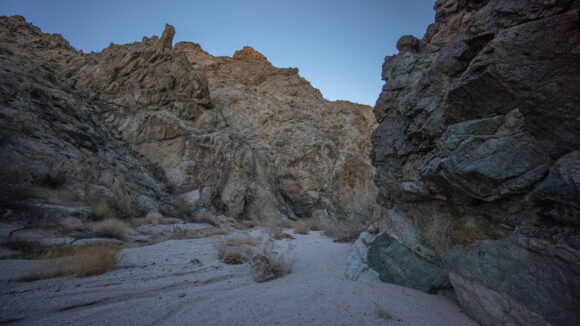
Somewhere near here, Sacatone Wash merges with Grapevine Canyon, which I continue to follow down towards Lake Mojave
Eventually, grapevine canyon dumps into Sacatone wash, and the Canyon is now marked on the map as grapevine. This is where the canyon narrows and becomes deeper and steeper. There are some pretty impressive rock formations here. It was a shame to be moving so quickly through such a cool Canyon, but necessity beckons.
With about a half hour of daylight left, I came across a challenging pour off. It looked to be about 20 feet down, but no easy way to down climb. With little time to Think about it, I lowered my pack down with a string and carabiner and began to down climb this tricky section myself. It was too wide to use my legs to span the distance of the choke point, instead I had to hug a part of the rock that stuck out farther than everything else. This required some movements on faith, and with very little to work with for handhold. Eventually I made it work and made it down safely. Whew! This one was sketchy.
I turned the corner in the canyon and found two potholes of water. Although I was expecting to find them somewhere, I was extremely lucky to find them here, moments before sundown. I dropped my pack and quickly loaded up with three liters of water; two liters in platypus bag and one leader in my dirty water bottle. Water had an extremely strong yellow tint to it.
With only a few minutes of daylight left now, I found myself in a wash that was just wide enough to set up my tent. Fortunately, the ground in this wash was fairly solid, because the high winds are still a problem and They seem to be blowing straight down this canyon, like a funnel.
After setting up my tent, I began to filter water. I have filtered water that was a very strong green color before, and that made it out clear using my Sawyer filter. However, I was disappointed to see that the water I had just filtered was only a shade of yellow lighter than the dirty stuff. Really Sawyer? Really? I did a very quick taste test and it seemed okay, but clearly something in this water is not being filtered out. I keep some chlorine tablets in my kit, and this is the perfect time to use them. I dropped two tablets into one liter and let that sit for a while. I still haven’t drank it, debating whether or not it’s worth risking it. The water in those pot holes is some pretty nasty stuff. I’m sure I could mask the taste with some drink mix, but I really don’t know what’s causing that yellow tint. It’s not light either, it’s a fairly strong tint.
Day 20 – November 22nd
Miles: 12.2 (half day)
No animals seen
There were strong gusts of wind every five or 10 minutes throughout the night, with dead silence in between. I ate a flat, smooshed bagel for breakfast, and washed it down with my last two ounces of water. Of course, I had the water that I took from the potholes last night, but since I’m only a few miles from Lake Mohave now, I think I’ll just wait until I get there and avoid dealing with this yellow water. I’m thirsty, but honestly not doing that bad.
The walk through the middle section of Grapevine Canyon this morning was excellent. There were surprisingly few pour offs to deal with, apparently having tackled the Crux of the entire Canyon just before I reached Camp last night. I can’t say it enough; these Canyon walls were impressive. It’s a deep Canyon, narrow and at times, very interesting rock formations. For example, veins of Darker colored Rock several feet thick could be seen in the host Rock, typically angled up at a 30 or 45 degree angle.
As the middle part of the canyon gave way to the lower part, which was much wider now, there was one final pour off to climb. I was surprised to see a rope in place here, and so I knew pretty much everything below this would be fairly easy going. The Climb I did last night, right before camp, was much more difficult and there was no rope in place there.
The lower part of the had a completely different feel to it. It was obvious it got a lot more traffic, as people had etched their name into the banks of dirt that were cut away by flash floods. Lake Mohave could be seen in the distance now, just a few miles away.
As I left the canyon there was a short one-mile section of open desert to cover before reaching the lake. As I approached it, I could see several Camper vans parked along the shore. Apparently, it’s some sort of Campground. I hadn’t planned on coming down here and actually, so this area was a bit of a surprise to me.
When I reached the lake, I saw several pit toilet bathrooms along the shoreline. I searched for a water spigot, but couldn’t find one. I went down to the lake, where the wind was absolutely whipping, ready to filter some water. I was surprised at how disgusting the shoreline and the water actually was. It smelled like a sewer. There was tons of seaweed and algae that had washed up on the shore, and had decomposed. The water itself was turbid, from the high winds stirring everything up. I decided to walk down the shoreline a little bit before filtering my water, holding out hope for a water spigot or something.
I walked by one camper van and startled their dogs. This also prompted a brief conversation, where I asked if there was a water spigot in the campground. The woman said no, but asked if I needed water. Why yes, I could use some. She was surprised to hear that I had just walked from Searchlight, through the mountains no less. She directed me to their freshwater holding tank where I was able to fill up with 4L of water. Of course, I immediately chugged one. It’s amazing how you can just feel the energy flowing back through your body. A truly incredible feeling. I had walked 52 miles on just 5L of water over 2.5 days.
After leaving the campground behind, I followed a road a short ways before heading into a side Canyon, out of the Wind, to take a break. Now that I had water to drink, I could also eat food. I had been trying to eat light in order to avoid using too much water in order to digest food, but now, it’s a free-for-all.
With a belly full of food and a bladder partially full of water, I set out to walk the final two to three hours into town. I followed a series of dirt roads and 4×4 trails, walking past a few old mines. Nothing incredibly interesting, and so I walked quickly, ready to reach civilization. Rest is not far away.
I could see Davis Dam in the distance as I walked my final wash of the day. This Dam holds back the Colorado River and forms Lake Mohave. It’s closed to vehicle traffic, but apparently, pedestrians are allowed to cross it.
Still, I was apprehensive approaching it, feeling like I was breaching some sort of National Security measures by walking across the dam. I knew I was being watched, with security cameras hanging from the street lights. But of course, I was doing nothing wrong. Still, I didn’t stop for more than a few seconds to take photos and film Lake Mohave, or the Colorado River downstream.
Having crossed the Davis Dam, I left Nevada behind and entered Arizona. Although the boundaries are not definite by any means, for all intents and purposes, the Mojave section is done with, and I’m now entering the Sonoran Desert environment. Indeed, a new chapter this hike has begun.
After crossing the dam, I tried hitchhiking into Bullhead City, but there wasn’t much traffic. What few cars that did pass wanted nothing to do with me. I was fortunate that Bullhead City has Uber, and so I utilized that option for a ride into town.
I got a hotel, shower and got started on town chores. I know I will be be staying for at least one zero day, I could really use the rest.
Day 21 – November 23rd
Zero day
Didn’t do much today except go through photos, catch up on my journal entries, etc. I also took the time to go over my map and plans for the next section. This is an essential part of hiking a new route, especially in parts of the country I am not familiar with. Oftentimes the route I plan at home is far too ambitious for reality, and needs adjustments based on my experiences on the ground in previous sections.
Day 22 – November 24th
Zero day
Did my grocery shopping today at Safeway. Bullhead City is very spread out, not a very good hiker town. All of the good places to eat are in one area, hotels are in another area, grocery stores are in another part of town. There is a bus system, but the bus only comes by once an hour, so the timing pretty much never works out how you like it too. Thankfully, there is Uber in this town, and I have been utilizing that for most of my stay. After two full zero days here, I’m feeling quite rested and ready to go tomorrow.
Mojave-Sonoran Trail Thru Hike 2021 – Section 4: Boulder City to Searchlight
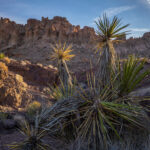
Mojave-Sonoran Trail Thru Hike 2021 – Section 4: Boulder City to Searchlight
Mojave-Sonoran Trail Section 4 Map
Mojave Sonoran Trail Thru-Hike Section 4 – Boulder City to Searchlight, 80 Miles
The above map only represents represents section 4 of 9 on the MST. For a more detailed map and general route info, see the Mojave-Sonoran Trail Guide page.
Mojave-Sonoran Trail Section 4 Journal
Day 13 – November 15th
Miles: 12.5 (half day)
No animals seen
Left the hotel around 7:30 am. First I went to the post office and got there around 8 am, when I thought it opened. However, it opened at 9 am. So now, I walk to the UPS Store to return a MicroSD card I ordered on eBay that was faulty. Then I got breakfast at Jack in the Box. Well, actually lunch, since they serve burgers during breakfast time, and I had already eaten a breakfast at 6:30 a.m.
Then I walked back to the post office and mailed out my bounce box to a hotel in Lake Havasu City. I also mailed home some extra gear that I didn’t need and some rocks that I found from the previous sections. This freed up some room in my backpack, now I can make a run to the grocery store and buy food for the next section, as well as some staple items to send to Searchlight, my next stop. All they have there is a gas station, so they don’t sell things like tortillas cheese and pepperoni.
After doing my grocery shopping, I went back to the post office and mailed out some of the food that I bought to Searchlight. On the way to the post office, I passed an older couple sitting on the patio of a restaurant along the main strip in Boulder City. They saw me walk back and forth a couple of times across town and was curious what I was up to. I told them about the hike, and we had a really nice chat for about 20 minutes. Bob and candy were their names. Bob said, I want to give you something, and reached into his wallet and pulled out some cash. Immediately, I tried to decline, as I really don’t need it. However, he insisted, saying that he would really like to help out and that he is lucky to be in a position to do so. Reluctantly, I accepted the $20 dollar bill. I always feel awkward receiving gifts from people. I’m so incredibly thankful that someone would bestow a gift upon me of any kind. This really made my morning. And yet another reminder of the kind and generous folks I always seem to meet along the way on these long-distance hikes.
I walked out of town, taking my last steps off pavement at the end of a subdivision and on to dirt, back into the desert. Within a few hundred yards, I was down in a really cool little red slot canyon, but this faded out pretty quickly.
My next destination is Gold Strike Hot Springs, and the route there basically follows a bunch of power lines. Not just one set of them though, various networks of large power lines and substations. After all, the Hoover Dam is right around the corner. The entire area is just littered with infrastructure related to the power grid.
I walked under Interstate 11 and continued through the power line the District of Southern Nevada. About the only interesting thing I saw here, besides the great view of Lake Mead in the distance, was an old mine. A horizontal mine shaft tunneled into a hillside, pretty easy to access. So of course I went in. At the entrance was a pile of clothes and a little bit of garbage. It appeared that a homeless person might call this home, at least at some point.
I spent about 15 minutes exploring the mine. Probably a gold mine, as the host Rock had thin quartz veins, and was very crumbly. One didn’t even need a rock hammer here, you could just grab the Rock and pull it off the wall. Alas, I found no gold, and no quartz worth keeping.
Eventually I reached the Gold Strike Hot Springs trailhead, right along the interstate. There were probably 15 or so Vehicles parked here. There really isn’t a trial here to follow per se, but it’s the obvious wash leading down the canyon. Does it count as a “trail”?
One interesting thing about this area is all at the helicopter traffic. At first I thought it was something to do with Hoover Dam, maybe some sort of national security thing. But then I remembered, helicopter tours. It was usually one helicopter every 10 minutes or so, along the same route. But at times, it seems like there was 10 helicopters per minute, almost as if they were in some sort of helicopter traffic jam. Pretty annoying after a while!
I saw about 25 people coming in and out of the Canyon today. For some reason I was expecting more. They were spaced apart quite a bit as well. One couple who is carrying a crying baby! That was surprising, since there were many areas where you needed your hands and feet to climbing scramble.
The middle part of the canyon began to really impress. Not unlike the Canyons I’ve already hiked on this route, and so it was a great walk. But of course, each canyon has it’s own “feel”, and for that reason, these kind of walks never get old.
Towards the lower portion of the canyon, there was some trickling water now coming out of the ground. It was warm, as expected. Then the Steep walls of the canyon became Lush with green vegetation and dripping water. There were small waterfalls pouring off the canyon wall and a babbling Creek at times with small Cascades. It was here that I realized how incredible this place was. A true Oasis, a special place. I would say a Hidden Gem, but it’s no longer hidden. Very well known to the public. A once-hidden gem, we’ll say. But still, quite an incredible place.
I gave up on trying to keep my feet dry at this point. I had already slipped down a Rock and gotten them wet, so now I just walked through the creek. The water was warm though, and quite Pleasant to walk through. There were all sorts of colorful mineral deposits accumulating on the cliff walls here as result of the water continuously dripping.
Farther down, there was a small waterfall pouring out of the canyon wall, about 20ft up. Not much more than a trickle, but for a desert as dry as this, it’s not hard to appreciate this water for what it is… an oasis.
There were three people in the mean soaking pool of Gold Strike Hot Springs when I reached it around 4 pm. I walked right by and just a few 100 ft later, I reached the Colorado River. It was pretty shallow at this point, but just being here along the river in this deep Canyon was awe-inspiring. There were some flat Sandy spots right where the creek meets the Colorado River, and found a spot to set up my tent. What a campsite!
After setting up my tent I went back to the main soaking pool of the hot spring. I had it all to myself now, and it was time to get in and have a soak. The main part of the pool was pretty shallow, but there was a very small, Maybe 5 ft in diameter, circular pool below a cascading waterfall. It doesn’t look like much, but it was dug out to be about 4 ft deep, with some sitting rocks inside. Perfect, absolutely perfect! I couldn’t help but laugh out loud, song things like “yeah right” and “no way”. A place this amazing along a desert hike like I’m doing is not to be taken for granted.
For all the work and effort it takes to get to a place like this, I only spent about 15 minutes here. Daylight was swindling, and I wanted to get back to my campsite and get dry before Darkness fell. With no one around, I didn’t think twice about just getting naked and drying off with my shirt, which I hoped would dry overnight, while I slept in my base layer top. Of course, as I was finishing drying up, I looked back above the waterfall and saw a person approaching. I can’t be sure if they saw me or not, but after they rounded a boulder I was dressed again.
The couple that walked by with down to the Colorado River, as I was walking back to my tent. It was now moments before darkness, and they began to walk back uphill. I said hello, and the woman asked if it was possible to have a boat pick them up. I couldn’t help but chuckle a little, saying that this was probably not going to happen unless it’s a true emergency. I asked if they had headlamps, and they did not. I was beginning to worry a little bit about their safety now. They have cell phones with a light oh, so they won’t be completely in the dark, but it’s certainly going to be a challenging walk, with 1000 feet of elevation gain, in the dark, following a specific path uphill that requires climbing and sometimes with the aid of ropes that are in place, left by previous hikers. They said they would be fine, and I hope they are. I told them if they get into any trouble, I am down here camping for the night and while I don’t have an extra tent or sleeping bag or anything, maybe there’s some way I could help, in an emergency.
Before going to bed, I noticed that the water level of the Colorado River had risen since I arrived, only two and a half hours earlier. This is a bit disconcerning considering my tent is only 50 ft away from it. I’m only about one mile below the Hoover Dam, so if anything, the water level should be lower at night. This is because electricity usage is higher during the day, thus more water must be sent through in order to meet the electricity demands. I highly doubt it will end up being an issue, but still, I don’t have as many things strewn about tonight, pretty much everything is packed away in my backpack and ready to go in case I wake up floating in my tent.
Day 14 – November 16th
Miles: 17.1
Animals Seen: Tarantula, Desert tortoise
Everything worked out the water level with Colorado River last night, I didn’t float away. I began filtering water while I broke down camp. This was going to be one of the longest water carries of the route, about 30 miles. This wouldn’t be a big deal on a normal thru-hike, but since this all off trail and through some rugged canyons with a lot of climbing, this is two days of hiking. I took 8L with me, after chugging 2.
From here, I need to go back up the canyon. There is no way to follow the shoreline of the Colorado River here. I knew this going into it, I just wanted to hit Gold Strike Hot Spring even if it meant an out-and-back. Going up the canyon this morning seemed to be quicker than going down.
I didn’t see anyone else on my way out of the canyon this morning until I reached beside Canyon I was about to take to exit Gold Strike Hot Springs area and make my way over to Boy Scout Canyon. A guy here waved me over to show me a tarantula. Pretty cool, first one on this trip!
The next several hours were a challenge. A lot of the same terrain I’ve already traversed, deep Canyons with a lot of pour offs, boulders to climb, etc. Very slow. Beautiful Canyon though and very impressive.
I saw several potholes of water as I walked my way up the washes. One was fairly large, depth unknown. Because of the Steep and slick rock around it, there were almost certainly dead animals in it. This is not the kind you’d want to fall into. As much as I wanted to feel hopeful about the water situation moving forward, I knew this Canyon was nothing more than an anomaly. Much of the time, I will be high up on a Ridgeline, with almost zero chance of water.
There have been many dry waterfalls to climb over along this route. Far too many to count. I reach one this morning, about a 15 or 20 ft climb, that got my heart rate going. The hand and foot holds were decent, but the rock was slick. Additionally, my camera that hangs off my chest was getting in the way, I needed to hug the rock a little bit closer and couldn’t. I was barely holding on, and felt like I was slipping. With one final push, somewhat a leap of faith, I crested the top of the pour off. I let out a cry of victory at the top of this one.
After a couple hours of working my way up hill, I looked back and could see the Hoover Dam. Pretty cool! What a unique vantage point over this iconic landmark, and without any crowds.
Next I worked my way around Gold Strike Mountain. This is where I enter the Black Canyon Wilderness. Home to the picturesque and rugged Eldorado Mountains, this wilderness unit is a maze of peaks and side canyons with vertical cliffs extending to the edge of the Colorado River. Much of the terrain was formed by volcanism.
After skirting Gold Strike Mountain, I found myself overlooking a deep and rugged canyon filled with black (basalt) boulders. Imposing, for sure. But after a moment, I see my line down and get to work.
Like all of the other washes, there were countless dry waterfalls to work around, in between steep sections of boulders and some Thorn bushes. I saw a couple of bighorn sheep skeletons down here, as well as earlier in the morning. I slipped and fell a couple of times, but no major damage done.
Next I entered the main wash that leads into Boy Scout Canyon. I would have loved to check this one out, but there was a 350 ft rappel needed to progress down the canyon. There was a class three option to avoidant the rappel, but honestly, I just didn’t have the time to go down this Canyon considering it would be an out-and-back. So I headed up the wash instead. This was an easy walk for about a mile before it was time to leave it for more off Trail hiking.
After leaving the wash, it’s an 800ft climb to the ridge. The route was straightforward and not too difficult.
The climb up to the Ridgeline the Black Canyon Wilderness was not all that difficult. I made good time, and found myself on top with an excellent View by around 1 pm. It was great to be out of the Canyons and up high again with a distant view.
The walking here was a lot easier than down in the washes. Eventually, I hit a four-by-four road that I followed for about a mile. This led me to an excellent Overlook off the Colorado River and the Beautiful Canyons that surround it. However, this is where the road ends. I needed to backtrack now to a spot where I could continue along my Southern trajectory.
I left the trail again and stayed high on a small Ridgeline above a wash. At some point, I needed to cross the wash though. When I dropped down into the wash, I heard a hissing sound. I was startled, and immediately thought it was a snake. But when I looked down, I was surprised to see a desert tortoise. I have seen a few shells, but This was the first live one I had ever seen. These guys are pretty rare, actually.
After crossing the wash, I met up with another dirt road. I’ll follow this one for another mile or so before I leave it. There were remnants of an old 4×4 road here too, though, from a time before this land was designated as wilderness. In time, nature will take this road back and it will be gone forever. For now, it gives me a path to follow, and I am not complaining about that right now.
Of course, the dirt road eventually ended and I was off Trail Again. By this time, I had about one hour of daylight left. I was approaching the high point of the Black Canyon Wilderness, and debated whether or not I should go for it. In the distance I could see power lines running across the landscape. This would likely be my best chance of finding a campsite for the evening, as I have not seen many other options recently. I figured it would take me about 1 hour to bag the Summit and then get down to the power lines.
It took me about 30 minutes to get to the High Point. I made it in one solid push, with no break. I was very hungry and thirsty at this point, and felt like I was running on fumes. I didn’t spend more than 2 minutes on the summit, snapping a few pictures and then began walking the Ridgeline down.
The Ridgeline leading downhill looked a little bit more challenging than the route I took up, however, it was pretty easy. It was also much shorter. It only took me 15 minutes to descend from the summit down to the saddle where the power lines were.
I found a flat spot to camp pretty close to the dirt road that runs along the power lines. With 15 minutes of light left, I didn’t waste any time setting up my tent. I was feeling slightly dizzy from the lack of food and water, and all of the exertion from this afternoon. It had been several hours since I had eaten, but I really needed to cover some miles. After all, my next water source is quite a distance away.
There’s almost no chance of reaching my water cache by tomorrow evening, but I should get within Striking Distance for the following morning. Of course, the terrain ahead is going to be tough, and there’s no way of telling how long it will actually take. There are two Springs ahead along my route, but both are likely to be dry.
Around 7pm, a vehicle pulled up where I was camped. His headlights eliminated my tent, and he should have had no problem seeing a human being here. The Jeep pulled out enough to parking area where I was camped and continued down the road. Shortly thereafter, I heard a bunch of gunshots. This continued for about two hours. I figured this guy would be camping down there, but he left around 9pm. Now driving back out on the road he came in on, he passed me again. Only this time, he slammed on the brakes about a hundred feet past my tent, put it in reverse and proceeded to drive (rapidly) right up to within 20 feet of my tent, headlights on me. What the hell? I know the guy has a gun, but there’s not much I can do other than shine him with my head lamp. So that’s what I did, and thankfully he turned around and left. But seriously, what was that all about? Shit.
It’s now 9pm and I haven’t gotten any sleep yet. I dozed off for a little while, but then around midnight, another vehicle pulled in to the area I was camping. I immediately shined him with my head lamp, and he drove away, down the road to the same place as the first guy. It sounded like he fired off a couple rounds as well, but it was only a few, not an all night event like the other guy. There is a gun range only a few miles away, I’m guessing these guys like to have a few beers and shoot at rocks or whatever in the middle of the night after the gun range closes. How annoying. Anyhow, I didn’t hear anything from this guy anymore and I was able to get some sleep for the rest of the night.
Day 15 – November 17th
Mile: 17.5
Animals Seen: Tarantula
When I woke up this morning I noticed a Gatorade bottle, half full, sitting on the ground nearby. Considering I was short on water, and being the dirty piece of hiker trash I am, I inspected the bottle and ultimately drank it. Electrolytes, it’s what I crave.
The road I camped along last night was the dividing line between the black Canyon Wilderness and the Eldorado Wilderness. Now, I continued south into the Eldorado Wilderness. I briefly walked a wash before beginning to climb up to the ridge line. Lots of scattered basalt and volcanic rock here.
To the east, 2500ft below, lies the Colorado River. There is usually no view of it from the crest of the Eldorado Mountains though, unfortunately.
I found this part of the Eldorado Mountains to be pretty plain and barren looking. Despite this, it was rugged and impressive. Usually it’s one of the other. The terrain below the crest to the east, leading to the Colorado River, commands respect, but little about it usually stands out and immediately grabs your attention.
It was around here that I noticed the helicopter traffic that plagued the Hoover Dam area has pretty much stopped. Cool. It was much more quiet now, less plane traffic too. Just silence, solitude and big views now.
View north along the crest of the Eldorado Mountains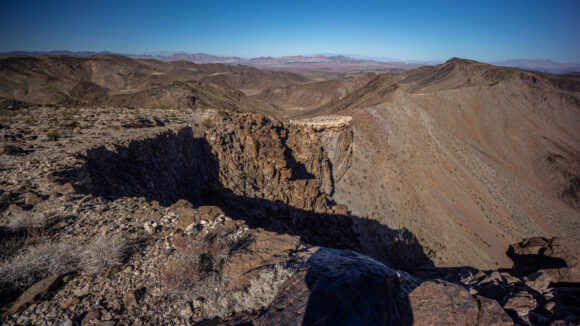
I walked this ridgeline for a couple hours. The best views were towards the south, shortly before I jumped down off the ridge. Here, there was a bit of a knife edge to walk along the ridge. This was perhaps one of the more scenic spots I’d seen this morning, and so I figured it was a good place for a break.
I skirted west of peak 3125 and began working my way down the ridge. To do that, there was a somewhat flat stretch on a shelf to walk before the final drop into a wash a few hundred feet down. It was here that I saw my first Mojave Yucca plant. I was surprised I hadn’t already seen many more, but I really don’t remember seeing any north of Lake Mead. I also saw the only snake of my entire hike here. Non poisonous, just basking in the sun. Cool.
As I descended the ridge, I began to notice more interesting rocks… Clusters of druzy quartz and a few pieces of chalcedony. Now I found myself at the bottom of a canyon, walking a very easy wash. What a nice relief. However, the scenery was pretty bland.
I weaved in and out of the wilderness boundary, walking an occasional 4×4 road. Then, it was cross country hiking again.
I debated whether or not to climb up hill and see if there was water at forlorn hop hope spring ultimately, I did check it out, and it was dry, as expected. The name kinds gives it away.
Next I went over a small pass, and the views improved. I was begging to real like the was some sort of transition in Landscapes now, which I was expecting as the hike progresses from the Mojave Desert Environment to the Sonoran Desert.
After cresting another small Hill, I dropped down into an unnamed canyon that will lead me to the larger Oak Creek Canyon. The views improved massively as I entered this canyon. Wow!
Down in this wash, the shadows began to creep over the canyon walls. My water cache near Nelson ghost town is a few miles away now, but I am beginning to doubt I’ll reach it tonight. I filled up with 8L yesterday morning, and my supply of water is now running low.
The canyon dumps me out into upper Lonesome Wash. Here, I encountered a sea of teddy bear cholla cactus. Careful… this stuff is brutal! Now, I’ll follow Lonesome Wash uphill to Oak Creek Canyon.
Next, I entered Oak Creek Canyon. It looks impressive on the map, with some deep and narrow sections. And that’s just what it was… big cliffs walls, and just a cool place to walk.
It was clear I wasn’t going to reach the water cache tonight, but I will make it fairly close. I was feeling really tired now. Probably from the lack of sleep last night.
The upper reaches of the canyon became more difficult, just as the sun was going down. With 30 minutes of daylight left, I was climbing boulders and small pour offs again. I found a pretty nice spot though protected by rock walls on three sides, on a nice bed of gravel. This will do!
Update on the water situation, I drank 4L today, plus the half liter of Gatorade. No regrets on that Gatorade. That leaves me with a liter in the morning, and that will get me about 2 miles, over some tough terrain, to my water cache.
Day 16 – November 18th
Miles: 18
Animals Seen: Jack rabbit
Slept great last night. Barely woke up at all, and even with a solid 10 hours of sleep, didn’t want to get out of my tent this morning. But that’s fairly typical of me, I’ve never been a morning person.
I reached the top of the Canyon I had been walking Shortly after breaking camp. I found some cool druzy quartz specimens on a hillside.
Next it was time to Crest the top of the pass. On the other side is Nelson ghost town, and my water cache. However, the descent looked steep and loose. This also marks the southern end of the Eldorado Wilderness, and now I enter BLM land.
The descent was not as bad as it looked from the top, but was still slow going. There were some really interesting rocks in some of these washes. I found chalcedony, quartz, and some really cool nodules that I’m not sure about. Farther downhill, I saw a couple of these nodules that were broken open and filled with quartz crystals, basically geodes. Great stuff, I hope to return here someday to do a dedicated rock hounding trip.
Finally down in the wash, I found my water cache. It was still there, and so I got to work distributing the one gallon jug amongst my four one liter bottles. I was a bit disappointed though when I took my first swig, as the water had a pretty awful after taste of chemicals and plastic. Yuk.
Next I approached The Nelson Ghost Town. There are several old wooden buildings here decorated with old cars, equipment and route 66 style decor. It’s owned by a family that runs it as a tourist attraction, giving tours of the nearby mines and the ghost town itself.
I walked in the main building which operates as a check-in point for visitors. Inside was a woman sitting down on a chair and reading. I asked if they had any Cold drinks, and she pointed me to a refrigerator with Gatorade and sodas. She quoted me a price and I dropped my backpack to retrieve my wallet, which is typically buried pretty deep in the pack considering it doesn’t get much use on trail. She asked where I had come from, and I told her about my hike as I rummaged through my backpack looking for my wallet. She said don’t worry about it, the drinks are on us. How kind! Almost immediately, a couple walked in and paid a small entry fee to roam the town. They handed the woman a $20 bill and said keep the change. Essentially, they bought my drinks. Funny how these things work.
They have a bar set up in the main room of the old storefront and I sat down on one of the bar stools, charging with the woman for a while. Then the owner and his sons walked in and sat down. We conversed for a while, and it turns out the old man did a bit of hiking back in his heyday. In 1976, he walked from bad water in Death Valley to Mount Whitney, the route today we refer to as the lowest to highest route. He recalls temperatures of 119, with overnight lows of 94. He had ambitions for other long walks, but then started his family.
Before I got too comfortable, I got up and left Nelson to keep walking. After a short paved roadwalk, I left this for a dirt road that would cut across the mountains and take me to Eldorado Valley. There were some elevated views above the Colorado River, with Arizona as a backdrop. Lovely.
I came across an old cabin that had been used by miners, basically living next to their claim. It said “gladiator Corp” on the outside, which was full of bullet holes at this point. The roof had caved in and the inside was in shambles. There were a couple of bunk beds set up, and interestingly enough, they were covered with cholla balls. A bed of nightmares. There were a couple of cholla balls on the ground as well inside the cabin, and I accidentally kicked one with a footstep that embedded it into the ankle of my other foot. The pain was sharp, and any movement caused further anguish. Outside of the cabin, I dropped my pack and pulled out my Gerber dime multi-tool, and utilized my pliers. You cannot simply use your hands for removing these. There were so many needles of this one ball stuck in my ankle that pulling on the needles on the other side of the ball with my pliers just meant that the needles broke off. I eventually dislodged it, and walked away with a reminder that I didn’t really need, to respect the cholla.
Farther up the dirt road, I came across the Belmont Phoenix mine. Wide variety of minerals were mined here, including gold, silver, copper, zinc, pyrite, chalcopyrite, etc. There were a couple of cabins here as well, One of them newer and in decent condition. The hardwood floors inside were intact and the walls had drywall.
The mine itself was blocked off, both the vertical shaft and the horizontal tunnels into the mountain. It’s always a bummer to see these tunnels gated off like this, preventing people like me from getting inside and exploring them.
The road eventually dumped me out into Eldorado Valley. Here, I had a water source marked, a small game guzzler. I found the guzzler, and now it was a matter of how to get the water out of it. This particular kind features a tank that is mostly buried in the dirt with an opening about 18 inches high, and a ramp that leads down to the water inside the tank. Their appeared to be six inches of water or less. The ramp itself was about 6 feet from the top down to the water level, and so there is no way to just scoop it out.
I anticipated a scenario like this, and brought a length of string for just such an occasion. I tied the string around the mouth of my wide-mouth Gatorade bottle, and put a few small rocks inside the bottle to give it some weight. Without the rocks, the bottle would simply float on the water and water would not enter the mouth. Even still, it took several tries to perfect my technique, to chuck the bottle into the water in such a way where the rocks would not be at the bottom of the bottle, causing the mouth to tilt up out of the water.
I was able to pull up a few Gatorade bottles worth of water before crappy knot I tied came loose, I lost my Gatorade bottle inside the depths of the guzzler. I found the longest branch I could from a nearby shrub and use that to fish out my Gatorade bottle. I was lucky to get it back. I tied a better knot and continue to draw enough water to fill my two liter platypus bag. Quite a bit of effort to filter two liters of water, but sometimes this is the reality of the desert.
It was now decision time once again on how best to proceed along this route. My planned route has me doing a continuous ridge walk of the Ireteba Peaks, this off trail Traverse will be very slow. I need to reach the post office by 3:45 PM tomorrow in Searchlight, before it closes. If I do the ridge walk, I won’t reach Searchlight at all tomorrow, let alone before 3:45. Additionally, that would mean I would probably have to camp up on top of the ridge tonight. With all of these things combined, I decided a lower route would be best. I’ll take a route through Eldorado Valley, consisting of dirt roads and cross country hiking.
I walked a sandy wash til sunset, which was quite nice here in this huge and empty valley. I found a great spot for my tent, flat and clear. One big reason I’ve been setting up my tent before the last several nights, as opposed to cowboy camping, is that the nights have been cooler. The tent really cuts down on the wind and makes very much warmer sleeping experience. I only have a 40-degree bag for this hike, So the little extra things to stay warm really make a difference.
Day 17 – November 19th
Miles: 14.6 (half day)
Animals Seen: No animals
Woke up this morning to large birds squawking and buzzing my tent. They must have been large, the sound of their wings flapping was quite loud. It was a cold night. I put on my pant legs for the first time along this route as I got going. The clouds obscured the sun for a while, making it feel colder.
I continued walking dirt roads, making good time. One road followed power lines for several miles. It was here that I saw my first Joshua Tree of the entire hike. Then, a few more. Eventually, the entire landscape was a Joshua Tree “forest”. These are generally confined to the Mojave Desert. After searchlight, I’ve only got another 60 miles or so of Nevada left, and then I cross into Arizona. While the boundaries of the Mojave and Sonoran deserts are not exact, a rough dividing line is the California/Arizona border, just south of the southern tip of Nevada, which I am fast approaching.
Today’s walk was rather dull, otherwise. I saw a few mining prospects and mines that had been filled in, but nothing interesting.
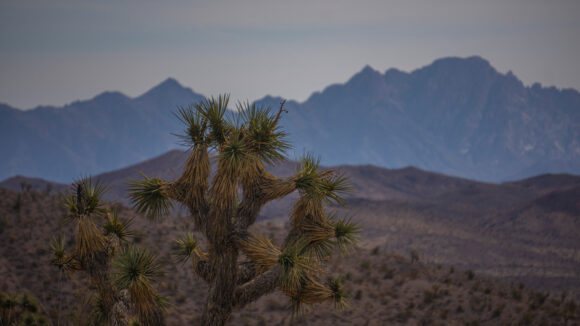
Spirit Mountain in the distance. I’ll climb this on the next section. It’s the highest point along the Mojave Sonoran Trail
I hit some areas of private peppery along my route into Searchlight, which requires a small detour. I followed an underground gas pipeline for the last few miles into town.
The town of searchlight is extremely depressing. There are few homes, most are trailers patched up with garbage. There is garbage everywhere in the street, much like the last few miles of desert walking into town.
My first stop in town was the El Rey motel, which had no vacancy. Damn. This was the place I had planned on staying at. I tried calling them last with my limited cell phone signal, but there was no answer.
So, I headed over to the other motel in town, the By Motel. This place was interesting. Some shady looking characters outside the motel asked “can I help you” in a tone that made me wonder who they thought I was. They did have availability, but it was cash only. Seems legit. With no other hotels in town, I went to the ATM and pulled out $60, and did the deal. No extra fees either, and I’m not complaining. So I handed my money over this crackhead looking guy working there, like an older, dirtier and more inbred version of Charlie Sheen in the movie “ferris buellers day off”.
The room looked surprisingly decent at first glance, but it had many issues, oddities and quirks. First, there was no door knob on the door, just a little handle to pull it shut and an old school key lock. The need sheets looked dirty(and definitely loose debris on the sheets), the floor was tile and made crunchy noises from all the dirt as I walked across it, and all the furniture looked worn and filthy. The shower had no curtain. The shower was tile, and had a large sunken area where water collected. The water barely trickled out of the shower head, not even enough pressure to wash away dirt that was washed off my dirty hiker trash body. The shower tile was dirty. There was no light above the sink, outside the bathroom. The bed Das a full mattress on a twin frame, overlapping or and hanging off. Under the bed I found another dead bolt lock from the last time they changed the locks. There is no wifi. The TV turns on but the cable box does nothing, and its missing buttons. There is no garbage can in the room. There was no soap, I had to ask for it. The heater /ac unit wouldn’t turn on. I could go on, but you get the picture. Funny thing is, as a hiker who just spent 4 days out in the desert without a shower, my standards are so low that none of this upsets me, it’s simply comical.
Outside the motel, there are a couple of abandoned vehicles, and a few more that are missing bumpers and generally looking like a junkyard puked it out. There were trailers full of garbage bags in the parking lot. But perhaps best of all, I could almost constantly hear someone screaming, in an extremely frantic and shrill voice, “I’m going to kill you!! I swear to God I’m going to f’ing kill you!” Not in a joking manner, either. I was waiting for gunshots or screaming at any moment.
The funny thing is, this hotel has a 4.4 out of 5 rating on Google reviews. It’s clear all of the reviews are fake when reading them. They all praised management, and one even said “they serve great food”.
I had been considering taking a zero day in searchlight, but this motel was my motivation to get my chores done and leave in the morning. At the post office, I mailed home rocks from this section and picked up two packages from general delivery; a new pair of shoes and foods I mailed from Boulder city. Searchlight only had gas station convenience stores, so I mailed my staple items here; Tortillas, cheese sticks, pepperoni and pure cooked bacon. I ate lunch at McDonald’s, bought some food from the convenience store, and took care of the rest of my chores.
Looking ahead at the next section, I made some adjustments to the route, bypassing a suicidal ridgewalk I had apparently planned, for something more realistic. I figure 3 days to bullhead city, my first town stop in Arizona. I’ll be looking forward to taking a zero here at a real motel, hopefully.
Mojave-Sonoran Trail Thru Hike 2021 – Section 3: Callville Bay to Boulder City

Mojave-Sonoran Trail Thru Hike 2021 – Section 3: Callville Bay to Boulder City
Mojave-Sonoran Trail Section 3 Map
Mojave Sonoran Trail Thru-Hike Section 3 – Callville Bay to Boulder City, 40 Miles
The above map only represents represents section 3 of 9 on the MST. For a more detailed map and general route info, see the Mojave-Sonoran Trail Guide page.
Mojave-Sonoran Trail Section 3 Journal
NOTE: When I hiked the Mojave-Sonoran Trail in 2021, the only section of the route I skipped was a 30 mile segment at the send of section 3. I went back to re-hike section 3 in it’s entirety in March 2022 and took a better route than my first attempt. Here, I’ll provide my journal entries and photos for BOTH my first attempt (Nov 21) and second attempt (Mar 22). Section 4 of the journal entries will continue the chronological presentation of this route as it was hiked in 2021.
Section 3, First Attempt – Nov 2021
Day 10 – November 12th
Miles: 11 (half day)
Animals Seen: 3 bighorn sheep
The wind picked up shortly after I laid my head down to rest last night. It was only 10 or 15 mile an hour wind gusts, but this was enough to blow the tent over in the soft soil. It would be foolish of me to have not anticipated this possibility, and I had already put a few rocks on top of my tent Stakes. I just didn’t use heavy enough rocks. I had to get up and search for larger ones, and build cairns on top of each stake. This did the trick.
I got going at the usual time, around 6:30. I climbed back up to the Ridgeline I dipped down from the night before. The landscape ahead of me was daunting; a series of washes that must be crossed, not followed. Repetitive and rather dull. Lake Mead is clearly in sight now, no longer hidden by tall Peaks or great distances.
Most of this area consists of soft soil littered with volcanic rock, mostly basalt. As I progressed Westward, the basalt lessened, and it was mostly just softer sand. I dropped down into one wash that was pretty cool, and made me wish I was walking more of these. But again, I am just crossing them, not following them. I saw one bighorn sheep run out of one of these washes as I made my way into it.
I probably should have stayed closer to the route I planned, but in the moment I decided to just walk Westward, wherever I felt like at the moment. For some reason, I thought I might be better off taking a route that stays closer to the Shoreline. When the terrain wasn’t cliffs, this worked well enough in the Jimbilnan wilderness. Unfortunately, on this side of Lake Mead it was much sand year, with a lot more vegetation. In other words, it was a nightmare.
In between the deep sand and some subpar miles, there were a couple of ridges and overlooks which were pretty cool. There were some interesting rocks up here too on one of these ridges.
I trudged through a few more miles of crappy terrain, both bad to walk and less than scenic. I reached boxcar Cove, and now there were a series of dirt roads leading in random directions, along with a plethora of car campers. Even the roads were crappy, deep and loose gravel. Today’s walk was really becoming a sufferfest.
Ultimately, I made the decision to just walk one of the dirt roads up to North Shore Drive. This is the main paved road that runs through Lake Mead National Recreation Area. I was really not happy with this section at all, and didn’t feel like I needed to prove to myself that I could walk through it. Perhaps with a little bit more time and research, I could have come up with a better route. But for now, there’s no reason to walk through this section, other than pure stubbornness.
As soon as I hit North Shore Drive, a vehicle was pulling out, in the direction I wanted to go. I put my thumb out to Hitch, and hopped in their pickup truck bed. I didn’t really have a plan yet, this all happened so fast. Really, I should have just gotten a ride to the point where Northshore Drive Meats Lakeshore Drive at Las Vegas wash, but on a whim, I said Boulder City. So that’s where they took me, to the Road leading to the marina, about 3 miles out of town.
I started walking the three miles into Boulder City, and walked about a mile before getting a hitch into town. Hungry and thirsty, I made my way to Jack In The Box for lunch. Then, I walked over to the El Rancho Motel, where my bounce box was waiting for me. Unfortunately, they were booked up when I got there. I grabbed my bounce box can hit the street.
I walked into a few more motels, but none of them had any vacancy. So then it was time to Google motels in Boulder City, and I started making calls. The quality in about 2 miles out of town, right where I came from, was the only one that had any availability this evening. I made my reservation and walked the two miles to the hotel.
I spent most of the afternoon and evening battling a wicked food coma from lunch, and pretty much just zoned out. This is somewhat typical of me, after spending few days exerting yourself out in the heat, once you reach the comfort the indoors, and air conditioning, the body just seems to have a way of saying “I’m done”. Prior to this, I was feeling great, not weak, worn-down or hindered in any way.
Day 11 – November 13th
Zero day
Now it’s time to figure out my next move. Besides the fact that I skipped about 30 Mi of this 40 Mi section, I had a lot of other logistical things to work out. Firstly, Boulder City is fairly isolated from the rest of Las Vegas, and without a car, I pretty much need to rely on Uber. There weren’t any Uber cars available yesterday, but this morning it seemed they were. So, I ubered in to Henderson to Walmart and bought a new Sawyer filter. Then I grabbed lunch, since there’s nothing nearby my hotel. This means I won’t have to walk 4 miles round trip into Boulder City later, or order delivery.
I had my bounce box sent to Boulder City, so now it’s time to back up all of my photos and video footage since the beginning of the hike. That way I can clear my memory cards for the next couple of sections.
One major downside of using a bounce box is that the post office needs to be open in order to mail it back out. Thus, arriving in town on the weekend means that I will need to stay until Monday so I can mail it out again. In this case, that means three nights in a hotel, and for some reason it’s really busy this weekend in Boulder City. After taxes, $175 a night at a hotel really adds up. This is definitely not the cheapest way to do a thru-hike, but there are few good options when one is committed to documenting the journey. The other is to just have a shitload of memory cards, which is starting to look like my next investment to avoid relying on a bounce box.
Day 12 – November 14th
Zero day
I did very little today outside of the hotel room. I backed up all of my photos and videos, sewed up a pocket I have on the shoulder strap of my backpack that holds my GoPro, ordered a new set of gloves for climbing and bushwhacking, and a slew of other logistical chores to make sure this hike run smoothly. Very uneventful, but also, very productive and very necessary.
Tomorrow I will head out for the next section, 65 ish miles to Searchlight. I will say that I never seem to sleep that well the night before I leave for another section. My mind races, worrying about all of the things I might have forgotten, and second-guessing my route. Tonight was no different.
Section 3, Second Attempt – Mar 2022
March 9th 2022
Miles: 22.7
Animal Seen: None
I was camping in my camper Van about 20 minutes South of Boulder City this morning. I had a couple of miles of driving down a rough dirt road before reaching the highway. I stopped at McDonald’s for breakfast, and then drove over to the Quality Inn. I stayed Here last November when I finished my 1st attempt at section 3. Today though, I will just park in the parking lot somewhere and hope it’s fine to leave overnight. Better than leaving it at a trailhead, I’ve heard some horror stories about break-ins in the Vegas area. From here, the Uber ride I scheduled Yesterday for 7 AM Today arrived on time. My plan is coming together. Not bad, considering I threw this plan together the day before.
My Uber ride dropped me off at Callville Bay campground, where section 3 of the Mojave Sonoran trail begins. I began hiking at 7:30 and headed up a familiar looking Mundane Hillside along the road.
Before long, I was overlooking my campsite from my 1st attempt at section 3 Down in a colorful wash. There’s a network of small ridges, seemingly running every which way. Every ridge has a game trail along its crest, making for relatively easy walking. Lake Mead glimmers in the sun light, spot a mile away.
I follow a series of ridgelines as long as I can, until I need to Change course and Cross a few of them. Small undulations, but Frequent. Fortunately, the terrain is not too steep here.
Soon I dropped down into a deep and colorful wash. It’s not that deep really, but the deepest in this general area. I was here in November on my first attempt, but I’ll be taking a different route this time, up the canyon instead of down. I remember this canyon being really impressive on my last visit, and so exploring farther up is good with me.
So now follow this wash uphill to the base of black Mesa, which I’ll climb later this morning. For now, around every turn the scenery confined to impress. Red and orange sedimentary rocks along the wash carved by the flow of water. Really cool.
Near the top of the Wash, I got my 1st view of black Mesa up close. It was a sea of boulders along the slopes, With no path to follow. Up we go.
The climb up was 700′ total. However, it really didn’t seem that bad. The slopes are steep but quite manageable, especially considering the very stable rocks and boulders that line the hillsides.
I made quick work of the climb and gained the summit. Because it’s a Mesa, the summit was barely distinguishable, but marked with a small pile of rocks. There was no summit register here. Good views though, especially West towards the Spring Mountains. It had recently snowed at higher elevations, and at 11900′, and its peaks were snowcapped. A beautiful sight in the desert, and from a comfortable 70゚down here at 2200′ elevation. This is the desert rat’s preferred way to enjoy snow, from a distance.
Walked the top of the Mesa for a short ways before finding a different route down. The descent was steeper than the ascent, but at least here there the rocks and boulders were very stable. Soon enough I was down and walking the wash below.
I only followed the wash briefly, then it was time to head up-and-over a series of parallel ridges to make my way to NorthShore road. The ridges were very small, but there was like 10 of them. I could see vehicles on the road in the distance, growing closer.
Next, I had a roadwalk of about a mile on Northshore road. In doing so, I will bypass a lot of the soft sand and crappy hiking that had me frustrated on my first attempt at section 3. This, along with the good scenery, made the road walk much more palatable.
Next I walked a long dirt road that led to government wash Campground on lake Mead. Few of the roads here go in the direction that I would like them to go, but this one took the perfect trajectory. I made quick work of this walk and appreciated the ability to start covering some ground.
Closer to lake Mead, a sea of RV campers lies ahead at an area called Government Wash. All of this would have been under water in the past, but now the “camping are” just keeps moving with the shoreline. So, there’s plenty of spots here to camp, if that’s your thing.
This is the extreme Western end of lake Mead, and currently where Las Vegas wash dumps into lake Mead proper. The spot where Las Vegas wash meets lake Mead is constantly changing based on the water levels of lake Mead. It would have been several miles upstream when the lake was deeper. I enjoyed the views of the lake and especially looking back East towards black Mesa, which I had walked I had walked just an hour and a half earlier.
After leaving the last of the campers behind at Government Wash, it was time to head cross country again. Here, a series of a series of ridges and washes run perpendicular to Las Vegas wash. I want to hike parallel Las Vegas wash, meaning I need to go up-and-over every single one of them. And here, they were larger ups and downs.
Alongside my route, there were occasional pond and pools of water that appeared to be separated from the main body of Las Vegas Wash. Protected little “beaches”. Nearby, large areas of cracked mud, evidence of a once higher water level. Some of the cracks in between the mud were 18″ deep!
After a couple of big ridges, things flattened out a bit. I’m now running parallel to Las Vegas wash and separated from it by dense brush. Fortunately, there is a route that stays high above the thicket, and provides an elevated view above the river. I could see upstream, and it looked like this route continues along a very narrow shelf at the base of some sedimentary cliffs. I Can tell it’s going to be very scenic, too. I instantly took a liking to this section.
I walked along the edges of steep drop offs, maybe 50′ above the river. The sound of the roaring water was really nice. Certainly, unique along the Mojave Sonoran trail route. Indeed, it’s wet and lush here, and it’s beautiful with the desert back drop.
Eventually, I need to leave the River to avoid a deep Canyon that intersects it. This means I need to hike up stream along a wash, this one was named gypsum wash, in order to bypass it. I hiked up and over a series of small ridges and washes to start on my westerly course.
It was a steep climb Out of the wash, but when I got to the top of the ridgeline, I was surprised to see it drop off much steeper on the other side. Fortunately, I had the option to walk the ridge line for a while until I reached a spot where only needed to descend a few feet from the ridge to reach the wash below. And, I got a scenic ridge walk out of the deal.
It was a bit of an open desert walk here to the next Canyon. This one, I’ll need to drop down into from above. It was pretty steep, but fortunately the soil was very soft, and allowed me to really dig my heels in on the way down. This makes extremely steep terrain very manageable.
Next, I dropped down into a wash with some cool red and orange rock. These type of washes, as colorful as they are, always seem to peak my interest. Even the smaller ones such as this.
Now down in a new Canyon, I found this one to be very impressive as well. I followed this down to the river again, where the trail continues to skirt Alongside the river, and elevated above it. Eventually, I reached a newly cut road into the hillside, witch which continues on the other side of the river. It appears this will be the site of a new bridge that that extends the wetlands trail to both sides of the wash. Cool. Only I’m above the road and it’s a very steep hillside. The soil looked pretty loose, so I went for it. It was a bit harder than I thought, and I ended up sliding all the way down. Thankfully it was only about 20′. However, I ended up with some road rash on my hand as it slid across the dirt.
Finally, I reached a spot where I could easily access the water in Las Vegas wash. This is the 1st time I could say this since government wash. I took the opportunity to wash off my hands, giving the dirt out of My open wounds. I also washed up my face and hair a little bit. Refreshing.
Next I reached the parking lot for the wetlands trail head. There was a fence around it and it said that it was closed. It looked like they were building a parking lot here, and a paved (perhaps?) pathway that leads down to the river and to the bridge that will eventually span it. This is right along Northshore rd, Which I now have the pleasure of walking for about 3.5 miles.
The roadwalk wasn’t too bad. Looking back to the East, some dark clouds were sitting above the muddy mountains. They looked Quite impressive from here.
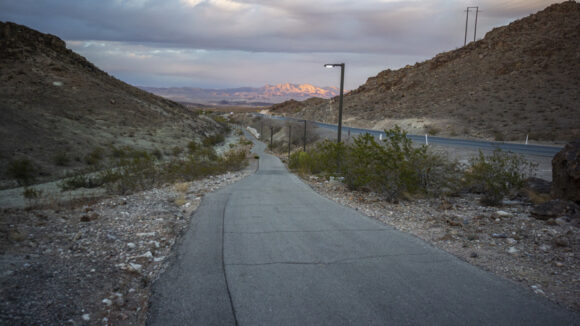
This paved pathway is the River Mountains Loop, which encircles the River Mountain Range. Tomorrow, I’ll hike through the range, not around it!
After about an hour along the road, I reached The spot where I had stashed a gallon of water in the bushes yesterday. It was still there. Sweet. It was Getting dark though, so I didn’t have time to distribute it amongst my water bottles. for now, I threw it in my backpack and continued hiking.
Next I entered the Three kids mine, and abandoned manganese mine from the World War I era. Clearly this place gets a lot of traffic, being so close to Vegas. Some pretty interesting graffiti though! I didn’t really have time to explore any of this though, the daylight was fading fast and I needed to look for a place to camp.
I continued uphill across the mine complex and reached one of the 2 open pit mines. I found a spot to camp That had a little cover from the wind. It was dark enough that I needed my head lamp to help me as I set up my tent. In the distance, I could see it’s pretty much the entire Las Vegas Valley, including the strip. I’m glad to be far away from it though. It’s an expensive and hectic place.
I got about almost 23 miles in today. I haven’t hiked more than 7 or 8 miles in a day since I completed the Mojave Sonoran trail route 2.5 months ago. Since then, I’ve been hiking about 4 days a week, often with a decent amount of elevation gain. I’ve mostly been exploring abandoned mines this Winter as I tour the Southwest in my camper Van. These roads are usually Too rough to drive, which leaves me with a couple of miles of hiking in order to reach them. So I feel like that’s kept me in decent shape since then. However, that’s nothing like hiking 20 miles a day. I’m feeling pretty tired, and it sure does feel good to lie down.
March 10th, 2022
Miles: 17.25
Animals Seen: 3+ Big Horn Sheep
Throughout the night there were various sounds in the distance… dirt bikes, loud cars, planes flying directly overhead. I didn’t sleep well at all. Sometime around 5 AM, sprinkles started hitting my tent.
I woke up at 6 and quickly packed up my things. This morning, I’ll meet up with one of my youtube subscribers named Kai, who had recently watched my Basin and Range Trail series and was interested in joining for some hiking. I welcomed the opportunity to have a partner here, even if it’s only half a day as he must work later in the afternoon.
Kai has done some thru hiking on the Appalachian Trail and is going to be setting out on the Pacific Northwest Trail this summer. He also has a custom route he’s working on that will form a big loop around Clark County (Las Vegas), and I think that’s pretty awesome!
I walked back down to the lower part of the mine complex that I hiked by last night, and Kai was just coming up the hill. Perfect timing. After some quick introductions, we started exploring the Three Kids Mine.
Now with some daylight, we got a better look at the part of this complex they call the “Wheel of Misfortune”. There are several round cement structures that have been spray painted to resemble the wheel from wheel of fortune. Only instead of listing dollar amounts, most say $0. Pretty weird, but kinda cool.
There was a lot of abandoned concrete structures here, all painted with strange and entertaining graffiti. We could have easily spent more time here, but after 15 minutes we left the mine for a dirt road.
After leaving the mine, the terrain quickly becomes more rugged and the vibe turns surprisingly remote and isolated. Of course, roads are not that far away, but the lack of public access to this area likely keeps it fairly lightly trafficked compared to other public lands in that hug the metropolitan Las Vegas area.
The weather this morning was very overcast, and the threat of rain remained. Distant dumps of rain could be seen as the clouds clip the tops of nearby peaks and ridges. The dark clouds created a different mood that was less common along the rest of my MST hike, since every day was usually just blue bird skies.
Kai hiked with me for about 3 hours before turning around and heading back to his car so he could get to work later. It was great to hike with someone new, it really changes the dynamic of these hikes when you have someone to talk to and share the experience with.
Shortly after Kai and I parted ways, I saw a bighorn sheep. This was my first in the River Mountains. Cool.
Soon enough, it was time to leave the dirt road and start my cross country trek across the River Mountains. My goal is to bag the high point and walk the ridge for a bit, before dropping down on the west side of the crest, just north of Boulder City. Hiking here was pretty manageable, for now.
Good scenery thus far throughout the River Mountains. I have been surprised with this range, and wasn’t expecting much because it was so close to Vegas, I suppose. There are no signs of trash, ammo casings, or footprints back here. Rally cool.
Most of the landforms here are unnamed. I walked up a large valley north of peak 3465’, which provided easy walking and pretty good views.
Soon enough, the canyon narrows a bit and the brush becomes thicker. I’m now climbing up the canyon east of peak 3465’, and it’s a little more rugged. Great views, though.
The clouds are clearing up now, but the winds are whipping today. 40 MPH gusts at times. Still, the sun lifts the mood, and the climb continues regardless. I reach a small pass, where I need to go around a large hill in front of me. Left or right, but which way loses the least amount of elevation? The steepest route, of course. And that’s what I chose.
The route to the ridgeline seems to take forever. There are many ridges and drainages to traverse, many side canyons to choose from. And when they are smaller, they can make navigation a little trickier, since none of the landforms are very distinct.
Some power poles mark the canyon leading to the crest of the River Mountains. The final 300ft up to the ridgeline is a little steep, but no biggie.
Once on the crest of the River Mountains, there’s a view west to metro Vegas, although somewhat obscured by hills, and the unobscured view east over Lake Mead. Wow! To me, this section is all about rounding the western side of Lake Mead, where the route begins its southerly trajectory. This is the section that ties it all together, the north Lake Mead region to the southern Colorado River corridor. This view was very meaningful to me in that way, to see where I’ve come from, and all of the work involved to trek all the way around this massive Lake, to string this route together.
I continued up the ridgeline to peak 3502’. The views from each of the small peaks along the ridgeline all offer the same basic view. It’s a good one, though. The wind is blowing me off my feet now, especially when a rogue gust comes out of nowhere.
At the top of River Mountain’s high point, 3789’, there’s a summit register and it’s full of entries. This peak gets a lot more traffic than I would have assumed from the route up, but then again, I took an unconventional approach. The wind was so strong that I didn’t spend a whole lot of time up here. It also killed my camera battery, and it was only cell phone photos after this today.
Continuing north along the ridge, I quickly came to a ridgeline that leads down to a saddle with a 4×4 road leading up to the top, and some power lines. This must be where most people approach the River Mountains high point from.
I walked the rough road down the canyon and out into an open valley west of the Black Mountain. It’s about 2 miles across it to the base of my next climb, a road leading out of the valley and back up to the crest.
I followed a winding dirt road up a mountain with a radio facility at the top. Only a few miles from Boulder City now.

Looking down on an actual hiking trail! Boulder City lies at the entrance to this canyon at the bottom
Once I reach the top of the crest again, I see a vehicle parked at the top. This is a trailhead that leads to several different trails, one of which I will have the luxury of following downhill for a couple of miles. One of the few times I will encounter a marked hiking trail on this entire route.
I drop down into the unnamed canyon leading southwest towards Bounder City. The views are outstanding! I was not expecting this, although when I look at the maps, it’s not hard to believe. The map shows gratuitous amounts of steep terrain, which is a sure recipe for a beautiful landscape in any environment.
As I hiked down the switchbacks, I encountered a couple more bighorn sheep. These guys weren’t afraid at all, they just sort of walked a few feet away and turned their backs on me. Must be slightly used to seeing humans here, only a couple miles from Boulder City now.
After exiting the canyon, it opens up to Boulder City. I walk the outskirts, and enter a residential area of high end homes, and weave in and out of the power line corridors to make my way back to the Quality Inn hotel where I parked my van yesterday morning.
I was relieved to see my van still there in the parking lot, and not towed. I took a chance that nobody would notice it for a night, rather than leaving it at a trailhead where it’s an easy target. Not today, thieves.
It was really nice coming back to my van after the hike, and knowing I wouldn’t need to spend any money on a hotel. I drove to Railroad Pass a few miles away, got a shower at the truck stop, a burger from the fast food place, and parked in the casino lot to spend the night.
I was really glad I went back and re-hiked section 3. My initial impression of this section was that it was merely a connector, and being so close to Vegas, that it wouldn’t be all that interesting. While it was definitely not one of the highlights of the route, it certainly exceeded my expectations for scenery, remoteness, and overall enjoyment.
Mojave-Sonoran Trail Thru Hike 2021 – Section 2: Echo Bay to Callville Bay

Mojave-Sonoran Trail Thru Hike 2021 – Section 2: Echo Bay to Callville Bay
Mojave-Sonoran Trail Section 2 Map
Mojave Sonoran Trail Thru-Hike Section 2 – Echo Bay to Callville Bay, 50 Miles
The above map only represents represents section 2 of 9 on the MST. For a more detailed map and general route info, see the Mojave-Sonoran Trail Guide page.
Mojave-Sonoran Trail Section 2 Journal
Day 6 – November 8th
8.31 Miles (half day)
Animals Seen: About 15 big horn sheep
Woke up at 6:45 today and forgot about “daylights losing time”, and the sun had been up for an hour already. Whoops. Left the hotel at 7:30 am and started walking out of town So I could get a hitch. Unfortunately Overton is very spread out and I had to walk a solid 3 miles to get past the bulk of town. There wasn’t a ton of traffic, but there was enough to start getting frustrated that none of them would stop for me, a human standing out in the desert. Hmm.
I got my first hitch from a guy who is camping in an RV a couple miles out of town, but driving is pickup back to his RV camp spot. So now I was sitting in front of an area with about 40 RVs parked, and a few of them pulled out and drove past me. No luck.
Eventually, a really nice older couple driving a small camper van, not a big rv, stopped for me. Although they are American citizens, they live in Switzerland most of the year and just spend the winter and driving around the southwest in their camper van. They were here to hike Valley of Fire, and being fellow hikers, we hit it off. They followed several thru-hikers on YouTube and asked if I had ambitions to hike the continental divide trail. So needless to say, I enjoyed the company and they ended up driving me a little out of their way to go to the entrance to Echo Bay Campground.
Once I got dropped off at the road leading to Echo Bay Campground from North Shore Drive, I only had to wait two or three minutes before a couple of guys in a pickup pulled in and stopped for me. I rode in the back of the bed and made it to the campground around 10am. It only took me two and a half hours to go 20 miles! But, After a frustrating start to the hitching experience this morning, it was nice to end it on a good note.
I spent some time filling up water, eating leftover pizza and getting my gear situated. I didn’t start walking until about 10:30.
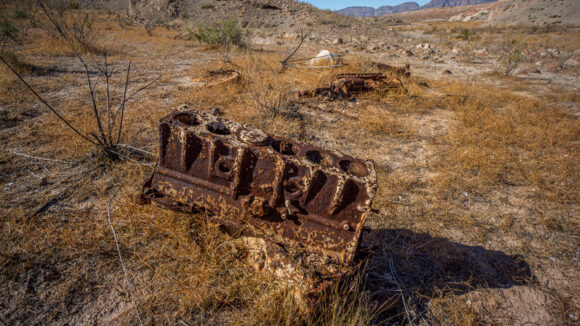
Lots of this junk near the shores of Lake Mead, and up all of the “fingers” of water that used to extend up the washes when water was higher
I dropped down into Echo wash and crossed over into the black mountains /Jimbilnan wilderness. The lower reaches of the wash and the base of the foot hills here used to be underwater when Lake Mead was higher. So, there was a lot of debris here like old anchors, chains and even a few engines.
The first couple hundred feet of ascent were tough. It felt hot, even though today was in the 70s, and there were a ton of rocks and boulders to step on and over. On the way up, I saw a herd of six or seven big horn sheep. After climbing a couple hundred feet, I got my rhythm back and made quick work of the 1,000 foot ascent. I was surprised to see a stack of cairns at the top of the hill, but there they were. The views of Lake Mead were great, and the cathedral peaks Ridgeline on the horizon was very impressive. That’s where I’m headed as I enter the Jimbilnan Wilderness. Yeah, that name just rolls off the tongue, doesn’t it?
Now, there was a series of game trails to follow. Nice. They followed the path that I had charted out at home After studying the maps. To me, that’s a great feeling, to have your route plan verified by animals, who hike here daily.
I wasn’t sure what to expect here, in the cathedral peaks area. The name sounds cool, but there is practically no information online about this area. I was instantly attracted to this ridge line and the greater area. I could tell today was going to be tough, but beautiful.
The ridgeline meanders up and down, and lead me to a canyon that I must climb to gain the crest again. I saw another seven or so big horn sheep, and got some cool photos of them on a ridge with my zoom lens. As I walked up the canyon, I encountered the only shade around. This makes for an obvious break spot. And lunch today is trash bag pizza! I ordered a pizza while in town and realized the box containing leftovers would not fit in the mini fridge in the hotel room, So I asked the front desk if they had anything like a gallon size ziplock bag to store the pizza in. They said no, but offered a thin trash bag. Hey, that’ll do.
After lunch I continued climbing the canyon. At the top, I climbed up a small ridge line and as soon as I did so, I startled two big horn sheep only about six feet below where I was standing. They scurried off, startling me in the process.
From here I could see West Cathedral Peak, my next destination. Some pretty cool vertical rock spires could be seen just below the summit. The views now we’re so good I was starting to get chills. But standing in my way was a steep rock face that I had to contend with. This was probably the crux of the day. It took me a good half-hour to work my way around it, down climbing a few ledges.
West Cathedral Peak offered excellent views of the entire area. The contrast of colors between the blue waters of Lake Mead and the white rocks sticking out of it was striking. Everywhere else I looked, There were jagged pillars and rocks spires, illuminated by the sun and glowing hues of Orange and Red.
In the distance, I could now see My next destination, the Cathedral Peaks High Point. It looked imposing and far away, and now close to 3pm, I began to question whether or not I would reach my intended camp spot tonight on the shores of Lake Mead. I made my way towards the peak anyway, leaving the decision to summit it for later.
The Ridge connecting West Cathedral peak to the high point was rather easy and I made good time here. Most of the rock in this area is volcanic, sharp and not all that interesting. But here, I began to notice chunks of chalcedony, and druzy quartz.
I wasn’t exactly sure about the route up to the high point, but just started walking and following my instincts. Class two all the way up, with some steep stuff. At the top, a class 3 move to get to the summit block. Tons of exposure on the other side of the rock face, which is evident the moment I crested it.
The summit view from the cathedral peaks high point was excellent. More or less the same as West Cathedral peak, but with a better view of Lake Mead. There was a summit register with one entry from 2008 I believe, one from 2017, and a couple from 2019 and 2020. I was the first to sign in in 2021. There were a ton of small gnats here, and their buzzing sounds made me think there was a drone nearby for a minute. The sun was getting low in the sky though, and with an hour and a half of daylight left, it was time to head down.
Next up is a series of canyons and washes. They looked extremely rugged from the top, and although the map didn’t make them look that difficult, I had my doubts. But it’s ruggedness also made it extremely beautiful. The lower I dropped into the canyon, the more I liked what I saw.
I was really trying to hurry down, since I saw nothing resembling a campsite so far. I was really doubting that I would make it to Lake Mead, so my new plan was to head far enough down where the washes became bigger, more free of vegetation and more Sandy… somewhere to camp for the night. I ended up rolling my ankle coming down the canyon, but fortunately, I was able to walk it off.
Every time I looked back, the imposing Canyon walls, Now illuminated by the setting sun, seemed to impress me more. I saw absolutely no signs of human use here. No footsteps, cairns, garbage, ammo casings, etc. I did find a big horn sheep skull, with the horns intact. These are always cool to find. They are surprisingly heavy though!
Now approaching the lower reaches of the canyon, the views were downright stunning. With 30 minutes of daylight left, I reached a side canyon leading to Cathedral Cove on Lake Mead. This was not the Cove that I was shooting for, I was hoping to reach S Cove, still another mile or two away. But I found a nice flat spot in a sandy wash, surrounded by huge cliffs and rock faces. With the stunning views and a good place to camp, I stopped for the day at 4:30 Pm. Man, the lack of daylight at this time of year is tough to get used to, stopping so early. Kind of wish I could live in the southern hemisphere during the winter. Hmmm….
I decided to cowboy camp this evening under the stars. There’s a fair amount of bugs out though, hoping I don’t regret it. I’m also happy to report that my appetite has been somewhat restored. Good thing because I paid a pretty penny to get into Overton and stay there two nights. Still, I think this was the best move for me in the long run, for the good of the hike. I was feeling fairly good on the first section, but it would have been a solid eight or nine days to Boulder City, where I was originally planning to take my first zero day. Personally, unless I am already in excellent trail shape (which I wasn’t), I don’t think it’s a good idea to try and push yourself that hard in the beginning.
Day 7 – November 9th
13.66 Miles
Animals Seen: 1 big horn sheep
Woke up at 5:45 am, Now that the sun comes up ridiculously early due to daylights losers time. It doesn’t make any sense to me to set time back an hour at this time of year when darkness comes at 5pm. Now it comes at 4pm? That’s worse! Anyhow, Clouds moved in overnight, overtook the stars, and right around the time I was ready to leave camp sprinkles began to fall. This was not reflected in the weather forecast, which I believe said 0% chance of rain and was not calling for clouds. The sprinkles were light and short-lived, though.
Having rolled my ankle yesterday, it was feeling a little tender as I began my hike this morning. I found another big horn sheep skull and skeleton shortly after leaving camp. I suppose it’s not surprising considering how many live sheep I’ve seen in the area. Progress was fairly slow, and about to get slower.
I left the wash I was in for a wash leading to S Cove on Lake Mead. I hiked up the drainage over a small pass, and down into the wash on the other side. The scenery was excellent now, colorful and stunning rock formations towering high above the canyon. Lots of jagged peaks, pillars and spites. Truly stunning. Another place that boggles my mind… there are places like this, of this magnitude, that remain so obscure? Only an hour from Vegas, at most, and yet, I feel truly immersed in this remote wilderness environment, seemingly untouched.
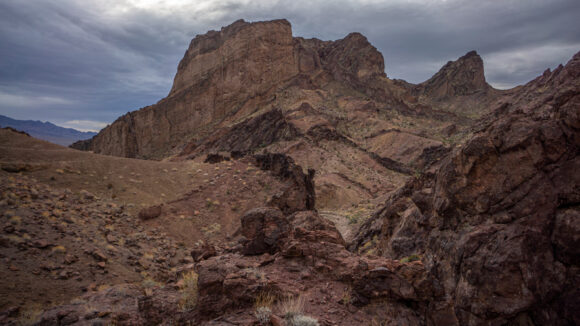
The entrance to S Cove. Canyon route on the right/below, game trail up and over the hump in the center
After a 1.5 miles or so, I reached the canyon that will take me to S Cove on Lake Mead. From the moment I entered the Canyon I knew it was going to be difficult. There was a large narrow Canyon with a pour off that I needed to traverse around, and thankfully there was a high route around it. The landscape here continued to impress. There would be many more pour-offs below as I worked my way down.
I encountered one pour off that was not very tall, but awkward enough that I used my paracord and carabiner to lower my pack. This makes a huge difference, to be able to down climb freely without the bulk of the pack getting in the way and hindering the climb.
The walk down the canyon to S Cove was very scenic. None of the obstacles were too difficult to climb. More big horn sheep carcasses and bones.
Eventually, I made my way to the lower reaches of the Canyon and Now could see the high water mark on the rocks. It seemed like the route to s cove took forever. In this case, forever means a two and a half hour walk from camp this morning. Yeah, I wasn’t close last night.
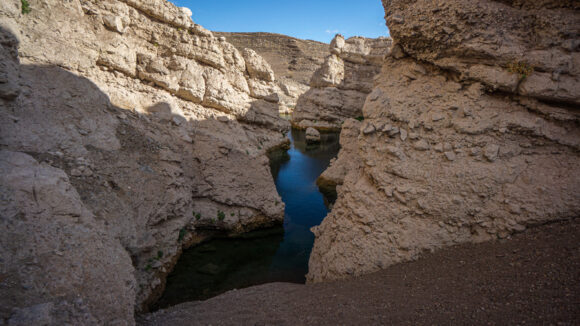
Lake Mead at S Cove. With water levels rapidly changing (dwindling), the point at which the water extended up into the canyon is constantly changing
When I finally reached the water, the first thing I noticed was how the gravel from the wash dropped steeply to the water level. I immediately began to filter water, knowing how slow my Sawyer filter is functioning. I used a gravity feed setup to let the water filter while I ate a snack and took a break. Then it was on to filtering by hand, squeezing and squeezing until I collected two liters. This would be enough to get me Cleopatra wash. And it would have been quite easy to camp here last night, had I made it. However, I feel like there would have been some animal activity here as it’s clear they used the spot to get a drink themselves.
Now it was time to follow the shoreline of Lake Mead to Cleopatra Cove. From s Cove, the shoreline was not really visible or accessible. In the way lies several ridge lines that equate to lots of ups and downs. Nothing to do but start tackling this obstacle.
At the top of first ridge, I had my first big view of Lake Mead. The wind was whipping now, about 25 miles per hour. No boats were on the water today, and wisely so. My view was a depressing one, since I could see several more large ridge lines to go up and over.
After making it past Kendall Cove, the shoreline became much easier to walk. It was flatter and there were less ridges to contend with. Now, I was actually walking on the beach just a few feet from the water, instead of a few hundred feet above it. Progress was much faster now.
When I reached Cleopatra Cove, I was surprised to see just how far the waters of Lake Mead encroached on the Canyon. I was on a ridge line, looking down on it. I needed to head uphill to get a better view of the wash and how I could enter it. I noticed the entrance of the canyon was quite narrow and tall, and appeared to contain several pour offs. I saw a trail of big horn sheep scat leading uphill, so I followed that for a bit. I realized I would not be able to continue on this high route paralleling the canyon much longer, but there was no way down into it from here either. It was at this point when I realized I had made a dumb mistake… I forgot to Fill up water from Lake Mead down at Cleopatra Cove. I had been side tracked by the entrance to Cleopatra Canyon and my need to find a way down into it.
So, I backtracked down to the water. It was the same deal as S Cove, the wash ending with a steep gravely descent top three water level. It was imperative to fill up on a good amount of water here since it would be a solid day before my next opportunity.
It took me an hour and 15 minutes to filter 5 liters. The speed at which this Sawyer filter operates was really frustrating me now. I am squeezing as hard as a I can without popping the dam bag, and that’s as fast as it will go. I’ve already backflushed repeatedly. I will definitely be taking an Uber into Vegas or Henderson to a Walmart so I can purchase a new one when I get to Boulder City. These things don’t seem to last more than a season for me.

The little pass leading down into the canyon proper, avoiding the climbing obstacles at the canyon entrance
With 5.5 liters now, I headed back to the entrance to Cleopatra Canyon. There were several large pour offs in the lower reaches of the canyon that prevented me from progressing further. Fortunately, there were some game trails leading up a side canyon that parallel the entrance to Cleopatra Canyon. These proved to be quite useful, leading me to a path that ultimately dropped down into the canyon and avoided all of the unclimbable pour offs. I even saw a couple of cairns, which surprised me. Someone had been through here.
The lower part of Cleopatra Wash is fantastic. The canyon opens up and becomes very hikeable. I really enjoyed these next few miles up this spectacular canyon.
Around the middle section of Cleopatra Wash, I began to notice how green it was. And the additional animal tracks/scat. I began to think there’s a chance there is water in this canyon, despite not seeing any in my research. I did see my first water here, and it was guarded by a cloud of bees. Perhaps a few gallons in a small pool.
Climbing up out of the middle section into the upper, the traces of water continue. An occasional puddle or pool, the subject of high competition amongst the local wildlife population.
There were many more small pour offs to climb up and over, but really no big deal. I encountered multiple puddles of water in the canyon, some small and some as large as maybe 10 gallons. The water was typically in gravel, and therefore could be dug deeper if needed. It was clear animals did this in some spots. Tracks and scat could be found that every water source here, but that is to be expected. I passed on all of the water sources since I had just topped off my supply.
I exited the canyon at around 4 Pm. Now I was in a much larger valley and there was a 4×4 road running through it. With under an hour of daylight left now, I made the decision to skip Redstone Peak and follow the road for 2 miles instead. The main reason for this was that I am about a day behind schedule now, and I don’t want to run out of food. Plus, with Sentinel peak and Hamblin peak ahead, I wouldn’t be sacrificing much.
Along the road, I left the Jimbilnan Wilderness and entered the Pinto Valley Wilderness. I walked until the sunset and grabbed the first possible campsite I could find. A hundred feet off the road, on top of a small little ridge, I found a fairly flat spot with some small rocks that were easy to move out of the way and provide a place to Cowboy camp. Not the best spot, but really, not bad either.
Today was a tough day, but I was rewarded for my hard work, that’s for sure. The Jimbilnan Wilderness is an incredible place, and I will always remember my time hiking it.
Day 8 – November 10th
15.81 Miles
No animals seen
The quilt I am using, the hammock gear burrow 40, was designed with horizontal baffles that hold in the insulation as opposed to vertical baffling. And before going to bed each night I must shake the bag out in such a way that the insulation moves towards the “top” of the bag, as opposed to underneath my body. I didn’t do a great job of that before going to bed last night, and as a result, I was a bit cold by the time the sun came up. I really don’t like the design of this particular quilt, and have thought about either replacing it or somehow having it sewed in a way where the insulation doesn’t move anymore.
Started hiking by 630. It was nice to begin the day with a walk along a 4×4 road Instead of off trail. This was short lived though, and after 30 minutes or so it was time to head off trail.
The morning began with a series of washes, taking me up and over a small pass around a lone high point, and down some washes the other side. For the first time, I encountered some thorn bushes in the washes that were problematic to move around. Additionally, it’s easy to lose your direction in the washes, especially when they Me and her back and forth and different directions. Needless to say, I took a different approach and just went up and over each ridge and wash, which thankfully was possible due to the fact that the banks of the washes weren’t too high or steep.
Next, I entered a valley flanked by pyramid peak and booths pinnacle, which was an easy walk. This would lead me to the base of Sentinel Peak, which was out of sight nearly the entire time.
There really wasn’t all that much elevation gain to reach the ridges leading to Sentinel Peak. Or rather, “the Sentinel” as it’s marked on the map. Nobody that climbs this peak comes from the direction I’m coming from though, and so I was on my own with a route. I followed a series of Game Trails along ridge lines leading towards Sentinel. At times, the game trails traversed some pretty steep slopes.
The ridge lines leading to Sentinel where quite stunning. The first bit was steep, traversing around one slope in the shadows for a while before popping back out to a proper ridgeline again. Sentinel itself is stunning, and you can’t ignore it’s presence. You don’t have to know a lot about geology to recognize that something interesting has happened here, causing the landform you see before you. I had only done basic research on this peak and really, was just winging it here, connecting where I was this morning to the saddle below the Sentinel. So far, it’s working.
As I made it to the final ridge line that takes you to the summit of Sentinel, I could now see the sheer cliff face that was hidden from view earlier. Even the more gently sloping side of Sentinel appeared nearly vertical. Wow, just wow! You can see the various bands and layers of rock that make up the faulted/tilted landmass that is The Sentinel. Truly incredible.
Looking northeast from the saddle below The Sentinel, the Redstone area immediately catches the eye… the outcrop of red rocks glowing amongst the dullness of the rest of Pinto Valley. Here too, one can’t help but think of the geological explanation for this scene. Faultlines and volcanic activity are the main forces that shaped this land.
This area is referred to as the Hamblin-Cleopatra paleovolcano. Basically, a volcano was torn in half by a fault line, and the two halves are moving farther apart from each other. So that’s pretty interesting!
I began working my way along the ridge line approach. It wasn’t long before I reached a section with quite a bit of exposure, that required sliding on your butt two gain as much friction as possible, in order not to tumble off a several hundred-foot cliff. I paused for a moment here and began to think about a multitude of things. I’m alone with no partner, no climbing gear, little grip left on my shoes. I am behind schedule by about a day and a half just on this section alone, which was only supposed to be 40 miles! That means my food supply will be running low Soon. I know it would take a lot of extra time to reach the summit, time I just don’t have. Adding all these things up, it was a fairly easy decision to just head down and enjoy the awesome views that came with the ridge lines near Sentinel, and save this peak for another time.
I’ve said it many times, but my philosophy as of late when it comes to these long distance hiking routes is to plan big, but accept the fact that you won’t do everything you set out to do. The alternative is to plan a really easy route, one where everything is a pretty much safe and guaranteed passage without any surprises. I like the idea of planning big, because I know I will accomplish at least a good portion of what I set out to do. If I plan an easy route, it’s very unlikely that I will deviate from this route to bag an extra peak along the way or go for any additional challenges. In the end I believe this leads to a much greater adventure, one worth far greater rewards.
It was an enjoyable ridge walk leading down from Sentinel. Then, I dropped down into a wash that seemed like it didn’t belong amongst these ridges and peaks, but instead on the valley floor. It wasn’t long before I encountered several pour offs, seemingly one every hundred yards or so.
As I dropped in elevation, the color of the rocks changed from a lighter color to a red sandstone. This descent route was one that I had seen talked about online from the handful of people that have climbed it, and several people mentioned a challenging choke point near the bottom. However, I did not find the choke point to be all that difficult.
Out of Canyon now, I entered Pinto Valley. I had not planned to come this way, it was only since bailing from Sentinel Peak that I made this decision. I suppose bailing came with a major advantage in that I was now going to walk by sandstone spring. I could only find one reference to it online, which said it had a couple gallons of water in 2013, but also a lot of animal scat.
I was surprised to see a pipe and a trough near this spring, but no water in the trough. At the source though, there was indeed several gallons of water. However, this spring was extremely fouled with animal feces and the entire area was littered with more bones and skeletons that I could count. The smell was horrendous. There were many bees here too.
My first plan was to dig a small hole in the sand near the spring to see if I could get water to pool up through this hole. Nothing though, just more sand. I need the water though, because if I don’t collect here, I have to go many miles out of my way to Lake Mead and draw water there. So what I did was, take a small piece of women’s pantyhose to put over my wide mouth gatorade bottle and use that as a pre filter. There were a ton of squiggly little bugs swimming around, they don’t need to clog my sawyer filter any more than it already is. The pantyhose are extremely slow to filter through, unless you make an effort to spread out the material, making for larger holes for water to deep through. This worked quite well.
The water had a moderate green tint to it, which meant I would probably have to back flush a couple of times. Filtering was slow though, due to my Sawyer filter being old and compromised, So I filtered two liters and then collected three more to filter later at camp.
I had less than two hours of daylight to work with now and feeling like I hadn’t made all that much progress today. Fortunately, I was down in Pinto Valley now and could just walk the main wash running through the valley. Indeed, this made for fast progress. I was surprised to see another small spring (not on the map) in the middle of Pinto Wash, about a mile west of Sandstone Spring. The water actually looked better than Sandstone Spring, but I have a feeling this one is much less reliable.
Behind me, Sentinel peak and the outcrops of red rock where illuminated by the setting sun. I couldn’t help but turn around and look at this majestic landscape over and over.
As daylight dwindled, My pace quickened. I wanted to cover as many miles as I could, and finish most of this valley today. I could have easily camped anywhere in the wash, but then the wash narrowed and became rocker. This forced me up and out of the wash and onto the surrounding ridge lines. With only a few minutes of daylight left, I found myself on a slanted slope with a lot of a medium-sized rocks. Not good. I chose to keep heading uphill, ultimately climbing the tallest one around. I was drenched in sweat by the time I reached the top, but I found a spot that would work for me. It was clear that it had been used by big horn sheep, as it was littered with pellets. I cleared out the scat and leveled the ground enough to make room for my tyvek ground sheet and air mattress. Cowboy camping again.
In the darkness, I rigged up my trekking pole against my backpack so that I could hang my gravity feed water treatment system and let this work While I did other stuff. It’s slow, put not that much slower than squeezing by hand. I really feel like the gravity feed systems are worth their weight in gold sometimes. In my case, I only needed to add a two-foot length of string to my platypus bag in order to achieve a gravity feed system. Basically, it weighs nothing extra.
Day 9 – November 11th
13.9 Miles (Half Day)
No animals
It was a bit windy last night, and the fine poof dirt that surrounded my campsite occasionally blew all over me. There was also the occasional mosquito. Cowboy camping is convenient, but sometimes it has its drawbacks.
I’ve been on a pretty consistent schedule now of waking up at 5:45 and hiking by 6:30. I descended the hill that I was on last night and back down into the wash.
The washes in this area are a good hike. They are colorful and feature interesting geology. I could have summited Hamblin mountain, as I did on my last visit four years ago, but since the main view over Pinto Valley to the east would be obscured by the rising Sun, I decided it wasn’t worth it. It’s an excellent view over Pinto Valley, but best in the afternoon with the sun behind your back. A photo to the east in the morning here wouldn’t even be worth snapping.
Bad photos weren’t my reason for not climbing Hamblin though. Mainly, I am behind schedule and don’t need to take any unnecessary side trips. I decided it would be best to just take the quickest route to Callville bay. This would ensure I get there at a decent time, enough time to get a hot meal from the restaurant, buy a few things from the store, utilize 4G service, and walk out the same day. However, the views from Hamblin Mountain are truly spectacular, and I highly recommend climbing it if you have the time!
My route this morning took me by places I had walked four years ago on my previous Pinto Valley Wilderness hike. This area is extremely colorful and features interesting geology. It looks even better when one has the time to explore areas off the main route. Still, it was a pretty nice walk.
To be honest, I was feeling a little bit down this morning. I’ve always said it’s better to go alone than not at all, but sometimes being alone gets to me. For all the wonderful things I’ve experienced out here, it’s just unfathomable that I don’t have anyone to share it with sometimes. Such is life, and you have all the time in the world to think about it out here.
I left the main wash that heads towards North Shore Road and struck a path West. There was a pretty good game Trail here, and I was surprised to see a couple of cairns. There really wasn’t much here, and with all the other interesting places nearby, it just seemed odd to me. Nevertheless, I followed the path and it took me to a large Valley west of Basalt Peak.
The hike through this Valley was rather unremarkable, until I made it to the lower reaches of the valley. Here, the vibrant colors returned. The wash also became a little deeper and offered some shade.
I followed this wash until I reached Callville wash. This one was rather large, basically the main wash speeding to Callville bay. It was easy walking here.
I went around to turn in the wash and in the distance I could see Callville bay marina. As I got closer, I realize the wash was filled with a lot more vegetation, and it became apparent that it wouldn’t be fun to walk through. Then there were the tires. A large open area separating the wash I was walking from the Hills leading from the water level up to the road were littered with hundreds, if not thousands of Massive Tires. These tires would have been used for construction equipment, the kind that are as tall as I am. So, instead of walking through the vegetation, I hopped my way across a sea of tires and avoided the brush. Never thought I would do that today, or ever.
I walked into the store / restaurant, and got a cold drink out of the cooler. I waited a few minutes for the restaurant to open for lunch, and ordered a double bacon cheeseburger with fries. In retrospect, I should have made it a triple. But it was a hot meal, and really satisfied my craving.
After lunch, I bought a couple of snack items from the store to get me by until I reach Boulder City, my next stop. I had stopped here at the store a few weeks earlier when I drove along the route to scout the resupply options. I knew there was very little here in terms of resupply, so I carried extra food during the last section, the food that I wouldn’t be able to obtain here at the store… things like tortillas, cheese and pepperoni, as well as breakfast items like bagels, protein bars and dried fruit.
There is a shaded area to sit outside well I ate lunch and did my mini resupply. Here, I met a couple of guys who worked at Callville bay, and hung out costing with them for a couple of hours. Sure, this set me back in time, but it was nice to have some human interaction. This really lifted my spirits and made pressing on quite a bit easier late this afternoon when it became time to leave.
It was 4 pm when I left Callville Bay Marina to start Section 3, a 40ish mile walk to Boulder City. It was a short road walk before heading up a random Hill on a Westward trajectory. Once I crested the hill, I could see some colorful ridges and washes, as well as Lake Mead. With daylight fading, I drop down off the Upper Ridge lines to get out of the wind and found camp. I decided to set up my tent tonight, since I had the daylight to do so, as well as the space. No bugs for me tonight! After several nights of cowboy camping, having a tent felt like a real luxury tonight. In the distance, the city lights of Boulder City glimmer in the distance.
Mojave-Sonoran Trail Thru Hike 2021 – Section 1: Valley of Fire to Echo Bay
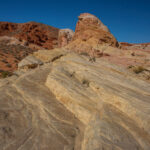
Mojave-Sonoran Trail Thru Hike 2021 – Section 1: Valley of Fire to Echo Bay
Mojave-Sonoran Trail Section 1 Map
Mojave Sonoran Trail Thru-Hike Section 1 – Valley of Fire to Echo Bay, 66 Miles
The above map only represents represents section 1 of 9 on the MST. For a more detailed map and general route info, see the Mojave-Sonoran Trail Guide page.
Mojave-Sonoran Trail Thru Hike Video
Mojave-Sonoran Trail Section 1 Journal
Day 0 – November 2nd: Getting to the Northern Terminus
I’m currently doing the van life thing, living in my van in between hikes. My buddy just moved to Phoenix and has a garage where I was able to store my van for the duration of my hike. I did all of my food shopping in Phoenix, packed my gear and took a one way flight to Vegas. I took an uber from the airport to a hotel on the far northeast side of town near the Nellis Air Force Base. This would be the shortest drive for me tomorrow morning to my start point.
Day 1 – November 3rd: North Muddy Mountains, Weiser Ridge, Valley of Fire
18.15 Miles
Animals Seen: 9 big horn sheep
After a long sleepless night, it was time to rise and shine at 6:30am. By 7:15 my Uber ride was there to pick me up from my hotel. The drive took about 45 minutes, and by 8 am I was at the Hidden Valley exit on I-15 just West of Moapa Valley. My uber driver didn’t say a word about dropping me off at some random desolate exit with nothing there. “See you later”, he said.
My starting point is pretty arbitrary and meaningless. It only serves convince. As much as I wanted to just walk out of some small town to start my hike, this was the easiest thing to do.
Now it’s time to take my first steps on the Mojave-Sonoran Trail(MST). It’s an overwhelming feeling, a barrage of emotions. Mostly, it’s the feeling of calm before the storm; the intense physical exertion ahead weighs heavy on my mind. Even with two previous such journeys under my belt, I still wonder how such a feat is possible… especially when you are standing at the starting line. 675 miles of off-trail hiking is no joke. My pre-hike jitters are justified, but it’s go time.
The first three or four miles are on an easy dirt road leading up into the North Muddy Mountains. Soon enough, some elevation is gained, canyon walls grow taller and the expansive desert views improve. Also, the sound of the interstate dwindles. I find myself at a locked gate that says no trespassing. Beyond the gate is a large antenna and satellite dish, with a generator running. However, nobody around, so I push on past the gate and on my way. A series of small dirt roads leads me around a Hillside, where they fade into game trails.
Now, the views are quite good. Great mountain scenery with desert valleys below. Colorful rocks, caves on the mountainside, and distant views.
I drop down into a wash, and start downhill. The mountains behind me are an impressive backdrop, and I look back frequently. Towards the bottom, I Fell down a couple of times. Catching myself on a rock, I received a small cut. Enough blood to drip, so I took my first break. I used to wear a pair of gloves when doing hikes where I expected bushwhacking, but fell out of the habit of it in recent years. Lately I have rediscovered their merits, and brought a pair with me this trip. I’m using the Fish Monkey Fingerless fishing gloves; soft flexible leather on the palm and a thin, breathable neoprene type material on the other side. Time to put these on.
Out of the wash, I cross Weiser valley. Most of the walk here is on a dirt road. Cool, a little break from the off-trail stuff, even if only for a moment.
Soon, it’s time to find a way up to the top of Weiser Ridge. It looks tall and steep from the bottom, but my route on the map doesn’t look too bad. Time to climb. Mining claims scatter the wash, but their age is unknown. Over my first ridge, a heard of about eight big horn sheep are seen running away. Day one and already a good animal sighting!
Before long I am on the final ascent to the crest of Weiser Ridge, and the views really begin to wow me. At the top, excellent vantage point of Weiser valley and now, valley of fire state park. The red rocks really stand out. I begin my walk south on the ridgeline, and wow!! Hard to believe views of this magnitude can be had on day one. Better than the CDT and BRT. Time for a snack and soak this all in.
The view north from Weiser ridge provides a sweeping view over Moapa Valley and to several distant mountain ranges. Namely, the Mormon Mountains directly north.
The ridge line itself is fairly easy to walk. The rocks are extremely sharp, which makes for great shoe grip but horrible for longevity of the tread. My shoes were getting pretty torn up already. The west side of the ridge is mostly sheer cliffs and an occasional knife edge to walk. Truly excellent.
When it was time to make my way down off the ridge and into the valley to the east, I found myself at a 40ft pour off. At first I thought it was not possible to climb. But then, I began to see a route down. However, it was extremely awkward to begin down climbing. I made it down the first ledge before turning back, deciding out was too dicey to risk it.
Now I had to climb back uphill again and follow the ridge itself until I found another Canyon leading downhill. Unfortunately the next Canyon also featured a pour off, this one even less manageable than the last. A third canyon was even worse, a dry waterfall of perhaps 150-200ft. Not going to happen. Back up to the ridge, and keep walking south.
Finally, I found a way down to a lower ridge line by descending the hillside instead of a canyon. From below, the cliff band running across the mountain side was obvious, and quite impressive. By now, I was losing daylight, and had less than 2 hours before sun down.
The descent of the wash down to the valley floor was an interesting one. The geology here was tough to ignore, with large parallel dikes running vertically, flanking both sides of the wash.
Several pour offs to climb now, slow but manageable. The map doesn’t indicate anything too serious ahead, but these canyon walls are steep and narrow. Pretty nice walk though here.

Hike across Anderson Wash through narrow strip of Valley of Fire State Park land. BLM land at the base of the red rocks
The red rock became predominant near the bottom of the wash and the valley floor. Daylight was fading fast now, and I made my way across the valley as fast as possible. The valley is part of Valley of Fire State Park, where there is no backcountry camping allowed. . I just need to cross the valley to enter BLM land, where anything is fair game.
I found my campsite just a half mile from my first water cache. A Sandy spot suitable for cowboy camping. With 18 miles on the day, I was ready to stop. Still, I felt pretty good for day 1, mainly just hungry. I drank the rest of my Gatorade with dinner, leaving myself a half liter for tomorrow morning. Stars were shining bright by 6:30pm.
Day 2 – November 4th: Valley of Fire State Park
19.8 Miles
Animals Seen: 3 big horn sheep
Beautiful night cowboy camping under the stars. Plenty of sleep, woke up feeling pretty good. 45 degrees this morning.

At the top of a small “pass” in the middle of this narrow canyon, overlooking my campsite from last night
Skipped breakfast and started hiking to the water cache, another half mile, over a small pass in a narrow canyon. Thankfully, my gallon jug of water was right where I left it two weeks ago. Here, I ate breakfast and distributed the water among my 1 liter smart water bottles.
From here, it’s another 5-6 miles to the Valley of Fire state park boundary. Most of this was through deep sand, apparently a popular spot for the ORV crowd. There were tire tracks everywhere, and occasional garbage strewn across the sand. Despite these eyesores, this area was really cool. I didn’t see any 4 wheelers either, so that was nice.
Red rocks, arches, small caves and alcoves, and even petroglyphs. Hiking here felt more like Utah than Nevada.
After cresting the pass at the southern end of the canyon, I saw 3 big horn sheep. These guys are all over here. Nearing the end of the BLM land, the bulk of valley of fire state park was visible on the horizon.
I told myself I wouldn’t stop to empty all the sand out of my shoes until I reached the state park, and as soon as I found a shaded spot (under a cool arch /cave), I took a break. Always a satisfying feeling, to be sand-free again.
In distance I could see cars glimmering in the sun. This is the parking lot for the Fire Wave and white domes, some of the most popular attractions in the park. This made for an easy landmark to shoot for. It was a mix of cross county hiking and a couple of dirt roads, and quite scenic.
Once at the fire wave trailhead, I began the 7 wonders loop, which hits fire wave and apparently, 6 other wonders. The trail was loaded with amazing scenery, but I don’t know how official the wonder count is. It sure seemed like more than 7.
Fire wave wasn’t as packed as my first visit a few years ago. No problem there. This area is very photogenic, and not just fire wave. If one had the time, he could easily spend all day on little side trips exploring this area.
The “trail” follows a wash leaving fire wave, and this too was cool… A slot canyon of sorts, although not very deep. It makes up for that with outstanding colors to please the eyes. I found a shaded spot and took lunch. I really wasn’t too hungry, which is pretty typical for me in the beginning of a long hike, or any multi day backpacking trip actually.
After forcing myself to eat, I continued on the 7 wonders trail up Kaolin Wash. More excellent scenery. In fact, so excellent that my pace was really slowing down, stopping around every turn to capture the landscape from a new angle. So colorful, so beautiful. Occasional sections of short slot canyons really made this hike great.
The trail climbs out of Kaolin Wash and follows a canyon north. Kaolin Wash was awesome, but it was a small scale landscape. Here in this canyon, the views are much bigger.
The trail leads back to the fire wave parking lot, where I began the loop. Not the most direct route for a thru hike, but it would be a shame to walk by the highlights of this amazing place for the sake of making good time. And this was some spectacular scenery. Few places I’ve been compare with this kind of color.
Back at the fire wave parking lot, I easily yogi’d some extra water from the first person I asked. Then, I continued hiking towards the white domes parking lot. The ridge route in between fire wave and white domes provides an excellent, sweeping view of the bulk of the park.
It’s a short hike on the white domes trail to an old movie set, for the 1965 film “The Professionals”. Then the trail intersects Kaolin wash again, which leads to the Prospect Trail. This isn’t a trail at all, it’s a route that’s occasionally cairned. More cool slot canyons, more colorful and jagged rocks. It’s very rugged for what a state park is claiming is a trail. Good views.
The Prospect Trail ultimately leaves Kaolin Wash for another unnamed wash that continues due south. It’s late afternoon now, and very clear that I won’t be able to hike out of the park boundary today like I had planned. There is no backcountry camping allowed in the state park (lame), so I began to think about alternate plans. At the end of the prospect trail, there is a dirt road that leads to a paved road, which leads to a drive in campground. Looks like a 3 mile or so detour, but what other options do I have, other than illegally stealth camping? The bonus of this plan is the running water at the campground. Water… Sold.

Leaving the wash, there is now a trail. This is one of the few trails along the entire MST route that is marked on a map!
Most of the prospect trail follows a fairly easy wash, despite occasional deep sand. There were a couple of climbing obstacles, especially if you wander off course. The hike was a good one, but I was getting tired now. I hadn’t eaten anywhere near the calories I’ve been expending, and had barely peed all day. I needed to keep pushing on though, and make it to the campground before dark.
After cresting a hill, I got my first view of the actual Valley of Fire, for which the park was named. I could see the campground in the distance, and with 45 minutes to dark, it was going to be close. Great desert views, enhanced by the colors of the setting sun. I left the road and took a wash that ran directly to the campground, and made my final push. I was really hitting the wall now.
I walked into the campground with the last bit of light fading fast. It was pretty full, but a couple of open spots. I used my last reserves of energy to set up my tent by headlamp, feeling weak and a little light headed. It was nice to have ruining water and be able to do a quick rinse and wash up. I tried eating, but couldn’t stomach much. It’s a weird feeling to be hungry, and not be able to eat. Nothing tastes good, and my stomach just doesn’t want anything in it.
Tonight was a perfect example of why I despise drive in campgrounds… Barking dogs, whining children, and some inconsiderate people playing some crappy music loudly, for hours. Thankfully, I bring ear plugs, for just this occasion.
I felt surprisingly good at the end of day 1, but day 2 has taken its toll. I’m feeling achy and cold, but it feels great to be able to lay down for the night. On my summer hikes, I might hike 14 hours, utilizing every bit of sunlight. But with shorter days this time of year, daily mileage is shorter, and nights are longer. This means more time to rest. And right now, I’m not complaining.
Day 3 – November 5th: Valley of Fire, Rogers Spring, Muddy Mountains
17.49 Miles
Animals Seen: Jack Rabbit
I didn’t sleep that great last night. Not because of noise, as I had my earplugs in all night. But this morning, a screaming toddler had me packing up at fast as I could. I went over my maps for a while trying to figure out my next move. The mileage I’ve hiked to get to this point was much greater than my estimates. I could backtrack to the prospect Trail and continue on my route as planned, but instead I chose a different route. The plan Now is to walk the base of the muddy mountains through valley of fire, which would all be off trail. Cool.
I started today’s hike by going up and over the red rocks separating the Arch Rock campground from the Atlatl Rock Campground. This was a cool shortcut, scenic and direct. But after that, it was cross country hiking for much of the day. People in the campground gave me some strange looks as I walked through with a full backpack and set out into the open desert. With no backcountry camping allowed here, it’s just day hikers, and I stick out like a sore thumb with my full pack.
The muddy mountains provided a Scenic and somewhat imposing backdrop as I wandered my way through a series of washes. At first I was quite happy with my decision to walk the base of the muddies, but that was for the first bit where I was just following a wash in the direction I wanted to go.
Eventually, in order to continue on my trajectory, I had to leave the wash and go over a series of ridges that separate the washes. This became old and tedious rather fast. On top of all the PUDs (pointless ups and downs), the weather has been heating up. Today will be in the mid to upper 80s, and 90 tomorrow. At this time of year I was hoping for the 70s. It’s hard to complain though, it snowed back home in Michigan. Anything but snow. I’m a desert rat and won’t shy away from that.
Some of these washes had a lot of what I believe to be gypsum deposits. As an amateur rockhound, I enjoy seeing anything out of the ordinary. I also saw a couple of larger pieces of semi-petrified wood. It was still brittle in spots, not quite as well formed as other specimens. Of course, there is no collecting allowed in the state park, but I didn’t want any of this stuff anyways. I’ve seen better!
I was feeling pretty tired this morning, but after I began waking again, felt fine. However, I drank 1.75 liters this morning before leaving camp and still haven’t had to pee. That means I’m dehydrated more than I think. I made an effort to drink more water, while also trying to stretch out my supply so I don’t run out before I reach my next water source.
Most of the washes I hiked today were pretty small scale. However, there was one that was pretty impressive… Valley of Fire Wash. This is the main wash running through Valley of Fire. Deep cut red rock, very alluring. I walked above it though as I needed to go over a pass. There were many small arches in this area, and a plethora of small caves and alcoves. A very interesting landscape, much like the bulk of yesterday.
After cresting a small pass, the landscape opened up and I was only a mile and a half from my water source, Blue Point spring. I’ve walked out of the state park boundary now and entered the lake mead national recreation area. Now there was a series of game trails all leading to the same spot… The place I am going. Along the way I saw lots of horse and burro scat. Over another small hill, I could see a couple of palm trees. There’s my spring.
Once at the spring I was surprised to see how much water was flowing. I made my way to the source, where there was a USGS monitoring station and a small dam holding back half a bath tubs worth of water. The water temperature was in the eighties, not cold by any means. Good for bathing, less enticing for drinking at that temperature. But hey, beggars can’t be choosers. I began filtering water for the first time since I began this hike. It was now that I realized how slow my sawyer filter was filtering. I had used it this summer and it was working fine. Lately, I get the feeling that Sawyer filters are not good anymore after sitting a few months. This filter had definitely not seen freezing Temps, and it had been back flushed regularly. It took a solid 45 minutes to filter 4 liters. Not acceptable. I will need to replace this filter ASAP.
I also took the time to rinse out my clothes and wash up a bit myself. I never use soap anymore out in the wild, I feel that rinsing is good enough. And man, did this feel good.
It was 4pm now and I have three or four miles of road walking on Northshore Drive to get to my next destination. Along the way I passed Roger’s spring. There’s a reason why I didn’t get my water from this one… The brain eating amoebas that thrive in this water source. There are signs here that advise you not to dunk your head underwater, or risk infection. Infection often causes death. While I’ve read that the amoeba can be filtered out with a one micron filter (Sawyer is .1 microns), there really is no reason to mess around with this water when there is another non-amoeba bearing water source nearby.
The thing I despise most about walking paved roads is that a solid 50% of the traffic won’t move over in inch for a human being walking on the shoulder. These are the lowest form of people. I only wish I could buzz by them in my car while they walk somewhere, but I get the feeling these folks don’t do much walking.
As the sun went down over the muddy mountains, I left the road for a wash that paralleled it. Access into the wash is easier here than further up the road where it gets much steeper. With 30 minutes of daylight I began to work by way into the lower reaches of this deep and narrow canyon. Very impressive!
I found my campsite, hemmed in at the base of a pour off, at a junction where the canyon splits. I finished setting up my tent utilizing some of the last daylight. I was happy to have reached camp with at least a few minutes of daylight left, unlike the previous two nights.
While this canyon is deep and narrow, where I am in the lower reaches, there is still enough open sky where I was hopeful that my Garmin inreach mini would be able to send my nightly “I’m OK” message. But after an hour and moving the thing around in every direction in position, I gave up. This thing definitely has its limitations.
Day 4 – November 6th: Muddy Mountains, Lake Mead National Rec Area
11.28 Miles (Half Day)
Animals Seen: None
Had a pack of coyotes moving in on my position around 3 AM. They were very close but when I got out of my tent and chucked a few rocks down the canyon, they went away. I heard them again at 6 am.
I tried climbing up the 40 foot vertical pour off that was just beyond by campsite, but I found the rock to be very slick and the lack of proper handholds would have made a descent very sketchy, if I needed to back out. And since this was an untested route, there’s a good chance I would have had to turn around. This was basically the only way to get up into the muddy mountains and continue along the route that I had planned, so I had no choice but to back out of the muddy mountains and head directly to Echo Bay Campground. Bummer, but I knew not everything I had planned along this route would work out.
After trying a few scrambling routes to progress sup the canyon, I gave up and turned around. I would say that it certainly IS possible, but with a full pack on and no climbing gear, it’s much riskier. It’s too bad because this canyon would provide a critical route for a route that cuts off the walk all the way around the Muddy Mountains. There’s a pass above Fire Alcove into the Muddies from Valley of Fire, and this canyon would be the ideal route to connect to Echo Bay. But damn would it be a hairy descent down some slick rock at the spot I turned around at. It’s a shame too because it looks more open on the map above this point. I still think it’s an option for the right person.
After a brief road walk on Northshore Road, I began hiking cross-country SE towards Echo Bay. At first I stayed out of the washes, they were small and somewhat choked with vegetation. After while, several washes converged into Calico Wash, and it became large enough to walk. This area really wasn’t all that interesting, but it was necessary to reach Echo Bay campground in the most direct fashion. The other option was to walk further to a road, then road walk into the campground. I’ll take the cross-country hiking instead.
The most interesting thing I saw this morning was a desert tortoise shell. This is only the second time I have found one. Believe it or not, it’s actually illegal to collect the shell of a dead tortoise on any type of land. So, I snapped a picture and was on my way.
When I reached Echo Bay Campground, I went into the pathetic little store and bought a couple of cold drinks. The inventory here is so small, I could almost fit all of it in my backpack. This is no joke. The only thing they sold that was a step up from the food I had in my backpack already was an egg salad sandwich, and that it was probably left over from eons ago, back when the water level of Lake Mead was higher and people actually came to Echo Bay. Now, it’s kind of like a ghost town.
I’m also not kidding when I say Ghost town… There is an abandoned motel and restaurant across from the store. With tons of urban exploration experience under my belt, having lived in Detroit, I couldn’t pass up the opportunity to go inside this one. Access was easy, all of the windows were broken and boarded up, but some of the boards were just leaning against the windows.
Inside, pretty much your standard abandoned building… Broken glass, mattresses laying everywhere, and of course, lots of graffiti. The graffiti is always interesting, and this place was no exception. This was a pretty neat little side adventure.
Next, I went down into Echo Wash and dug up the food that I buried two weeks ago. Everything was still there, so that was good. Whew. Before the hike, I couldn’t find any information online that said caching wasn’t allowed in the Lake Mead NRA, but I have a feeling if one were to ask, the answer would be no. It’s unlikely that a few hikers doing this here and there would cause any impact, now would it likely attract much attention. However, alternate options for food caching at Echo Bay would be to leave it inside the abandoned motel somewhere in odor proof bags (kinda risky), or asking the little store if they will hold it for you. You can’t mail anything here, so you’d have to come in person before the hike to set this up. There are also campground hosts at Echo Bay, I bet they wouldn’t mind holding food for hikers for $10 or something.
I could have just taken my food and continued on Section 2 now, but my appetite still wasn’t there. I was having a hard time eating the food I have in my backpack already, so I wasn’t that eager to eat the stuff I just dug up. I’ve been in this situation many times before. The best way to get past it is to get a day or rest in town, and pig out on town food to kick start my appetite again.
I ended up getting a taxi, for an exorbitant price, that drove me into Overton well after dark. I got a hotel, and plan on taking a zero tomorrow for some R&R.
Day 5 – November 7th: Zero Day in Overton, NV
I wasn’t planning on coming to Overton at the end of section 1, but a day of rest and town food will do wonders for me. I didn’t have to do any food shopping since I dug up my food cache in Echo Wash, so that was a nice time saver. I washed my clothes and made small repairs/adjustments to my gear. I tried backflushing my sawyer filter a bunch of times, but it’s still slow. I’m a long ways from anywhere that sells a new Sawyer, so I’ll have to wait at least until the end of Section 3 when I get to Boulder City. I should be able to get an uber to Henderson and hit the local Walmart for that. In the mean time, slow water filtering.



